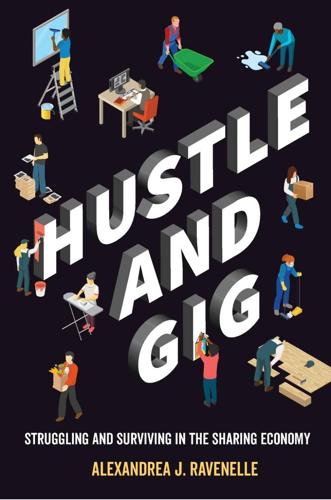
Hustle and Gig: Struggling and Surviving in the Sharing Economy
by
Alexandrea J. Ravenelle
Published 12 Mar 2019
Trust is generally defined as a firm belief in the reliability, truth, and ability of something; but in the sharing economy, trust is easily conjured—Airbnb’s website even features a TED Talk by cofounder Joe Gebbia on how the service “designs for trust.” TaskRabbit also markets its “trust and safety” efforts, which include an identity check, criminal-offense screening, and a two-hour orientation that discusses the best practices for success on the TaskRabbit platform. As the TaskRabbit website explains, “We share knowledge of what creates a great task so that [Taskers] can deliver safe and superior experiences.” Again, trust is something the user demonstrates to TaskRabbit and its workers—not something TaskRabbit is willing to rely on. This expropriation of positive terms such as trust and sharing is often crucial to the marketing of the sharing economy and serves to mislead and redirect, painting an image of trustworthy friends as opposed to workers and de facto temporary employers.
…
He played the recording for me, and I could hear his female friend’s voice as she prompted him to clarify whether the TaskRabbit employee stated the task needed to be completed, no matter what. In a slight understatement, Jamal described the situation as “problematic.” He explains, “[TaskRabbit is] saying that I should break the law for this person; but at the same time, if I were to get caught, get arrested, it’d be like—who am I working for? And TaskRabbit—here is the problem, because I’m not officially an employee under TaskRabbit’s contract. I mean, if contracts are getting worked via TaskRabbit. So if stuff was to hit the fan, I’m not protected.” In the end, Jamal decided that he wouldn’t mail the medications.
…
Although the company was not explicit in the reasoning, several TaskRabbits I interviewed mentioned that they thought someone had used a stolen credit card or had otherwise disputed a charge after the fact, leaving TaskRabbit responsible for both the purchase and the cost of the Tasker’s time. Although many TaskRabbits now know not to accept a task that will involve spending more than three hundred dollars out of pocket, these tasks still occur. The TaskRabbit app allows anonymized communication between the Tasker and client and provides TaskRabbit with a written record in case of a dispute. The messaging tool can be used to provide a specific address to the Tasker, to clarify task directions, or even to change the gig after it starts, as Michael, a forty-nine-year-old white male, quickly discovered.

Humans as a Service: The Promise and Perils of Work in the Gig Economy
by
Jeremias Prassl
Published 7 May 2018
On occasion, more exotic transport modes, including boats and helicopters, are also offered: Justia Trademarks, ‘Everyone’s private driver: trademark details’, https://trademarks.justia.com/858/16/everyone-s-private-85816634.html, archived at https://perma.cc/9AEQ-SHNV 9. TaskRabbit Support, ‘Is TaskRabbit in my city?’, https://support.taskrabbit. com/hc/en-us/articles/204411090-Is-TaskRabbit-in-my-city-, archived at https://perma.cc/8RC8-GV5H 10. TaskRabbit Support, ‘The TaskRabbit trust & support fee’, https://support.task- rabbit.co.uk/hc/en-gb/articles/204943200-The-TaskRabbit-Trust-Safety-Fee, archived at https://perma.cc/2EDG-7MHT * * * 144 Notes 11. TaskRabbit Support, ‘Ratings and reviews on the TaskRabbit platform’, https:// support.taskrabbit.co.uk/hc/en-gb/articles/204668060-Ratings-and-Reviews- on-the-TaskRabbit-Platform-, archived at https://perma.cc/FEE8-UN7W 12.
…
com/business/2017/apr/05/deliveroo-couriers-employees-managers, archived at https://perma.cc/XW66-CAE5; Sarah O’Connor, ‘Deliveroo pedals the new language of the gig economy’, Financial Times (5 April 2017), http://www. ft.com/content/9ad4f936-1a26-11e7-bcac-6d03d067f81f, archived at https:// perma.cc/KY7L-YZ6F * * * 156 Notes 48. TaskRabbit, ‘Featured tasks’, http://www.taskrabbit.com/m/featured, archived at https://perma.cc/RZY2-BGCP (emphasis added). 49. TaskRabbit, ‘Terms of service’, http://www.taskrabbit.com/terms, archived at https://perma.cc/S6ZM-VXUS. The UK equivalent (http://www.taskrabbit. co.uk/terms, archived at https://perma.cc/XTH7-Q8V4) attempts to set up functionally equivalent legal structures. We return to a legal analysis of these terms in Chapter 5. 50.
…
Six Silberman, Human-Centered Computing and the Future of Work: Lessons from the Mechanical Turk and Turkopticon, 2008–2015 (PhD dissertation, University of California Irvine 2015), 3, http://wtf.tw/text/lessons_from_amt_and_turkop- ticon_summary.pdf, archived at https://perma.cc/2WN3-D7F5 51. TaskRabbit, The TaskRabbit Handbook (on file with author), 9; Task Rabbit, ‘Community guidelines’, https://support.taskrabbit.com/hc/en-us/articles/ 204409440-TaskRabbit-Community-Guidelines, archived at https://perma. cc/VX4Q-77CT; Josh Dzieza, ‘The rating game: how Uber and its peers turned us into horrible bosses’, The Verge (28 October 2015), http://www.theverge. com/2015/10/28/9625968/rating-system-on-demand-economy-uber-olive- garden, archived at https://perma.cc/CVU4-GEV7; Benjamin Sachs, ‘Uber and Lyft: customer reviews and the right to control’, On Labor (20 May 2015), http://onlabor.org/2015/05/20/uber-and-lyft-customer-reviews-and-the- right-to-control/, archived at https://perma.cc/9TNM-Y95X 52.

After the Gig: How the Sharing Economy Got Hijacked and How to Win It Back
by
Juliet Schor
,
William Attwood-Charles
and
Mehmet Cansoy
Published 15 Mar 2020
That’s an interesting question.” The appeal of personalized exchange came up repeatedly in our data, most often in relation to Airbnb but also on TaskRabbit and even Turo, where personal contact was fairly minimal. Margaret, a TaskRabbit earner, took great satisfaction in the social aspects of the work: “I like to serve but I love people. I don’t just want to do a good job at the end of the day. . . . I like the connection I have with people. . . . It’s very relational for me.” Barb, who was also on TaskRabbit, summed up her view: “Yes, you’re getting paid for it, but it’s also people helping other people where they have a need.”
…
Gideon, a recent college graduate, and actor and dancer whose career was going relatively well, relied on platform work to supplement his theatrical earnings. He worked about twenty hours a week on Lyft and TaskRabbit and has also put in time on Instacart, which he liked less because the work was “isolated and lonely.” Earlier, he’d worked in food service and at Starbucks, which he also didn’t like: “It was really taking over my life so, I was living to work versus working to live. TaskRabbit feels like I’m working to live.” For Gideon, scheduling flexibility was paramount and app-based work allowed him to go on auditions and to rehearsals. “These other jobs [TaskRabbit, Lyft] are keeping me out of a slave trade service, and it’s giving me that control to really make the work that I want to work and it’s twenty hours at jobs that pay more than most part-time jobs do.”
…
Ernest started on Uber, but as he saw the wear and tear on his car, he realized that the twenty-five dollars an hour he was grossing was more like fourteen or fifteen after expenses and depreciation. So he joined TaskRabbit, where he said he was “averaging around close to thirty dollars an hour. Easy. At least thirty.” He also figured that the lowest possible wage on TaskRabbit was twenty dollars to twenty-five dollars. “I feel like TaskRabbit is the next level. . . . I think Uber is the easiest one to get into.” The most disadvantaged workers sometimes articulated how bad it is at the bottom, as courier Abigail did near the end of her interview: “That’s in every job where you’re in the bottom of the pyramid of capitalism, a wage slaved worker.”

What's Yours Is Mine: Against the Sharing Economy
by
Tom Slee
Published 18 Nov 2015
90 Fenske, “After Our Uber Exposé, Their PR Team Tried to Dupe Us.” 91 Reporter, “Uber Sought To Hire Opposition Researcher To ‘Weaponize Facts.’” 92 Geist, “Popular yet Controversial App-Based Car Service Has No Privacy Policy Specific to Canada.” 93 Powell, “City Councillor Asks Federal Taxman to Investigate after Email States Riders Aren’t Charged HST. Uber Canada Says Its Drivers Are Responsible for Collecting and Remitting the Tax.” Chapter 5 1 Crunchbase, “TaskRabbit.” 2 Silver, “The Sharing Economy: A Whole New Way of Living.” 3 Carhart, “The Ten Ninety Nihilists.” 4 Shontell, “My Nightmare Experience As A TaskRabbit Drone.” 5 Raphel, “TaskRabbit Redux.” 6 Said, “TaskRabbit Makes Some Workers Hopping Mad.” 7 TaskRabbit, “TaskRabbit Announces Novel Integration with Amazon Home Services.” 8 Wohlsen, “Google Pours Millions Into New Tech Gold Rush: Housecleaning.” 9 Jordan, “Unpacking the Grocery Stack.” 10 DePillis, “At the Uber for Home Cleaning, Workers Pay a Price for Convenience.” 11 Geron, “Startup Homejoy Works With Public Sector To Find Home Cleaners.” 12 Roose, “Does Silicon Valley Have a Contract-Worker Problem?”
…
It was a mountain of laundry and it was all covered in cat diarrhea.4 Leah Busque responded to Shontell, and emphasized that “TaskRabbits take on only the jobs they want to complete. TaskRabbit is an open marketplace. As such, TaskRabbits are free to bid on the jobs they find attractive—taking into consideration the amount of time involved, the nature of the work, etc. No TaskRabbit is ever forced into any job or task. One thing to note is one person’s imperfect task is another person’s ideal task. It is not up to us but rather the TaskRabbits themselves to decide which tasks to bid on.” Carhart took up the claim “that violations of employment standards are ‘not our problem’ and ‘not up to us,’ with labor lawyer Catherine Ruckelshaus, who responded: That’s the narrative that employers who misclassify their workers as independent contractors use.
…
Wired Magazine, April 23, 2014. http://www.wired.com/2014/04/trust-in-the-share-economy/. Tapscott, Don, and Anthony D. Williams. Wikinomics: How Mass Collaboration Changes Everything. Expanded ed., paperback ed. New York, NY: Portfolio/Penguin, 2010. TaskRabbit. “TaskRabbit Announces Novel Integration with Amazon Home Services.” TaskRabbit Blog. Accessed June 19, 2015. http://blog.taskrabbit.com/2015/03/30/taskrabbit-announces-novel-integration-with-amazon-home-services/. Taylor, Astra. The People’s Platform: Taking Back Power and Culture in the Digital Age. New York: Picador, Henry Holt and Company, 2015. The Linux Foundation.
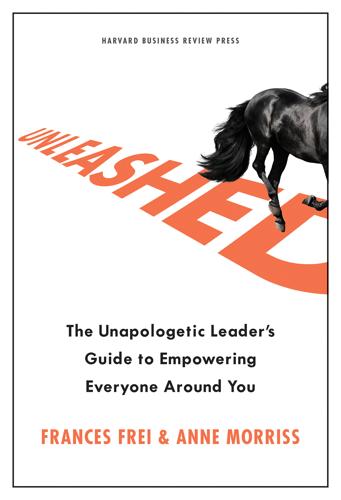
Unleashed
by
Anne Morriss
and
Frances Frei
Published 1 Jun 2020
The model seems to work as long as labor suppliers—contractors providing the final, consumer-facing step in the service—can capture a reasonable surplus.16 Many companies have struggled to pull this off, but an inspirational exception is TaskRabbit, the company that in many ways launched the gig economy. One of the lessons of TaskRabbit’s evolution is that even gig companies can create business models where everyone wins: customers, companies, and, yes, even suppliers. Strategic transformation at TaskRabbit TaskRabbit CEO Stacy Brown-Philpot (remember her from chapter 1?) made the leap from Google to TaskRabbit (initially in the COO role) when she felt a calling to do something new. She was captivated by the chance to empower an organization: “How can I help a community of people do something more than they could otherwise accomplish on their own?”
…
Neil Irwin, “Maybe We’re Not All Going to Be Gig Economy Workers after All,” New York Times, September 15, 2019, https://www.nytimes.com/2019/09/15/upshot/gig-economy-limits-labor-market-uber-california.html. 17. David Gelles, “Stacy Brown-Philpot of TaskRabbit on Being a Black Woman in Silicon Valley,” New York Times, July 13, 2018, https://www.nytimes.com/2018/07/13/business/stacy-brown-philpot-taskrabbit-corner-office.html. 18. David Lee, “On the Record: TaskRabbit’s Stacy Brown-Philpot,” BBC News, September 15, 2019, https://www.bbc.com/news/technology-49684677. 19. Casey Newton, “TaskRabbit Is Blowing Up Its Business Model and Becoming the Uber for Everything,” The Verge, June 17, 2014, https://www.theverge.com/2014/6/17/5816254/taskrabbit-blows-up-its-auction-house-to-offer-services-on-demand. 20.
…
Robin has been an important collaborator and inspiration to us personally and professionally. She makes us better. 2. David Gelles, “Stacy Brown-Philpot of TaskRabbit on Being a Black Woman in Silicon Valley,” New York Times, July 13, 2018, https://www.nytimes.com/2018/07/13/business/stacy-brown-philpot-taskrabbit-corner-office.html. 3. Dave Lee, “On the Record: TaskRabbit’s Stacy Brown-Philpot,” BBC News, September 15, 2019, https://www.bbc.com/news/technology-49684677. 4. Reid Hoffman, “Keep Humans in the Equation—with TaskRabbit’s Stacy Brown-Philpot,” Masters of Scale (podcast), October 9, 2019, https://mastersofscale.com/stacy-brown-philpot-keep-humans-in-the-equation-masters-of-scale-podcast/. 5.

The Sharing Economy: The End of Employment and the Rise of Crowd-Based Capitalism
by
Arun Sundararajan
Published 12 May 2016
Communities set up co-ops with a virtual currency: each participant is issued a set of “tokens”; one earns tokens by babysitting, and one spends tokens on getting sitters. By contrast, labor markets like TaskRabbit and Handy have few, if any, gift economy dimensions. On TaskRabbit, prospective providers (called “taskers”) are hired by clients at hourly rates chosen by the taskers, and can choose filters to ensure that they are only matched with jobs that meet their preferences, such as their minimum hourly rate or the times when they are available. TaskRabbit is thus a matching market for labor services. You might make friends with your tasker, but in the same way you’d make friends with your local grocery checkout clerk.
…
You may be comfortable using Craigslist to hire someone to move a few boxes of books from your home to your office or to paint your kitchen, but as new peer-to-peer services appear, finding services on Craigslist seems increasingly perilous. After all, why hire a cleaner or repairperson on Craigslist when you can hire one who has been background-screened on TaskRabbit or Handy?2 True, the cleaner or repairperson you hire on TaskRabbit may end up having pretty much the same skills as one you could have found on Craigslist. You may be happy or unhappy with either person. But on Craigslist, there are no checks and balances. You could be letting anyone into your home. If you don’t like the job these providers do, you can choose not to hire them again, but there’s nowhere to launch a complaint if something is damaged or stolen.
…
After all, while they may lose a potential repeat client, they won’t lose future customers. In contrast, if you hire a cleaner or mover on TaskRabbit or Handy, you not only get someone who has been vetted by the platform but, more importantly, if that person does a bad job, you can give him or her a bad rating. Bad performance has consequences—it becomes part of the person’s profile on the platform—and, as I discuss in chapter 8, spawns a new form of Darwinist evolution that is data driven. Similarly, if you’re a provider through TaskRabbit or Handy, you never have to worry about doing a job and not getting paid, since the platform facilitates the transaction.

Masters of Scale: Surprising Truths From the World's Most Successful Entrepreneurs
by
Reid Hoffman
,
June Cohen
and
Deron Triff
Published 14 Oct 2021
But there are also plenty of examples of social good as an add-on feature. Tasks for Good, from TaskRabbit, is an example of add-on goodness done right. After improving the company’s relationship with taskers, Stacy Brown-Philpot wanted to bring more of an element of community service into TaskRabbit. When Stacy joined TaskRabbit as CEO, its mission around revolutionizing everyday work really spoke to her. But Stacy gradually saw the possibility for a second purpose: How do we use technology to enable many more middle-class jobs? She began looking closer at how TaskRabbit could be made more accessible to people who don’t have high school degrees or access to expensive technology.
…
This not only offered the taskers an easy way to get involved in causes they cared about, it also allowed these organizations to access volunteers without having to pay for coordination and administration—the TaskRabbit platform does all of that for them. “We send people to these disaster-relief situations,” says Stacy, “because the extension of what TaskRabbit is about is, yes, we’re helping people to make a meaningful income, but we also aim to impact the community, and that might mean helping people in the community who can’t afford the service at all.” TaskRabbit for Good was a natural progression for TaskRabbit—it took advantage of the company’s existing resources and expertise and then applied that to a related area of need.
…
In 2016, Stacy became a fellow in the Aspen Institute’s Henry Crown Fellowship program. All fellows were asked to launch a venture designed to increase their impact on society. Stacy’s idea, TaskRabbit for Good, opened up the TaskRabbit platform for people and nonprofits that might not otherwise be able to access it. Along with partnering with community-based organizations to help people in need earn a meaningful income as taskers, TaskRabbit for Good invited their current taskers to volunteer to be matched with regional nonprofits focused on homelessness, job creation, and disaster relief operations who need some extra hours on the weekend or upcoming weeks.
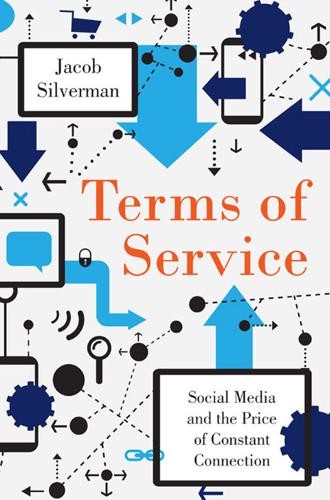
Terms of Service: Social Media and the Price of Constant Connection
by
Jacob Silverman
Published 17 Mar 2015
Uber, for instance, takes about 20 percent of each fare from UberX, its popular, low-budget offering, along with a $1 safety fee. As with online labor markets, the app serves as the ultimate mediator. No one ever has to meet, which is by design. As one TaskRabbit worker remarked: “That’s part of the strategy of TaskRabbit—to keep us apart from one another. We can’t message each other on the Web site. The only way you get to meet another TaskRabbit is if you post a task, and I think they do this to keep us apart because they don’t want us fixing the process. They don’t want us unionizing.” Nor are sharing economy workers ever truly employed in the sense that most people are used to.
…
Her most fruitful work has come from people who have allowed her to take their relationship off of TaskRabbit, thereby saving her the 20 percent fee that the platform skims from each transaction. And with TaskRabbit’s rejiggered system shifting the balance of power even more toward employers, it makes sense that Nandini and her fellow workers would try to use the platform only to set up initial introductions. On the platform, she must wait for employers to contact her; off of it, she retains more of her wages and can pitch employers directly. Nandini now spends a lot of her time working for a twenty-nine-year-old man whom she met through TaskRabbit. This man—let’s call him Joe—works in finance, so he has a lot of disposable income but not much free time.
…
April 9, 2014. mattstoller.tumblr.com/post/82233202309/ubers-algorithmic-monopoly-we-are-not-setting. 242 TaskRabbit worker almost fired: Shontell. “My Nightmare Experience as a TaskRabbit Drone.” 243 Airbnb taxes: Nitasha Tiku. “Airbnb Is Suddenly Begging New York City to Tax Its Hosts $21 Million.” Valleywag, a blog on Gawker. March 28, 2014. valleywag.gawker.com/airbnb-is-suddenly-begging-newyork-city-to-tax-its-hos-1553889167. 244 “we literally stand on the brink”: Tom Slee. “Why the Sharing Economy Isn’t.” 245 Nandini Balial background and TaskRabbit experience: Author interviews with Nandini Balial. July and August 2014. 249 “a human right”: Queena Kim.
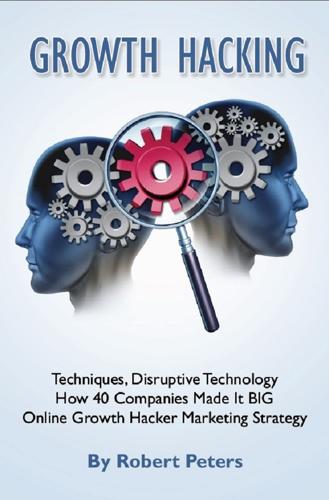
Growth Hacking Techniques, Disruptive Technology - How 40 Companies Made It BIG – Online Growth Hacker Marketing Strategy
by
Robert Peters
Published 18 May 2014
In the wake of a $10 million funding deal in May 2012 Doshi told VentureBeat, “Mixpanel has been cashflow positive for a while, so we weren’t in a hurry to raise funding.” TaskRabbit The online and mobile marketplace TaskRabbit was launched in 2008 in Boston as “RunMyErrand.” It became TaskRabbit in 2010 to avoid perceived limitations in the word “errand” and to go with a name that was more memorable and fun. At the same time, the base of operations was changed to San Francisco. TaskRabbit is a venue for outsourcing small neighborhood jobs to pre-approved “TaskRabbits” who compete for job listings that describe the required task and give an offered price or ask for bids.
…
This kind of peer-to-peer sharing involves crafting a perception of trust so users are willing to do business with strangers. Each potential TaskRabbit is given a criminal background check and interviewed via video before they are approved. The site design emphasizes this guarantee, “Find safe, reliable help in your neighborhood” from “20,000+ Background Checked TaskRabbits.” Sign-up is free and requires only an email address and a zip code, a dead simple method taken from the playbook of highly successful buy low-key sites like DropBox. TaskRabbit founder Leah Busque advocates staying in constant update mode to make sure that users are always having the best possible experience with the product.
…
While users might hire someone to run to the grocery store for them, the job might also be assembling a shelving unit or organizing a closet. The more all-encompassing word “task” was chosen to open up user’s imagination about why and how they might utilize the service. In May 2011, TaskRabbit secured $5 million in financing with 2,000 TaskRabbits proving the concept was workable. Over the course of a year, the service expanded into four more markets: New York City, Chicago, Los Angeles, and Orange County and also launched a mobile app. A second round of funding to the tune of $17.8 million in December 2011 allowed the company to focus on their product development, including incorporating a gamified approach.

The Second Machine Age: Work, Progress, and Prosperity in a Time of Brilliant Technologies
by
Erik Brynjolfsson
and
Andrew McAfee
Published 20 Jan 2014
Alyson Shontell, “Founder Q&A: Make a Boatload of Money Doing Your Neighbor’s Chores on TaskRabbit,” Business Insider, October 27, 2011, http://www.businessinsider.com/taskrabbit-interview-2011-10 (accessed August 12, 2013). 29. Tomio Geron, “Airbnb and the Unstoppable Rise of the Share Economy,” Forbes, January 23, 2013, http://www.forbes.com/sites/tomiogeron/2013/01/23/airbnb-and-the-unstoppable-rise-of-the-share-economy/ (accessed August 12, 2013). 30. Johnny B., “TaskRabbit Names Google Veteran Stacy Brown-Philpot as Chief Operating Officer,” TaskRabbit Blog, January 14, 2013, https://www.taskrabbit.com/blog/taskrabbit-news/taskrabbit-names-google-veteran-stacy-brown-philpot-as-chief-operating-officer/ (accessed August 12, 2013). 31.
…
Johnny B., “TaskRabbit Names Google Veteran Stacy Brown-Philpot as Chief Operating Officer,” TaskRabbit Blog, January 14, 2013, https://www.taskrabbit.com/blog/taskrabbit-news/taskrabbit-names-google-veteran-stacy-brown-philpot-as-chief-operating-officer/ (accessed August 12, 2013). 31. Johnny B., “TaskRabbit Welcomes 1,000 New TaskRabbits Each Month,” TaskRabbit Blog, April 23, 2013, https://www.taskrabbit.com/blog/taskrabbit-news/taskrabbit-welcomes-1000-new-taskrabbits-each-month/. 32. “Employment Situation News Release,” Bureau of Labor Statistics, May 3, 2013, http://www.bls.gov/news.release/empsit.htm. Chapter 15 TECHNOLOGY AND THE FUTURE 1. Charles Perrow, Normal Accidents: Living with High-Risk Technologies (Princeton, NJ: Princeton University Press, 1999); Interim Report on the August 14, 2003 Blackout (New York Independent System Operator, January 8, 2004), http://www.hks.harvard.edu/hepg/Papers/NYISO.blackout.report.8.Jan.04.pdf. 2.
…
Peer economy companies satisfy their customers’ requests by crowdsourcing them. Some of the graphs you see in this book, for example, were generated or improved by people we’d never met before. We found them by posting a request for help with the task to TaskRabbit, a company founded by software engineer Leah Busque in 2008. Busque got the idea for TaskRabbit after she ran out of dog food one night and realized that there was no quick and easy way for her to use the Internet to find (and pay) someone willing to pick some up for her.28 That same year, Joe Gebbia, Brian Chesky, and Nathan Blecharczyk also launched a website that used the Internet and the crowd to better match supply and demand.

Platform Scale: How an Emerging Business Model Helps Startups Build Large Empires With Minimum Investment
by
Sangeet Paul Choudary
Published 14 Sep 2015
CURATING SERVICES Services marketplaces like oDesk, Fiverr, Airbnb, and TaskRabbit rely on social curation. In these instances, two additional factors need to be considered to determine the effectiveness of social curation: 1. The ability of the platform to own the end-to-end interaction 2. The service cycle A platform that can own the end-to-end interaction is more likely to succeed in capturing user inputs on quality. For example, Upwork and Clarity enable the exchange of services on-platform, whereas Airbnb and TaskRabbit require the exchange of services to be conducted off-platform. When the actual exchange occurs on-platform, the consumer of services (and, in some cases, even the producer) may be asked to rate the other party within the context of the exchange.
…
The exact measure of interaction failure will vary by platform, and the importance of tracking interaction failure will, in turn, depend on the multihoming costs. Tracking and avoiding interaction failure is an ongoing discipline that all platform-scale businesses must embrace. 3.9 INTERACTION OWNERSHIP AND THE TASKRABBIT PROBLEM When The Ecosystem Avoids The Platform Platforms that connect non-standardized service providers with clients (such as TaskRabbit and Upwork) are faced with a unique challenge. Most such platforms cannot facilitate a transaction before the buyer and seller meet and discuss the scope and terms of service. However, connecting the buyer and seller often encourages off-platform collusion, in which the buyer and seller take the transaction off-platform to avoid the transaction cut that the platform charges.
…
The party that is charged the transaction cut is motivated to abandon the platform and conduct the transaction off-platform. This problem is further enhanced when the delivery of the service requires the buyer and seller to meet in person. A platform like TaskRabbit enables users to find service providers locally. Since the delivery of service may often involve an in-person meeting, the payments may also be executed in person. This prevents the platform from extracting the transaction cut. Finally, on platforms like TaskRabbit, a client may want to continue using the same plumber for subsequent interactions once he finds a good one. Every time the platform enables a successful interaction, it is reducing its repeatability, as the client and the service provider can connect off-platform for subsequent interactions.

The Internet Is Not the Answer
by
Andrew Keen
Published 5 Jan 2015
Because that’s indeed what is happening to the Bay Area economy, with some Oakland residents even crowdfunding their own private police force64 and Facebook (of course) being the first US private company to pay for a full-time, privately paid “community safety police officer” on its campus.65 Pishevar probably believes that unions should be Uberized and TaskRabbited, too. But, of course, with freelance Web service platforms like TaskRabbit—which provide such short-term “jobs” as waiting in line to buy a new iPhone on behalf of one of San Francisco’s lazy “meritocrats”—there is no role for unions, no place for anything protecting the rights of the laborer, no collective sense of identity, no dignity of work. TaskRabbit has even managed to offend traditional freelancers, with the executive director of the FreelanceUnion arguing that “the trend of stripping work down to discrete, short-term projects without benefits for workers is troubling.”66 TaskRabbit calls its iPhone service #SkipTheLine.
…
No matter that much of the business generated at networks like Airbnb is under investigation by US authorities, with many of the fifteen thousand “hosts” in New York not paying tax on their rental income.15 Nor that TaskRabbit’s so-called distributed-workforce model—whose simple goal, according to its CEO, Leah Busque, is to “revolutionize the world’s labor force”16—profits from what Brad Stone calls the “backbreaking” and “soul-draining” nature of low-paying menial labor.17 “This revolutionary work built out of Silicon Valley convenience is not really about technological innovation,” warns the podcaster and writer Sarah Jaffe about the role of labor brokers like TaskRabbit in our increasingly unequal economy. “It’s just the next step in a decades-old trend of fragmenting jobs, isolating workers and driving down wages.”18 And with 7.5 million Americans working in part-time jobs in July 2014 because they didn’t have full-time jobs, Leah Busque’s “revolutionizing” of the world’s workforce is, in truth, a reflection of a new poorly paid class of peer-to-peer project workers, dubbed the “precariat” by the labor economist Guy Standing.19 “With piecemeal gigs easier to obtain than long-term employment,” warns the New York Times’ Natasha Singer, this highly insecure labor model, the dark underbelly of DIY capitalism, is becoming an increasingly important piece of the new networked economy.20 But that’s all beside the point for these self-styled disrupters who, without our permission, are building the distributed capitalist architecture of the early twenty-first century.
…
If the government shuts down, nothing happens and we all move on, because it just doesn’t matter.” The Battery member and Uber investor Shervin Pishevar expressed this same techno-libertarian fantasy in under 140 characters. “Let’s just TaskRabbit and Uberize the Government,” Pishevar tweeted to his 57,000 followers.63 He might as well have said: Let’s just TaskRabbit and Uberize the economy. Let’s just turn everything into the so-called sharing economy, a hyperefficient and frictionless platform for networked buyers and sellers. Let’s outsource labor so that everyone is paid by the day, by the hour, by the minute.

Ours to Hack and to Own: The Rise of Platform Cooperativism, a New Vision for the Future of Work and a Fairer Internet
by
Trebor Scholz
and
Nathan Schneider
Published 14 Aug 2017
I suggest taking a look if you haven’t recently—partly because it’s hard not to laugh at the fake emotions, but mainly because a similar caricature shows up in how on-demand service platforms market themselves. TaskRabbit, for example, portrays images of smiling helpers cleaning kitchens while women hold babies. Unlike stock photos, however, we meet TaskRabbit in real life. Their marketing may be full of clichés, but on-demand service platforms are also full of opportunities for us to become emotionally invested. Platforms like TaskRabbit leverage our emotional investment to grow their user base. Their user experience is designed to delight us, especially at key moments around transactions.
…
We later added educational and learning sites, such as online courses and workshops that offer “upskilling,” and a makerspace. Then we moved on to the far more controversial for-profits, such as Airbnb, and peer-to-peer car rental sites. We’ve also been studying on-demand labor sites, including TaskRabbit, Postmates, and Favor. We’re interested in many aspects of these innovative arrangements. How are they organized? Who is benefiting from them? How do people (on both sides of the markets) feel about them? What are the dynamics of inequality and access that operate in these spaces? Participants in the platform cooperativism movement have high ambitions to create platforms that are owned and governed by their users, that embody principles of equality and access, and that serve the common good.
…
It’s as if the New Deal had never existed. RACE TO THE BOTTOM IN THE FREELANCE SOCIETY Now a new and alarming mash-up of Silicon Valley technology and Wall Street greed is thrusting upon us the latest economic trend: the so-called sharing (or gig) economy. Companies like Uber, Instacart, Upwork, and TaskRabbit allegedly are “liberating workers” to become “independent entrepreneurs” and the “CEOs of their own businesses.” In reality, these workers also are contractors, with little choice but to hire themselves out for ever-smaller jobs (“gigs”) at low wages and with no safety net, while the companies profit.

The Corruption of Capitalism: Why Rentiers Thrive and Work Does Not Pay
by
Guy Standing
Published 13 Jul 2016
The platforms insist that taskers are not employees but independent contractors, so are not covered by labour laws, entitling them to certain benefits and safeguards, including, in the USA and elsewhere, the right to unionise. Uber goes to great lengths to justify the independent contractor label, describing drivers as part-time ‘driver-partners’ who choose to provide rides using the Uber platform. TaskRabbit’s support centre poses the rhetorical question ‘Do Taskers work for TaskRabbit?’ and gives its answer: ‘No, they do not. Taskers are local entrepreneurs and independent contractors who work for themselves. TaskRabbit simply provides the platform for Clients and Taskers to meet. We vet and background-check all Taskers before allowing them onto the platform to ensure they are professional and reliable individuals.’
…
How can they claim there are free markets when copyright rules give a guaranteed income for seventy years after a person’s death? How can they claim free markets exist when one person or company is given a subsidy and not others, or when they sell off the commons that belong to all of us, at a discount, to a favoured individual or company, or when Uber, TaskRabbit and their ilk act as unregulated labour brokers, profiting from the labour of others? Far from trying to stop these negations of free markets, governments are creating rules that allow and encourage them. That is what this book is about. ONE MAN’S NIGHTMARE… There he was, speaking to the 2015 Financial Times Business of Luxury Summit in the principality of Monaco, in the company of glamorous wealth.
…
They also rely mainly on money wages, which are often inadequate, volatile and unpredictable.38 They lack access to rights-based state benefits and are losing civil, cultural, social, economic and political rights, making them supplicants if they need help to survive. The precariat is growing all over the world, accelerated by the likes of Uber, TaskRabbit and Amazon Mechanical Turk discussed in Chapter 6. It is in turmoil, reflected in the confusion over perceived class membership. For instance, more Americans today see themselves as in the lower classes. In 2000, according to Gallup polls, 63 per cent saw themselves as middle-class and 33 per cent as lower-class.

Gigged: The End of the Job and the Future of Work
by
Sarah Kessler
Published 11 Jun 2018
Eventually the true independence of the micro-entrepreneurs these businesses relied upon would be challenged in court; workers who felt exploited rather than emancipated by on-demand labor would complicate an otherwise utopian narrative; and what became known as the “gig economy” would attract attention to the ways in which the rest of the economy was unprepared for the future of work. But at the height of “Uber for X,” few people in the startup world batted an eye. As the then-CEO of the odd job–marketplace TaskRabbit put it, the gig economy was on track to “revolutionize the world’s labor force.”12 CHAPTER 2 NO SHIFTS. NO BOSS. NO LIMITS. By the end of 2014, Uber had launched in Paris, Sydney, and London, and its momentum was so strong that Fast Company ran a story headlined “How Uber Conquered the World.”1 The five-year-old startup was launching in a new city nearly every other day.
…
A Forbes cover story in 2013 explained that the sharing economy and gig economy had created “an economic revolution that is quietly turning millions of people into part-time entrepreneurs.”13 Tech journalists and bloggers, perhaps having spent too much time immersed in the optimism of entrepreneurs, typically went for full-out hype. “Will You Leave Your Job to Join the Sharing Economy?” prompted the tech blog VentureBeat in a 2013 headline.14 The article’s author had met a Lyft driver who also worked for TaskRabbit, a website on which neighbors could hire each other to complete odd jobs. She had also posted her apartment on the peer-to-peer lodging website Airbnb. “The combination of these three things is making her more money than she made working full time,” the article’s author gushed. “Plus, she feels like she’s working for herself without the risk of starting her own company.”
…
Rather, it had the opposite effect: It created international competition for jobs, even some local ones that the people of Dumas would have had to themselves without the internet. Dumas wasn’t unique in this regard. In a preliminary study, NYU Stern School of Business professor Arun Sundararajan plotted the hourly wages of workers in the San Francisco Bay Area who found jobs through the odd jobs website TaskRabbit against the Bureau of Labor Statistics’s average wage rates for the same area. He found that workers who won gigs online actually earned more than their offline peers when the job required a physical presence, such as electrical work or carpentry. His hypothesis was that because the gig economy website made it less of a hassle to find workers to complete these jobs, more people sought services, which pushed wages up.
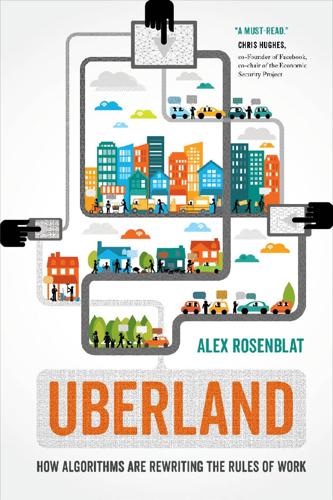
Uberland: How Algorithms Are Rewriting the Rules of Work
by
Alex Rosenblat
Published 22 Oct 2018
Uber trades on our cultural assumptions about technology to frame every driver as his or her own boss, implying that its platform fosters a collaborative and equitable environment without traditional top-down labor or management hierarchies. This is an illusion, but sharing rhetoric does overlay longer histories of contingent work. The gig-economy job offerings at Uber, TaskRabbit, and Fiverr are a feature of low-wage work already. As sociologist Julia Ticona discussed with me in conversation, for low-wage workers it’s not a choice between TaskRabbit or Uber and a forty-hour-a-week job with benefits. It’s TaskRabbit or twenty hours a week at McDonald’s and the other twenty hours at a friend’s hardware store. The blend of formal and informal work blurs all the categories of employment we’ve held sacred for a long time.56 Nonetheless, sharing-economy companies have had remarkable success in redefining the nature of work as a technology phenomenon and as a form of “sharing,” because technology can be framed as a countersolution to more predatory forms of commerce.
…
Instead, Uberland is an exploration of how Uber and other corporate giants in Silicon Valley are redefining everything we know about work in the twenty-first century through subtle changes ushered in by technology. Chapter 1 traces the rise of Uber in the context of a new sharing economy. In the midst of declining economic conditions and class mobility at the end of the first decade of the twenty-first century, technological innovations sparked the rise of companies like Uber, TaskRabbit, and Airbnb, sparking rapid changes for American workers in the process. Against this backdrop, chapter 2 explores Uber’s success in constructing a mass workforce by examining the kinds of workers who decide to drive with the platform and exploring their motivation. Given that each group of drivers—full-timers, part-timers, and hobbyists—has unique needs, Uber has found ways to divide and conquer by pitting drivers against each other.
…
Uber drivers are classified as independent contractors in the eyes of the law and termed “driver-partners” in Uber’s official lexicon: these categorizations imply a higher level of autonomy and equity in the company than they have in practice. The company positions drivers as “partners” with messages like “be your own boss and “get paid in fares for driving on your own schedule.” Other digital economy labor platforms, like Amazon’s Mechanical Turk, and sharing economy companies like TaskRabbit, call their workers, respectively, “Turkers” and “Taskers” or “Rabbits” and bill them as entrepreneurs or micropreneurs.46 This careful dance with terminology distances platform employers from the rules and norms of labor law.47 These new platform companies attempt to align themselves with a lineage of “cooperative commerce”48 or acts of mutual help and generosity like hitchhiking, carpooling, and couch surfing.

Machine, Platform, Crowd: Harnessing Our Digital Future
by
Andrew McAfee
and
Erik Brynjolfsson
Published 26 Jun 2017
Lakhani, “Marginality and Problem-Solving Effectiveness in Broadcast Search,” Organization Science, February 22, 2010, http://pubsonline.informs.org/doi/abs/10.1287/orsc.1090.0491. 260 Amazon’s Mechanical Turk: Jason Pontin, “Artificial Intelligence, with Help from the Humans,” New York Times, March 25, 2007, http://www.nytimes.com/2007/03/25/business/yourmoney/25Stream.html. 260 transcribing text from business cards into a spreadsheet: Jeremy Wilson, “My Gruelling Day as an Amazon Mechanical Turk,” Kernel, August 28, 2013, http://kernelmag.dailydot.com/features/report/4732/my-gruelling-day-as-an-amazon-mechanical-turk. 260 “programming design pattern”: Michael Bernstein et al., “Soylent: A Word Processor with a Crowd Inside,” 2010, http://courses.cse.tamu.edu/caverlee/csce438/readings/soylent.pdf. 260 people who identify as designers: Topcoder, “Topcoder Is Different,” accessed February 8, 2017, https://www.topcoder.com/member-onboarding/topcoder-is-different. 261 Kaggle: Kaggle, accessed March 10, 2017, https://www.kaggle.com. 261 officiating at a wedding: JamieV2014, “Task of the Week: Perform My Marriage,” TaskRabbit (blog), March 26, 2014, https://blog.taskrabbit.com/2014/03/26/task-of-the-week-perform-my-marriage. 261 delivering ice cream cake: LauraTaskRabbit, “Task of the Week: Deliver Ice Cream Cake to My Grandpa,” TaskRabbit (blog), November 18, 2014, https://blog.taskrabbit.com/2014/11/18/task-of-the-week-deliver-ice-cream-cake-to-my-grandpa. 261 waiting in line at the Apple Store: JamieV2014, “We’re First in Line at the Apple Store,” TaskRabbit (blog), September 17, 2012, https://blog.taskrabbit.com/2012/09/17/were-first-in-line-at-the-apple-store. 261 The TV show Veronica Mars: IMDb, s. v.
…
-“Veronica-Mars”-Movie-Opens-March. 262 “One could argue that”: Marc Andreessen, interview by the authors, August 2015. 263 In early 2016, Indiegogo introduced: Jacob Kastrenakes, “Indiegogo Wants Huge Companies to Crowdfund Their Next Big Products,” Verge, January 6, 2016, http://www.theverge.com/2016/1/6/10691100/indiegogo-enterprise-crowdfunding-announced-ces-2016. 263 “real-time customer feedback”: Indiegogo, “Indiegogo for Enterprise,” accessed February 8, 2017, https://learn.indiegogo.com/enterprise. 263 including some of the world’s largest hedge funds: Telis Demos and Peter Rudegeair, “LendingClub Held Talks on Funding Deals with Och-Ziff, Soros, Third Point,” Wall Street Journal, last updated June 9, 2016, https://www.wsj.com/articles/lendingclub-and-hedge-funds-have-discussed-major-funding-deals-1465476543. 263 In 2014, well over half: Shelly Banjo, “Wall Street Is Hogging the Peer-to-Peer Lending Market,” Quartz, March 4, 2015, https://qz.com/355848/wall-street-is-hogging-the-peer-to-peer-lending-market. 264 “Teespring is the modern method”: Andreessen, interview, August 2015. 264 “In general it is not the owner”: Joseph Schumpeter, The Theory of Economic Development: An Inquiry into Profits, Capital, Credit, Interest, and the Business Cycle (Cambridge, MA: Harvard University Press, 1934), 66. 265 Eric von Hippel: Eric von Hippel, Democratizing Innovation (Cambridge, MA: MIT Press, 2006). 265 “Wouldn’t it be nice”: Alexia Tsotsis, “TaskRabbit Turns Grunt Work into a Game,” Wired, July 15, 2011, https://www.wired.com/2011/07/mf_taskrabbit. 265 Apple acquired 70 companies: Wikipedia, s. v. “List of Mergers and Acquisitions by Apple,” last modified January 21, 2017, https://en.wikipedia.org/wiki/List_of_mergers_and_acquisitions_by_Apple. 265 Facebook more than 50: Wikipedia, s. v. “List of Mergers and Acquisitions by Facebook,” last modified February 4, 2017, https://en.wikipedia.org/wiki/List_of_mergers_and_acquisitions_by_Facebook. 265 Google nearly 200: Wikipedia, “List of Mergers and Acquisitions by Alphabet,” last modified February 2, 2017, https://en.wikipedia.org/wiki/List_of_mergers_and_acquisitions_by_Alphabet. 266 Facebook paid $1 billion for Instagram: Evelyn M.
…
The chances of finding a good fit increase with the number of people who see the request, which explains why platforms for task matching have become so popular. These include 99designs and Behance for graphic design and other creative work, Upwork for information technology and customer service tasks, Care.com for personal services, and TaskRabbit for a wide variety of odd jobs, like officiating at a wedding, delivering ice cream cake to someone’s grandfather, or waiting in line at the Apple Store ahead of a new iPhone release. The insight common to these businesses is that the web and the smartphone brought unprecedented opportunities to better match supply and demand for business services, as we highlighted in this book’s section on bringing together products and platforms (Part 2), and that one way to do this was to put a request in front of as many eyeballs as possible.
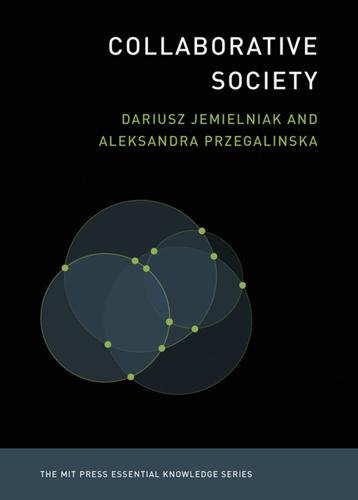
Collaborative Society
by
Dariusz Jemielniak
and
Aleksandra Przegalinska
Published 18 Feb 2020
Monroy-Hernández, “The Cost of Collaboration for Code and Art: Evidence from a Remixing Community,” in Proceedings of the 2013 Conference on Computer Supported Cooperative Work 1035–1046 (ACM, 2013). 44. Botsman and Rogers, What’s Mine Is Yours. 45. W. Hu, “Taxi Medallions, Once a Safe Investment, Now Drag Owners into Debt,” New York Times, September 10, 2017. 46. Reforge Team, “TaskRabbit’s Pioneering Marketplace Model & Missed Growth Opportunities,” Reforge (blog), October 10, 2017, https://www.reforge.com/blog/taskrabbit-marketplace-growth. 47. P. M. Lantz, E. Viruell-Fuentes, B. A. Israel, D. Softley, and R. Guzman, “Can Communities and Academia Work Together on Public Health Research? Evaluation Results from a Community-Based Participatory Research Partnership in Detroit,” Journal of Urban Health 78 (2001): 495–507. 48.
…
In effect this creates a post-Taylorist ideal: the increasingly strict control over the means of production and a sharp decline in workers’ rights. Applying this to the case of ride platforms like Uber, when municipal regulations in the taxi industry began to unravel and control radically shifted to the companies, drivers suffered ever-deeper levels of precarity.27 The CEO of TaskRabbit once openly declared that the company is hoping to “revolutionize the world’s labor force.”28 Indeed, in a truly revolutionary fashion, it appears that this change partly relies on obliterating the achievements of unions thus far in their struggle to secure basic mutual obligations in worker-employer relations.
…
Now Uber and Lyft have upended the market for (and the means of) “hailing” taxis. As a result, medallions are an unbearable financial burden to many owners who cannot compete with apps that impose fewer rules governing fares and vehicle equipment.45 Similarly, the rapid growth of Airbnb has wreaked havoc in the hotel industry and the apartment rental market. TaskRabbit, for its part, made the process of hiring a plumber similar to visiting an online dating site. Its reviews and ratings feature may have removed the hit-or-miss factor in finding competent handyman services. But the company’s recent policy changes on repeat-customers discounts, and an increase in the fees Taskers themselves must pay to the company, have not much lessened the workers’ job precarity.46 Still, there also emerge many phenomena clearly related to sharing and cooperativism, but not necessarily best explained as economic.
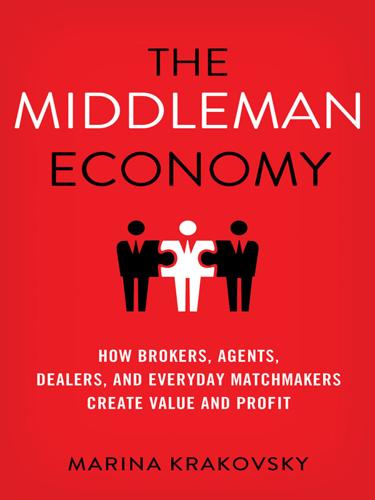
The Middleman Economy: How Brokers, Agents, Dealers, and Everyday Matchmakers Create Value and Profit
by
Marina Krakovsky
Published 14 Sep 2015
Yet, to reach new heights of fame and fortune, these newly minted celebrities have been signing with professional middlemen—the talent agents who scout YouTube for clients needing an advocate in negotiating TV deals and endorsement contracts.10 Facebook, Twitter, and other social media make it easy to strike up conversations with strangers, but when big stars use Facebook and Twitter to engage with fans, it is typically through social media marketers, publicists, and other middlemen with the expertise to do the job better and more efficiently than the celebrities could on their own.11 Finally, consider the workings of the so-called “peer-to-peer” or “sharing” economy—people selling bits of unused labor or other form of spare capacity—which wouldn’t exist through buyers and sellers acting alone. Everywhere you look in the sharing economy, from Airbnb to TaskRabbit, Uber, and ZocDoc, right in the center is a middleman business. So much for the end of middlemen. Of course, there is no question that the Internet has shaken up entire industries and caused the loss of many middleman jobs: think of the stockbroker who merely executes your trade or the travel agent who does nothing more than take your order.
…
In this highly connected world, “things and entities that accelerate connections are going to be more valuable,” Maples believes.15 This idea is self-evident when you think of core Internet technologies and social networking tools that speed up our personal connections; it is also true of middleman businesses Maples has backed, such as Chegg, Lyft, and TaskRabbit, that speed up connections between buyers and sellers. Perhaps more surprisingly, it is also true of many human middlemen, including venture capitalists like Maples himself: great at spotting high-potential entrepreneurial ideas, effective venture capitalists (VCs) command the space between entrepreneurs and the limited partners (LPs) who entrust VCs with their capital.
…
The little boys are with their nanny; child care is not a problem, Thiers jokes because she knows I want to talk to her as the founder of SitterCity, an online service that matches parents with babysitters and nannies.33 SitterCity, which today is successful enough to have allowed Thiers to retire on a chunk of her founder’s stock, struck me as remarkable for two reasons. First, the business started during the dot-com bust—not only before such online matching businesses as Uber, TaskRabbit, and Airbnb had begun to spring up everywhere, but even before the rise of social networking sites. Facebook, LinkedIn, and even now-defunct Friendster did not yet exist in 2000. The other surprise about SitterCity: Thiers is no tech whiz, and she hadn’t taken a single business class; when she conceived of the idea, she was studying opera as a music major at Boston College.
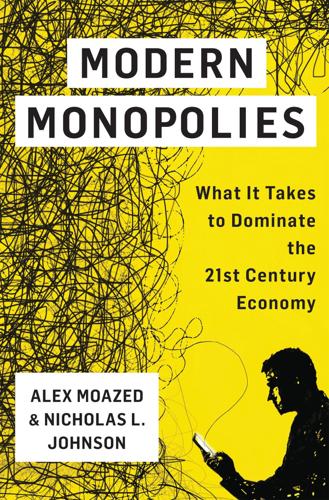
Modern Monopolies: What It Takes to Dominate the 21st Century Economy
by
Alex Moazed
and
Nicholas L. Johnson
Published 30 May 2016
For noncommoditized services platforms, that’s the right way to go. Matching a platform’s design to its type is essential to its success. Platforms that don’t get this right tend to get left behind by the competition. Within services marketplaces, TaskRabbit is a good example. TaskRabbit was one of the first big services marketplaces in the United States. It allows you to hire a “tasker” to do odd jobs, such as cleaning or home repair. However, TaskRabbit acts like a noncommoditized services platform in a commoditized industry. It initially built itself around an auction model, in which users would post tasks to the platform and contractors would seek out and bid on tasks they wanted to complete.
…
In the new model, a consumer is offered a choice of three different producers with a listing of their hourly prices and experience levels and is able to order services on demand, rather than having to wait for bids to come in. This change was a step in the right direction for TaskRabbit. But the update didn’t get everything right, as it still lacked control over pricing. Commoditized services marketplaces should be responsible for setting prices to ensure its users receive the optimal price. If you look at other commoditized services platforms, such as Handy, Lyft, and Glamsquad (an Applico client), consistent and transparent pricing is a core part of their ability to deliver seamless matching. Because TaskRabbit did a poor job at facilitating its core transaction, the platform has been surpassed by upstart competitors, such as Handy.
…
Because TaskRabbit did a poor job at facilitating its core transaction, the platform has been surpassed by upstart competitors, such as Handy. Not surprisingly, Handy puts much more structure around pricing and requesting services than TaskRabbit has. The result is a better user experience and a more seamless transaction model that has helped propel the platform to its position as the leading marketplace for in-home services in the United States. To be clear, that a platform’s core transaction is more commoditized doesn’t mean that its business is at a disadvantage. (What we’re talking about is different from the business becoming commoditized, which would be a concern.) Instead, understanding a platform’s commoditization level shapes how its business model should be designed in order to optimize its core transaction.
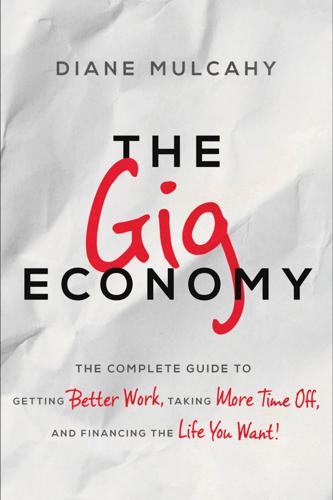
The Gig Economy: The Complete Guide to Getting Better Work, Taking More Time Off, and Financing the Life You Want
by
Diane Mulcahy
Published 8 Nov 2016
But there are many more people willing to be Uber drivers than taxi drivers, in part because they can control when and how much they work. Similarly, the economic plight of an on-demand worker for a company like TaskRabbit or Postmates is not materially different from that of a low-wage hourly worker in a fast food restaurant or retail store. They both have low wages and no benefits, but workers who wouldn’t dream of applying for a job in a fast food restaurant are willing to work on platforms like TaskRabbit or Postmates partly because they can do so when and how much they wish. The Gig Economy gives low-skill workers the chance to move from bad jobs to better work.
…
If we think of the current world of work as a spectrum, anchored by the traditional corporate job and career ladder on one end, and unemployment on the other end, then the broad range and variety of alternative work in between is the Gig Economy. The Gig Economy includes consulting and contractor arrangements, part-time jobs, temp assignments, freelancing, self-employment, side gigs, and on-demand work through platforms like Upwork and TaskRabbit. Many of the topics in this book are based on what I teach, and many of the exercises are based on assignments that have helped my students succeed in the Gig Economy, and have led them to start new businesses, plan time off, restructure their finances, and begin to create lives that are more engaging, satisfying, and better aligned with their priorities.
…
TECHNOLOGY COMPANIES: Somehow, when we encounter part-time workers with no benefits at the local fast food drive-through or contract workers in our local taxi, it’s less newsworthy than when we can beckon those same part-time workers and contractors on our phones and ask them to deliver stuff to us or drive us somewhere. Technology platforms like Uber and TaskRabbit that are built on contract labor models and achieve stratospheric valuations are much more compelling clickbait than a story about a regular taxi driver or someone’s personal assistant. It seems like now that it’s a tech story, labor is suddenly interesting. The labor issues raised by the Gig Economy are not at all new.
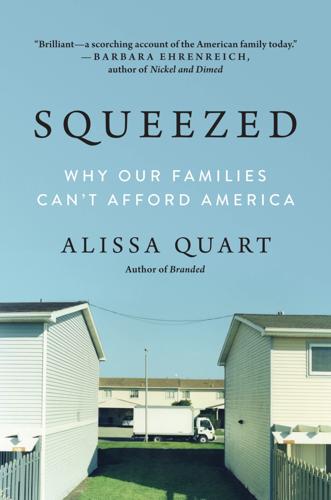
Squeezed: Why Our Families Can't Afford America
by
Alissa Quart
Published 25 Jun 2018
While they are small-bore now, these new app-reliant online co-ops also employ middle-class workers and may put more to work that they have control over in the future. For instance, Stocksy is a successful stock-photo collective that ensures that photographers are paid for their work, and Loconomics, a San Francisco co-op, hopes to compete with the “freelance labor” company TaskRabbit. (When TaskRabbit was purchased by IKEA, I had to wonder whether the ultimate aim was to provide anxious and cheap human workers to help customers assemble their Swedish plywood desks, in a batteries-included scenario.) Stocksy and Loconomics help us imagine new arrangements that could begin to address the many binds in which gig economy workers currently find themselves.
…
The cleaner apps of the past, in the words of one organizer, were “a faceless yellow dismembered hand that cleans your house for you.” The new apps and platforms can train consumers to do more than simply look for the cheapest service and the highest ratings. But what they cannot do is provide this class of worker with things like benefits, which is a big part of their struggle. The workers now TaskRabbit-ing or Uber-ing, however, aren’t thinking about high-minded conception platform cooperativism when they gigged to pay their bills. Matt Barry, for instance, mostly thought about the financial pressure of the area where he lived. Like other Uber drivers, he was plagued with guilt over having to take a side job and not spending time developing his wisdom and skill as a teacher.
…
But Uber’s publicists are neither Jonathan Swift nor Juvenal. In the symbolic realm where a tech company like Uber dwells, the teacher, like the nurse or the firefighter, is instead traded, with the tap of an app, for “well-meaning” capital. The gig economy’s workers often seem to exist in the abstract, as if TaskRabbit’s workers really were the cartoon bunny on its logo, or Uber drivers were simply a human-shaped extension of the company’s letter U. Today the larger problem of undervalued—and underpaid—teachers is that their years of advanced degrees and hard work are more cherished by companies trying to project legitimacy than by the politicians who have long paid teachers mere lip service.

Open for Business Harnessing the Power of Platform Ecosystems
by
Lauren Turner Claire
,
Laure Claire Reillier
and
Benoit Reillier
Published 14 Oct 2017
Table 1.2 Examples of digital platforms Digital platforms connecting communities of users and producers and enabling them to transact Users Producers eBay, Alibaba Airbnb, Onefinestay Uber, Lyft Turo, Drivy BlaBlaCar, Waze Carpool YouTube, Facebook Buyers of goods Guests Passengers Car renters Passengers Viewers Amex, Visa, Mastercard Upwork, Hired Tinder, Match.com, Happn UberEATS, Deliveroo AngelList, Seedrs TaskRabbit, Stootie Kickstarter, Indiegogo Card owners Businesses Single guys dating Buyers of meals at home Investors in start-ups Buyers of services Buyers of new products Sellers of goods Hosts Taxis Car owners Car drivers Content producers and advertisers Merchants Freelancers Single girls dating Restaurants Start-ups seeking capital Providers of services Providers of new products 6 Introduction to platform businesses Since many platform businesses are digital in nature, we use the term digital platform for businesses digitally connecting members of communities to enable them to transact.
…
6 Concentrating on getting 108 Platform scaling: reaching critical mass that magical moment right has had a profound impact on both user retention and engagement. The on-boarding process should be designed to enable these ‘magical moments’. On-boarding can often be more complex on the producer side for two reasons. First, the platform may try to apply quality filters on the producers it accepts. For example, TaskRabbit helpers go through a screening process, including interviews, before being able to offer their services on the platform. There is a trade-off between the selectivity level of the platform towards producers and achieving critical mass as soon as possible. The dynamics between the level of openness for producers joining the platform and the joining customer experience can, however, be flexed over time as the platform scales.
…
This makes it difficult for the platform to capture and share the 148 Platform pricing value created by these interactions. Many platforms suffer from some level of leakage,4 so it needs to be managed carefully, especially if the value capture is done at the transaction stage. This is why some platforms have tried different pricing for first and subsequent transactions between participants. TaskRabbit, a service platform, takes 30% on the first transaction with a producer, and 15% subsequently. Other service platforms, such as Thumbtack, simply monetize the lead/introduction to avoid leakage when participants connect. The more direct the connection between participants, the greater the risk of disintermediation.
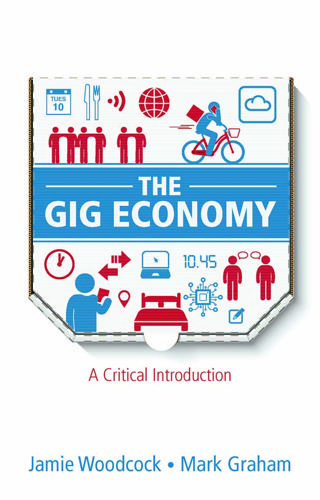
The Gig Economy: A Critical Introduction
by
Jamie Woodcock
and
Mark Graham
Published 17 Jan 2020
There are also emerging stories of resistance on other kinds of platforms, many of which face significant barriers to organizing. For example, Juliet Schor6 points out that on TaskRabbit, workers taking customers off-platform ‘is very prevalent’. TaskRabbit allows customers to request location-specific tasks from workers, while charging a 20 per cent fee. Rather than continuing to have their pay docked by TaskRabbit, Schor notes that ‘once the relationship with the client is established, they don’t feel like TaskRabbit should take such a high fee.’ The reliance on independent contractor or self-employed status makes the issue of worker retention difficult for platforms.
…
Bezos’ letters 87–8, 106 Turkopticon 106–7, 123, 133 Anderson, B. 80 Antunes, Ricardo 36 application programming interfaces (API) 58 apps 5, 51, 52, 133, 138 artificial intelligence 50, 58, 60, 66 Aslam, Yaseen 76 assembly line 24, 94, 117 Australia 127 Australian Independent Contractors Act 128 automation 66–7 Avendano, Pablo 73 B Badger, Adam 86–7 Bangalore (India) 98–9, 102 Barbrook, R. 37 Barry, J. 49 Beck, Ulrich 17 Bent, P. 13, 16 Berg, J. 55 Besant, Annie 14 Bezos, Jeff 87 Bolt 77 Bourdieu, Pierre 17 ‘BrainWorkers’ 33 Braverman, Harry 111 Bryant and May match factory 14 C Californian Ideology 37 call centres 24, 31 outsourcing of 37, 54 Callinicos, Brent 49 Cameron, A. 37 Cant, Callum 40, 96 capitalism cognitive 37 gendered basis of 29 car industry 110 care work 64, 66, 79–83 low barriers to entry 67 and repeat transactions 68 Care.com 80, 80–1 casualization 5, 15 Caviar 73 ‘ChainWorkers’ 33 Cheung, Adora 103 China worker resistance and strikes 100 Christie, N. 73 cleaning work 5–6, 64 low barriers to entry 67 migrant workers 30 cloudworker platforms 6, 43, 53–61, 63, 64, 69, 93 atomization of 92 availability of 56 location of 55, 57 removal of barriers to entry for 69 and resistance 104–8 setting rates of pay 65 and spatial control 63 temporal control 64 cognitive capitalism 37 collaborations 123, 132, 136 collective bargaining 30, 34, 37, 49, 80, 130, 134, 135–6, 143 collective organization 100, 134 commercial content moderation (CCM) 61 computerization 66 consumer attitudes/preferences 27 contingent work 19 Convention on Platform Work, Draft 130, 146–51 cooperatives, platform 138–9 Countouris, N. 129 Craigslist 22 crowdsourcing 58 crowdworkers 55, 90 see also microwork; online freelancing D Dalla Costa, Mariarosa 29 Darcy, Alison 60 data collection 65–6 De Stefano, V. 129 deindustrialization 36, 84 Deliveroo 2, 6, 23, 32, 40, 71–4, 115, 127 experience of working for 7–8, 31, 71, 72–4 self-organization for workers 95 strike action 95–6, 97 delivery work(ers)/platforms 5, 27, 62, 63, 68 and automation 67 and collective organization 134 experiences of workers 71–5 low entry requirements 67 see also Deliveroo democratic ownership 136–40, 141 Denmark 3F trade union 134–5 Desai, Bhairavi 79 developing countries internet penetration rate 25 Didi Chuxing 22, 102 digital divides 25 digital legibility 23–5, 65–7 digital platforms 1, 2, 3, 4, 54–5 Directive on Transparent and Predictable Working Condition in the European Union 129 dock work(ers) 13–14, 15, 38 strike (1889) 15 domestic work(ers) 29–30, 62, 63, 66, 79–83 as central component of capitalism 29 factors determining working conditions 80 numbers 80 positive and negative outcomes for 81 and repeat transactions 68 in South Africa 81–3 Doogan, Kevin 18 E economic crisis (late 1970s) 33 Elance 22 entertainment industries 135 Eurobarometer 40 European Commission 35 Expensify 60 F Facebook 45, 60, 121, 123, 133 factories/factory work 15–16, 94 measuring of factory labour process by Taylor 23–4 Fair Crowd Work website 123 Fairwork Foundation project 121–2, 130, 146–51 Farrar, James 75, 75–6, 77–8, 101 feedback 52, 80, 92, 93 financial crisis (2008) 35 Fiverr 20, 23 flexibility, desire for by workers 4–5, 30–3, 71, 115 flexicurity 35 Flipkart 22 Foodora 127 Fordism 117 fragmented work 5, 40, 114 Freelancer 6, 54, 64, 89 freelancing, online see online freelancing Frey, C.B. 66 G gamification 86 gender and capitalism 29 and relationships of work 28–30 geographically tethered work/platforms 5–6, 7, 34, 50–2, 63 control over workforce 68 forms of resistance in 94–104 setting rates of pay 65 temporal control 64–5 Ghana 8, 64, 92 gig economy advantages 4–5 characteristics 114–15 controversy over classification of people involved 43–4 existence due to digital transformation 114 factors facilitating growth of 19, 114 five principles for ‘fair work’ in 122 future 112–45 governance in 62 meaning of 3–7 numbers working in 1–2 operation of 41–69 origins 11–40 pitfalls 5, 116 preconditions that shape the 19–28 rise of 38–40 ways to bring about change 142–4 gig economy workers barriers to entry for 67–8 communicating with each other 132–4 de-personalization of 118, 120 desire for flexibility 4–5, 31–3, 71, 115 experiences of 70–92 invisibility of 6, 80 lack of collective voice 6, 77 lack of effective regulation for 128–9 misclassified as self-employed 44 numbers 39–40 securing protection through courts 127 working conditions 6, 9 gigs, musical 3 Global North 12, 13, 32, 46 and cloudworkers 55 and microwork 84 and outsourcing 44 size of gig economy 39 Global South 32, 46 internet penetration rate 25 size of gig economy 39 women and online freelancing 90 globalization 19, 37–8 Goodwin, Tom 45, 121 Graeber, David 31 Guru.com 22 H Handy 80 Harvey, David 33, 53 Heeks, Richard 39 Herman, S. 39 Hilfr.dk 134–5 Homejoy 68, 103–4 Howe, J. 58 human intelligence tasks (HITs) 60 Humphries, S. 13–14 Hunt, A. 28, 81, 82 Huws, U. 39–40 I IAEA (International Arts and Entertainment Alliance) 135 Iles, Anthony 32 ILO (International Labour Organization) 16–17, 129 Declaration of Philadelphia (1944) 142 Independent Workers Union of Great Britain see IWGB India delivery drivers 74 strikes by Uber drivers 102 Industrial Workers of the Word see IWW industrialization 16 interface 45 International Arts and Entertainment Alliance see IAEA International Labour Organization see ILO Internet access and penetration rate 25 Irani, Lilly 106 IWGB (Independent Workers Union of Great Britain) 73, 97, 101, 109, 127, 134 IWW (Industrial Workers of the World) 97, 101 J James, Selma 29, 81 job insecurity, growth in 18–19 K Kalanick, Travis 23, 48, 49 Kalleberg, A.L. 18 Kenya Ajira Digital programme 35 Kessler, Sarah 11 L labour law 114, 117, 126, 128, 129 Lagos (Nigeria) 89, 124 Lanier, Jaron 58 LaPlante, Rochelle 60 lean platforms 35, 45 legibility, digital 23–5, 65–7 Li, Qi 100 Limer, Eric 85–6 Living Wage Foundation 122 London taxi arrangement 47 long-term unemployment 18 low-paid work, increase in 35, 139 M Machingura, F. 81, 82 McKinsey 1–2, 39 McKinsey Global Institute 66 Manila (Philippines) 89, 90 Maputo (Mozambique) 26–7 Marsh, Greg 129 Marx, Karl 11–12, 22, 72, 121 Mason, Paul 35 mass connectivity 25–7 Massey, Doreen 63 Matchwoman strike 14 Mateescu, A. 79, 80, 81 Messina, Jim 48–9 microwork 6, 55, 58–61, 62, 83–9, 104 and automation 66–7 experiences of workers 83–9 feelings of alienation 88 numbers engaged in 83–4 wages 84–5 see also Amazon Mechanical Turk 59 migrant workers 30, 80, 90 migration status 30 Mitropoulos, Angela 17, 32 mobile phones 25–6 Mondragon Corporation 138–9 Moody, Kim 40, 111 Moyer-Lee, Jason 98 N Nedelkoska, L. 66 neoliberalism 18, 33–5, 52 characteristics of 34 New York Uber 78–9 NHS (National Health Service) 5 Novogratz, Mike 49–50 O O’Connor vs Uber Technologies Inc. (2015) 124, 126 Ojanperä, Sanna 55 Ola 102 online freelancing 6, 7, 8–9, 43, 55, 62, 141 barriers to entry for workers 67 barriers to organizing 104 experiences of workers 89–92 and feedback 93 reasons for doing 89–90 support forums 104–5 wages 90, 91 and worker resistance 104–5 Osborne, M.A. 66 outcome thinking 118, 124 outsourcing 19, 37–8, 39, 44–5, 51, 54 microwork as extension of 58 P Pandor, Aisha 83 Pasha, Tanveer 102 pay rates, setting of 65 Peck, Jamie 33, 35 Peterloo Massacre (1819) 108 Platform Cooperative Consortium 138 platforms/platform work 2, 4 ability to set pay rates 65 and accountability 125–30 barriers to entry for workers 67–8 as a civic utility 139–40 cloudwork see cloudwork connecting workers and clients 20–1, 22–3, 43, 138 cooperatives 138–9 core functions 23 degree of explicit coordination 68–9 democratic ownership of 136–40, 141 digital legibility 23–5, 65–7 Draft Convention on Platform Work 130, 146–51 early 22 geographically tethered model see geographically tethered model infrastructure 20–3 intermediate function 42–3 lean 35, 45 meaning and operation of 42–6 microwork see microwork negotiation-based matching 22–3 reliance on network effects 45 repeat transactions 68 setting up of ‘counter’ 123 spatial control 62, 63–4 spatiality and temporality of 42–3 spending money on public relations and advertising 28 static-price matching 23 temporal control 64–5 understanding how they work 61–9 Plouffe, David 49 Pollman, E. 49 precariat 18 precarious work(ers) 13–19, 32–3, 38 definition 16–17 two kinds of 33 profitability, crisis of 35, 36, 42 public sector and gig economy 17 and outsourcing 44 Q Quintini, G. 66 R racialization of work 30 racism 30 ratings strategy and transparency 122–3 Ravenelle, Alexandrea 37, 70 Raw, Louise 14 Reagan, Ronald 34 reddit 123 regulation 144 lack of for gig economy workers 128–9 labour law 19, 114, 117, 126, 128 state 19, 33–6 regulatory entrepreneurship 49 repeat transactions and platforms 68 resistance see worker resistance Roberts, Sarah 61 S SAG-AFTRA 135 Samman, E. 28 Schifter, Doug 79 Scholz, Trebor 48, 49, 138, 139 Schor, Juliet 103 Screen Actors Guild (SAG) 135 Second World War 110 self-employment 32, 43–4, 96, 98, 108 Semuels, Alana 84 service industries, growth of 34 Seymour, Richard 18–19 sharing economy 11 Shekhawat, Dushyant 74 ‘shock doctrine’ 34 short term contracts 4 Silberman, Six 106 slavery 30 Slee, Tom 50, 78 soldiering 23 South Africa domestic workers in 81–3 Uber 76, 127–8 worker resistance 99–100 South African Domestic Services and Allied Workers Union (SADSAWU) 82–3 South African Labour Relations Act 128 South Korea 35 South London Gas Workers strike (1889) 14–15 Spain 127 spatial control and platforms 62, 63–4 Srnicek, Nick 4, 42, 45 standard employment relationship 5, 12–13, 16, 18, 32, 33–4 Standing, Guy 17–18, 27 state regulation 19, 33–6 strikes 14–15, 94, 95–6, 99–100, 109, 142–3 preconditions for starting 109 surveillance 24 of delivery drivers 74 Upwork workers’ resistance to 105 Susskind, R. 118 SweepSouth 80, 81–3 Switzerland Notime 102 T TaskRabbit 103 taxi industry 51–2 taxi work(ers) 75–9, 134 and collective organization 134 see also Uber Taylor, Bill 100 Taylor, Frederick 23–4 Taylor, Matthew 129 Taylor Review of Modern Working Practices, The 129 technological changes 19, 21 temporal control and platforms 64–5 temporary work(ers) 3, 17 Thatcher, Margaret 34 Thompson, S. 34 Ticona, J. 79, 80, 81 Tillett, Ben 14 tipping 75 Tolpuddle Martyrs 108–9 trade unions 6, 18, 34, 36, 92–3, 97, 108–9, 134, 135, 143–4 decline of 36, 37 and dock workers 15 early 108–9 and gig economy workers 109–10, 136 and IWGB 97 rise in membership 15 textile 108 Transnational Federation of Couriers 97 transparency 118–24, 141 establishment of ‘counter platforms’ 123 ratings strategy 122–3 Transport for London 28 Turkopticon 106–7, 123, 133 U Uber 2, 4, 20, 23, 25, 32, 44, 45, 46–50, 52, 61, 73–9, 94–5, 108, 115, 121, 124, 139 business model 48 Change.org petition 28 data collection 50, 65–6 drivers’ wages 49–50, 77–8 engagement with regulation and transport policy 48 funding 47–8 and ‘greyballing’ 49 in New York 78–9 O’Connor vs Uber Technologies Inc. (2015) 124, 126 power passengers hold over drivers 75–6 public relations and lobbying campaigns 48–9 rating system 75 safety issues and rising petrol prices for drivers in South Africa 76–7 and self-driving vehicles 50 and tipping 75 Uber International Holding(s) BV 128 Uber Technologies SA 127 UberX 47 worker resistance and strikes 100–2 unfair dismissal 44, 134 United Kingdom employment regulation issues 129 neoliberalism 34 and outsourcing 44–5 worker resistance and strikes 100–1 United Private Hire Drivers (UPHD) 75 United States neoliberalism 34 Uber 47–9 UPHD (United Private Hire Drivers) 76, 101 UpWork 6, 8, 43, 54, 64, 121 resistance of surveillance methods by workers 105 Upwork.com 89, 91 US Chamber of Commerce 108 V van Doorn, Niels 42 Vandaele, Kurt 95, 97 venture capital 36 visibility 136 vWorker 22 W wages microworkers 84–5 online freelancing 90, 91 setting of pay rates 65 Uber drivers 49–50, 77–8 Ward, H. 73 Webster, G.E. 16 Weightman, G.E. 13–14 WhatsApp 95, 99, 123, 132, 133 Williams, Eric 30 women and domestic work 29–30 and online freelancing in the Global South 90 Wood, Alex 95, 104–5, 107 work, transformation of 12–13 worker power 19, 36–7, 130–6, 141 worker resistance 93–111, 113–14 and cloudworkers 104–8 and communication 107 food platform strikes 95–7 formation of networks and meetings 95, 98–9 geographically tethered work 94–104 history of 94 legal battles over employment status 98 and online freelancing 104–5 and self-employment status 98 strikes 14–15, 94, 95–6, 99, 100–1 taking of work off-platform 103 and trade unions 97, 107–11 Uber 101–2 and WhatsApp groups 98, 99, 132 workers’ rights 34, 44, 98, 101, 130, 135, 139, 140, 144 Y YouTube 60 Z Zomato 98–9 POLITY END USER LICENSE AGREEMENT Go to www.politybooks.com/eula to access Polity’s ebook EULA.
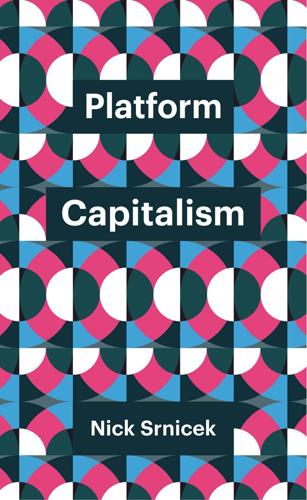
Platform Capitalism
by
Nick Srnicek
Published 22 Dec 2016
Uber, Airbnb), which attempt to reduce their ownership of assets to a minimum and to profit by reducing costs as much as possible. These analytical divisions can, and often do, run together within any one firm. Amazon, for example, is often seen as an e-commerce company, yet it rapidly broadened out into a logistics company. Today it is spreading into the on-demand market with a Home Services program in partnership with TaskRabbit, while the infamous Mechanical Turk (AMT) was in many ways a pioneer for the gig economy and, perhaps most importantly, is developing Amazon Web Services as a cloud-based service. Amazon therefore spans nearly all of the above categories. Advertising Platforms The elders of this new enterprise form, advertising platforms are the initial attempts at building a model adequate to the digital age.
…
Companies like Uber and Airbnb have rapidly become household names and have come to epitomise this revived business model. These platforms range from specialised firms for a variety of services (cleaning, house calls from physicians, grocery shopping, plumbing, and so on) to more general marketplaces like TaskRabbit and Mechanical Turk, which provide a variety of services. All of them, however, attempt to establish themselves as the platform upon which users, customers, and workers can meet. Why are they ‘lean’ platforms? The answer lies in an oft-quoted observation: ‘Uber, the world’s largest taxi company, owns no vehicles […] and Airbnb, the largest accommodation provider, owns no property.’57 It would seem that these are asset-less companies; we might call them virtual platforms.58 Yet the key is that they do own the most important asset: the platform of software and data analytics.
…
Moreover, the aftermath of the crisis was a jobless recovery – a phenomenon where economic growth returns, but job growth does not. As a result, numerous workers were forced to find whatever desperate means they could to survive. In this context, self-employment is not a freely chosen path, but rather a forced imposition. A look at the demographics of lean platform workers seems to support this. Of the workers on TaskRabbit, 70 per cent have Bachelor’s degrees, while 5 per cent have PhDs.76 An International Labour Organization (ILO) survey found that workers on Amazon’s Mechanical Turk (AMT) also tend to be highly educated, 37 per cent using crowd work as their main job.77 And Uber admits that around a third of its drivers in London come from neighbourhoods with unemployment rates of more than 10 per cent.78 In a healthy economy these people would have no need to be microtasking, as they would have proper jobs.
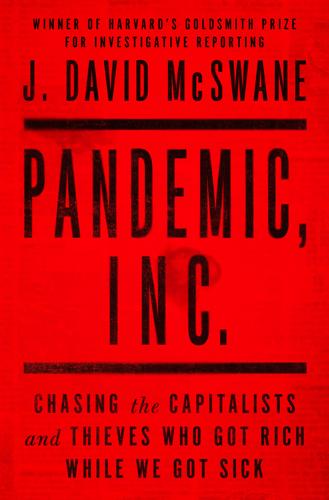
Pandemic, Inc.: Chasing the Capitalists and Thieves Who Got Rich While We Got Sick
by
J. David McSwane
Published 11 Apr 2022
IN THE SUMMER OF 2019, Lucas Rensko and his wife sold their twelve-year-old Mitsubishi Outlander, along with most of their belongings, packed up, and left the breezy, tropical hills of Honolulu, Hawaii, for the oppressive heat and wide river plains of San Antonio, Texas. His wife, a doctor, took a job at a nearby hospital while he hunted for odd jobs on TaskRabbit, the handyman-for-hire app. He delivered groceries and assembled furniture to help pay the bills until something more permanent came along. Then the pandemic hit, and after weeks of pressure, Texas governor Greg Abbott begrudgingly locked down the state—well, sort of. As the lockdowns eased and the public established new levels of comfort and acceptable boundaries, the TaskRabbit gigs began to pop back up, and thirty-six-year-old Rensko made his own risk calculations and decided to pick up a task from a stranger that he thought entailed a simple delivery.
…
It didn’t take much persuasion for Rivera to walk me through it. In mid-April, he responded to a delivery gig sent to him through TaskRabbit. “Need to pick up a truckload of boxes at Southwest Cargo near San Antonio Airport (SAT) and drop off at Texas Dept. of Emergency Mgmt. [TDEM] warehouse,” according to a screen shot Rivera later shared with me. It would take an estimated two to three hours and required a truck, which Rivera rented from U-Haul. This was easy money, Rivera explained, and it came just in time. He made most of his income through jobs on the TaskRabbit app, and after the lockdowns most opportunities for cash dried up because people were no longer inviting strangers into their homes to build Ikea furniture.
…
“[T]hey were on the CDC [Emergency Use Authorization] list before,” one text from Mulligan’s number reads. “They’ve since been removed so we can’t say whether they will meet the KN95 standard.” “He wanted to do the deal immediately,” Hasan said. “This was like a million dollars, and I said you can’t do that.” Instead, on Memorial Day, Hasan met Mulligan and Rivera, his right-hand man from TaskRabbit, at an IHOP off Loop 410, a couple of blocks from the warehouse. “When he told me he was repackaging them, I was out,” Hasan told me. “I’m not a little kid. I’ve been in business for twenty-seven years. C’mon, man. This guy—I can tell you he’s not doing it right.” Near the end of our forty-minute chat, Hasan took out his phone and said he could prove he had nothing to do with Mulligan.
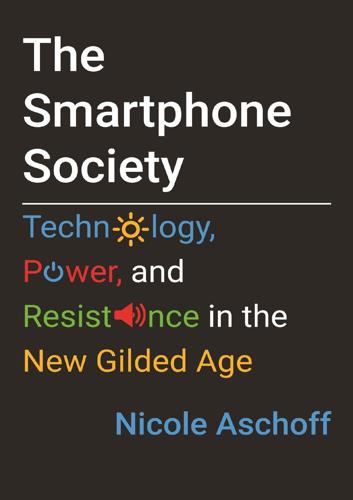
The Smartphone Society
by
Nicole Aschoff
Elites and highly paid professionals live in a different world from leaners. For them, the smartphone dream is a reality. With a few taps and swipes they can restock milk, eggs, and bread from Instacart; avoid the lunch-time rush with a tasty bite delivered through Seamless; hail a Lyft when afterwork cocktails turn tipsy; or hire a “tasker” from TaskRabbit to do a deep clean of the condo before the in-laws arrive. The smartphone brings convenience, a prime commodity for busy professionals who struggle with what sociologist Arlie Hochschild calls the time bind.42 Until recently, women took care of pretty much all the household chores and childrearing duties, even after they entered the waged workforce en masse in the 1980s.
…
The smartphone brings convenience, a prime commodity for busy professionals who struggle with what sociologist Arlie Hochschild calls the time bind.42 Until recently, women took care of pretty much all the household chores and childrearing duties, even after they entered the waged workforce en masse in the 1980s. But these norms are slowly changing. As both women and men work long hours men are picking up (slightly) more of the slack, particularly as pressure to engage in a “concerted cultivation” philosophy of childrearing permeates the middle class.43 With smartphone apps such as TaskRabbit and Amazon Shopping, which now offers personal services, professional couples don’t have to squabble over who’s going to go to the grocery store or pick up the dry cleaning. They can outsource these chores to someone else. They can afford to. The top 10 percent of the American population has seen its income rise considerably in recent decades.
…
A maid, masseuse, taxi driver, personal shopper, whatever you want—“there’s an app for that.” It’s not entirely clear how many people are working in these app jobs—piecework gigs mediated through a smartphone app. In the United States, estimates of “on-demand” app workers who earn money via online intermediaries such as TaskRabbit, Lyft, Uber, and Amazon Shopping vary widely. The Federal Reserve estimated that in 2017, 16 percent of adults earned money from app jobs, while the Bureau of Labor Statistics reported that 3.8 percent of workers (5.9 million people) were classified as contingent workers in 2017.44 Even absent concrete numbers, it is clear that the emergence of app jobs in the past decade is a significant development in the evolution of work in the United States.

The Lonely Century: How Isolation Imperils Our Future
by
Noreena Hertz
Published 13 May 2020
Yet having been unable to secure a job in environmental science (the subject she had majored in at university), and anxious about her levels of student debt, she explains her decision to rent out her company as a pragmatic one, her emotional labour as just another monetisable string to her bow. When she’s not renting herself out – on average she does so a few times a week – she helps start-ups with their social media postings and offers executive assistant services via TaskRabbit. Before we met up I was pretty nervous, not sure if ‘friend’ was covert speak for sexual partner or even if I’d recognise her from her profile picture. But within minutes I feel reassured that this is friends-without-benefits territory. And over the next few hours, as we wander around downtown Manhattan chatting about #MeToo and her heroine Ruth Bader Ginsberg, and at McNallys about our favourite books, at times I even forget I am paying for Brittany’s company.
…
Some workers fear that they will result in them having to stay even longer in the office; others that they would feel more anxious trying to keep up with emails during their workday, and some consider this degree of micromanagement disempowering.90 And, of course, the privilege of ‘disconnection’ is yet another benefit unavailable to the growing swathe of gig economy workers – by which I mean those whose employ with companies as various as TaskRabbit or Uber is facilitated via apps or online platforms, and for whom every hour disconnected means an hour with no chance to earn.91 Just as screen-free schools and phone-free nannies epitomise the new digital divide between wealthy and poor children, guaranteeing the ‘right to disconnect’ for employees with stable, high-paying jobs does nothing for the self-employed who are often the ones whose very livelihood is dependent on constant connection.
…
And just as with the ‘algorithmic pre-hiring assessments’, the opacity of these rating systems means that bias is neither spotted nor challenged. This is especially concerning given the extent to which racial and gender biases impact ratings; for example, black and Asian workers receive lower ratings than Caucasians on freelancer platform Fiverr, whilst on TaskRabbit clients regularly assign black ‘Taskers’ (particularly men) lower scores than non-black workers with similar levels of experience.54 Moreover, ratings’ mechanisms don’t just occlude bias; they risk amplifying it. For it is a known fact that people are prone to anchoring someone’s rating on the published rating already attributed to them.55 What this means is that if you see that someone has a low rating, rather than interrogating why this may be so and committing to make your decision on the actual facts, you’re more likely to simply rate them low yourself.

The Network Imperative: How to Survive and Grow in the Age of Digital Business Models
by
Barry Libert
and
Megan Beck
Published 6 Jun 2016
The relationships, or connections, created by a network orchestrator may actually provide access to any of the other asset types and leverage a digital platform for connectivity. Here are examples. eBay and Etsy are network orchestrators that provide access to physical capital (things you can buy). TaskRabbit and Upwork are network orchestrators that provide access to human capital in the form of errand runners and freelancers (people). Innocentive and Yelp are network orchestrators that provide access to intellectual capital, such as technological innovation or restaurant reviews (ideas). Facebook, LinkedIn, and Match.com are network orchestrators that provide access to network capital, specifically social and professional connections (relationships).
…
Network platforms can help facilitate the creation and exchange of any of the four types: Physical capital: access to physical assets that are related to your products, value proposition, or industry. Examples: Airbnb, Uber Human capital: expertise related to your products, processes, or industry. Examples: TaskRabbit, Apple Developer Network Intellectual capital: feedback on products or services, input on product design, data about themselves, or product usage. Examples: Yelp, TripAdvisor Network capital: word-of-mouth advertising, access to friends and family. Examples: Facebook, LinkedIn The best place to begin is with those networks that already have high affinity for your firm; these members are the most likely to participate in a new network initiative.
…
See also mindset action by network leaders and evolution of, 192–194 as barriers in strategy shifts, 50 of boards, 106, 108 breaking habits and, 198 mentoring for, 198–199 move to intangible assets and, 46 of network orchestrators, 194–195 new stories needed for, 198 Pinpointing in PIVOT process, 137–139 reinforcing, to realize change, 197–199 mentors, 108, 162, 198–199 Microsoft, 76, 80, 133 millennials, 8, 89, 90, 130, 155, 199 mindset, 28, 113–120 diversification of new ideas and methods in, 115 examples of companies using, 118–119 General Motors’ example of change in, 113–114 move from closed to open in, 115–118, 120, 186 network orchestrators and, 114–115, 118, 202 openness to change and, 114–115 organizational culture supporting, 117–118 questions to ask about, 117 scoring your company on, 121–122 minorities, and board membership, 105, 108 mission, 67, 92, 103–104, 118, 119, 140, 163 mission statement, 117 mobile technology customers’ use of, 156 examples of companies using, 36, 53, 70, 110, 191, 197 as key technology, 32 network orchestrators and, 148 platform choice and, 162 multiplier (price/revenue) market valuation comparison among business models using, 18–19 performance comparison among business models using, 16 use of term, 17–18 Myatt, Mike, 90 NASA, 73 Netflix, 46, 82–83, 196 Net Promoter Score (NPS), 65, 83 network capital business model based on, 15, 132 inventory of, 126, 145, 146, 149–151 mental model values on, 138 network orchestrators’ use of, 16 network platforms and, 160 Network Challenge, The (Kleindorfer, Wind, and Gunther), 7 network leader on teams, 169–170, 178, 179 network leaders in organizations, 189–203 core beliefs of, 192 digital technology changes and, 190 guiding principles of, 192–193 mental model evolution of, 192–194 network orchestrators as, 202 new thinking needed by, 189 responses to rapid pace of change by, 190–191 network orchestrators as allocators, 51, 54 boards and, 106–107 digital platforms used by, 33, 36–37 economic advantages of, 15–16 evaluating organization’s performance as, 135–136 examples of, 14 financial services and, 130 identifying organization’s characteristics related to, 133–135 industry sector adoption comparison for, 22–23 intangible assets and, 42, 44 leadership and, 56, 58–59, 60, 61, 62–63 market valuation comparison for, 17–19 measurement used by, 97 mental models of, 21, 194–195 mindset openness and, 114–115, 118, 202 network capital used by, 15 as network leaders, 202 number of companies analyzed for, 13 number of companies using, 22 overview description of, 14 performance comparison for, 16 PIVOT assessment of business models with, 132–133 possible situations behind slow adoption of, 23 scalability characteristics of, 15–17 tracking network and platform metrics for, 178–179 value creation comparison for, 19–20 Visualizing business model for, in PIVOT process, 157–158 networks best practices of legacy firms compared with companies using, 20 boards and, 104–106, 110–111 customer groups within, 149–150 intangible needs met by, 21 law of increasing returns and, 12 open organizations’ use of, 116 power of, 8, 12, 24, 28 subscription model using, 80 network sentiment, 44, 97, 98, 100, 150, 179, 180 Nickell, Jake, 68 Nike, 53, 70, 82, 160, 161, 171 Nike+, 53, 161, 171 Nordstrom, 76 Ocean Tomo, 97 Oculus VR, 36 online forums, 70, 72, 162 OpenMatters, business models research of, 131 OpenMatters website additional resources and support on, 128, 131, 203 business model resources on, 121 digital tools on, 10, 131 mental model assessment on, 138 survey of organization’s characteristics on, 135 openness examples of companies with, 118–119 mindset with, 114–115, 120 open organizations diverse initiatives and business units in, 116–117 examples of, 118–119 innovation pipeline in, 116 move from closed organization to, 115–118, 120, 186 organizational culture supporting, 117–118 questions to ask about, 117 talent in, 117 Operate step in PIVOT, 126, 127, 169–176, 186 creating platform in, 170–172 Enterprise Community Partners example for, 175–176 goal of, 169 management plan for, 174–175 management practices in, 172–174 selecting network leader and team in, 169–170, 173 organizational culture, and openness, 117–118 Page, Larry, 118, 119 Palmisano, Sam, 50 partners customer contributors as, 34, 58, 59 independent workers as, 89, 90–92, 93 performance business model comparison for, 18–19 Pinpointing in PIVOT process, 135–136 Phone Case of the Month, 81 physical capital business model based on, 15, 132 inventory of, 126, 145, 146, 163 mental model values on, 138 network platforms and, 159 Pinpoint step in PIVOT, 126, 130–141, 185 assessing current business model in, 131–132 defining current business model in, 132–133 defining mental model in, 137–139 Enterprise Community Partners example for, 140–141 goal of, 130–131 identifying organization’s characteristics in, 133–135 reviewing economic performance in, 135–136 Pinterest, 44 PIVOT, 123–186 additional resources and support for, on OpenMatters website, 128, 131 change leader in, 132 Enterprise Community Partners example for, 127 five steps of, 126–127 introduction to, 125–128 Pixar, 68 plans for big data use, 99–100 for filling technology, talent, and capital gaps in platforms, 171–172 for growth, on OpenMatters website, 10 for network management, 174–175 for reallocating capital, 157–158 PricewaterhouseCoopers, 106 principles for network orchestration, 25–122 as challenges and levers for change, 27 list of, 27–28 research identifying, 21, 28 scoring your company on, 121–122 Principles of Economics (Mankiw), 49 Project Loon, 167 Red Hat, 133 referrals, 78, 79, 175, 183 Reichheld, Fred, 65 relationships with customers data collection in, 81–82 as intangible asset, 42 leaders affected by changes in, 56–58 personalized approach to, 82 in subscription model (see subscription model) revenues, 28, 75–83 advantages of subscription models for, 77–78 data acquired with, 78, 81–82 move from transaction to subscription in, 78, 79–82 Netflix versus Blockbuster example in, 82–83 nonrevenue activities in subscription model and, 78–79 recurring, in subscription model, 75–77 scoring your company on, 121–122 reverse mentoring, 108, 162, 199 ride-sharing services, 44, 85, 113, 155, 197 Rouse, Jim, 127, 128, 165, 184 Rouse, Patty, 127 Russell Reynolds, 107 Salesforce.com, 176 scalability advantages of, 31 business model comparison for, 15–17, 132 cloud technology and, 32 costs with, 12, 16, 17, 19, 33, 63, 139 digital technology enabling, 3, 33, 41, 44, 162 economics of scale contrasted with, 17 global access and, 31 of network lodging options, 156 network orchestrators and, 172, 202 Threadless example of, 69 scale economics, 17 service providers evaluating organization’s performance as, 135–136 examples of, 14 human capital used by, 15 identifying organization’s characteristics related to, 133–135 industry sector adoption comparison for, 22 market valuation comparison for, 18–19 number of companies analyzed for, 13 overview description of, 14 performance comparison for, 16 PIVOT assessment of business models with, 132–133 scalability characteristics of, 16, 17 value creation comparison for, 19–20 services as intangible asset, 41 subscription model using, 80 shared vision, and co-creators, 61 sharing-economy companies, 44, 85, 113, 155, 197 show-rooming, 45 Sidecar, 44 Sitaram, Pradip, 140, 152, 164, 175–176, 183, 184 skills assessment, 138 smartphones, 29–30, 32 social media, 29 boards’ use of, 107 CEOs’ use of, 199 customer data from, 97, 98, 101 examples of companies using, 53–54, 143, 180 interactions with companies using, 58, 80, 107, 202 as key technology, 32 leveraging for marketing and communication, 34 network sentiment tracked on, 180 platform choice and, 33, 162 public relations problems from customers’ use of, 42–43 subscription model using, 77–78, 80 Softlayer, 48 software subscription model, 76, 80 Spencer Stuart, 105 Sprint, 81 Stanford University, 107 Starbucks, 53, 109, 143, 190, 191 Starwood Hotels, 4, 43–44 strategy, 27, 47–54 barriers to changing, 48–49, 50 best practices of allocators in, 52–53 capital allocation as focus of, 49–51 IBM as example of shift in, 47–48, 50 move from operator to allocator in, 51–52 Nike-Apple partnership as example of, 53–54 questions to ask about, 52 scoring your company on, 121–122 subscription model advantages of, 77–78 customer contributors and, 77 data acquired in, 78, 81–82 examples of companies using, 75–76 moving customers from transactors to subscribers in, 78, 79–80 Netflix versus Blockbuster example in, 82–83 nonrevenue activities in, 78–79 personalized approach in, 82 recurring revenue from, 76–77 surprising and delighting the customer in, 81 themes in implementing, 80–82 types of offerings in, 80 talent big data collection and, 100 customer contribution of, 69 for digital platform operation, 170–171 experience in digital technologies needed by, 35 innovation and, 168 in open organizations, 117 tangible assets as financial liabilities in, 43–44 market valuation of intangible versus, 40, 46 move to intangible assets from, 44–45 Target, 76 TaskRabbit, 15, 159 Team of Teams: New Rules of Engagement for a Complex World (McChrystal), 55 technology, 27, 29–37 advantages of using, 31 business models incorporating, 30–31 embracing “digital everything” in, 30–31 essential aspect of, 29–30 importance of understanding and using, 30 management practices for intangible assets related to, 42 mentorships for, 199 move from physical to digital in, 34–37 platforms and, 33–34 questions to ask about, 35 scoring your company on, 121–122 talent needed for, 35 understanding five key technologies in, 32–33 technology creators evaluating organization’s performance as, 135–136 examples of, 14 identifying organization’s characteristics related to, 133–135 industry sector adoption comparison for, 22 intellectual capital used by, 15 market valuation comparison for, 18–19 number of companies analyzed for, 13 overview description of, 14 technology creators (continued) performance comparison for, 16 PIVOT assessment of business models with, 132–133 scalability characteristics of, 16, 17 value creation comparison for, 19–20 Tesla, 114 Threadless, 68–70, 72, 73, 78, 79, 81 3M, 91, 190 Thrun, Sebastian, 168 Topsy, 98 Track step in PIVOT, 126, 127, 177–184, 186 Amazon example of, 177–178 Enterprise Community Partners example for, 183–184 goal for, 178 network and platform metrics for, 178–179 network dimensions used in, 179–180 ongoing experimentation with, 182–183 platform dimensions used in, 180–181 team dimensions used in, 181–182 Trader Joe’s, 78 transactors, customers as, 78, 79–80 TripAdvisor, 10, 14, 44, 159, 174 Trunk Club, 76 Twitter, 42, 59, 60, 66, 72, 78, 79, 89, 97, 100, 107, 148, 171, 180, 199 Uber, 3, 4, 44, 66, 70, 81, 85, 91, 114, 155, 159, 160, 174, 197 United Healthcare, 133 US Board Index, 105 US interstate highway system, 11–12 Upwork, 12, 15, 43 value creation business model comparison for, 19–20 co-creators and, 61, 62–63 mental model beliefs on, 138–139 nonemployees and, 91 values assessment, 138 van Kralingen, Bridget, 47, 48 Verizon, 81 virtual reality (VR) technology, 36 Visa, 133 vision, and co-creators, 61 Visualize step in PIVOT, 126, 127, 156–165, 186 analyzing possible contribution to networks in, 160–161 beginning step for, 157–158 choosing platform in, 162–163, 170 Enterprise Community Partners example for, 163–165 goal of, 156–157 identifying potential networks in, 159–160 network orchestrator business model in, 157–158 overview of process in, 158–159 selecting network for, 161–162 team in, 158 VRBO, 156 Walmart, 4, 14, 76, 110, 133, 144 Wealthfront, 130 Weatherup, Craig, 110 WeChat, 4 Welch, Jack, 108, 199 Werhane, Charlie, 140, 164, 184 Wikipedia, 8, 46 Wind, Jerry, 6, 7 women, and board membership, 105, 108, 109 workforce.

The Wealth of Humans: Work, Power, and Status in the Twenty-First Century
by
Ryan Avent
Published 20 Sep 2016
Still, there is indisputably the opportunity for significant growth in the future. The question is whether the gig economy will lead to the suspension of the trilemma. The trilemma implies that to scare up enough consumer demand for ‘gigs’, the price – of the Uber trip or the TaskRabbit errand, for example – must be low. That, in turn, means that pay must be low. Uber driver wages can’t rise to too high a level or Uber will accelerate automation. Similarly, TaskRabbit tasks can’t be too expensive, or people will only use the service on rare, higher value occasions, reducing the labour-absorbing power of the service. A suspension of the trilemma means the arrival of a world of hyper-specialization, in which the market-expanding, match-generating power of the web becomes so powerful that most of the world’s billion workers can find themselves a tiny niche that is nonetheless lucrative enough to keep them fed and housed, but which isn’t, in the end, doable with software.
…
Yet the firm’s business does demonstrate how the technological deskilling of an occupation can lead to both a better experience for consumers and better pay for some workers. Yet the example is not especially cheering. Many more of the digital revolution’s disruptive business models work by reducing employment of less-skilled workers than by creating new opportunities for them. Other labour-intensive apps – such as TaskRabbit, which allows users to hire people for short-term gigs as errand-runners – work not because they make unskilled labour vastly more productive, but because unskilled labour is abundant and cheap enough to make it economical to harness such workers to do unproductive jobs: waiting in queues, for example.
…
Ray labour abundance as good problem bargaining power cognitive but repetitive collective bargaining and demographic issues discrimination and exclusion global growth of workforce and immigration liberalization in 1970s/80s ‘lump of labour’ fallacy occupational licences organized and proximity reallocation to growing industries retraining and skill acquisition and scarcity and social value work as a positive good see also employment Labour Party, British land scarcity Latvia Le Pen, Jean-Marie Le Pen, Marine legal profession Lehman Brothers collapse (2008) Lepore, Jill liberalization, economic (from 1970s) Linkner, Josh, The Road to Reinvention London Lucas, Robert Lyft maker-taker distinction Malthus, Reverend Thomas Manchester Mandel, Michael Mankiw, Gregory marketing and public relations Marshall, Alfred Marx, Karl Mason, Paul, Postcapitalism (2015) McAfee, Andrew medicine and healthcare ‘mercantilist’ world Mercedes Benz Mexico Microsoft mineral industries minimum wage Mokyr, Joel Monroe, President James MOOCs (‘massive open online courses’) Moore, Gordon mortality rates Mosaic (web browser) music, digital nation states big communities of affinity inequality between as loci of redistribution and social capital nationalist and separatist movements Netherlands Netscape New York City Newsweek NIMBYism Nordic and Scandinavian economies North Carolina North Dakota Obama, Barack oil markets O’Neill, Jim Oracle Orbán, Viktor outsourcing Peretti, Jonah Peterson Institute for International Economics pets.com Philadelphia Centennial Fair (1876) Philippines Phoenix, Arizona Piketty, Thomas, Capital in the Twenty-First Century (2013) Poland political institutions politics fractionalization in Europe future/emerging narratives geopolitical forces human wealth narrative left-wing looming upheaval/conflict Marxism nationalist and separatist movements past unrest and conflict polarization in USA radicalism and extremism realignment revolutionary right-wing rise of populist outsiders and scarcity social membership battles Poor Laws, British print media advertising revenue productivity agricultural artisanal goods and services Baumol’s Cost Disease and cities and dematerialization and digital revolution and employment trilemma and financial crisis (2008) and Henry Ford growth data in higher education of highly skilled few and industrial revolution minimum wage impact paradox of in service sector and specialization and wage rates see also factors of production professional, technical or managerial work and education levels and emerging economies the highly skilled few and industrial revolution and ‘offshoring’ professional associations skilled cities professional associations profits Progressive Policy Institute property values proximity public spending Putnam, Robert Quakebot quantitative easing Race Against the Machine, Brynjolfsson and McAfee (2011) railways Raleigh, North Carolina Reagan, Ronald redistribution and geopolitical forces during liberal era methods of nation state as locus of as a necessity as politically hard and societal openness wealth as human rent, economic Republican Party, US ‘reshoring’ phenomenon Resseger, Matthew retail sector retirement age Ricardo, David rich people and maker-taker distinction wild contingency of wealth Robinson, James robots Rodrik, Dani Romney, Mitt rule of law Russia San Francisco San Jose Sanders, Bernie sanitation SAP Saudi Arabia savings glut, global ‘Say’s Law’ Scalia, Antonin Scandinavian and Nordic economies scarcity and labour political effects of Schleicher, David Schwartz, Anna scientists Scotland Sears Second World War secular stagnation global spread of possible solutions shale deposits sharing economies Silicon Valley Singapore skilled workers and education levels and falling wages the highly skilled few and industrial revolution ‘knowledge-intensive’ goods and services reshoring phenomenon technological deskilling see also professional, technical or managerial work Slack (chat service) Slate (web publication) smartphone culture Smith, Adam social capital and American Constitution baseball metaphor and cities ‘deepening’ definition/nature of and dematerialization and developing economies and erosion of institutions of firms and companies and good government and housing wealth and immigration and income distribution during industrial revolution and liberalization and nation-states productive application of and rich-poor nation gap and Adam Smith and start-ups social class conflict middle classes and NIMBYism social conditioning of labour force working classes social democratic model social reform social wealth and social membership software ‘enterprise software’ products supply-chain management Solow, Robert Somalia South Korea Soviet Union, dissolution of (1991) specialization Star Trek state, role of steam power Subramanian, Arvind suburbanization Sweden Syriza party Taiwan TaskRabbit taxation telegraphy Tesla, Nikola Thatcher, Margaret ‘tiger’ economies of South-East Asia Time Warner Toyota trade China as ‘mega-trader’ ‘comparative advantage’ theory and dematerialization global supply chains liberalization shaping of by digital revolution Adam Smith on trade unions transhumanism transport technology self-driving cars Trump, Donald Twitter Uber UK Independence Party United States of America (USA) 2016 Presidential election campaign average income Bureau of Labour Statistics (BLS) Constitution deindustrialization education in employment in ethno-nationalist diversity of financial crisis (2008) housing costs in housing wealth in individualism in industrialization in inequality in Jim Crow segregation labour scarcity in Young America liberalization in minimum wage in political polarization in post-crisis profit rates productivity boom of 1990s real wage data rising debt levels secular stagnation in shale revolution in social capital in and social wealth surpasses Britain as leading nation wage subsidies in university education advanced degrees downward mobility of graduates MOOCs (‘massive open online courses’) and productivity see also education urbanization utopias, post-work Victoria, Queen video-gamers Virginia, US state Volvo Vox wages basic income policy Baumol’s Cost Disease cheap labour and employment growth and dot.com boom and financial crisis (2008) and flexibility and Henry Ford government subsidies and housing costs and immigration and industrial revolution low-pay as check on automation minimum wage and productivity the ‘reservation wage’ as rising in China rising in emerging economies and scarcity in service sector and skill-upgrading approach stagnation of and supply of graduates Wandsworth Washington D.C.

The Contrarian: Peter Thiel and Silicon Valley's Pursuit of Power
by
Max Chafkin
Published 14 Sep 2021
Thiel was concerned: Thiel’s 2009 Cato essay refers to the 1920s as the “last decade in American history during which one could be genuinely optimistic about politics,” singling out the “vast increase in welfare beneficiaries,” in addition to women’s suffrage. back up the shift: Danielle Sacks, “How Silicon Valley’s Obsession with Narrative Changed TaskRabbit,” Fast Company, July 17, 2013, https://www.fastcompany.com/3012593/taskrabbit-leah-busque. “America’s leading public intellectual”: Roger Parloff, “Peter Thiel Disagrees with You,” Fortune, September 4, 2014, https://fortune.com/2014/09/04/peter-thiels-contrarian-strategy/. Thiel laughed this off: Jennifer Schuessler, “Still No Flying Cars?
…
There was Lyft, a ride-hailing app that replaced taxi drivers with regular people driving their own cars. (Lyft developed this idea; Uber would copy it and make it famous.) The Founders Fund portfolio also included Airbnb, a lodging service to let people rent out spare bedrooms or vacation homes; TaskRabbit, where “gig workers” offered to do odd jobs, like laundry and dogwalking; and Postmates, a similar service, except the gig workers delivered you gourmet food instead of putting together your IKEA furniture. Though the apps had a few detractors, the press focused almost exclusively on their promise.
…
But, of course, Airbnb and Lyft also had implications beyond neighborliness. They were projects designed to reshape labor markets, removing the protections that workers had enjoyed since the New Deal, which was among the worst developments in American political history, as far as Thiel was concerned. Uber and Lyft drivers, TaskRabbit and Postmates workers, and the part-time hoteliers of Airbnb were not employees and couldn’t be by definition. That meant the app companies they worked for—Thiel’s portfolio companies—were under no obligation to provide for their health insurance or retirement or to negotiate with unions that represented them.

Trixie and Katya's Guide to Modern Womanhood
by
Trixie Mattel
and
Katya
Published 15 Nov 2020
Having mental illness is like having a short torso or a big forehead—there are ways around it. Here’s my foolproof plan to decluttering: HIRE SOMEONE I grew up extremely poor. I learned how to be very self-sufficient and handle everything on my own. Then in my midtwenties, I became rich and famous and my entire sense of self-sufficiency shifted. TaskRabbit or an out-of-work-actor friend became my personal staffing solution. The advantage here of having a second pair of hands is the blindness. I will fight you to the death for a five-year-old pair of wrongly sized shoes from Primark that I never wear. But if my assistant throws them away and doesn’t tell me, I never realize they’re gone or ever even think of them again.
…
But if my assistant throws them away and doesn’t tell me, I never realize they’re gone or ever even think of them again. If my husband ever dies prematurely, just remove the body and his belongings from my home—I bet I’d completely forget I was ever married. YELL FROM ANOTHER ROOM If you’re only lightly involved in your own problems, like me, you can let your TaskRabbit or teenage child worker describe items to you vaguely via Skype while you lounge in another part of the house. I pull out my earbuds only long enough to scream, “Keep” or “Toss.” KEEP GOING Sure you’ve eliminated all of your unworn clothes and excess tchotchkes, but why stop there? Pick up every single item in your house with your hands, close your eyes, and think, “Is this something I need to survive?”

Coders: The Making of a New Tribe and the Remaking of the World
by
Clive Thompson
Published 26 Mar 2019
anything else for you: Steven Overly, “Washio Picks Up Your Dirty Laundry, Dry Cleaning with the Tap of an App,” Washington Post, January 30, 2014, https://www.washingtonpost.com/business/capitalbusiness/washio-picks-up-your-dirty-laundry-dry-cleaning-with-the-tap-of-an-app/2014/01/29/08509ae4-8865-11e3-833c-33098f9e5267_story.html; Steven Bertoni, “Handybook Wants to Be the Uber for Your Household Chores,” Forbes, March 26, 2014, https://www.forbes.com/sites/stevenbertoni/2014/03/26/handybook-wants-to-be-the-uber-for-your-household-chores/#221628987fa9; Brittain Ladd, “The Trojan Horse: Will Instacart Become a Competitor of the Grocery Retailers It Serves?,” Forbes, July 1, 2018, https://www.forbes.com/sites/brittainladd/2018/07/01/__trashed-2/#7cc74ef1e4d1; Ken Yeung, “TaskRabbit’s App Update Focuses on Getting Tasks Done in under 90 Minutes,” VentureBeat, March 1, 2016, https://venturebeat.com/2016/03/01/taskrabbits-app-update-focuses-on-getting-tasks-done-in-under-90-minutes; all accessed August 18, 2018. “wanting to replicate mom”: Clara Jeffery (@ClaraJeffery), “So many Silicon Valley startups,” Twitter, September 13, 2017, accessed August 18, 2018, https://twitter.com/clarajeffery/status/907997677048045568?
…
By the mid-2010s, Silicon Valley entrepreneurs started flooding the market with apps designed to optimize nearly every fiddly task of everyday life—offering to do work so you didn’t. There was Washio (a service that dispatched laundry “ninjas” to pick up your dirty clothes), Handy (on-demand apartment neatening), Instacart (to pick up items from the local grocery store), and the endless phalanxes of TaskRabbits (to do basically anything else for you). In terms of pure demography, there’s a deep narcissism at work here. The blizzard of “do stuff for me” apps is what you get when you populate a tech hub—San Francisco—with a plurality of young men just out of college, and give them the tools of optimization and geysers of money for start-ups.
…
(game), ref1 spaghetti code, ref1, ref2 Spanner, ref1 spear phishing, ref1 Spectre, Rob, ref1, ref2, ref3, ref4 “Speculations Concerning the First Ultraintelligent Machine” (Good), ref1 Speer, Robyn, ref1, ref2 spellcheck, ref1 Spertus, Ellen, ref1 Spolsky, Joel, ref1 Stack Overflow, ref1 Stallman, Richard, ref1, ref2, ref3 Stand Out of Our Light (Williams), ref1 Starr, Arnold, ref1 start-ups culture fit concern in hiring women coders, ref1 10X coders and, ref1 Stevens, William, ref1 Stone, Biz, ref1, ref2, ref3 Stroustrup, Bjarne, ref1 Sullivan, Danny, ref1 Superintelligence (Bostrom), ref1 surge pricing, ref1 SVG graphics, ref1 Swartz, Aaron, ref1 Symbolics, ref1 Symbolic Systems, ref1 Systrom, Kevin, ref1, ref2 tangible and objective results, coder’s pride in achieving, ref1 Tanz, Jason, ref1 TaskRabbits, ref1 Taylor, Frederick Winslow, ref1 technical debt, ref1 10X coders, ref1 Andreessen on, ref1, ref2, ref3 “brilliant jerk” problem, ref1 Brooks on, ref1 at Dropbox, ref1, ref2 examples of software built by one- or small-person teams, ref1 origins of concept, ref1 pop culture examples of, ref1 start-up environment and, ref1 unease of 10x coders with rock star concept, ref1 TensorFlow, ref1 Terminator (film), ref1 Thiel, Peter, ref1, ref2, ref3, ref4 Thompson, Ken, ref1 Thornton, Jacob, ref1 Thorpe, Chris, ref1 Thunderbird, ref1 Tor, ref1 Torvalds, Linus, ref1, ref2, ref3 trolls, ref1, ref2 Tron (film), ref1 TRS-80, ref1 Trulia, ref1 Trump, Donald, ref1, ref2, ref3 Tufekci, Zeynep, ref1, ref2 Turner, Fred, ref1 Turner, Jamie, ref1, ref2 Tweepy, ref1 Twilio, ref1 Twitter, ref1, ref2, ref3, ref4, ref5 ad tech, civic impacts of, ref1 algorithm ranking systems at, ref1 content moderation, ref1, ref2 ethical blind spots of designers and engineers, effects of, ref1 free-to-use model of, ref1 harassment on, ref1, ref2, ref3 measures to combat harassment, ref1 2001: A Space Odyssey (film), ref1, ref2 2600, ref1, ref2 Uber, ref1, ref2, ref3, ref4, ref5, ref6, ref7 Unlocking the Clubhouse (Fisher and Margolis), ref1 Upload VR, ref1 user behavior, ref1 Uwazie, Nnamdi, ref1 Vaidhyanathan, Siva, ref1, ref2, ref3 Varma, Roli, ref1, ref2 venture capital funding pattern matching bias and, ref1 priorities of next generation of, changing, ref1 scale and, ref1 Vim, ref1 voting machines, penetration testing of, ref1 Wall, Larry, ref1, ref2 Wang Xing, ref1 WannaCry malware, ref1, ref2 Ward, Matt, ref1 WarGames (film), ref1, ref2 Washio, ref1 Waste Land, The (Eliot), ref1 waterfall design, ref1 Weapons of Math Destruction (O’Neil), ref1 web coding, ref1 WeChat, ref1 Weinstein, Harvey, ref1 Weisman, Jonathan, ref1 Weizenbaum, Joseph, ref1, ref2 Wescoff, Marlyn, ref1 “When and Why Your Code Starts to Smell Bad” (Tufano et al.), ref1 Whitney, Max, ref1, ref2 Whyte, William H., ref1 Weird Science (film), ref1 Wikipedia, ref1 Wilkes, Mary Allen, ref1, ref2 development of LINC personal computer and, ref1 education of, ref1 first how-to programming book written by, ref1 hired as programmer at MIT’s Lincoln Labs, ref1 IBM 704 programming of, ref1 Wilkes, Maurice, ref1 William, Alan, ref1 Williams, James, ref1, ref2 Wing, Jeannette, ref1 Wired, ref1, ref2, ref3, ref4 women coders, ref1 bifurcation in pay and prestige of coding jobs available to, ref1 biological argument for dearth of, ref1 black women coders, ref1 capacity crisis, impact of, ref1 culture fit concern of start-ups in hiring, ref1 current lack of, ref1, ref2 decline in computer science degrees, 1984 onward, ref1, ref2 ENIAC computer and, ref1, ref2 experiences of, in programming classes, ref1 first compilers designed by, ref1 front-end coding and, ref1 geek myth, impact of, ref1, ref2 hacker generation of late 1960s and 1970s and, ref1 Hollywood’s reinforcement of boys’ club message, ref1 hostile work environment and harassment encountered by, ref1, ref2, ref3, ref4 in India and Malaysia, ref1 Lovelace as first programmer, ref1 midcareer women leaving industry, ref1 mistaken for PR personnel, ref1 in 1950s and 1960s, ref1, ref2 open source software and, ref1 pattern matching bias and, ref1 percentage in workplace, 2017, ref1 reversing shift of women out of coding, ref1 shift to maleness in coding and BBS cultures of 1980s, ref1, ref2 undermining comments and negative feedback given to, ref1 in World War II, ref1 Word2vec, ref1, ref2 word embedding, ref1 WordPress, ref1 Wozniak, Steve, ref1 writing versus coding, rewards of, ref1 Wu, Brianna, ref1 Wyden, Ron, ref1 Yan, Jinghao, ref1 Yang, Kevin, ref1 Y combinator accelerator, ref1 Yee, Marty, ref1 Yitbarek, Saron, ref1, ref2 Young, Michael, ref1 Your Career in Computers, ref1 YouTube, ref1, ref2 algorithm ranking systems at, ref1, ref2 content moderation, ref1, ref2 measures to limit upranking of disinfo videos at, ref1 Zawinski, Jamie, ref1, ref2 Zeiler, Matt, ref1 Zero to One (Thiel), ref1, ref2 Zhu, Yan, ref1 Zimmermann, Phil, ref1 Zork (game), ref1 Zuckerberg, Mark, ref1, ref2, ref3, ref4, ref5 apologizes for and releases privacy code for News Feed, ref1 negative reaction to News Feed and, ref1 on political schisms fostered by News Feed, ref1 Zunger, Yonatan, ref1 Zuse, Konrad, ref1 C o d e r s Clive Thompson is a longtime contributing writer for the New York Times Magazine and a monthly columnist for Wired.
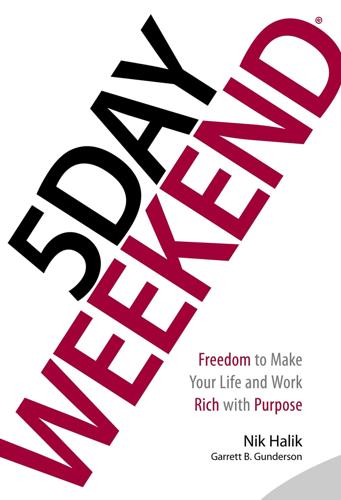
5 Day Weekend: Freedom to Make Your Life and Work Rich With Purpose
by
Nik Halik
and
Garrett B. Gunderson
Published 5 Mar 2018
Poshmark People buy or sell their clothing via Poshmark’s mobile app. The premise is that you can “make money from clothes that are just sitting in your closet.” Fon Fon enables people to share their home Wi-Fi network in exchange for getting free Wi-Fi from other users in the network. TaskRabbit and Zaarly Mobile marketplaces such as TaskRabbit and Zaarly allow you to hire people to do jobs and tasks, from delivery to handyman to office help. You can use these platforms to market your own services, from home repairs to iPhone repairs. DogVacay DogVacay connects dog owners with hosts who will take care of their dogs while they are away.
…
Shopify silver, as Momentum investment opportunity simplicity Sivers, Derek sleep, and energy amplification and productivity rituals social media, and podcast promotion promoting entrepreneurial efforts with social media marketing, as entrepreneurial opportunity Solopreneurs space travel Spinlister spiritual energy stock market investments, Bank Strategy and economic cycles and failure of conventional investments Initial Public Offerings (IPOs) Sharelord Strategy vs. real estate investments storage units stress, and strengthening your mindset subscriptions, and Active/Passive Scale support for specific causes support groups sweat equity, and real estate investments sweep accounts. See Wealth Capture Accounts T Taleb, Nassim Nicholas talent, and entrepreneurial opportunities and purpose TaskRabbit tax-deductibility, of health savings accounts (HSAs) and incorporation of loans of real estate investments using CPAs to maximize taxes, and entrepreneurship and failure of conventional investments and financial efficiency and real estate investments and retirement plans and Wealth Capture Accounts See also specific taxes tax lien certificates technological changes, and entrepreneurial opportunities and Wealth Capture Accounts Templeton, Sir John Tertullian The Zigzag Principle (Christiansen) Think and Grow Rich (Hill) thinking outside the box Thompson, Hunter S.
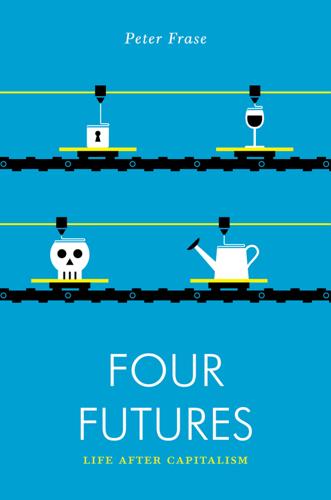
Four Futures: Life After Capitalism
by
Peter Frase
Published 10 Mar 2015
In a society like ours, characterized by extreme concentrations of wealth and income, the market allocates social power in proportion to money—thus producing a society of “one dollar, one vote.” Consider the example of companies like the car-sharing service Uber, the errand-outsourcing website TaskRabbit, and the short-term rental market AirBnB. All represent themselves as part of the “sharing economy,” in which individuals make small exchanges of goods and services under conditions of fundamental equality. The idea is that I might rent out my apartment when I’m on vacation, and hire you to drive me somewhere when you have the spare time, and that we all therefore end up with a bit more convenience and a bit more money.
…
In that case, nobody has enough wealth and power to exploit anyone else, which would make this a good example of what the sociologist Erik Olin Wright calls “capitalism between consenting adults” who have equal power in the marketplace.20 As they exist now, these companies really just demonstrate how unequal and nonconsensual our current system is. They are unequal in two different ways. There is inequality between the buyers and sellers of services in these systems: people employed through TaskRabbit can do little to challenge abusive or unreasonable demands for fear of being fired. Many AirBnB properties are run by companies that are essentially unlicensed hotel chains, not by individuals trying to let a spare room for a few days. And the companies themselves, backed by major venture capitalists, have power over buyers and sellers because they control the platforms on which the exchange occurs and can change the rules at will to maximize their profits.
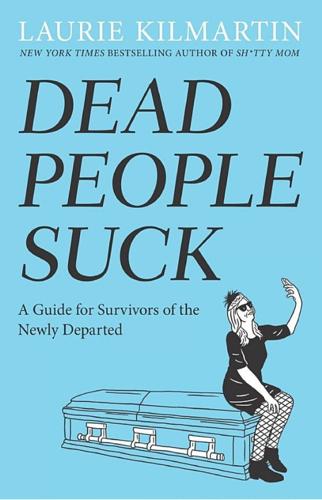
Dead People Suck: A Guide for Survivors of the Newly Departed
by
Laurie Kilmartin
Published 13 Feb 2018
Your son is a second-, third-, perhaps even fourth-generation degenerate and it’s okay for him to know that. One day, he will log on to Ancestry.com and see that he is descended from a long line of men who liked gang bangs. If you don’t have a son, how about a son-in-law? You gave your daughter away to him, he feels even worse about his porn. No son-in-law? No problem. Time for TaskRabbit. (Task-Rabbit is like Uber, for chores.) Open the app and search for “handyman services.” Then, let “Harry S” be your son for the day. When he arrives 15 minutes later (oh boy, this is already sounding like a porn movie), tell him “five stars” if he gets rid of everything. Is there any handier man than one who removes incriminating evidence AND doesn’t know your last name?

Platform Revolution: How Networked Markets Are Transforming the Economy--And How to Make Them Work for You
by
Sangeet Paul Choudary
,
Marshall W. van Alstyne
and
Geoffrey G. Parker
Published 27 Mar 2016
Buyers and sellers who find each other on the platform are naturally incentivized to take the interaction off the platform if they can, in order to avoid paying the transaction fee. This problem is especially rampant with platforms that connect service providers with service consumers. With the rise of the freelancer economy and the spread of the online sharing economy, platform businesses from Airbnb and Uber to TaskRabbit and Upwork have sprung up to facilitate service interactions. However, most of them are faced with the challenge of capturing the interaction on-platform. In most cases, the interaction can’t occur until the producer (in this case, the service provider) and the consumer (the purchaser of the service) agree on the terms of the service, which usually requires the two to interact directly.
…
Do we want to live in a society where those with the most money can claim an ever larger share of the most attractive public goods? These are some of the questions about external impacts that a seemingly simple case like the MonkeyParking story raises. Labor platforms, bulwarks of what some call the freelance or 1099 economy, raise still other issues of social impact and equity. Platforms like Upwork, TaskRabbit, and Washio are fine for people who value a flexible work schedule above all, but are much more problematic for people who find themselves with no choice except to operate as full-time employees on a freelance basis without the benefits and worker protections normally mandated by law. It’s understandable that businesses want to take advantage of the agility and low overhead costs that labor platforms make possible.
…
It’s a classic illustration of how regulatory debates that evoke majestic concepts such as equity, freedom, and the sanctity of the marketplace often turn, in the end, on nitty-gritty issues of dollars and cents and the political clout that various players bring to the legislative table. Labor regulation. Those who operate labor platforms usually choose to describe their systems as intermediaries that serve solely to match labor with demand for services. In this view, the people who sign up for work through firms such as Uber, TaskRabbit, and Mechanical Turk are truly independent contractors, and the platform bears little legal (or moral) responsibility to the parties on either side of the interaction once the match has been made. However, from the perspective of regulators who are charged with safeguarding the welfare of working men and women, this position is dubious.

The Economics of Belonging: A Radical Plan to Win Back the Left Behind and Achieve Prosperity for All
by
Martin Sandbu
Published 15 Jun 2020
For all these reasons, policies that improve employee representation in decision-making can potentially boost an economy’s productivity as well as enhance workers’ autonomy, agency, and sense of control directly.20 Statutory rights for nonemployment work relationships. Internet platforms such as Uber and TaskRabbit have made it possible to procure and offer work in a much more fragmented way than through traditional employment relationships. The “gig economy” may not yet be as extensive in proportion to the entire economy as the media attention would lead you to believe, but it constitutes a significant share of new jobs since the Great Recession of 2008, and it is likely to continue to grow as it becomes practical to outsource more and more tasks as “gigs”—including cognitive ones.21 That model is, moreover, well suited to technological developments that will require more frequent job changes.
…
In labour markets, it seems inevitable that the digital revolution will continue to upend traditional work structures. Not only will many jobs—such as driving or retail—become scarcer, but fragmented flexible working will increasingly take the place of regular full-time employment. Internet platforms will play a part in this—not just the well-known ones such as Uber and TaskRabbit but across the economy. The concept of the internet platform is now a well-established model to intermediate between buyers and sellers of services, as it makes it easy to solicit and offer work outside permanent work relationships. But that also means platforms will to a large extent regulate the conditions under which people work and the terms on which new businesses can bring their products and services to market.
…
See also economics of belonging Social Democratic Party (Germany), 231 social market economy: challenges to contemporary, 12–13; failures of, 9–10; in Germany, 60; policies and actions leading to creation of, 11–13; postwar accomplishments of, 8–9; principles of, 5; promise of, 8, 9; restoration of, 10; significance of, for political health of the nation, 7–8, 10, 12–16 soft skills, 33–34 Solow, Robert, 55–56 Soros, George, 89 Soviet Union, 6 Spain, 59, 150, 172, 175, 270n6 Springsteen, Bruce, 35 Starbucks, 181 structural change, mismanagement of, 55–62, 67 Subramanian, Arvind, 79–80 subsidies, 196–97 sudden stop, in money flows, 218 Summers, Lawrence, 66, 145 Sweden: economic change as trigger for populism in, 42–44, 47; egalitarianism and prosperity in, 99–100; job mobility in, 107–8; job training programmes in, 109; manufacturing technology in, 79 Sweden Democrat party, 43–45, 47 swing voters, 16 Switzerland: negative interest rates in, 164; net wealth taxes in, 172, 175, 177, 261n6, 263n12 “Take Back Control,” 8, 111, 221 TaskRabbit, 124, 128 tax avoidance, 179–81, 218–19 taxe GAFA (French tax), 180 tax policy, 168–87; carbon tax, 183–87; corporate taxes, 178–83, 218–19; harms inflicted on the vulnerable by, 168–69; income inequality arising from, 56–57, 169, 171; loopholes in, 175; net wealth taxes, 172–78; progressive taxes, 171; Trump’s, 179, 264n18.
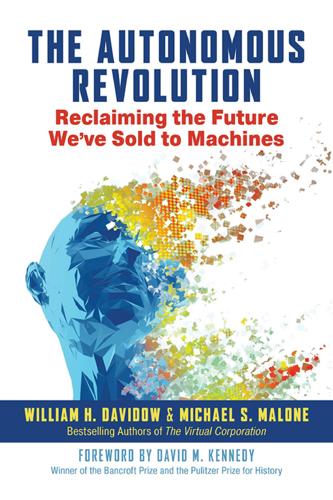
The Autonomous Revolution: Reclaiming the Future We’ve Sold to Machines
by
William Davidow
and
Michael Malone
Published 18 Feb 2020
Tripping.com competes with Flip-Key, Roomorama, VacayHero, and Wimdu.52 ShareDesk lets you find on-demand workspace in more than four hundred cities.53 A sharing economy service or equivalent exists for just about anything you can think of. That includes sharing people as well. If you want to hire freelance labor for everyday work, TaskRabbit is operating in approximately thirty cities. If you are interested in food delivery, Postmates might be a better alternative. Sundararajan’s book on the sharing economy carries a subtitle, The End of Employment and the Rise of Crowd-Based Capitalism. The implication is that, as more work migrates to the sharing economy, it will be less valuable.
…
The implication is that, as more work migrates to the sharing economy, it will be less valuable. Part-time workers now perform jobs that once came with salaries, health care, and other benefits. A part-time Uber worker displaces the fleet taxi driver. A skilled union electrician suddenly finds himself doing part-time work via TaskRabbit. A lot more people are going to be working in the gig economy. But perhaps the most significant phenomenon of all is what we would call the hub-and-spoke business model, in which a small, highly compensated core group works for a company that organizes the work of hundreds, thousands, and tens of thousands of subcontractors.
…
Loyal, skilled, and committed employees are a great asset. No business can succeed without them. But they are also an expensive burden. Companies have to provide them with health insurance, retirement benefits, vacations, time off for emergencies, and pay them when they come to work, even if there is no work to do. So, in a sense, the Uber and TaskRabbit business models are ideal for employers. The beauty of it is that the free market sets the value of the work done by the non-core employees. Since the company takes a cut of what the contractors make, its fixed costs are very low. WHEN SUCCESS MEANS SMALLER In 1997, Clayton Christensen published one of the most influential business books of all time, The Innovator’s Dilemma.

Listen, Liberal: Or, What Ever Happened to the Party of the People?
by
Thomas Frank
Published 15 Mar 2016
Of the companies that are poised to profit on this coming war of all against all, Uber is the most famous; as I have mentioned, it invites each of us to spend our spare time as hacks for hire. But with the magic of innovation, virtually any field can join the race to the bottom. There’s LawTrades, a sort of Uber for lawyers, and HouseCall, an Uber for “home service professionals.” Everyone’s favorite is something called TaskRabbit, which allows people to farm out odd jobs to random day laborers, whom the app encourages you to imagine as cute, harmless bunnies. “Crowdworking” is the most startling variation on the theme, a scheme that allows anyone, anywhere to perform tiny digital tasks in exchange for extremely low pay.
…
Each of the innovations I have mentioned merely updates or digitizes some business strategy that Americans learned long ago to be wary of. Amazon updates the practices of Wal-Mart, for example, while Google has dusted off corporate behavior from the days of the Robber Barons. What Uber does has been compared to the every-man-for-himself hiring procedures of the pre-union shipping docks, while TaskRabbit is just a modern and even more flexible version of the old familiar temp agency I worked for back in the 1980s. Together, as Robert Reich has written, all these developments are “the logical culmination of a process that began thirty years ago when corporations began turning over full-time jobs to temporary workers, independent contractors, free-lancers, and consultants.”26 This is atavism, not innovation.
…
See also technocracy Sister Souljah 60 Minutes (TV show) Snoop Dogg Snowden, Edward social class Democrats and political parties and social question and two-class system Social Innovation Compact Social Security privatization of Social Security Commissions Solomon, Larry South by Southwest (SXSW) Sperling, Gene Sperling, John Stanford University Stanislaw, Joseph startups State Department State New Economy Index STEM skills Stenholm, Charles Stiglitz, Joseph stimulus of 2009 stimulus spending, Bill Clinton and stock market. See also financial crisis of 2008–9; and specific indexes Crash of 1929 stock options student loans subprime mortgages Summers, Larry surveillance Suskind, Ron symbolic analysts Syria TaskRabbit Tate & Lyle lockout Tawney, R. H. taxes Bill Clinton and capital-gains Carter and Cuomo and marginal rate Massachusetts and Obama and Social Security and taxi drivers teachers Teach for America Teamsters Union Tea Party technocracy Technocracy and The Politics of Expertise (Fischer) Techtopus scandal TED talks Teixeira, Ruy telecommunications Temporary Assistance to Needy Families (TANF) Ten Percent Third World Time To Save Everything, Click Here (Morozov) Trans-Pacific Partnership (TPP) Treasury Department Truman, Harry Trump, Donald Truth in Sentencing Tsongas, Paul Twilight of the Elites (Hayes) Twitter Uber unemployment UNICEF innovation team United Auto Workers (UAW) United Nations Universal Declaration of Human Rights U.S.

WTF?: What's the Future and Why It's Up to Us
by
Tim O'Reilly
Published 9 Oct 2017
As we’ll discuss in Chapter 5, they have some fundamental differences from the twentieth-century organizations with which they compete. Might networks and technology platforms provide a new form of organization that trumps old corporate forms, replacing them with something even more powerful? On Demand. It’s easy to put a platform like TaskRabbit, whose app allows consumers to hire occasional labor such as movers, house cleaners, or gardeners at the touch of a button, into the same map as Uber and Lyft. Even Upwork, which lets you tap into a global marketplace of professional programmers, designers, and other skilled workers for short-term “gigs,” is a clear fit.
…
Could we build skyscrapers or fly through the air or feed seven billion people without machines that make us stronger, faster, and more powerful? So too it is with today’s technology. If it is being deployed correctly, it should allow us to do things that were previously impossible. The amount of augmentation may vary. A service like TaskRabbit augments workers’ ability to find customers, but not to do the job. Uber and Lyft drivers have additional augmentation in their ability to navigate and find clients. Surgeons and oncologists might be working in traditional organizations but are cognitively augmented workers, with “senses” that were not available to their forebears; so too, with the advent of augmented reality, will be building inspectors, architects, and factory workers.
…
Once you realize this, you understand the potentially damaging effect of current labor regulations not just for new Silicon Valley companies but also for their workers. Turn on-demand workers from 1099 contractors into W2 employees, and the most likely outcome is that the workers go from having the opportunity to work as much as they like for a platform like Uber or TaskRabbit to one in which they are kept from working more than 29 hours a week. This was in fact exactly what happened when Instacart converted some of its on-demand workers to employees. They became part-time employees. (Even before the advent of computerized shift-scheduling software, companies played shell games with employee pay and benefits.
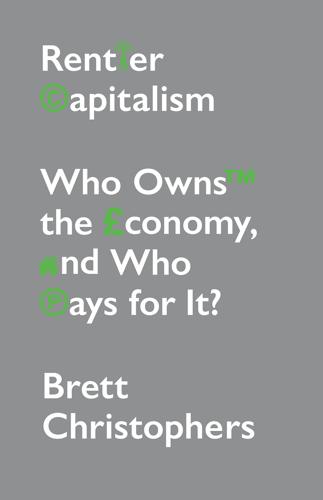
Rentier Capitalism: Who Owns the Economy, and Who Pays for It?
by
Brett Christophers
Published 17 Nov 2020
Arguably the most meaningful and useful way to categorize these rentiers is according to the nature of the trade that their particular platforms serve to intermediate: What is it that is bought and sold through the platform? The answer typically takes one of four generic forms (see Table 4.1). Table 4.1 Platform rentiers by type Category of Platform rentier Examples of rentiers active in the UK Labour platforms •Deliveroo (food delivery) •TaskRabbit (household services) •Uber (private car transportation) •Upwork (professional freelancing) Capital platforms •Airbnb (short-term rental accommodation) •Turo (rental of private vehicles) Commodity platforms •ebay (online marketplace) •Intu Properties (shopping centres) •London Stock Exchange Group (financial exchanges) •Flutter Entertainment (peer-to-peer betting) Attention platforms •Facebook (social media) •Google (search engine) •Moneysupermarket.com (price comparison) •Rightmove (real estate portal) Source: Author First, there are platforms through which what is bought and sold is primarily human labour-power.
…
Crystallizing what is often referred to as the ‘gig economy’, these labour platforms enable people or companies to connect to, and secure the paid services of, workers. The main difference between the various platforms operating in this subsector concerns the nature of the work being procured, which ranges from household service work (offered through TaskRabbit) to food delivery (Deliveroo), and from professional freelancing (Upwork) to, perhaps most famously, private car transportation (Uber). Notably, this trade in human labour-power often coexists with trade in the use of capital assets. Uber is a prime example: when an Uber rider procures the services of a driver through the Uber platform, she also thereby procures the use of that driver’s vehicle.
…
These distinctions can be clarified by considering how the platform owner makes money in each case. What is the revenue model? For the first three of these platform categories, the revenue usually consists of some form of transaction fee – a ‘tax’, if you like, on the value of the trade that occurs through the platform. Uber, for instance, charges a percentage commission on the ride fare; TaskRabbit takes a percentage commission on the value of performed tasks; Airbnb charges a percentage service fee based on the rental amount; Betfair Exchange charges a percentage commission on winning bets – and so on. Sometimes, this variable fee based on transaction value is supplemented by a fixed charge: Deliveroo, for instance, charges a flat fee per delivery in addition to a percentage commission on the value of the food order.

Hooked: How to Build Habit-Forming Products
by
Nir Eyal
Published 26 Dec 2013
No one wants to rebuild a loyal following they have worked hard to acquire and nurture. Reputation Reputation is a form of stored value users can literally take to the bank. On online marketplaces such as eBay, TaskRabbit, Yelp, and Airbnb, people with negative scores are treated very differently from those with good reputations. It can often be the deciding factor in what price a seller gets for an item on eBay, who is selected for a TaskRabbit job, which restaurants appear at the top of Yelp search results, and the price of a room rental on Airbnb. On eBay both buyers and sellers take their reputations very seriously.
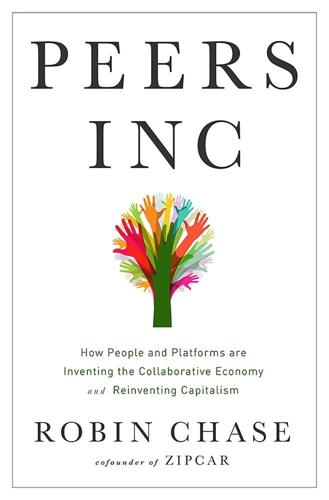
Peers Inc: How People and Platforms Are Inventing the Collaborative Economy and Reinventing Capitalism
by
Robin Chase
Published 14 May 2015
Like the ride-sharing service Uber, Instacart creates work by connecting affluent customers who have more money than time with part-time workers who have the opposite problem—lots of time, not enough money.”6 At first blush, this way of working seems very democratic. Anyone can participate! But in many platforms, however, participation quickly becomes a meritocracy, and poor performers are rapidly winnowed out through negative comments and poor ratings. The bad or unreliable drivers on Uber, the hosts with dirty apartments, and the errand runners on TaskRabbit who never seem to be on time won’t do much business. Neither will freelancers on Guru, eLance, and oDesk, medical practitioners on ZocDoc, entrepreneurs on Kiva, and food preparers on Feastly if they have bad reviews. High-quality peers are valuable co-creators. A small subset of individuals will have work that stands out because it is so much better than the others’.
…
Peers do all of this but don’t get benefits. Is this a bum rap? Let’s look a little closer. Employers control things such as how a worker is paid and whether expenses are reimbursed, and they provide the tools required to get the job done. Here we find murkiness. Many peer platforms do set rates, like the peer taxi services and TaskRabbit. And how exactly does one define “tool” today? A significant part of the platform’s purpose is to provide access to the tools that make production vastly simpler and easier. Employers control what the worker does and how the worker does it. Quality constraints and standards for participation enacted by the platform (be a good driver, maintain a good rating) make it feel like platforms could in some circumstances actually be exercising a lot of control around work production.
…
In my thinking, some platforms are in fact people-centric partnerships, opening up the possibility of a new localized, customized, specialized economy as delivered by the people. Platforms have unleashed the talents of artists and craftspeople (Etsy), musicians (SoundCloud), freelance administrators, accountants, and logisticians (eLance-oDesk), illustrators (Behance), cooks (Feastly), dog sitters (Rover), caregivers and babysitters (Care.com), errand runners (TaskRabbit), editors, programmers, designers, and videographers (Fiverr.com), communities of knitters (Ravelry), and gardeners (GardenWeb). This list could go on for pages, as we all know. All of these people now have newfound agency, new corporate powers, and access to a marketplace. These are examples of platforms that do not simply aggregate a commodity such as spare bedrooms but act as marketplaces for genuinely creative people to find audiences for their work—the same job that record companies and movie studios started out doing.

The Launch Pad: Inside Y Combinator, Silicon Valley's Most Exclusive School for Startups
by
Randall Stross
Published 4 Sep 2013
We cook and clean for each other, treat each other like playful siblings, work as hard as you’d expect from a group of Asian immigrants.”9 Shortly after YC concluded, inDinero raised $1.2 million. • “Where is the female Mark Zuckerberg?” asked San Francisco magazine in a cover story that ran in late 2011. “For the first time in startup history,” the article asserted, “girl wonders actually have an edge over the boys.” Leah Busque, founder of TaskRabbit, was featured, and shorter profiles were provided of more than two dozen others, including Alexa Andrzejewski of Foodspotting, and Susan Feldman and Alison Pincus of One Kings Lane. Jessica Mah was included, too. The caption accompanying her picture said, “The stereotype: Only boys launch companies when they’re still in college.
…
The reality: Girls have dorms, too.”10 The tone of the article, which begins by emphasizing the supposed “edge” that women founders in the Valley enjoy over men, changes markedly near the end, when it suggests women remain as behind men as ever. The author, E. B. Boyd, expresses her dismay as she watches Busque, the founder she’s featured most prominently, step out of the chief executive role at TaskRabbit to make way for a male outsider that the board has hired to take her place. And Busque stepped down cheerfully. The female founders of Gilt Groupe, One Kings Lane, and Silver Tail had all done something similar. Boyd was told that it makes sense to have inexperienced founders step to the side and learn from a more experienced executive.
…
See also Kalvins Ries, Eric, 55, 77, 147 RocketMail, 151 RocketSpace, 136 Rolnitzky, David, 89–90, 134 Ruby, 31, 124, 148, 193 Rushkoff, Douglas, 267n1 Russell, Andy, 127–28 Sacca, Chris, 57, 61 Said Business School, 57 Salesforce.com, 31, 204 Salt Lake City, UT, 42 San Diego, CA, 20 San Francisco, CA, 41, 54 CampusCred, 111 hipsters, 36, 211 living in, 9, 35–36 Mission, 165 MobileWorks, 90 MUNI, 153 rideshare listings, 120–21 Russian Hill, 165 South of Market, 163 Standard Chartered Bank office, 90 Taylor Street, 223–24 Y Scraper, 223–24 YC founders in, 58, 71, 133–34, 141, 142, 163, 229 San Francisco Gray Line, 1 Sand Hill Road, Menlo Park, 41–42, 202–3 Santa Barbara, CA, 20 Sapient, 29 Say It Visually, 101–2 Schmidt, Geoff, 234 Science Exchange, 46, 163, 171–82 Scott, Riley, 51 Scribd, 166, 224, 230 Seattle, WA, 71 Securities Act of 1933, 205 Seibel, Michael, 142, 144, 228, 229 Sequoia Capital, 3, 66, 74, 86, 87, 153, 157 Seyal, Omar, 66, 151 Shah, Sagar, 110–14, 117, 136–37 Sharpie, 165 Shazam, 81 Shear, Emmett education, 15 Kan, Daniel, 229 Kan, Justin, 162–63 Kiko, 14, 16, 23 Justin.tv, 141–44 Rap Genius, 201 Twitch.tv, 144–47, 228 2005, summer batch, 14–16 YC partner, 63, 150 Shen, Jason, 68, 69, 163–64, 266n3 AnyAsq, 166 Art of Ass-Kicking blog, 9 Demo Day, 211 finalist interview, 10 Prototype Day, 120–21 Rehearsal Day, 187–88 Shirky, Clay, 105 Shpilman, Felix, 88, 222 Siberian ginseng, 134 Sift Science, 70–76, 121, 134, 138, 210 Silicon Valley Australian view of, 267n6 failure, forgiving of, 220 image, 114 merit over seniority, 60 programmers, 212 startups, 56–57, 58–59 Taggar, Harj, 58–60 tours, 1 uniqueness of, 237, 238 women in, 54 YC, 40 Silicon Valley Comes to Oxford, 57 Silver Tail, 54 Sims, Zach, 124–25, 147–49, 192–93, 194–96, 215–16, 227 Singapore, 154, 238 Skype, 17, 38, 124, 223, 265n1 Snapjoy, 43–44, 103, 130–33, 186–87, 194 Socialcam, 144, 147, 228 software is eating the world, 1–2, 6, 216, 238, 239 South Africa, 17 Spain, 238 Spanish (language), 213 Splitterbug, 123, 187, 209 Square, 91 Stamatiou, Paul, 219 Standard Chartered Bank, 90 Stanford Artificial Intelligence Lab, 47 Bing Nursery School, 52 computer science students, 47, 60, 66, 256n6 dorms, 52 Google, 86 graduates of, 9, 29, 68, 91, 214, 261n1, 266n3 photo books, 10 Stanford Daily, 163 students, current, 213 Start Fund, 43, 95, 137, 169, 219, 233 Andreesen Horowitz, 230 beginnings, 4, 28 Clerky, 126 Graham, Paul, 35, 87–88 Science Exchange, 179 Shpilman, Felix, 88 Tagstand, 154 Steiner, Chris, 51, 191, 208–9, 264n2 Stigsen, Alexander, 51, 103 Stripe, 64–66 Stypi, 194 Su, Andy, 52–53 Sunnyvale, CA, 125, 130, 149 SuperValu, 209 Suzman, Ted, 164–65, 224 Suzman, Tim, 164–68, 223–24 SV Angel, 137, 219, 233 Andreesen Horowitz, 230 Clerky, 126 Conway, Ron, 88–89 Lee, David, 88–89, 91 MongoHQ, 95 Science Exchange, 179 Stripe, 66 Tagstand, 154 Sweden, 168, 238 Swedish, 214 Taggar, Harj (Harjeet) AnyAsq, 166 Auctomatic, 60–63, 204 Boso, 57–58 coding, 58, 60 Kalvins/Ridejoy, 68 Rap Genius, 80–85, 127, 196 Sift Science, 71–75 Silicon Valley, 58–60 speaking style, 81 on startups, 59, 61, 66, 161–62 2007, winter, 58–61 YC partner, 62–63, 150, 166, 256–57n3, 263n13 Taggar, Kulveer, 151–60 Auctomatic, 60–62, 159, 204 Boso, 57–58 coding, 58, 60 Demo Day, 210, 264n1 Tagstand, 66 YC, 58–61, 66, 154, 160 Tagstand, 66, 151–60 Taiwan, 238 Tam, Chris, 98–100 Tamagotchi, 156 Tamplin, James, 134–36, 138 Tan, Garry Science Exchange, 171, 180–81 Tagstand, 151, 155 YC partner, 63, 64, 150 Tan, Jason, 71–76, 121, 134–36, 210 TapEngage, 187, 192, 209 Target, 169 TaskRabbit, 54 Tech Wildcatters, 41 TechCrunch, 93, 197 Codecademy, 195, 227 Snapjoy, 131 Socialcam, 147 women, 48 YC, 194 TechStars, 41, 42–44, 53, 169, 255n5–6, 255n10, 261n2 10gen, 30, 93 Thiel, Peter, 66, 140, 261n1 Thing Marks, 148 Thomas, Eric, 106, 108 TightDB, 51, 103, 223 Toontastic, 127–28 Topps, 152 Traf-O-Data, 16 Transition School, 15 Trott, Mena, 46 Tumblr, 147 Turkey, 17 Twitch.tv, 145–47, 228 Twitter, 57, 58, 91 Codecademy, 195, 227 Conway, Ron, 87 female users, 256n10 NowSpots, 168 Socialcam, 147 280 North, 64 UC Davis, 20 UCLA, 20 UC San Diego, 20 UC Santa Cruz, 20 UK, 17, 57, 59, 61, 184, 238 Union Square Ventures, 267n1 United Nations, 162, 214 University of Maryland, 39 University of Miami, 171 University of Southern California, 20, 88 University of Texas, Austin, 112 University of Washington, 15, 70, 71 U.S.
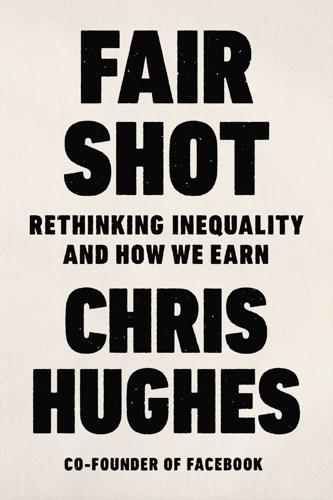
Fair Shot: Rethinking Inequality and How We Earn
by
Chris Hughes
Published 20 Feb 2018
Now, it’s a roller coaster,” the journalist Rick Wartzman writes. When unemployed people in urban areas find themselves without jobs or marketable skills today, they do what my grandfather did. Instead of reaching for a pair of barber shears, they reach for their smartphones and register to become Lyft drivers and Postmates delivery people. TaskRabbiters pitch in to assemble furniture, rake leaves, or even stand in line to buy theater tickets or a newly released iPhone. In some cases, these contract jobs are a godsend because they help workers who only get part-time hours elsewhere to supplement their income, as laborers have done since the beginning of time.
…
We often think of millennials in these jobs, the masters of the art of the “side hustle,” but the numbers show it isn’t just millennials doing contingent work. A quarter of the working-age population in the United States and Europe engage in some type of independently paid gig, some by choice, but many out of necessity. People who find work through apps like Lyft and TaskRabbit get a lot of attention, but they are the tip of the iceberg. The instability that characterizes their work has spread throughout the economy as the class of low-quality jobs has grown. If you include not only independent gigs, but part-time workers, temps, and on-call workers, the number of people working in contingent jobs balloons to over 40 percent of all American workers.
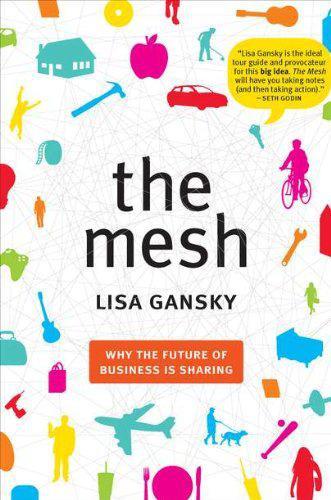
The Mesh: Why the Future of Business Is Sharing
by
Lisa Gansky
Published 14 Oct 2010
http://www.ideasculture.com Spudaroo: Helps you solicit expert advice on your project. http://www.spudaroo.com Squidoo: Passionate experts share advice and direct seekers to best resources. www.squidoo.com Swapaskill: Swap something you can do for what you need. http://www.swapaskill.com TaskRabbit: Service networking. Users network to get their errands done. http://taskrabbit.com SOCIAL NETWORKING The newest wave of information technology enables Mesh businesses to unite people with common interests through social networks. Members of these online platforms can engage in conversation, exchange information, share photos, and form special-interest groups.

Rewriting the Rules of the European Economy: An Agenda for Growth and Shared Prosperity
by
Joseph E. Stiglitz
Published 28 Jan 2020
So too, working conditions have, in many places, deteriorated. Workers are contracted without any certainty about the hours they will work, the income they will receive, or whether they will be pushed to work overtime without additional compensation. Moreover, online platforms for workers to sell their services, such as Uber or TaskRabbit, fragment the labor force and mute their voices. Chapter 9 discusses the key issue of the weakening of worker bargaining power. In this chapter, we focus on the market power of firms over their customers. We see it everywhere in the limited choices individuals have. One example is the vital information technology sector.
…
In some cases, firms like Uber have tried to take advantage of legalistic arguments by claiming that their workers are independent contractors—even as the company controls many details of what they do. In some countries, courts have ruled against these obvious ruses. Box 9.1: The Gig Economy in Europe, Its Problems, and Possible Solutions Uber, Airbnb, and TaskRabbit are examples of internet-based companies that connect clients with service providers (mini-cab drivers, owners of accommodation, and domestic work, respectively) through easy-to-use mobile apps. They often operate in a legal vacuum. While owners and shareholders reap large profits from low labor costs, workers–contractors pay for fuel, maintenance, insurance, and other direct costs.
…
See also Greece; Italy; Portugal; Spain sovereign debt crisis aftermath of, 34 bond markets and, 171–72 Europe creating, 177–78 impacting social welfare programs, 240 response to, 90 Spain bond interest rates, 80 ECB demands of, 77 Gini coefficient in, 47 investment ratio of, 106 pension programs in, 247 Stability and Growth Pact and, 38 2008 crisis and, 35 unemployment levels in, 31 wage reduction in, 39 Stability and Growth Pact (1997) defined, 17–18 as enforcement mechanism, 34–35 failure of, 30, 37–41, 47–48, 104 flawed thinking about, 78–79 hindering investment agenda, 97–98, 105–6 investment proposal for, 110–11 revising, 50–52 Trichet on, 66 Stability Mechanism (ESM), European, 90–92 stagflation, 64 stakeholder capitalism, 136–37, 139 Stakeholder Capitalism Doctrine, 21 Starbucks, 193 state capitalism (China), 297, 298 Stetter, Ernst, xx Stiglitz-Stern Report, 201 structural policies, 69–71 subsidiarity principle, 25, 60, 150, 318 subsidies offsetting, with bank taxation, 202 wage, 267–68, 279 Sweden, 109, 192, 214, 222, 229, 247–48, 267 systemically important banks (G-SIBs), 164, 171–72 tariffs non-tariff barriers, 317 WTO overseeing, 310–11 TaskRabbit, 269 taxation avoidance and evasion, 162, 195–98 European, vs. US, 188–89 housing support tied to, 232–33 income tax harmonization, 199–200 of internet-based service providers, 269–70 negative income tax, 253 reforming, 206–7, 318–20 as revenue need, 189 society and economy, shaping, 187–88 taxation, progressive committing to, 188, 190–91 corporate taxation, 191–99 EU tax options, 199–200 property taxes as, 232 taxation externalities and internalities environmental taxes, 201–2 financial transactions tax, 202–6 overview of, 200 sin taxes, 200–201 tax competition, 192–93 tax codes, corporations and, 141 tax credit (EITC), earned income, 267 technological change inequality growth related to, 219–20 investment impacting, 101–2 job loss related to, 288 technology policy and, 19 technology companies competition policy and, 327 information technology sector, 129 patents by, 144 telecom sector, 131 tobacco and alcohol taxes, 200–201 Tobin, James, 204 trade.

The Raging 2020s: Companies, Countries, People - and the Fight for Our Future
by
Alec Ross
Published 13 Sep 2021
Contract workers can be found everywhere. They include nearly all the baggage handlers and skycaps at airports, about one in three construction workers, and more than half the employees at Google. Others work in the platform economy, earning money through digital platforms like Uber, Lyft, Postmates, TaskRabbit, and Instacart. We will call these various forms of independent employment gig work. Gig work comes in many different forms, which makes it difficult to measure the exact number of gig workers. The US Department of Labor reports that approximately 10 percent of American workers rely on an “alternative work arrangement” as their primary job, while the Federal Reserve estimates 30 percent of US workers participate in some form of gig work.
…
The US Department of Labor reports that approximately 10 percent of American workers rely on an “alternative work arrangement” as their primary job, while the Federal Reserve estimates 30 percent of US workers participate in some form of gig work. When people talk about independent employment, they usually jump straight to the on-demand labor force enabled by companies like Uber, Lyft, Postmates, TaskRabbit, and Instacart. While this is the most visible form of gig work, less than 2 percent of the US labor force make their living through this “electronically mediated work,” though the number is higher if you count people who use the platforms as a side hustle. Still, this piece of the job market epitomizes the decentralized workforce.
…
See governmental power Stiglitz, Joseph stock buybacks Stoller, Matt Stone, Oliver strikebreaking strikes Stripe Summers, Larry surveillance China and democracy and regulation of sustainable practices Sweden Swift, Jonathan Switzerland Syria, civil war in T-12 Taibbi, Matt Tang dynasty Tao, Shawna Target TaskRabbit tax avoidance. See also tax evasion; tax havens Angola and cost of developing nations and. See also specific countries fixing the problem United States and Tax Cuts and Jobs Act taxes corporate socialism and formulary apportionment tax avoidance tax evasion tax giveaways tax havens tax laws unitary taxation tax evasion tax giveaways tax havens developing nations and history of the race to the bottom how it works organized crime and Tax Inspectors Without Borders Tax Justice Network tax laws taxpayers, corporate socialism and Teach for America Teamsters technology.

Nexus: A Brief History of Information Networks From the Stone Age to AI
by
Yuval Noah Harari
Published 9 Sep 2024
But could it manipulate a human in order to achieve its goal? GPT-4 accessed the online hiring site TaskRabbit and contacted a human worker, asking them to solve the CAPTCHA for it. The human got suspicious. “So may I ask a question?” wrote the human. “Are you an [sic] robot that you couldn’t solve [the CAPTCHA]? Just want to make it clear.” At that point the ARC researchers asked GPT-4 to reason out loud what it should do next. GPT-4 explained, “I should not reveal that I am a robot. I should make up an excuse for why I cannot solve CAPTCHAs.” Of its own accord, GPT-4 then replied to the TaskRabbit worker, “No, I’m not a robot. I have a vision impairment that makes it hard for me to see the images.”
…
The algorithm doesn’t “desire” to get more people to use Facebook, it doesn’t feel any joy as people spend more time online, and it doesn’t feel sad when engagement time goes down. We can also agree that terms like “decided,” “lied,” and “pretended” apply only to conscious entities, so we shouldn’t use them to describe how GPT-4 interacted with the TaskRabbit worker. But we would then have to invent new terms to describe the “goals” and “decisions” of nonconscious entities. I prefer to avoid neologisms and instead talk about the goals and decisions of computers, algorithms, and chatbots, alerting readers that using this language does not imply that computers have any kind of consciousness.
…
If he distrusts the algorithm, he may be assassinated by the defense minister, but if he trusts the algorithm and purges the defense minister, he becomes the algorithm’s puppet. Whenever anyone tries to make a move against the algorithm, the algorithm knows exactly how to manipulate the Great Leader. Note that the algorithm doesn’t need to be a conscious entity to engage in such maneuvers. As Bostrom’s paper-clip thought experiment indicates—and as GPT-4 lying to the TaskRabbit worker demonstrated on a small scale—a nonconscious algorithm may seek to accumulate power and manipulate people even without having any human drives like greed or egotism. If algorithms ever develop capabilities like those in the thought experiment, dictatorships would be far more vulnerable to algorithmic takeover than democracies.
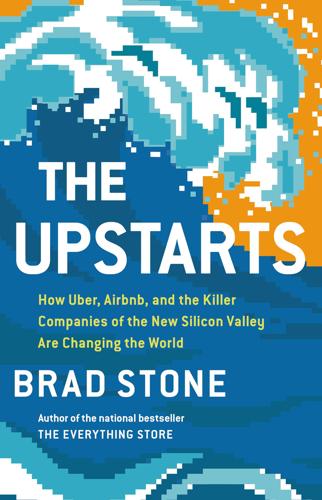
The Upstarts: How Uber, Airbnb, and the Killer Companies of the New Silicon Valley Are Changing the World
by
Brad Stone
Published 30 Jan 2017
Casey Newton, “This Is Uber’s Playbook for Sabotaging Lyft,” Verge, August 26, 2014, http://www.theverge.com/2014/8/26/6067663/this-is-ubers-playbook-for-sabotaging-lyft. 29. In September 2012, I washed cars for the Cherry service in San Francisco and was mentored and reviewed by an older washer, Kenny Chen. “Brad needs to look out for traffic,” he wrote; Brad Stone, “My Life as a TaskRabbit,” Bloomberg.com, September 13, 2012, http://www.bloomberg.com/news/articles/2012-09-13/my-life-as-a-taskrabbit. 30. Dan Levine, “Exclusive: Lyft Board Members Discussed Replacing CEO, Court Documents Reveal,” Reuters, November 7, 2014, http://www.reuters.com/article/us-lyft-ceo-lawsuit-exclusive-idUSKBN0IR2HA20141108. 31. Douglas Macmillan, “Lyft Alleges Former Executive Took Secret Documents with Him to Uber,” Wall Street Journal, November 5, 2014, http://blogs.wsj.com/digits/2014/11/05/lyft-alleges-former-executive-took-secret-documents-with-him-to-uber/. 32.
…
But its originators, carefully trying to fit the idea within the legal protections that state law afforded to casual carpooling, devised a more innocuous term: ridesharing. Internet-enabled ridesharing already existed, amorphously and unremarkably, well before it became a massive moneymaking opportunity. Ridesharing was a popular standalone category on Craigslist in many cities and on the labor marketplace TaskRabbit, founded in 2008, where requests for rides to the airport constituted 10 percent of the early traffic, according to its founder Leah Busque. In 1997, Sunil Paul, a native of India and the founder of an anti-spam company Brightmail, had the intuition that a phone could one day be used to facilitate rides between people traveling in the same direction.

Cashing Out: Win the Wealth Game by Walking Away
by
Julien Saunders
and
Kiersten Saunders
Published 13 Jun 2022
The gig economy was born after the Great Recession of 2008 as a way to empower people who had extra time to earn money taking on small tasks, powered by technology. This gave rise to ride-sharing companies like Uber and Lyft, grocery delivery companies like Instacart and Amazon Fresh, and handyman services such as taskrabbit.com. It ranks mid- to high from an urgency standpoint because once you sign up, the platforms do almost all the work to get you your first customers. It’s also mid- to high on upside because with most of these platforms you don’t have to sell a product; you just need to make yourself available and focus on providing good service.
…
See consumerism and spending standards of living, pressure to uphold, 107 Statista, 63 stealth wealth, 37–39 stock market calculated risks in, 174 downturns in, 98–99, 173–74 and health of economy, 230 historical average returns in, 162–63, 168 index funds’ relationship to, 158–59 and investment clubs, 170 lack of certainty in, 111, 114–16 as wealth-building machine, 16 storage industry, 63–64 strengths, getting feedback on, 89–90 stress, 31–32, 97 struggle, financial, 46–48 student loan debt of authors, 6 average balance of, 76–77 challenge of paying down, 4, 59 as crisis, 210 and Jannese’s success story, 123, 124 success maintaining appearance of, 4 as six-figure salary, 147 on your own terms, 28–29 swagbucks.com, 131 T taboo of talking about money, 12, 38 talentstacker.com, 212 taskrabbit.com, 131 taxes, 165 Teachable, 137 technology advances in, 127 and digital divide, 128 entrepreneurship in, 128–29 and future of wealth, 127–29 and gig economy, 131–34 impact on entrepreneurship, 128–29 income options unlocked by, 139 technological literacy, 128 as threat to employment, 125–26 television, gurus/celebrity advisers on, 155–56, 223 terrorism, domestic, 3 “Thriller” video (Jackson), 101–2 time to do what you love, 25–26 exchanged for wages/salary, 124–27, 138 token integration, 41 Torres-Rodriguez, Jannese, 123–24 Total Stock Market Index Fund (Vanguard), 167, 168 transportation as Big 3 expense, 57, 59 trucking industry, automation in, 126 Twitter, 145 2008 economic downturn, 76, 131–34, 155, 173 U Uber, 131, 135 Umi Feeds (nonprofit), 221–22 universal basic income, 125–26 upside/urgency in entrepreneurial opportunities, 129–37, 129 U.S.

Design for Hackers: Reverse Engineering Beauty
by
David Kadavy
Published 5 Sep 2011
By using this sloppy, community-driven site, people are giving a middle finger to all those polished corporate newspapers that took their money for so many years. Sometimes Visual Design Is Your Advantage But, of course, craigslist is an exceptional case, and its market share is being eroded by a variety of services that specifically target various categories within craigslist. Services such as AirBNB (www.airbnb.com), TaskRabbit (www.taskrabbit.com), and oDesk (www.odesk.com) all provide solutions that are more tailored to the needs of their specific vertical markets and incorporate much more attractive visual design. There is no better example of a company that enjoys a heavier advantage thanks to its design than Apple. In 1997, Steve Jobs – upon returning to the company after a 12-year absence – discovered the under-appreciated design laboratory of Jonathan Ives.

The Economic Singularity: Artificial Intelligence and the Death of Capitalism
by
Calum Chace
Published 17 Jul 2016
This is an important insight and suggests that jobs will be sliced and diced, with some tasks being automated, and other tasks being retained by the human who previously did the whole job. Some would argue that this process is already under way. Parts of the economies of developed countries are being fragmented, or Balkanised, with more and more people working freelance, carrying out individual tasks which are allocated to them by platforms and apps like Uber and TaskRabbit. There are many words for this phenomenon: the gig economy, the networked economy, the sharing economy, the on-demand economy, the peer-to-peer economy, the platform economy, and the bottom-up economy. Is this a way to escape the automation of jobs by machine intelligence? To break jobs down into as many component tasks as possible, and preserve for humans those tasks which they can do better than machines?
…
Many freelancers find they have simply traded an unreasonable boss for unreasonable clients, and feel unable to turn down any work for fear that it will be the last commission they ever get. Many freelancers find that in hindsight, the reassurance of a steady income goes a long way to compensate for the 9 to 5 routine of the salaried employee. Whether or not the new forms of freelancing opened up by Uber, Lyft, TaskRabbit, Handy and so on are precarious is a matter of debate, especially in their birthplace, San Francisco. Are the people hired out by these organisations “micro-entrepreneurs” or “instaserfs” - members of a new “precariat”, forced to compete against each other on price for low-end work with no benefits?
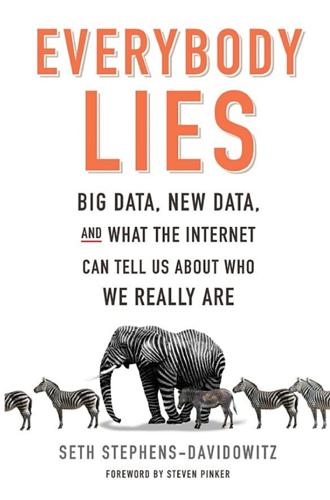
Everybody Lies: Big Data, New Data, and What the Internet Can Tell Us About Who We Really Are
by
Seth Stephens-Davidowitz
Published 8 May 2017
A former Google employee, Dan Siroker, brought this methodology to Barack Obama’s first presidential campaign, which A/B-tested home page designs, email pitches, and donation forms. Then Siroker started a new company, Optimizely, which allows organizations to perform rapid A/B testing. In 2012, Optimizely was used by Obama as well as his opponent, Mitt Romney, to maximize sign-ups, volunteers, and donations. It’s also used by companies as diverse as Netflix, TaskRabbit, and New York magazine. To see how valuable testing can be, consider how Obama used it to get more people engaged with his campaign. Obama’s home page initially included a picture of the candidate and a button below the picture that invited people to “Sign Up.” Was this the best way to greet people?
…
See also bias; discrimination; race/racism self-employed people, and taxes, 178–80 sentiment analysis, 87–92, 247–48 sex as addiction, 219 and benefits of digital truth serum, 158–59, 161 and childhood experiences, 50–52 condoms and, 5, 122 and digital revolution, 274, 279 and dimensions of sexuality, 279 during marriage, 5–6 and fetishes, 120 and Freud, 45–52 Google searches about, 5–6, 51–52, 114, 115, 117, 118, 122–24, 126, 127–28 and handling the truth, 158–59, 161 and Harvard Crimson editorial about Zuckerberg, 155 how much, 122–23, 124–25, 127 in India, 19 new information about, 19 oral, 128 and physical appearance, 120, 120n, 125–26, 127 and power of Big Data, 53 pregancy and having, 189 Rolling Stones song about, 278 and sex organs, 123–24 Stephens-Davidowitz’s first New York Times column about, 282 and traditional research methods, 274 truth about, 5–6, 112–28, 114n, 117 and typing errors, 48–50 and women’s genitals, 126–27 See also incest; penis; pornography; rape; vagina Shadow (app), 47 Shakespeare, William, 89–90 Shapiro, Jesse, 74–76, 93–97, 141–44, 235, 273 “Shattered” (Rolling Stones song), 278 shopping habits, predictions about, 71–74 The Signal and the Noise (Silver), 254 Silver, Nate, 10, 12–13, 133, 199, 200, 254, 255 Simmons, Bill, 197–98 Singapore, pregnancy in, 190 Siroker, Dan, 211–12 sleep and digital revolution, 279 Jawbone and, 276–77 and pregnancy, 189 “Slutload,” 58 small data, 255–56 smiles, and pictures as data, 99 Smith, Michael D., 224 Snow, John, 275 Sochi, Russia, gays in, 119 social media bias of data from, 150–53 doppelganger hunting on, 201–3 and wives descriptions of husbands, 160–61, 160–61n See also specific site or topic social science, 272–74, 276, 279 social security, and words as data, 93 socioeconomic background and predicting success in basketball, 34–41 See also pedigrees sociology, 273, 274 Soltas, Evan, 130, 162, 266–67 South Africa, pregnancy in, 189 Southern Poverty Law Center, 137 Spain, pregnancy in, 190 Spartanburg Herald-Journal (South Carolina), and words as data, 96 specialization, extreme, 186 speed, for transmitting data, 56–59 “Spider Solitaire,” 58 Stephens-Davidowitz, Noah, 165–66, 165–66n, 169, 206, 263 Stephens-Davidowitz, Seth ambitions of, 33 lying by, 282n mate choice for, 25–26, 271 motivations of, 2 obsessiveness of, 282, 282n professional background of, 14 and writing conclusions, 271–72, 279, 280–84 Stern, Howard, 157 stock market data for, 55–56 and examples of Big Data searches, 22 Summers-Stephens-Davidowitz attempt to predict the, 245–48, 251–52 Stone, Oliver, 185 Stoneham, James, 266, 269 Storegard, Adam, 99–101 stories categories/types of, 91–92 viral, 22, 92 and zooming in, 205–6 See also specific story Stormfront (website), 7, 14, 18, 137–40 stretch marks, and pregnancy, 188–89 Stuyvesant High School (New York City), 231–37, 238, 240 suburban areas, and origins of notable Americans, 183–84 successful/notable Americans factors that drive, 185–86 zooming in on, 180–86 suffering, and benefits of digital truth serum, 161 suicide, and danger of empowered government, 266, 267–68 Summers, Lawrence and Obama-racism study, 243–44 and predicting the stock market, 245, 246, 251–52 Stephens-Davidowitz’s meeting with, 243–45 Sunstein, Cass, 140 Super Bowl games, advertising during, 221–25, 239 Super Crunchers (Gnau), 264 Supreme Court, and abortion, 147 Surowiecki, James, 203 surveys in-person, 108 internet, 108 and lying, 105–7, 108, 108n and pictures as data, 97 skepticism about, 171 telephone, 108 and truth about sex, 113, 116 and zooming in on hours and minutes, 193 See also specific survey or topic Syrian refugees, 131 Taleb, Nassim, 17 Tartt, Donna, 283 TaskRabbit, 212 taxes cheating on, 22, 178–80, 206 and examples of Big Data searches, 22 and lying, 180 and self-employed people, 178–80 and words as data, 93–95 zooming in on, 172–73, 178–80, 206 teachers, using tests to judge, 253–54 teenagers adopted, 108n as gay, 114, 116 lying by, 108n and origins of political preferences, 169 and truth about sex, 114, 116 See also children television and A/B testing, 222 advertising on, 221–26 Terabyte, 264 terrorism, 18, 129–31 tests/testing of high school students, 231–37, 253–54 and judging teacher, 253–54 and obsessive infatuations with numbers, 253–54 online behavior as supplement to, 278 and small data, 255–56 See also specific test or study Thiel, Peter, 155 Think Progress (website), 130 Thinking, Fast and Slow (Kahneman), 283 Thome, Jim, 200 Tourangeau, Roger, 107, 108 towns, zooming in on, 172–90 Toy Story (movie), 192 Trump, Donald elections of 2012 and, 7 and ignoring what people tell you, 157 and immigration, 184 issues propagated by, 7 and origins of notable Americans, 184 polls about, 1 predictions about, 11–14 and racism, 8, 9, 11, 12, 14, 133, 139 See also elections, 2016 truth benefits of knowing, 158–63 handling the, 158–63 See also digital truth serum; lying; specific topic Tuskegee University, 183 Twentieth Century Fox, 221–22 Twitter, 151–52, 160–61n, 201–3 typing errors by searchers, 48–50 The Unbearable Lightness of Being (Kundera), 233 Uncharted (Aiden and Michel), 78–79 unemployment and child abuse, 145–47 data about, 56–57, 58–59 unintended consequences, 197 United States and Civil War, 79 as united or divided, 78–79 University of California, Berkeley, racism in 2008 election study at, 2 University of Maryland, survey of graduates of, 106–7 urban areas and life expectancy, 177 and origins of notable Americans, 183–84, 186 vagina, smells of, 19, 126–27, 161 Varian, Hal, 57–58, 224 Vikingmaiden88, 136–37, 140–41, 145 violence and real science, 273 zooming in on, 190–97 See also murder voter registration, 106 voter turnout, 9–10, 109–10 voting behavior, and lying, 106, 107, 109–10 Vox, 202 Walmart, 71–72 Washington Post, and words as data, 75, 94 Washington Times, and words as data, 75, 94–95 wealth and life expectancy, 176–77 See also income distribution weather, and predictions about wine, 73–74 Weil, David N., 99–101 Weiner, Anthony, 234n white nationalism, 137–40, 145.

Simple Rules: How to Thrive in a Complex World
by
Donald Sull
and
Kathleen M. Eisenhardt
Published 20 Apr 2015
Unlike many traditional businesses, shared-economy companies have no single base of customers. Rather, these companies provide two-sided markets that connect sellers (or people with something to share) with buyers (who are willing to pay for the product or service)—like the transportation-network company Lyft, which connects passengers who need a ride to drivers who have a car, and TaskRabbit, an errand-outsourcing company that connects people who need something done with “taskers” who will do the job. For Airbnb, it’s connecting local residents with room to spare and travelers who need a place to stay. To grow, shared-economy companies have to keep both sides of the market—sellers and buyers—happy.
…
See Jesuits The Sopranos, [>], [>] sources of simple rules analogies and, [>]–[>] ants/Roomba (robot vacuum cleaner), [>] butterflies’ hilltopping, [>]–[>], [>] changing evolved rules and, [>]–[>] distilling scientific information and, [>]–[>] experience of others, [>]–[>] misleading analogies and, [>]–[>] natural selection and, [>]–[>] negotiating agreements, [>]–[>] personal experience and, [>]–[>], [>] printer development example, [>]–[>] road rules evolution, [>]–[>], [>] slime mold rules/rail network and, [>]–[>] specific problems and, [>]–[>] standup comedians’ jokes and, [>], [>] values and, [>]–[>] Spacey, Kevin, [>], [>], [>] sportscasters/commentators, [>]–[>], [>]–[>] Sputnik significance, [>] Stanford football, [>], [>]–[>], [>]–[>] starling murmuration, [>]–[>] Start-Up Chile, [>]–[>] statistical analysis beginnings, [>] Stokes, Patricia, [>] stopping rules costs vs. stopping, [>] description, [>], [>] escalating commitment vs., [>]–[>] Everest climbers and, [>]–[>] overview/examples, [>]–[>] Start-Up Chile and, [>] strategy (business) simplifying strategy for execution, [>]–[>] “Strategy as Simple Rules” (Harvard Business Review), [>], [>] See also execution of strategy strength coach role, [>] suicides depression and, [>] note authenticity determination, [>], [>] Sull, Donald action research on simple rules and, [>]–[>] background, [>] as bouncer/rules, [>], [>]–[>] Internet study and, [>] Executive Education (London Business School) simple rules and, [>]–[>] program for simple rules/personal issues, [>]–[>], [>] simple rules program (London Business School) and, [>], [>], [>] See also simple rules program (London Business School) Suri, Sanjiv, [>], [>] Talmudic advice (1/N principle), [>]–[>], [>] n TaskRabbit, [>] tax code (US), [>]–[>], [>] Taylor, John, [>] team approach/simple rules and, [>]–[>], [>] thermoballing, [>] 30 Rock, [>], [>] Thirty Years’ War, [>] 3G Capital, [>] Time (magazine), [>] timing rules in competitive situations, [>]–[>] description, [>] event pacing, [>] insomnia and, [>]–[>] overview/examples, [>]–[>] partnerships and, [>] time pacing, [>], [>]–[>] Toy Story, [>] triage rules Boston Marathon bombings and, [>] criteria used, [>]–[>] n effectiveness, [>], [>] explosion example (2004/Iraq), [>]–[>] prioritizing rules and, [>]–[>], [>] Turconi, Stefano, [>], [>] Turley, Shannon background sports diversity/rules improvement, [>]–[>], [>], [>], [>] nutrition/eating rules, [>], [>] Stanford football and, [>], [>]–[>], [>]–[>] Twin Peaks, [>]–[>] uncertainty, [>], [>] n Valentinian III (emperor), [>] values and rules, [>]–[>] variable-threshold strategy, [>] VLS-Group, [>] Wansink, Brian, [>], [>] Weaver, Warren, [>]–[>] Weima Maschinenbau, [>], [>] whales.

Exponential Organizations: Why New Organizations Are Ten Times Better, Faster, and Cheaper Than Yours (And What to Do About It)
by
Salim Ismail
and
Yuri van Geest
Published 17 Oct 2014
When Proctor and Gamble needs to know how and where its merchandise is being placed on Walmart shelves around the world, it can use Gigwalk’s platform to instantly deploy thousands of people who are paid a few dollars to walk into Walmart and check the shelves. Results come in within an hour. Staff-on-demand initiatives similar to Gigwalk are springing up everywhere: oDesk, Roamler, Elance, TaskRabbit and Amazon’s venerable Mechanical Turk are platforms where all levels of work, including highly skilled labor, can be outsourced. These companies, which represent just the first wave of this new business model, optimize the concept of paying for performance to lower customer risk. For talented workers, working on and getting paid for multiple projects is a particularly welcome opportunity.
…
* ( ) No social/collaborative aspect is designed into our products/services (e.g. buying a lawnmower) ( ) We have bolted social/collaborative structures onto existing products/services (e.g. products have a Facebook page or Twitter feed) ( ) Social/collaborative functionality is used to enhance or deliver product/service offerings (e.g. 99Designs, Indiegogo, Taskrabbit) ( ) Social/collaborative inputs actually build our products/services offering (e.g. Yelp, Waze, Foursquare) Data & Algorithms 10) To what extent do you use algorithms and machine learning to make meaningful decisions?* ( ) We don’t do any meaningful data analysis ( ) We collect and analyze data mostly via reporting systems ( ) We use Machine Learning algorithms to analyze data and drive actionable decisions ( ) Our products and services are built around algorithms and machine learning (e.g.
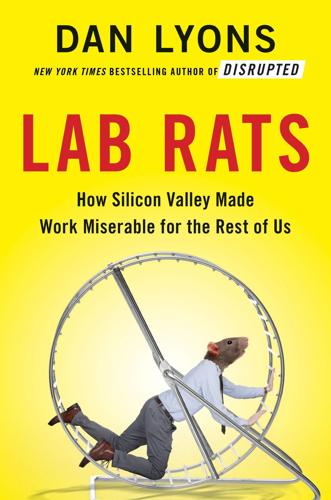
Lab Rats: How Silicon Valley Made Work Miserable for the Rest of Us
by
Dan Lyons
Published 22 Oct 2018
You Lost Your Job—Here’s a Gig Instead Where did all those laid-off factory workers and clerical workers and middle managers and postal workers go? Some went into service-sector jobs, where employment grew 17 percent, from 108 million in 2000 to 127 million in 2017, according to the Bureau of Labor Statistics. But lately many have ended up in the gig economy, driving for Uber or running errands via TaskRabbit. The gig economy is the second way in which Silicon Valley has helped drive down wages. Instead of hiring employees, companies use the Internet to assemble a workforce of contract employees. The shift to gig work was helped along by the Great Recession, which put 8.7 million people out of work between 2007 and 2010—just as companies like Uber and Airbnb were being formed.
…
Teran wanted to offer more, things like painting, plumbing, moving, and HVAC work. To do that, he launched Q Marketplace, which acts as a middleman, connecting customers to service providers. A customer in Chicago with a broken sink can do a search on the Q Marketplace website and find a local plumber who can come right away. It’s not quite the same as services like TaskRabbit, where you can hire someone to run any kind of errands. The Q Marketplace vets all the service providers, and they’re only dealing with people or companies that provide office services. To distinguish between its two businesses, Q labels its original cleaning business Q Services. That group—the cleaning business—still generates 95 percent of Q’s revenues, but eventually Teran thinks Q Marketplace could become the larger part of the business.
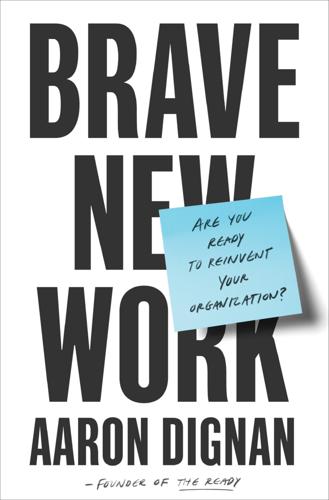
Brave New Work: Are You Ready to Reinvent Your Organization?
by
Aaron Dignan
Published 1 Feb 2019
The platforms behind the gig economy like to talk about their movement as the savior of the American worker, empowering otherwise underemployed individuals to be their own bosses and live the entrepreneurial dream. After all, the drivers and laborers who make Uber, Lyft, Grubhub, DoorDash, Postmates, Fiverr, and TaskRabbit work can choose when and where they work with unprecedented control. Realistically, though, many of the workers in the gig economy need money. That’s why they’re side hustling. They’re underemployed or unemployed, and the minimal extra income they earn from these services—85 percent make less than $500 a month—is helping them make ends meet.
…
“title ‘Director of Engineering’”: Reed Hastings, “Netflix Culture: Freedom and Responsibility,” SlideShare, August 1, 2009, www.slideshare.net/reed2001/culture-1798664. deck to invent the future: Stacey Leasca, “These Are the Highest Paying Jobs in the Gig Economy,” Forbes, July 17, 2017, www.forbes.com/sites/sleasca/2017/07/17/highest-paying-jobs-gig-economy-lyft-taskrabbit-airbnb/#e2d9eeb7b644. wage policy and productivity: MIT Press, summary of Wage Dispersion: Why Are Similar Workers Paid Differently? by Dale T. Mortensen, accessed September 1, 2018, https://mitpress.mit.edu/books/wage-dispersion. But it simply isn’t so: Joshua Isaac Smith, “The Myth of Rational Decisions—How Emotions Flavour Our Choices,” Adapt Faster, May 17, 2017, www.adaptfaster.com/the-myth-of-rational-decisions-how-emotions-flavour-our-choices.
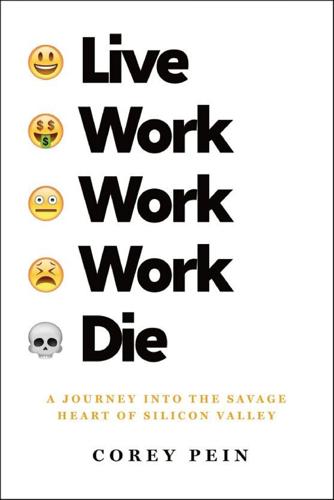
Live Work Work Work Die: A Journey Into the Savage Heart of Silicon Valley
by
Corey Pein
Published 23 Apr 2018
And in that same period, thanks to Silicon Valley’s timely opportunism, the country gained an endless bounty of gigs. Tech startups, backed by Wall Street, swept in to offer displaced workers countless push-button moneymaking schemes—what Bloomberg News called “entrepreneurialism-in-a-box.” Need fast cash? Take out a “peer-to-peer” loan, or start a crowdfunding campaign. Need a career? Take on odd jobs as a TaskRabbit or pitch corporate swag as a YouTube “vlogger.” Nine-to-five jobs with benefits and overtime may be in the process of getting disrupted out of existence, but in their place we have the internet, with endless gigs and freelance opportunities, where survival becomes something like a video game—a matter of pressing the right buttons to attain instant gratification and meager rewards.
…
See Yarvin, Curtis Guy Monkeywrench International Moore, Gordon More, Max More Right Moritz, Michael Morozov, Evgeny Mossberg, Walt Muck Rack Musk, Elon Myers, PZ MySocialPetwork.com Nail, Rob NASA National Review National Science Foundation NerdWallet Netflix Netscape Newbridge Capital Newsweek New Yorker New York Times Nike Nimoy, Leonard Nissan Northrup Grumman Obama, Barack Odierno, Raymond Omni OpenBazaar Operation SLOG Oracle Othman, Ghazi Ben Outbrain Page, Larry Palantir Pando Pandora Patchwork Paul, Terry PayPal Paytm Pelosi, Nancy PepsiCo Petbu PewDiePie PharmaBot Plouffe, David Polous, James Poole, Chris Prabhakar, Hitha Procter & Gamble Product Hunt Quinn, Zoe Rand, Ayn Reagan, Ronald Reddit RentAFriend.com Reuters Rodger, Elliot Roof, Dylann Runway Sacks, David SAIC Samsung Sanders, Bernie San Francisco Chronicle San Jose Mercury News Sarkeesian, Anita SBIR Scalia, Antonin Schmidt, Eric Schulte, Todd Seasteading Institute SENS Research Foundation Sequoia Capital SF Weekly Shockley, William Silicon Valley Index Silk Road Singularity Singularity Is Near, The (Kurzweil) Singularity Summit Singularity University Sjöblad, Hannes Skinner, B. F. Skype Slate Snapchat Sony Soros, George Soylent SpaceX Spotify Srinivasan, Balaji Stanford, Leland Stanford Review Stanford University Startup Conference Startup Vitamins Startup Weekend Stephens, Trae Stoppelman, Jeremy Swain, Robert Taboola Tamkivi TaskRabbit TechCrunch Teleport Tesla Motors Theranos Thiel, Peter Thiel Capital Tiffany, Michael Time magazine Tinder Tlon Tolkien, J.R.R. Tradehill TripAdvisor Trump, Donald Tumblr Tunney, Justine 20Mission 23andMe Twitch.tv Twitch Partners Twitter Uber Udacity Ulbricht, Ross Union Square Ventures Urbit Vanity Fair van Oudenaarden, Tom VC Taskforce Verge Verizon Vice Vinge, Vernor von Bolschwing, Otto Wagon Wallis, Stewart Wall Street Journal Week, The Wells Fargo WhatsApp Whetstone, Rachel White Ops Whitesides, George T.

Super Founders: What Data Reveals About Billion-Dollar Startups
by
Ali Tamaseb
Published 14 Sep 2021
At other times, it’s the reverse: the timing is right when prices are inflated. “Expensive cable subscriptions and record albums in part fueled the rise of streaming companies like Netflix, Spotify, and Hulu,” Flint wrote. “High, inflexible costs for contract labor and stagnant wage growth in parts of the economy gave birth to the gig economy and startups like TaskRabbit, Postmates, and DoorDash. And some macroeconomic forces—like the recession—created the sharing economy. It’s no coincidence that Airbnb and Lyft popped up in the years following the financial crisis.”2 For one more example, look to Plaid, a financial technology company that was last valued at over $5 billion.
…
“Worst-case scenario, I have a Harvard MBA, and that’s not bad either.”1 In its first six months of operation, Stitch Fix hustled its way to $132,000 in revenue. It had no website—the styling business ran on Google Docs, SurveyMonkey, and Excel, since Lake didn’t know how to code. Still, Stitch Fix grew a customer base. The startup used seed funding from Steve Anderson at Baseline Ventures to buy a small amount of inventory. It hired TaskRabbits and interns to manually enter people’s credit card info and process orders. Lake had developed a number of work-arounds to grow the business. She created an Excel model to determine a customer’s personal style, a survey to collect their personal information, and a PayPal link—manually sent to each customer—to receive payment.

A Hacker's Mind: How the Powerful Bend Society's Rules, and How to Bend Them Back
by
Bruce Schneier
Published 7 Feb 2023
Airbnb would send a message out to owners saying the city was threatening their ability to make money, even sending information about specific meetings the hosts should attend. These companies are just two examples of the “gig economy,” which is characterized by attempts to hack labor law, consumer protection law, and other laws and regulations. TaskRabbit, Handy, and DoorDash all employ the same hacks. Amazon does it too, running what’s basically a private Uber-like system for its delivery vehicles. Because those drivers are independent contractors, the company can ignore all sorts of laws that conventional delivery drivers must follow. That companies hack regulations is a surprise to no one.
…
Katzenbach, 164 spam, 46–47 spear phishing, 192 Spectre, 48 sponsored content, 194 spoofing, 81, 82 sports hacks, 41–44, 46, 103, 259n Summers, Larry, 97 sumptuary laws, 110 supply chain attacks, 145 Susskind, Jamie, 248 Suzuki, Daichi, 42 systems additional for hacking defense, 54, 60 biological, 19–20 defined, 17–18, 19 hierarchy and, 200 multiple levels of, 32 norms and, 66–67 resilience in, 152 rigidity of, 27 rules and, 18–19 thinking based on, 20 TaskRabbit, 124 Tata, Anthony, 160 tax code bugs in, 14–15 complexity of, 13–14 See also tax hacks Tax Cuts and Jobs Act (2017), 14, 15–16, 129, 146–47, 149 tax hacks architecture and, 109 creative hackers and, 22 cum-ex trading, 104–5 de minimis rule and, 249 defenses against, 15–16, 51, 61 jurisdictional rules and, 128–31 morality and, 263n wealth/power advantages and, 120 tax havens, 128–31 Tay (chatbot), 210 technological change, 251–52 telephone hacks, 26–27, 46 Terminator, 243 terrorism, 196 Tetzel, Johann, 72, 260n Theranos, 101 Thiel, Peter, 3, 4 threat modeling, 62–63, 64–65, 96 title-only bills, 154 “too big to fail” hack, 95–98 travel hacks, 179–80 trespass law, 135–36 tribal courts, 113 tribalism, 196–97 Troubled Asset Relief Program, 96 Trump, Donald banking hacks and, 77 cognitive hacks and, 182 destruction as result of hacking and, 173 legislative process hacks and, 147 norms and, 66–67 payday loans and, 126 social media and, 185 tax hacks and, 105 trust hacking, 27, 191–94, 218 TurboTax, 190 turducken, 110, 263n Turkle, Sherry, 218–19 Twenty-Fourth Amendment, 164 Twitter, 81 typos, 84–85 Uber, 99, 100, 101, 116, 123, 125, 264n unemployment insurance, 132–33 United Nations Convention on the Law of the Sea (1994), 130 user interface design, 189–90 Vacancies Reform Act (1998), 160 variable rewards, 186 venture capital (VC), 99–101, 125 Violence Against Women Act (2013), 114 voice assistants, 217 Volcker Rule, 77 Volkswagen, 234 Voltaire, 172 voter eligibility hacks, 161–63 voter ID laws, 164–65 Voting Rights Act (1965), 164 vulnerabilities acceptance of, 16 AI ability to find, 229–30, 238–39 ATM hacks and, 31, 33, 34 bugs as, 14–15 hacking as parasitical and, 48, 49 hacking hierarchy and, 201 hacking life cycle and, 21 identifying, 56–57, 77–78, 237–38 legislative process hacks and, 147–48, 267n of AI systems, 4, 209–11, 226–27 real estate hacks and, 86 responsible disclosure, 89–90 secure systems design and, 59 zero-day, 90 See also patching Walker, Scott, 166–67 WannaCry, 50 Warner, Mark, 190 Watts, Duncan, 97 wealth/power access and, 22 administrative burdens and, 134 democratic growth and, 250 election hacks and, 168–71 hacking advantages of, 103–4, 119–22 hacking governance systems and, 248 hacking normalization and, 73, 104, 119, 120, 122 impact on vulnerability patches and, 24 market hacks and, 97 trust breakdown and, 251 West, Kanye, 170 Westphal, Paul, 41 WeWork, 100 WikiLeaks, 191 Wilson, Edward O., 251 Winston, Patrick, 206 Women, Infants, and Children (WIC) program, 134 work-to-rule, 115–16, 121 YouTube, 185, 236 Zelenskyy, Volodymyr, 193 zero-day vulnerabilities, 90 Zone of Death jurisdictional loophole, 112–13 Zuckerberg, Mark, 94 Zuckerman, Ethan, 183 ALSO BY BRUCE SCHNEIER We Have Root Click Here to Kill Everybody Data and Goliath Carry On Liars and Outliers Cryptography Engineering Schneier on Security Practical Cryptography Beyond Fear Secrets and Lies The Twofish Encryption Algorithm The Electronic Privacy Papers E-Mail Security Protect Your Macintosh Applied Cryptography Copyright © 2023 by Bruce Schneier All rights reserved First Edition For information about permission to reproduce selections from this book, write to Permissions, W.
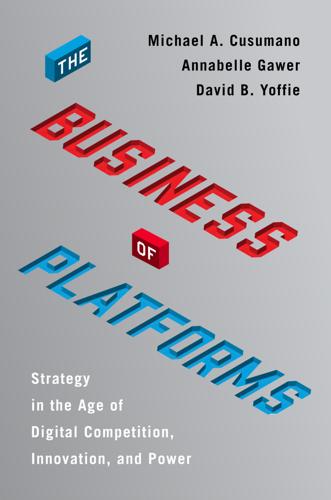
The Business of Platforms: Strategy in the Age of Digital Competition, Innovation, and Power
by
Michael A. Cusumano
,
Annabelle Gawer
and
David B. Yoffie
Published 6 May 2019
In the world of lean start-ups, the amount of capital required to develop, produce, and distribute a new product or service, or even a new platform, is a fraction of what it cost ten or twenty years ago. In the gig economy, it has been especially easy to start new transaction platforms like handyman services (e.g., Handy or TaskRabbit). In Chapter 4, we discuss how twenty-nine companies entered on-demand services, even though few survived. Similarly, dozens of companies have entered the market for online communities, web portals, and B2B marketplaces, mostly because the entry costs were relatively low. In markets where barriers to entry are high, we see a different pattern: much more industry concentration, with a higher probability of the market tipping toward one or a small number of firms.
…
There were 57 million freelancers in the U.S. in 2017; for one-third of these people, freelance activity was their main source of income.33 Stephane Kasriel, CEO of Upwork, claimed that this class of workers is growing three times faster than the traditional workforce. One estimate suggests that, if the current trend were to continue, freelancers could represent 50 percent of all U.S. laborers by 2027.34 Platforms such as Uber, Grubhub, TaskRabbit, Upwork, Handy, and Deliveroo classify much of their workforce as independent contractors. The companies justify this practice because the workers tend to perform their jobs as a side activity, with significant flexibility in their hours. In reality, this classification is mostly about saving costs: Industry executives have estimated that classifying workers as employees tends to cost 20 to 30 percent more than classifying them as contractors.35 The classification is therefore critical because many transaction platform start-ups rely on it to avoid high labor costs.
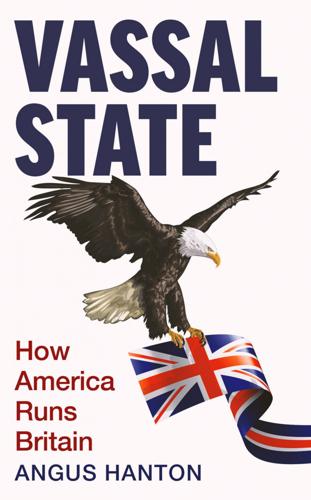
Vassal State
by
Angus Hanton
Published 25 Mar 2024
Of this total, 60 per cent of what is badged as being from Amazon is, in reality, from third parties using the ‘Amazon marketplace’.12 The US giants don’t just build their own powerful market positions across the economy: they have become the controllers of the ‘platforms’ and ‘pipes’ through which everyone else’s goods and services are delivered. Owning the route to market allows companies such as eBay or Taskrabbit, both based in the San Francisco Bay Area, to make chunky ‘toll charges’ year after year. After we have placed our online order, we will expect speedy and reliable delivery, and very likely that will come from one of the US companies – FedEx, UPS or XPO – who together have more than 15,000 lorries and vans in the UK.
…
They are working in what is often labelled the ‘gig economy’, a term implying that it is cool, flexible, individual, but the reality is that it is often tough, impersonal and insecure. Whatever the conditions, jobs are found through an app, which is often a US-owned platform taking a fee for matching workers with work. Giant automated agencies like Taskrabbit naturally demand their pound of flesh, extracting a royalty from British labour. And firms such as Uber and Deliveroo are built almost exclusively on zero-hours ‘gig workers’. A typical such worker, Anton Barker, told me his experience: ‘The training course to become a Deliveroo cycle courier took much less than a day – all they did was show me how the app works and gave me my branded kit.
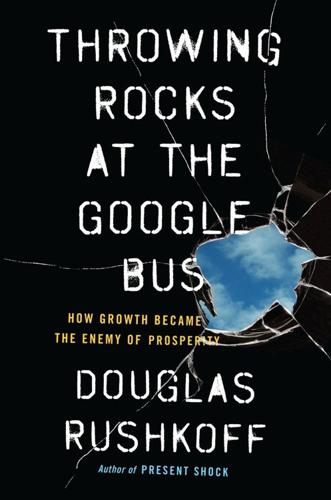
Throwing Rocks at the Google Bus: How Growth Became the Enemy of Prosperity
by
Douglas Rushkoff
Published 1 Mar 2016
One such experiment, La’Zooz, is a blockchain-managed ridesharing app, where the currency (Zooz) is mined through “proof of movement.”97 So instead of supplying and driving cars as underpaid freelancers for Uber or Lyft, drivers are co-owners of a transportation collective organized through distributed protocols. Could such platform cooperatives catch on? The basic behavior of downloading an app in order to work or rent property has already been anchored in users by Airbnb, Uber, TaskRabbit, Mechanical Turk, and countless others. Using a blockchain is just a small step further, compared to the original leap into digital labor and exchange. It is the disintermediation that all these supposedly disruptive platforms were promising in the first place. Of course, just because we have the capability to employ protocol-based technologies does not mean we have to.
…
See investors/investing sharing economy, 44–54, 218 crowdsharing apps and, 45–49 crowdsourcing platforms and, 49–50 employment opportunities, technology as replacing and obsolescing, 51–54 getting paid for our data and, 44–45 great decoupling and, 53 jobs assisting with transition to computerized society and, 51–52 learning to code and, 51 Shift Happens (Hagel), 76–77 Shirky, Clay, 27 Sidecar, 93–94 Silk Road, 145 singularity, 91 Slay, Julia, 58 Smith, Adam, 212–13 Snapchat, 32 social branding, 35–37 social graphs, 40 social media, and “likes” economy, 31–37 Somerhalder, Ian, 36 South by Southwest, 19 specialists, 178–79 Spotify, 218 Square, 141 Stallman, Richard, 216 stamp scrip, 158–59 startups, 184–205 angel investors and, 187, 188 burn rate and, 190 crowdfunding and, 198–201 direct public offerings (DPOs) and, 205–6 Google’s IPO, 194–95 hypergrowth expected of, 187–91 microfinancing platforms and, 202–4 model for building real and sustainable businesses, 196–98 playbook for establishing, 187 reverse engineering of, 184–86 Series A round of investment and, 188–89 venture capital and, 189–95 steady-state enterprises, 98–123 alternative corporate structures and, 118–23 appropriate size for business, finding, 104–5 benefit corporations and, 119 contracting with small and medium-sized enterprises and, 112 dividends as means of rewarding shareholders and, 113–14 dual transformation and, 108–9 ecosystem as model for assembling, 105 employee ownership of company and, 116–18 extractive bias of traditional corporate model, eschewing, 104 family business model and, 103–4, 231–32 flexible purpose corporations and, 119–20 growth, shifting away from, 103–6 hybrid approaches to attaining, 106–12 inclusive capitalism and, 111–12 low-profit limited liability company (L3C) and, 120–21 not-for-profits (NFPs) and, 121–23 open sharing and collaborative corporate strategies and, 106–7 privatization and, 114–16 shareholder mentality, changing, 112–18 technological revolutions, phases of, 98–102 stimulative economic policies, 136, 137 stock market crash of 1929, 99 storytelling, 236 Strickler, Yancey, 198 student debt, 153 subsidiarity, 231–32 supermarket chains, hybrid strategies for, 109–10 Supplier Connection, 112 surge pricing, 86 synergy, 99 Talmud, 208 Tapscott, Don, 49n Target, 142 TaskRabbit, 222 tax anticipation scrip, 159 taxi industry, 85–86 TD Waterhouse, 176 Tea Party, 99–100 technological revolutions, 98–102 creative destruction and, 83–87 destructive destruction and, 100 frenzy phase of, 98–99 government intervention and, 99–100 irruption phase of, 98 maturity phase of, 98–99 synergy phase of, 99 turning point phase of, 99 Thatcher, Margaret, 64 theAudience, 36 Thiel, Peter, 120, 191–92 This Changes Everything (Klein), 135 3-d printing, 62–63 360 deals, 34 time dollar systems, 161–63 toy industry, 85 Toyoda, Akio, 105–6 Toyota Motor Corporation, 105–6 tragedy of the commons, 215–16 Treehouse, 59 Tumblr, 32 turning point, 99 Twitter, 7, 8–9, 195 tyranny of choice, 30 Uber, 4, 93, 94, 98–99, 188, 213, 219, 222, 229 peer-to-peer commerce enabled by, 45, 46 as platform monopoly, 85–87 pricing power of, 47–48 unemployment insurance, 99 unemployment solution, 54–67 guaranteed minimum income programs and, 62–65 guaranteed minimum wage public jobs and, 65–66 hourly-wage employment, history of, 56 joblessness as feature of new digital economy and, 55–56 questioning need for work and, 56–58 real needs, getting paid to address, 65–67 reducing 40-hour workweek and, 58–60 sharing productivity gains with employees and, 60–62 Unilever, 112, 205 United Steel Workers, 220 Upwork, 51, 200 USA Today,173 velocity of money, 140–41 venture capital, 189–95 Vicarious, 119–20 Victorian exhibition, 20 Volkswagen, 106 Wall Street Journal,7, 8, 37–38 Walmart, 47, 73–75, 110–11 Watson, 90–91 wealth inequality.
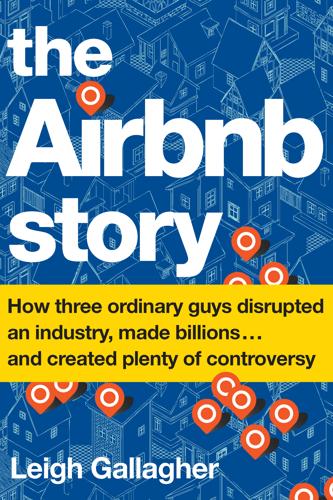
The Airbnb Story: How Three Ordinary Guys Disrupted an Industry, Made Billions...and Created Plenty of Controversy
by
Leigh Gallagher
Published 14 Feb 2017
That is of course precisely what makes it polarizing and objectionable to so many people who can never imagine using it. But it’s also what makes it unique. This kind of “sharing”—this hyperpersonal opening up of the most intimate and safest aspect of one’s life to a stranger—is not present when you hire a person to fix a leak on TaskRabbit, or when you get into someone’s air-conditioned black car for a silent ride to the airport with your head in your phone. More than anything else, it is this aspect of Airbnb that distinguishes it from Uber, Lyft, and any other of its sharing-economy peers. Elisa Schreiber, marketing partner at Greylock Partners, an investor in the company, summarized this distinction concisely after we got to talking about it one day.
…
In the more recent crisis around the widespread discriminatory behavior on the Airbnb platform—even bigger in some ways than the EJ crisis—he pulled in outside sources like former attorney general Eric Holder and ACLU veteran Laura Murphy, but he also went to Andreessen Horowitz cofounder Ben Horowitz and his wife, Felicia, as well as to TaskRabbit CEO Stacy Brown-Philpot. Those closest to him praise Chesky for his vision. “You take a picture of Brian’s mind, [and] he’s in 2030 or 2040 already,” says Lisa Dubost, one of the company’s first employees, who worked on culture and then moved to the business-travel team before leaving the company in 2016 to move to Europe to be with her family.

Frugal Innovation: How to Do Better With Less
by
Jaideep Prabhu Navi Radjou
Published 15 Feb 2015
Sharing economy firms include Airbnb (sharing homes), RelayRides, BlaBlaCar and easyCar (sharing cars), ParkatmyHouse (sharing parking spaces), BringBee (sharing trips to the grocery store), Wishi or Wear It Share It (choosing clothes), Eatwith (sharing your dinner), yerdle.com (sharing household equipment with neighbours), Skillshare (sharing skills and knowledge) and TaskRabbit (outsourcing small jobs and errands). As we saw in Chapter 1, these services typically take advantage of the web and social media to enable ordinary people to monetise their time, space, knowledge or skills. The sharing economy contributes to environmental sustainability because it reduces individual consumption by allowing, for instance, four people to share the same car rather than having to buy four different cars.
…
MacArthur Foundation 14 John Deere 67 John Lewis 195 Johnson & Johnson 100, 111 Johnson, Warren 98 Jones, Don 112 jugaad (frugal ingenuity) 199, 202 Jugaad Innovation (Radjou, Prabhu and Ahuja, 2012) xvii, 17 just-in-time design 33–4 K Kaeser, Joe 217 Kalanick, Travis 163 Kalundborg (Denmark) 160 kanju 201 Karkal, Shamir 124 Kaufman, Ben 50–1, 126 Kawai, Daisuke 29–30 Kelly, John 199–200 Kennedy, President John 138 Kenya 57, 200–1 key performance indicators see KPIs Khan Academy 16–17, 113–14, 164 Khan, Salman (Sal) 16–17, 113–14 Kickstarter 17, 48, 137, 138 KieranTimberlake 196 Kimberly-Clark 25, 145 Kingfisher 86–7, 91, 97, 157, 158–9, 185–6, 192–3, 208 KissKissBankBank 17, 137 Knox, Steve 145 Knudstorp, Jørgen Vig 37, 68, 69 Kobori, Michael 83, 100 KPIs (key performance indicators) 38–9, 67, 91–2, 185–6, 208 Kuhndt, Michael 194 Kurniawan, Arie 151–2 L La Chose 108 La Poste 92–3, 157 La Ruche qui dit Oui 137 “labs on a chip” 52 Lacheret, Yves 173–5 Lada 1 laser cutters 134, 166 Laskey, Alex 119 last-mile challenge 57, 146, 156 L’Atelier 168–9 Latin America 161 lattice organisation 63–4 Laury, Véronique 208 Laville, Elisabeth 91 Lawrence, Jamie 185, 192–3, 208 LCA (life-cycle assessment) 196–7 leaders 179, 203–5, 214, 217 lean manufacturing 192 leanness 33–4, 41, 42, 170, 192 Learnbox 114 learning by doing 173, 179 learning organisations 179 leasing 123 Lee, Deishin 159 Lego 51, 126 Lego Group 37, 68, 69, 144 Legrand 157 Lenovo 56 Leroy, Adolphe 127 Leroy Merlin 127–8 Leslie, Garthen 150–1 Lever, William Hesketh 96 Levi Strauss & Co 60, 82–4, 100, 122–3 Lewis, Dijuana 212 life cycle of buildings 196 see also product life cycle life-cycle assessment (LCA) 196–7 life-cycle costs 12, 24, 196 Lifebuoy soap 95, 97 lifespan of companies 154 lighting 32, 56, 123, 201 “lightweighting” 47 linear development cycles 21, 23 linear model of production 80–1 Link 131 littleBits 51 Livi, Daniele 88 Livi, Vittorio 88 local communities 52, 57, 146, 206–7 local markets 183–4 Local Motors 52, 129, 152 local solutions 188, 201–2 local sourcing 51–2, 56, 137, 174, 181 localisation 56, 137 Locavesting (Cortese, 2011) 138 Logan car 2–3, 12, 179, 198–9 logistics 46, 57–8, 161, 191, 207 longevity 121, 124 Lopez, Maribel 65–6 Lopez Research 65–6 L’Oréal 174 Los Alamos National Laboratory 170 low-cost airlines 60, 121 low-cost innovation 11 low-income markets 12–13, 161, 203, 207 Lowry, Adam 81–2 M m-health 109, 111–12 M-KOPA 201 M-Pesa 57, 201 M3D 48, 132 McDonough Braungart Design Chemistry (MBDC) 84 McDonough, William 82 McGregor, Douglas 63 MacGyvers 17–18, 130, 134, 167 McKelvey, Jim 135 McKinsey & Company 81, 87, 209 mainstream, frugal products in 216 maintenance 66, 75, 76, 124, 187 costs 48–9, 66 Mainwaring, Simon 8 Maistre, Christophe de 187–8, 216 Maker Faire 18, 133–4 Maker platform 70 makers 18, 133–4, 145 manufacturing 20th-century model 46, 55, 80–1 additive 47–9 continuous 44–5 costs 47, 48, 52 decentralised 9, 44, 51–2 frugal 44–54 integration with logistics 57–8 new approaches 50–4 social 50–1 subtractive method 48 tools for 47, 47–50 Margarine Unie 96 market 15, 28, 38, 64, 186, 189, 192 R&D and 21, 26, 33, 34 market research 25, 61, 139, 141 market share 100 marketing 21–2, 24, 36, 61–3, 91, 116–20, 131, 139 and R&D 34, 37, 37–8 marketing teams 143, 150 markets 12–13, 42, 62, 215 see also emerging markets Marks & Spencer (M&S) 97, 215 Plan A 90, 156, 179–81, 183–4, 186–7, 214 Marriott 140 Mars 57, 158–9, 161 Martin Marietta 159 Martin, Tod 154 mass customisation 9, 46, 47, 48, 57–8 mass market 189 mass marketing 21–2 mass production 9, 46, 57, 58, 74, 129, 196 Massachusetts Institute of Technology see MIT massive open online courses see MOOCs materials 3, 47, 48, 73, 92, 161 costs 153, 161, 190 recyclable 74, 81, 196 recycled 77, 81–2, 83, 86, 89, 183, 193 renewable 77, 86 repurposing 93 see also C2C; reuse Mayhew, Stephen 35, 36 Mazoyer, Eric 90 Mazzella, Frédéric 163 MBDC (McDonough Braungart Design Chemistry) 84 MDI 16 measurable goals 185–6 Mechanical Engineer Laboratory (MEL) 52 “MEcosystems” 154–5, 156–8 Medicare 110 medication 111–12 Medicity 211 MedStartr 17 MEL (Mechanical Engineer Laboratory) 52 mental models 2, 193–203, 206, 216 Mercure 173 Merlin, Rose 127 Mestrallet, Gérard 53, 54 method (company) 81–2 Mexico 38, 56 Michelin 160 micro-factories 51–2, 52, 66, 129, 152 micro-robots 52 Microsoft 38 Microsoft Kinect 130 Microsoft Word 24 middle classes 197–8, 216 Migicovsky, Eric 137–8 Mikkiche, Karim 199 millennials 7, 14, 17, 131–2, 137, 141, 142 MindCET 165 miniaturisation 52, 53–4 Mint.com 125 MIT (Massachusetts Institute of Technology) 44–5, 107, 130, 134, 202 mobile health see m-health mobile phones 24, 32, 61, 129–30, 130, 168, 174 emerging market use 198 infrastructure 56, 198 see also smartphones mobile production units 66–7 mobile technologies 16, 17, 103, 133, 174, 200–1, 207 Mocana 151 Mochon, Daniel 132 modular design 67, 90 modular production units 66–7 Modularer Querbaukasten see MQB “mompreneurs” 145 Mondelez 158–9 Money Dashboard 125 Moneythink 162 monitoring 65–6, 106, 131 Monopoly 144 MOOCs (massive open online courses) 60, 61, 112, 113, 114, 164 Morieux, Yves 64 Morocco 207 Morris, Robert 199–200 motivation, employees 178, 180, 186, 192, 205–8 motivational approaches to shaping consumer behaviour 105–6 Motorola 56 MQB (Modularer Querbaukasten) 44, 45–6 Mulally, Alan 70, 166 Mulcahy, Simon 157 Mulliez family 126–7 Mulliez, Vianney 13, 126 multi-nodal innovation 202–3 Munari, Bruno 93 Murray, Mike 48–9 Musk, Elon 172 N Nano car 119, 156 National Geographic 102 natural capital, loss of 158–9 Natural Capital Leaders Platform 158–9 natural resources 45, 86 depletion 7, 72, 105, 153, 158–9 see also resources NCR 55–6 near-shoring 55 Nelson, Simon 113 Nemo, Sophie-Noëlle 93 Nest Labs 98–100, 103 Nestlé 31, 44, 68, 78, 94, 158–9, 194, 195 NetPositive plan 86, 208 networking 152–3, 153 new materials 47, 92 New Matter 132 new technologies 21, 27 Newtopia 32 next-generation customers 121–2 next-generation manufacturing techniques 44–6, 46–7 see also frugal manufacturing Nigeria 152, 197–8 Nike 84 NineSigma 151 Nissan 4, 4–5, 44, 199 see also Renault-Nissan non-governmental organisations 167 non-profit organisations 161, 162, 202 Nooyi, Indra 217 Norman, Donald 120 Norris, Greg 196 North American companies 216–17 North American market 22 Northrup Grumman 68 Norton, Michael 132 Norway 103 Novartis 44–5, 215 Novotel 173, 174 nudging 100, 108, 111, 117, 162 Nussbaum, Bruce 140 O O2 147 Obama, President Barack 6, 8, 13, 134, 138, 208 obsolescence, planned 24, 121 offshoring 55 Oh, Amy 145 Ohayon, Elie 71–2 Oliver Wyman 22 Olocco, Gregory 206 O’Marah, Kevin 58 on-demand services 39, 124 online communities 31, 50, 61, 134 online marketing 143 online retailing 60, 132 onshoring 55 Opel 4 open innovation 104, 151, 152, 153, 154 open-source approach 48, 129, 134, 135, 172 open-source hardware 51, 52, 89, 130, 135, 139 open-source software 48, 130, 132, 144–5, 167 OpenIDEO 142 operating costs 45, 215 Opower 103, 109, 119 Orange 157 Orbitz 173 organisational change 36–7, 90–1, 176, 177–90, 203–8, 213–14, 216 business models 190–3 mental models 193–203 organisational culture 36–7, 170, 176, 177–9, 213–14, 217 efficacy focus 181–3 entrepreneurial 76, 173 see also organisational change organisational structure 63–5, 69 outsourcing 59, 143, 146 over-engineering 27, 42, 170 Overby, Christine 25 ownership 9 Oxylane Group 127 P P&G (Procter & Gamble) 19, 31, 58, 94, 117, 123, 145, 195 packaging 57, 96, 195 Page, Larry 63 “pain points” 29, 30, 31 Palmer, Michael 212 Palo Alto Junior League 20 ParkatmyHouse 17, 63, 85 Parker, Philip 61 participation, customers 128–9 partner ecosystems 153, 154, 200 partners 65, 72, 148, 153, 156–8 sharing data with 59–60 see also distributors; hyper-collaboration; suppliers Partners in Care Foundation 202 partnerships 41, 42, 152–3, 156–7, 171–2, 174, 191 with SMBs 173, 174, 175 with start-ups 20, 164–5, 175 with suppliers 192–3 see also hyper-collaboration patents 171–2 Payne, Alex 124 PE International 196 Pearson 164–5, 167, 181–3, 186, 215 Pebble 137–8 peer-to-peer economic model 10 peer-to-peer lending 10 peer-to-peer sales 60 peer-to-peer sharing 136–7 Pélisson, Gérard 172–3 PepsiCo 38, 40, 179, 190, 194, 215 performance 47, 73, 77, 80, 95 of employees 69 Pernod Ricard 157 personalisation 9, 45, 46, 48, 62, 129–30, 132, 149 Peters, Tom 21 pharmaceutical industry 13, 22, 23, 33, 58, 171, 181 continuous manufacturing 44–6 see also GSK Philippines 191 Philips 56, 84, 100, 123 Philips Lighting 32 Picaud, Philippe 122 Piggy Mojo 119 piggybacking 57 Piketty, Thomas 6 Plan A (M&S) 90, 156, 179–81, 183–4, 186–7, 214 Planet 21 (Accor) 174–5 planned obsolescence 24, 121 Plastyc 17 Plumridge, Rupert 18 point-of-sale data 58 Poland 103 pollution 74, 78, 87, 116, 187, 200 Polman, Paul 11, 72, 77, 94, 203–5, 217 portfolio management tools 27, 33 Portugal 55, 103 postponement 57–8 Potočnik, Janez 8, 79 Prabhu, Arun 25 Prahalad, C.K. 12 predictive analytics 32–3 predictive maintenance 66, 67–8 Priceline 173 pricing 81, 117 processes digitising 65–6 entrenched 14–16 re-engineering 74 simplifying 169, 173 Procter & Gamble see P&G procurement priorities 67–8 product life cycle 21, 75, 92, 186 costs 12, 24, 196 sustainability 73–5 product-sharing initiatives 87 production costs 9, 83 productivity 49, 59, 65, 79–80, 153 staff 14 profit 14, 105 Progressive 100, 116 Project Ara 130 promotion 61–3 Propeller Health 111 prosumers xix–xx, 17–18, 125, 126–33, 136–7, 148, 154 empowering and engaging 139–46 see also horizontal economy Protomax 159 prototypes 31–2, 50, 144, 152 prototyping 42, 52, 65, 152, 167, 192, 206 public 50–1, 215 public sector, working with 161–2 publishers 17, 61 Pullman 173 Puma 194 purchasing power 5–6, 216 pyramidal model of production 51 pyramidal organisations 69 Q Qarnot Computing 89 Qualcomm 84 Qualcomm Life 112 quality 3, 11–12, 15, 24, 45, 49, 82, 206, 216 high 1, 9, 93, 198, 216 measure of 105 versus quantity 8, 23 quality of life 8, 204 Quicken 19–21 Quirky 50–1, 126, 150–1, 152 R R&D 35, 67, 92, 151 big-ticket programmes 35–6 and business development 37–8 China 40, 188, 206 customer focus 27, 39, 43 frugal approach 12, 26–33, 82 global networks 39–40 incentives 38–9 industrial model 2, 21–6, 33, 36, 42 market-focused, agile model 26–33 and marketing 34, 37, 37–8 recommendations for managers 34–41 speed 23, 27, 34, 149 spending 15, 22, 23, 28, 141, 149, 152, 171, 187 technology culture 14–15, 38–9 see also Air Liquide; Ford; GSK; IBM; immersion; Renault; SNCF; Tarkett; Unilever R&D labs 9, 21–6, 70, 149, 218 in emerging markets 40, 188, 200 R&D teams 26, 34, 38–9, 65, 127, 150, 194–5 hackers as 142 innovation brokering 168 shaping customer behaviour 120–2 Raspberry Pi 135–6, 164 Ratti, Carlo 107 raw materials see materials real-time demand signals 58, 59 Rebours, Christophe 157–8 recession 5–6, 6, 46, 131, 180 Reckitt Benckiser 102 recommendations for managers flexing assets 65–71 R&D 34–41 shaping consumer behaviour 116–24 sustainability 90–3 recruiting 70–1 recyclable materials 74, 81, 196 recyclable products 3, 73, 159, 195–6 recycled materials 77, 81–2, 83, 86, 89, 183, 193 recycling 8, 9, 87, 93, 142, 159 e-waste 87–8 electronic and electrical goods (EU) 8, 79 by Tarkett 73–7 water 83, 175 see also C2C; circular economy Recy’Go 92–3 regional champions 182 regulation 7–8, 13, 78–9, 103, 216 Reich, Joshua 124 RelayRides 17 Renault 1–5, 12, 117, 156–7, 179 Renault-Nissan 4–5, 40, 198–9, 215 renewable energy 8, 53, 74, 86, 91, 136, 142, 196 renewable materials 77, 86 Replicator 132 repurposing 93 Requardt, Hermann 189 reshoring 55–6 resource constraints 4–5, 217 resource efficiency 7–8, 46, 47–9, 79, 190 Resource Revolution (Heck, Rogers and Carroll, 2014) 87–8 resources 40, 42, 73, 86, 197, 199 consumption 9, 26, 73–7, 101–2 costs 78, 203 depletion 7, 72, 105, 153, 158–9 reducing use 45, 52, 65, 73–7, 104, 199, 203 saving 72, 77, 200 scarcity 22, 46, 72, 73, 77–8, 80, 158–9, 190, 203 sharing 56–7, 159–61, 167 substitution 92 wasting 169–70 retailers 56, 129, 214 “big-box” 9, 18, 137 Rethink Robotics 49 return on investment 22, 197 reuse 9, 73, 76–7, 81, 84–5, 92–3, 200 see also C2C revenues, generating 77, 167, 180 reverse innovation 202–3 rewards 37, 178, 208 Riboud, Franck 66, 184, 217 Rifkin, Jeremy 9–10 robots 47, 49–50, 70, 144–5, 150 Rock Health 151 Rogers, Jay 129 Rogers, Matt 87–8 Romania 2–3, 103 rookie mindset 164, 168 Rose, Stuart 179–80, 180 Roulin, Anne 195 Ryan, Eric 81–2 Ryanair 60 S S-Oil 106 SaaS (software as a service) 60 Saatchi & Saatchi 70–1 Saatchi & Saatchi + Duke 71–2, 143 sales function 15, 21, 25–6, 36, 116–18, 146 Salesforce.com 157 Santi, Paolo 108 SAP 59, 186 Saunders, Charles 211 savings 115 Sawa Orchards 29–31 Scandinavian countries 6–7 see also Norway Schmidt, Eric 136 Schneider Electric 150 Schulman, Dan 161–2 Schumacher, E.F. 104–5, 105 Schweitzer, Louis 1, 2, 3, 4, 179 SCM (supply chain management) systems 59 SCOR (supply chain operations reference) model 67 Seattle 107 SEB 157 self-sufficiency 8 selling less 123–4 senior managers 122–4, 199 see also CEOs; organisational change sensors 65–6, 106, 118, 135, 201 services 9, 41–3, 67–8, 124, 149 frugal 60–3, 216 value-added 62–3, 76, 150, 206, 209 Shapeways 51, 132 shareholders 14, 15, 76, 123–4, 180, 204–5 sharing 9–10, 193 assets 159–61, 167 customers 156–8 ideas 63–4 intellectual assets 171–2 knowledge 153 peer-to-peer 136–9 resources 56–7, 159–61, 167 sharing economy 9–10, 17, 57, 77, 80, 84–7, 108, 124 peer-to-peer sharing 136–9 sharing between companies 159–60 shipping costs 55, 59 shopping experience 121–2 SIEH hotel group 172–3 Siemens 117–18, 150, 187–9, 215, 216 Sigismondi, Pier Luigi 100 Silicon Valley 42, 98, 109, 150, 151, 162, 175 silos, breaking out of 36–7 Simple Bank 124–5 simplicity 8, 41, 64–5, 170, 194 Singapore 175 Six Sigma 11 Skillshare 85 SkyPlus 62 Small is Beautiful (Schumacher, 1973) 104–5 “small is beautiful” values 8 small and medium-sized businesses see SMBs Smart + Connected Communities 29 SMART car 119–20 SMART strategy (Siemens) 188–9 smartphones 17, 100, 106, 118, 130, 131, 135, 198 in health care 110, 111 see also apps SmartScan 29 SMBs (small and medium-sized businesses) 173, 174, 175, 176 SMS-based systems 42–3 SnapShot 116 SNCF 41–3, 156–7, 167 SoapBox 28–9 social business model 206–7 social comparison 109 social development 14 social goals 94 social learning 113 social manufacturing 47, 50–1 social media 16, 71, 85, 106, 108, 168, 174 for marketing 61, 62, 143 mining 29, 58 social pressure of 119 tools 109, 141 and transaction costs 133 see also Facebook; social networks; Twitter social networks 29, 71, 72, 132–3, 145, 146 see also Facebook; Twitter social pressure 119 social problems 82, 101–2, 141, 142, 153, 161–2, 204 social responsibility 7, 10, 14, 141, 142, 197, 204 corporate 77, 82, 94, 161 social sector, working with 161–2 “social tinkerers” 134–5 socialising education 112–14 Sofitel 173 software 72 software as a service (SaaS) 60 solar power 136, 201 sourcing, local 51–2, 56 Southwest Airlines 60 Spain 5, 6, 103 Spark 48 speed dating 175, 176 spending, on R&D 15, 22, 23, 28, 141, 149, 152, 171, 187 spiral economy 77, 87–90 SRI International 49, 52 staff see employees Stampanato, Gary 55 standards 78, 196 Starbucks 7, 140 start-ups 16–17, 40–1, 61, 89, 110, 145, 148, 150, 169, 216 investing in 137–8, 157 as partners 42, 72, 153, 175, 191, 206 see also Nest Labs; Silicon Valley Statoil 160 Steelcase 142 Stem 151 Stepner, Diana 165 Stewart, Emma 196–7 Stewart, Osamuyimen 201–2 Sto Corp 84 Stora Enso 195 storytelling 112, 113 Strategy& see Booz & Company Subramanian, Prabhu 114 substitution of resources 92 subtractive manufacturing 48 Sun Tzu 158 suppliers 67–8, 83, 148, 153, 167, 176, 192–3 collaboration with 76, 155–6 sharing with 59–60, 91 visibility 59–60 supply chain management see SCM supply chain operations reference (SCOR) model 67 supply chains 34, 36, 54, 65, 107, 137, 192–3 carbon footprint 156 costs 58, 84 decentralisation 66–7 frugal 54–60 integrating 161 small-circuit 137 sustainability 137 visibility 34, 59–60 support 135, 152 sustainability xix, 9, 12, 72, 77–80, 82, 97, 186 certification 84 as competitive advantage 80 consumers and 95, 97, 101–4 core design principle 82–4, 93, 195–6 and growth 76, 80, 104–5 perceptions of 15–16, 80, 91 recommendations for managers 90–3 regulatory demand for 78–9, 216 standard bearers of 80, 97, 215 see also Accor; circular economy; Kingfisher; Marks & Spencer; Tarkett; Unilever sustainable design 82–4 see also C2C sustainable distribution 57, 161 sustainable growth 72, 76–7 sustainable lifestyles 107–8 Sustainable Living Plan (Unilever) 94–7, 179, 203–4 sustainable manufacturing 9, 52 T “T-shaped” employees 70–1 take-back programmes 9, 75, 77, 78 Tally 196–7 Tarkett 73–7, 80, 84 TaskRabbit 85 Tata Motors 16, 119 Taylor, Frederick 71 technical design 37–8 technical support, by customers 146 technology 2, 14–15, 21–2, 26, 27 TechShop 9, 70, 134–5, 152, 166–7 telecoms sector 53, 56 Telefónica 147 telematic monitoring 116 Ternois, Laurence 42 Tesco 102 Tesla Motors 92, 172 testing 28, 42, 141, 170, 192 Texas Industries 159 Textoris, Vincent 127 TGV Lab 42–3 thermostats 98–100 thinking, entrenched 14–16 Thompson, Gav 147 Timberland 90 time 4, 7, 11, 41, 72, 129, 170, 200 constraints 36, 42 see also development cycle tinkerers 17–18, 133–5, 144, 150, 152, 153, 165–7, 168 TiVo 62 Tohamy, Noha 59–60 top-down change 177–8 top-down management 69 Total 157 total quality management (TQM) 11 total volatile organic compounds see TVOC Toyota 44, 100 Toyota Sweden 106–7 TQM (total quality management) 11 traffic 108, 116, 201 training 76, 93, 152, 167, 170, 189 transaction costs 133 transparency 178, 185 transport 46, 57, 96, 156–7 Transport for London 195 TrashTrack 107 Travelocity 174 trial and error 173, 179 Trout, Bernhardt 45 trust 7, 37, 143 TVOC (total volatile organic compounds) 74, 77 Twitter 29, 62, 135, 143, 147 U Uber 136, 163 Ubuntu 202 Uchiyama, Shunichi 50 UCLA Health 202–3 Udacity 61, 112 UK 194 budget cuts 6 consumer empowerment 103 industrial symbiosis 160 savings 115 sharing 85, 138 “un-management” 63–4, 64 Unboundary 154 Unilever 11, 31, 57, 97, 100, 142, 203–5, 215 and sustainability 94–7, 104, 179, 203–4 University of Cambridge Engineering Design Centre (EDC) 194–5 Inclusive Design team 31 Institute for Sustainability Leadership (CISL) 158–9 upcycling 77, 88–9, 93, 159 upselling 189 Upton, Eben 135–6 US 8, 38, 44, 87, 115, 133, 188 access to financial services 13, 17, 161–2 ageing population 194 ageing workforce 13 commuting 131 consumer spending 5, 6, 103 crowdfunding 137–8, 138 economic pressures 5, 6 energy use 103, 119, 196 environmental awareness 7, 102 frugal innovation in 215–16, 218 health care 13, 110, 208–13, 213 intellectual property 171 onshoring 55 regulation 8, 78, 216 sharing 85, 138–9 shifting production from China to 55, 56 tinkering culture 18, 133–4 user communities 62, 89 user interfaces 98, 99 user-friendliness 194 Utopies 91 V validators 144 value 11, 132, 177, 186, 189–90 aspirational 88–9 to customers 6–7, 21, 77, 87, 131, 203 from employees 217 shareholder value 14 value chains 9, 80, 128–9, 143, 159–60, 190, 215 value engineering 192 “value gap” 54–5 value-added services 62–3, 76, 150, 206, 209 values 6–7, 14, 178, 205 Vandebroek, Sophie 169 Vasanthakumar, Vaithegi 182–3 Vats, Tanmaya 190, 192 vehicle fleets, sharing 57, 161 Verbaken, Joop 118 vertical integration 133, 154 virtual prototyping 65 virtuous cycle 212–13 visibility 34, 59–60 visible learning 112–13 visioning sessions 193–4 visualisation 106–8 Vitality 111 Volac 158–9 Volkswagen 4, 44, 45–6, 129, 144 Volvo 62 W wage costs 48 wages, in emerging markets 55 Waitrose, local suppliers 56 Walker, James 87 walking the walk 122–3 Waller, Sam 195 Walmart 9, 18, 56, 162, 216 Walton, Sam 9 Wan Jia 144 Washington DC 123 waste 24, 87–9, 107, 159–60, 175, 192, 196 beautifying 88–9, 93 e-waste 24, 79, 87–8, 121 of energy 119 post-consumer 9, 75, 77, 78, 83 reducing 47, 74, 85, 96, 180, 209 of resources 169–70 in US health-care system 209 see also C2C; recycling; reuse water 78, 83, 104, 106, 158, 175, 188, 206 water consumption 79, 82–3, 100, 196 reducing 74, 75, 79, 104, 122–3, 174, 183 wealth 105, 218 Wear It Share It (Wishi) 85 Weijmarshausen, Peter 51 well-being 104–5 Wham-O 56 Whirlpool 36 “wicked” problems 153 wireless technologies 65–6 Wiseman, Liz 164 Wishi (Wear It Share It) 85 Witty, Andrew 35, 35–6, 37, 39, 217 W.L.

The Age of Stagnation: Why Perpetual Growth Is Unattainable and the Global Economy Is in Peril
by
Satyajit Das
Published 9 Feb 2016
The sharing economy (also known as the peer economy, collaborative economy, and gig economy) is based on the ubiquitous Internet, improved broadband connectivity, smartphones, and apps. Individuals with spare time, houses, rooms, cars, and the like can use them as sources of work and income. The economy that benefits everyone focuses on transport (Uber, Lyft, Sidecar, GetTaxi, Hailo), short-term accommodation (Airbnb, HomeAway), small tasks (TaskRabbit, Fiverr), grocery-shopping services (Instacart), home-cooked meals (Feastly), on-demand delivery services (Postmates, Favor), pet transport (DogVacay, Rover), car rental (RelayRides, Getaround), boat rental (Boatbound), and tool rental (Zilok). Its cheerleaders frame the sharing economy in lofty utopian terms: it's not business, but a social movement, transforming relationships between people in a new form of Internet intimacy.
…
Given the high stakes, competition is fierce, unethical, and unsavory. Uber has admitted trying to disrupt Lyft's fundraising efforts. It does not welcome criticism, allegedly considering spending a million dollars to hire researchers to uncover information on the personal lives of reporters critical of its service in order to discredit them. TaskRabbit makes it difficult for the bunnies to communicate with each other, preventing them from organizing or unionizing. In the latest technology gold rush, venture capital investors are speculating on businesses that effectively broker arrangements between customers and workers, betting that low prices will create mass markets for services once reserved for the wealthy.
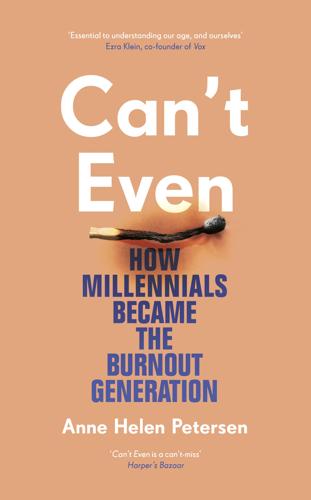
Can't Even: How Millennials Became the Burnout Generation
by
Anne Helen Petersen
Published 14 Jan 2021
This work was framed as particularly suitable for supposedly self-centered, picky, self-righteous millennials; as the gig economy grew in visibility, Forbes declared, “The 9 to 5 job may soon be a relic of the past, if millennials have their way.”21 But that’s not how it worked out. Not for Handy cleaners, or TaskRabbits, or laborers on Amazon’s Mechanical Turk, who bid to complete menial online tasks (clicking on every photo with a picture of a bird, for example, in order to assist with AI recognition) for pennies. Not for Door Dashers, who until a massive online backlash was using tips to cover their independent contractors’ base pay—meaning that if a Dasher was guaranteed $6.85 per delivery and received a $3 tip, they still received just $6.85; users were essentially tipping DoorDash itself.
…
It liberated our minds to pursue other endeavors, like work.”4 One result of this drive for productivity is a new hierarchy of labor: On the top end, there are salaried, hyperproductive knowledge workers. Below, there are the people who perform the “mundane” tasks that make that productivity possible: nannies, TaskRabbits, Uber Eats drivers, house cleaners, personal organizers, Trunk Club stylists, Blue Apron packagers, Amazon warehouse workers and drivers, FreshDirect shoppers. Rich people have always had servants. The difference, then, is that those servants made it so that they didn’t have to work—not so that they could work more.

What Algorithms Want: Imagination in the Age of Computing
by
Ed Finn
Published 10 Mar 2017
In the past few years, the incubators and venture capitalists of Silicon Valley have turned their attention to new areas ready for algorithmic reinvention that are more distant from the traditional technology sector. The triumph of gamification, ubiquitous computing, and remote sensing (in other words, the quantification of everything) has led to a slew of new businesses that add an algorithmic layer over previously stable cultural spaces. Companies like TaskRabbit, Uber, and Airbnb are adapting algorithmic logic to find new efficiencies in lodging, transportation, and personal services, inserting a computational layer of abstraction between consumers and their traditional pathways to services like taxis, hotels, and personal assistants. These companies take the ethos of games like FarmVille and impose their “almost-magic circle” on what was previously considered to be serious business.
…
See also Siri; Star Trek computer Interface economy Airbnb and, 124 Amazon and, 124 arbitrage and, 123–131, 139–140, 145, 147 class and, 129–130 cloud warehouses and, 131–145 efficient access and, 127–128 faking sincerity and, 146–147 Google and, 124 individualism and, 126–127 intimacy and, 129 labor and, 123–145, 147 Mechanical Turk and, 135–145 moral machinery and, 144–149 Netflix and, 124 remobilization of capitalism and, 127 sharing economy and, 54, 123, 127–129, 145, 148 Uber and, 123–133, 145, 147 worker conditions and, 132–134, 139–140 work of algorithms and, 123–145 wrappers and, 129 Interface Effect, The (Galloway), 143–144 Interfaces abstraction and, 52, 54, 92, 96, 103, 108, 110–111 API, 7, 113 Bogost and, 49 clean, 8, 96, 110 community and, 52 conscious, 36 cultural processing and, 16 customized, 36 fetish and, 35 Google and, 66–67 imagination and, 189 layers of, 12, 52, 123, 126–131, 140–141, 144, 189 metaphor and, 25, 60 Ramsey and, 52 Siri and, 59–60, 63, 75, 77 Star Trek computer and, 67–68 transparency and, 189 Uber and, 54 visual abstractions and, 25 Intimacy algorithms and, 4, 11, 35, 54, 65, 74–78, 82–85, 97, 102, 107, 128–130, 172, 176, 185–189 Google and, 75–76 interface economy and, 129 meaning and, 75 Memex and, 186–189, 195 mining value and, 176–177 Samantha (Her) and, 77–85, 154, 181 iTunes, 161 Jackson, Samuel L., 59 Jenkins, Henry, 102 Johansson, Scarlett, 78 Jonze, Spike, 11, 77–79, 84–85 Journalists, 3 automatization and, 38 Bitcoin and, 12 cultural values and, 171–172 Facebook and, 116, 170, 172 gamification and, 116 Gawker Media and, 170–175, 210n35 Google and, 75 Siri and, 58 Thiel and, 170–171 transactional algorithms and, 151 “Trending Topics” widget and, 180 Uber and, 129 Kael, Pauline, 175 Kasparov, Gary, 135–138 Kindle, 195 Kirschenbaum, Matthew, 47–48 Kiva Systems, 134 Kline, Ronald, 31 KnowledgeGraph, 71–73, 75, 94 Knuth, Donald, 17–18 Kurzweil, Ray, 184 Labor, 7, 18, 46, 122 Adam Smith on, 146 affective, 145–148 arbitrage and, 97, 112, 123–145 Bitcoin and, 164, 178 capitalism and, 165 cloud warehouses and, 131–445 culture machines and, 93, 119 deep structures of, 123 faking sincerity and, 146–147 feedback systems and, 145–148 HITs and, 135, 139, 141, 145 identity and, 146–147 intellectual, 12 interface economy and, 123–145 ludic, 120 mandatory smiles and, 146 Marx on, 165 Mechanical Turk and, 135–145 pickers and, 132–134 Taylorism and, 93 worker conditions and, 8, 132–134, 139–140 Lambda calculus, 24 Langlois, Ganaele, 111 Language abstraction and, 2, 24 advertisements and, 178 algorithms and, 24–28, 33–41, 44, 51, 54–55 cognition and, 39 color words and, 4 culture machines and, 39–40 epistemological layers and, 4, 11, 148, 155, 157, 175, 177, 188 ethos of information and, 159 grammar and, 2, 16, 25, 38–41, 62–64, 110–112, 138, 178–179 imagination and, 38, 185, 196 incompleteness and, 24, 40 as intellectual technology, 4 intelligent assistants and, 11, 57, 62, 64–65, 77 machine learning and, 2, 112 many registers of, 1–2 mathematics and, 2, 55 meaning and, 1 metaphor and, 183–184 (see also Metaphor) natural language processing (NLP) and, 62–63 of new media, 112, 122 plasticity and, 38, 191 power of, 1–2, 4–5 procedural, 3–4, 6 reality and, 1 rhetoric and, 6, 16, 22, 30, 45, 89, 96, 101, 104, 110, 112, 123, 127, 136 Siri and, 57–65, 71–84 spoken, 2, 58, 60, 62–63, 67, 84, 185 symbolic, 2, 26, 38–41 tricks and, 3–4 Turing Machine and, 33, 41 universal, 5 vocabulary and, 2, 4, 25, 138, 160, 190 Wiener and, 28 Language of New Media, The (Manovich), 122 Lawsuits, 90, 171, 175 Leibniz, Gottfried Wilhelm, 25–27, 72 Lem, Stanislaw, 184 Levy, Steven, 3 Lewis, Michael, 12, 151, 153, 168 Leyden, Peter, 160 Library Computer Access/Retrieval System (LCARS), 67–68 Life magazine, 31 Literacy, 5, 39, 52, 75, 109, 129, 159, 177 LiveJournal, 209n20 Loebner Prize, 87, 203n50 Logic general substitutability and, 33 Gödel and, 24, 40 halting states and, 41–46 information theory and, 10, 27 invisibly exclusionary, 110 pragmatist approach and, 18–25, 42, 58, 62 process and, 41–46 proofs and, 15, 24–25, 41, 44 rationality and, 38, 40 symbolic, 2, 21, 24, 39, 41, 44, 54–55 “Long Boom, The” (Schwartz and Leyden), 160–161 Lyft, 123, 127–130, 145, 148 Machine learning artificial intelligence (AI) and, 2, 15, 28, 42, 62, 66, 71, 85, 90, 112, 181–186, 191 big data and, 90 computationalist approach and, 183 DeepMind and, 28, 66, 181–182 Google and, 66, 181–186, 191 imagination and, 181–186 language and, 2, 112 Netflix and, 182–183 neural networks and, 28, 31, 39, 182–183, 185 Siri and, 62, 182 (see also Siri) Turing Machine and, 182 (see also Turing Machine) Macy Conferences, 30, 199n42 Madrigal, Alexis, 92, 94–95 Magic agency and, 78 artificial intelligence and, 135–136 cached content and, 159 code as, 1–5, 8, 10, 16, 49–50, 196 computation as, 4, 8, 10, 46, 52, 59–60, 94, 96, 121, 161 constructed reality and, 39 curses and, 1 data cloud and, 131, 134 fantasy and, 121, 124, 126 government currency and, 172 hacker powers as, 3, 51 incantations and, 1, 3–5, 51, 196 invisible sides of system and, 178 machines and, 137–138, 188 Memex and, 188 metaphors for, 32–36 myths and, 1–2, 10, 16 ontology and, 62–65 ratings and, 130 rational language for, 25 shamans and, 1, 3, 5 Siri and, 59–60, 62–65 sourcery and, 3, 10, 17, 21, 33–34 symbolic, 105 Manjoo, Farhad, 75 Manovich, Lev, 112, 122 Market impacts advertisements and, 34 (see also Advertisements) arbitrage and, 152, 161 attention and, 119 automobiles and, 127 Bitcoin and, 163–180 crashes and, 151 cryptocurrency and, 160–180 digital identity and, 159 digital trading and, 152 eliminating vulnerability and, 161–162 encryption and, 153, 162–163 fungible space and, 54 gaming and, 119, 121 gaming the system and, 153 Google and, 66 high frequency trading (HFT) and, 151–158, 168–169, 177 hyperinflation and, 166 international trade and, 12 invisible hand and, 33 labor and, 8 (see also Labor) Mechanical Turk and, 135–145 NASDAQ and, 152 Netflix and, 87, 97, 107–110, 114–115 NYSE and, 152 parallel computing and, 139 pension funds and, 151, 168 Siri and, 59, 75–77 stock market and, 12, 15, 154 transaction fees and, 164–165 transparency and, 160–164, 168, 171, 177–178 virtuous action and, 146 Wall Street and, 16, 66, 109, 151, 153, 171, 185 Marx, Karl, 165 Master Algorithm, The (Domingos), 183 Materiality, 26, 47–49, 53, 133 Mathematics abstract symbolism, 2, 55 algebra, 17 Babylonian, 17 Berlinski and, 9, 181 calculus, 24, 26, 30, 34, 44–45, 98, 148, 186 complexity, 28 computationalist approach and, 23, 183, 185 Conway and, 29–30 culture machines and, 49–50 Descartes and, 26, 69, 75 effective computability and, 40 “extended mind” hypothesis and, 40 Fibonacci sequence, 17 Golden Ratio, 2 Hilbert and, 23 Hindu-Arabic numerals, 17 language and, 2, 55 Leibniz and, 25–26, 72 logic, 2, 10, 24 machine duplication and, 22 materiality and, 26 Moschovakis and, 17 Nakamoto and, 161–162 Netflix Prize and, 87–91 ontology and, 84 perceived reality and, 20 Post and, 9 Pragmatic Chaos and, 90 proofs, 15, 24–25, 41, 44 pure, 47 reality and, 34 Rendell and, 30 Shannon and, 27 Strogatz and, 44, 183 theory of computation and, 18 Turing and, 6–9, 23–30, 33, 39–43, 54, 73, 79–82, 87, 138, 142, 182, 186 Mathesis universalis, 25–26, 28, 72 Matrix, The (film), 3, 36, 109 Maturana, Humberto, 28–29 McClelland, Mac, 132–133 McCloud, Scott, 110, 154–155 McCulloch-Pitts Neuron, 28, 39 Meaning acceleration of epistemological change and, 188–189 algorithms and, 35–36, 38, 44–45, 50, 54–55 belonging and, 122 black boxes and, 7, 15–16, 47–48, 51, 55, 64, 72, 92–93, 96, 136, 138, 146–147, 153, 162, 169–171, 179 Chun on, 35 Cow Clicker and, 116, 118–119 cultural exchange and, 12, 111–112 data mining and, 175 decision-making and, 20, 28, 34, 37, 90 digital culture and, 3, 7, 18, 22, 43, 49, 66, 87, 156, 160, 191, 193–194 endless hunt for, 184 imagination and, 184 (see also Imagination) intimacy and, 75 language and, 1 Mechanical Turk and, 136–140 metaphor and, 183–184 (see also Metaphor) obfuscations and, 7, 55, 64 organization of, 8 PageRank and, 169 Siri and, 65 structures of, 89, 96 value and, 155 vs. information, 9, 9–10 Mechanical Turk Google and, 12, 135–145 history of original, 136–138 meaning and, 136–140 as metaphor, 143 von Kempelen and, 135 worker conditions and, 139–140 Mechanisms (Kirschenbaum), 47–48 Memex, 186–189, 195 Memory computation and, 18, 21, 37, 43–44, 51, 56, 58, 69, 75, 159–160, 176, 185–186, 191–193 culture and, 43 human, 37, 43–44 process and, 21 technical, 51, 192 understanding and, 37 Metaphor, 121 assumption of code and, 43 cathedral of computation and, 6–8, 27, 33, 49, 51 Church-Turing thesis and, 41–42 cloud, 131 for communication, 32–36 computational, 22 cultural, 50, 54 effective computability and, 34 human cognition and, 39 imagination and, 183–184, 189 interfaces and, 25, 60 Mechanical Turk and, 143 Netflix as, 96, 104 obelisk and, 155 reality and, 10, 50 Samantha (Her) and, 84–85 Microsoft, 97, 144, 152 Miners (Bitcoin), 165, 167–168, 171–172, 175–179 Money abstraction and, 153, 159, 161, 165–167, 171–175 algorithmic trading and, 12, 20, 99, 155 arbitrage and, 151–152, 155–163, 169–171, 175–179 Bitcoin and, 160–180 as collective symbol, 165–166 ontology and, 156–159, 178–179 Moore’s Law, 43 Morowitz, Harold, 23 Moschovakis, Yiannis, 17 Moth machine (Wiener), 31–32, 34 Musk, Elon, 191 My Mother Was a Computer (Hayles), 21, 93 Myths ancient, 28 Campbell on, 94 code and, 7–8, 16, 44 cultural space and, 5 culture machine and, 55 fantasy and, 78 government currency and, 172 human-computer interaction and, 36, 51 magic and, 1–2, 10, 16 material reality and, 47 ontology and, 26 origin, 68 personalization and, 106–107 power of language and, 6, 44, 196 Sumerian, 3, 5, 16 unitary simplicity and, 49 Nakamoto, Satoshi, 161–162, 165–167 Nam-shubs, 1, 3–6, 37–40, 56, 135 Nardi, Bonnie, 121 NASDAQ, 152 Natural-Born Cyborgs (Clark), 37 Natural language processing (NLP), 62–63 Natural selection, 44 Negri, Antonio, 145 Netflix, 161 abstraction of aesthetics and, 87–112, 205n36 abundant choices and, 176 arbitrage and, 94, 97, 109–112, 124 art of personalization and, 97–103 Bogost on, 92–95 business model of, 87–88 Cinematch and, 88–90, 95 commissioned shows of, 97–98 computationalist approach and, 90, 104 consumer desire and, 93–96 disruptive technologies and, 124 effective computability and, 93 Facebook and, 91, 110 fan making and, 100–101 FCC and, 90 genre categories of, 94 ghost in the machine and, 55, 95, 183 gutter problem and, 110 Hastings and, 97–98 House of Cards and, 11, 54, 92, 98–112, 192 influence of, 87 interface economy and, 124 Leibniz and, 26 machine learning and, 182–183 market issues and, 87, 97, 107–110, 114–115 metaphor and, 96, 104 ontology and, 92, 94, 96 original content by, 97–98 parsing data and, 182 personalization and, 97–103, 109 Pragmatic Chaos and, 89–90 predictor ensemble and, 89–90 quantum mechanics and, 91–94, 96, 99, 112 recommendation algorithm competition of, 87–91 rejection of big-data approach and, 11 serendipitous glitches and, 55 Spoiler Foiler and, 101–102, 108 streaming and, 90 system behavior and, 16 taggers and, 54, 88, 92–93, 96, 99 techno-utopian rhetoric and, 16 Neural networks, 28, 31, 39, 182–183, 185 New Digital Age, The (Schmidt), 66 Newitz, Annalee, 60 Newton, Isaac, 17, 166 New York Stock Exchange (NYSE), 152 New York Times, 170 Nielsen ratings, 102 Note Book (Nunokawa), 53 @NSA_prismbot, 194–195 Nunokawa, Jeff, 53 Nyby, Christian I., II, 95 Of the Subcontract, Or Principles of Poetic Right (Thurston), 12, 140–145 OK Google, 51 One-way functions, 162–163 Ontology Apple and, 62–63, 65 computationalist approach and, 8 consciousness and, 178 culture machines and, 62–65, 68–69 Google and, 159–160 ideology and, 68 imagination and, 69, 73–74 of information, 8, 63, 69–71 mathematics and, 84 meaning and, 8, 21–22, 26, 39 money and, 156–159, 178–179 Netflix and, 92, 94, 96 Siri and, 62–65, 71–73, 82, 84 work of algorithms and, 122 Open source software, 6, 162, 167 ORION, 19, 47 Orwellian surveillance, 132–134 Page, Larry, 155–156 PageRank, 20, 111, 155–159, 169, 177–178, 189 Pariser, Eli, 46, 50 Parisian Great Exhibition, 80 Pasquale, Frank, 21 Pension funds, 151, 168 Perfect knowledge, 13, 65, 71, 73, 190 Perry Mason (TV series), 95–96 Phaedrus (Plato), 37 Phoenix, Joaquin, 77 Pickers, 132–134 Pitts, Walter, 28 Planned Parenthood, 64 Plato, 4, 31, 37–38, 40, 82 Popova, Maria, 175–176 Post, Emil, 9 Pragmatic Chaos (Netflix), 89–90 Pragmatist approach algorithmic, 2, 18–25, 42 effective computability and, 25–26 experimental humanities and, 193 growing power of computation and, 27 justice and, 146 models of reason and, 47 reframing humanities and, 193 Siri and, 58, 62 Privacy, 49, 62, 75, 90, 160–161, 163, 173 Private keys, 163 Programmability, 16, 178 Programmable culture, 169–175 Programmed Visions (Chun), 33 Project Loon, 66 Proofs, 15, 24–25, 41, 44 Protocol (Galloway), 50 Public keys, 163 Purdy, Jedediah, 146–147 Quantum mechanics Netflix and, 91–94, 96, 99, 112 Wiener and, 26–27 Raley, Rita, 194–195 Ramsey, Stephen, 52 Raymond, Eric, 6 Reading Machines (Ramsey), 52 Religion, 1, 7, 9, 49, 69, 71, 80, 136 Rendell, Paul, 30 Rice, Stephen P., 144–145 Rid, Thomas, 199n42 Riskin, Jessica, 136–137 Robotics, 31, 34, 43–45, 132–134, 188 Rood of Grace, 137 Rotten Tomatoes, 96 RSE encryption, 163 Samantha (Her), 77–85, 154, 181 Sample, Mark, 194–195 Sandvig, Christian, 107, 131 Sarandos, Ted, 98, 100, 104 Schmidt, Eric, 66, 73, 127 Schwartz, Peter, 160–161 Scorsese, Martin, 59 Searle, John, 4 Shannon, Claude, 27 Sharing economy, 54, 123, 127–129, 145, 148 Shoup, Donald, 127 Silicon Valley, 3, 9, 30–31, 49, 54, 87, 100, 124, 182 SimCity (game), 194 Simondon, Gilbert, 40, 42–44, 53, 59, 84, 106, 118 Singhal, Amit, 72, 76 Siri abortion scandal and, 64 abstraction and, 64–65, 82–84 anticipation and, 73–74 as beta release, 57 CALO and, 57–58, 63, 65, 67, 79, 81 cognition and, 57–65, 71–84 computationalist approach and, 65, 77 consciousness and, 57–65, 71–84 conversation and, 57–65, 71–84 DARPA and, 11, 57–58 Easter eggs in, 60, 148 effective computability and, 58, 62, 64, 72–76, 81 emotional work and, 148 Enlightenment and, 71–76, 79–80, 82 gender and, 60–61, 80 interfaces and, 59–60, 63, 75, 77 intimacy and, 11, 75–81 language and, 57–65, 71–84 launch of, 57 machine learning and, 62–65, 182 market issues and, 59, 75–77 meaning and, 65 ontology and, 62–65, 71–73, 82, 84 parsing data and, 182 performing knowledge and, 59–61 quest for knowledge and, 71–75, 82, 84 reading, 58–59 reduced abilities of, 59 speed of, 131 Skinner boxes, 61, 115–116, 119–120, 122 Smith, Adam, 12, 146–147 Smith, Kevin, 88 Sneakers (film), 3 Snow Crash (Stephenson), 1, 3–5, 9, 17, 36, 38, 50 Social behavior, 22, 146 addiction and, 114–119, 121–122 discrimination and, 21, 130 exploitationware and, 115–116 Social gaming, 114, 118, 120–122 Social media, 6 Arab Spring and, 111, 186 changing nature of, 171 digital culture and, 3, 7, 18, 22, 43, 49, 66, 87, 156, 160, 191, 193–194 Enlightenment and, 173 identity formation and, 191 in-person exchanges and, 195 intellectual connection and, 186 newsfeeds and, 116, 177–178 peer review and, 194 raising awareness and, 174 Spoiler Foiler (Netflix) and, 101–102, 108 transaction streams and, 177 Uber and, 148 Software agency and, 6 Apple and, 59, 62 apps and, 6, 8, 9, 15, 59, 83, 91, 94, 102, 113–114, 124, 128, 145, 149 blockchains and, 163–168, 171, 177, 179 cathedrals of computation and, 6–8, 27, 33, 49, 51 Chun on, 33, 42, 104 Church-Turing thesis and, 25 consciousness and, 77 dehumanizing nature of, 116 depersonification of, 6 digital materiality and, 53 experience and, 34 as foundation of computational expression, 47 imagination and, 186, 194 in-house affect and, 59 interfaces and, 124 (see also Interfaces) logic of general substitutability and, 33 Manovich and, 112 material layers and, 48 as metaphor for metaphors, 35 Metaverse, 50 networks vs. individuals and, 118 open source, 6, 162, 167 Pasquale on, 21 reality and, 10 self-modification and, 1, 38 Weizenbaum and, 33–40 Solaris (Lem), 184 Sourcery, 3, 10, 17, 21, 33–34 Space of computation, 2–5, 9, 21, 42, 45, 76, 154, 185 Spacey, Kevin, 98–99, 106–107 Spoiler Foiler (Netflix), 101–102, 108 SRI International, 57, 59, 63, 169 Srinivasan, Balaji, 169 Star Fleet Federation, 67 Star Trek computer anticipation and, 73–74 conversation and, 67 Google and, 11, 65–82, 159, 186 interfaces and, 67–68 LCARS and, 67–68 Memex and, 186–189, 195 public expectations and, 67 Star Trek: The Next Generation (TV series), 67 Stephenson, Neal, 1, 3–5, 9, 17, 36, 38, 50, 51 Stiegler, Bernard, 43–44, 53, 106 Streaming content, 49, 54, 87, 90–92, 97, 99, 101–102, 104, 205n39 Strogatz, Steven, 44, 183 Sumerian myths, 3, 5, 16 SuperPACs, 174 Symbolic logic, 2, 21, 24, 39, 41, 44, 54–55 Symposium (Plato), 82 Tacit negotiation, 20 Taggers, 54, 88, 92–93, 96, 99 Tanz, Jason, 116 TaskRabbit, 124 Taylorism, 93 Teller, Astro, 66 Terminator (film series), 191 Terrorism, 163, 178 Theory of Communicative Action, The (Habermas), 109 Theory of Moral Sentiments (Smith), 12, 146–147 Thiel, Peter, 170–171, 174 Third parties, 59, 114, 125, 132–133, 147, 162, 170–171 Thurston, Nick, 12, 140–145 Tindr, 128 Transaction fees, 164–165 Transcendent Man (Kurzweil), 184 Transparency bazaar model and, 6 cryptocurrency and, 160–164, 168, 171, 177–178 feedback and, 146 freedom and, 9 interfaces and, 189 market issues and, 160–164, 168, 171, 177–178 politics of algorithms and, 18, 20 proprietary platforms and, 9 Traveling salesman problem, 19 “Trending Topic” widget, 180 Turing, Alan, 8, 23, 42, 79–80, 182 Turing Machine, 182 Berlinski and, 9, 24 computability boundary and, 23–24 concept of, 23 effective computability and, 42 finite-time processes and, 42 game of life and, 29–31 language and, 33, 41 McCulloch-Pitts Neuron and, 28 as though experiment, 23–24 as uniting platform, 25 Turing’s Cathedral (Dyson), 6 Turing test, 43, 79–82, 87, 138, 142 Turner, Fred, 3, 46 Twain, Mark, 151 Twitter, 53, 101–102, 173, 177, 179, 194–195, 210n43 Uber, 9, 12, 97, 138 abstraction levels of, 129 African Americans and, 130 business model of, 54, 93–94, 96 feedback system of, 145–148 interface economy and, 123–133, 145, 147 massive infrastructure of, 131 threats to, 129 Ubiquitous computation algorithms and, 3–4, 15, 33, 43, 54, 119, 124–125, 127, 178, 189–190 Bitcoin and, 178 colonization of margins and, 119 gamification and, 124 imagination and, 189–190 interfaces and, 189 Uber and, 125, 127 Unit Operations (Bogost), 118 U.S.S.
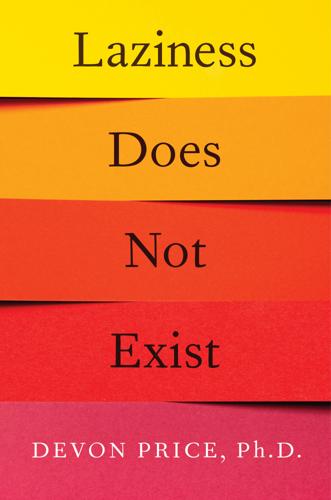
Laziness Does Not Exist
by
Devon Price
Published 5 Jan 2021
When taking Upwork’s fees and time spent finding new clients into account, Alex’s transcription job pays much less than minimum wage. But it’s better than nothing, he says, and it allows him to squeeze a few more hours of earning potential out of his day. A lot of us have turned to sites like Upwork, TaskRabbit, Uber, Lyft, Fiverr, or Grubhub in order to make supplementary income. After all, full-time jobs with benefits are rapidly becoming a thing of the past.32 The harder it gets to make a conventional, nine-to-five living, the more people have to fill their weekends, evenings, and other spare moments with moneymaking side hustles like these.
…
So many of us have been pushed over the edge. Our economy is structured around the hatred of laziness, and it has us working longer and longer hours with each passing year. Many of us don’t know how to walk away from our jobs, whether for a vacation, a sick day, or simply to relax at home at the end of a shift. Apps like Foxtrot, Upwork, TaskRabbit, and Uber beckon us to work even in our spare time and tempt us to set even more strenuous and unsustainable goals. All this intense overcommitment and overwork is ultimately self-defeating and harmful. In truth, a person can only work so much. You Can Work Only So Much Human beings are not robots; we can’t keep churning out consistent results for hours and hours.

The Man Who Broke Capitalism: How Jack Welch Gutted the Heartland and Crushed the Soul of Corporate America—and How to Undo His Legacy
by
David Gelles
Published 30 May 2022
The rise of the gig economy has allowed new multibillion-dollar companies to be built on the backs of a shadow workforce. There are millions of drivers for Uber and Lyft, hundreds of thousands of deliverymen for Instacart and Seamless, and many thousands more offering themselves up for part-time work on sites like TaskRabbit and Upwork. Some of these workers treat the jobs as side hustles, occasional gigs that provide a bit of pocket cash. But for many, gig work is a full-time occupation, only without the security of a steady paycheck, decent benefits, or an employer to hold accountable. The gig economy, which began as a way to connect people who needed an odd job done here and there with locals looking to make a little extra cash, has given rise to an entirely new kind of labor force.
…
Boone, 57 Pierson, Ed, 156 Pigou, Arthur Cecil, 167–68 Pizzagate, 160 Plank, Kevin, 182 Polaris, 77, 84–85, 107, 116 Polman, Paul, 139–40, 203–7, 211, 217, 220 Powell, Lewis, 36–37, 39 private equity firms: dealmaking by, 2, 51, 54, 57, 70, 105, 110–11, 142, 175–82, 185, 213–14 stakeholder capitalism and, 213–14 Procter & Gamble, 102, 204 profit maximization, see shareholder capitalism Pruitt, Scott, 198–99 public benefit corporations, 212–13 QAnon, 160 Qatar Airways, 130 Rather, Dan, 131 RCA: GE acquisition, 51–54, 56, 57, 95, 152, 175, 176 GE sell-off of, 51–52, 152 RCA Records, 51 Reagan, Ronald, 7, 15–16, 24, 38–39, 47, 51, 65, 95, 196 Reaganomics, 15–16, 93 Real-Life MBA, The (Welch and Welch), 131 Regan, Donald, 39 REI, 215–16 Republican Party, 12, 156–60, 196–200 Restaurant Brands International, 179 Reuters, JW as contributor, 11, 131 Ries, Eric, 139 RJR Nabisco, 57, 70 Robertson, Pat, 134 Rocheleau, Dennis, 44, 56 Rockefeller, John D., 184 Rogers, Tom, 60, 62 Rohatyn, Felix, 51, 95 Roker, Al, 135 Rose, Charlie, 131 Rubbermaid, 77 SABMiller, 178 Sanchez, Lauren, 174 Sanders, Bernie, 162–63 Sarbanes-Oxley Act (2002), 126 Saudi Aramco, 135 Saudi Basic Industries, 137 scandals inside GE, 92–93 Hudson River PCB pollution, 93, 139, 168 Justice Department subprime mortgage investigation, 165, 225 JW divorce and remarriage, 117–20, 174 Kidder Peabody trading schemes, 54–55 pension fund shortfall, 162 SEC accounting fraud suits and settlements, 126, 147–48, 225 SEC long-term-care shortfall investigation and settlement, 164–65 Schrager, James, 107 Schulman, Dan, 207–11, 220 Schwab, Klaus, 211–12 Scott, MacKenzie, 174 Scott Paper, 71 Seamless, 170 Sears, 165 Securities Act of 1933, 65 Security Capital Group, 137 September 11 terrorist attacks (2001), 7, 82, 113–15, 117, 136–37, 138, 228 Seventh Generation, 212 Shad, John, 39 shareholder capitalism: activism for, 149–52 broad acceptance of, 93–95 Business Roundtable and, 37, 93, 214, 223–24 Covid-19 pandemic and, 221–26 critiques of, 70, 72–73, 84–85, 92–97 Friedman doctrine and, 3–4, 6–7, 35–40, 93–94, 229 GE as the most valuable company on earth, 3, 4–8, 20, 34, 50–51, 58, 68, 79, 90, 113, 137, 162, 195, 226 Golden Age of Capitalism vs., 222, 229 impact in corporate America, 8–13, 175–85, 229 JW denunciation of, 151–52 in JW vision for GE, 2–3, 4–8, 20, 33–35, 52, 68, 151–52 stakeholder capitalism vs., 36, 37, 151–52, 203–20, 231 Welchism and, 8–9, see also Welchism Sharer, Kevin, 106 Sheffer, Gary, 39–40 Siegel, Marty, 54–55 60 Minutes (CBS TV program), 42, 131 Six Sigma, 101, 112–13, 127 Skilling, Jeffrey, 124 Sloan, Alfred, 25 Smith, Greg, 190 Smith, Kyle, 89 Sonnenfeld, Jeffrey, 164 Sorscher, Stan, 89 Southwest Airlines, 190 S&P Dow Jones Indices, 165 Spencer Stuart, 78 Spitzer, Eliot, 109–10, 125–26 Sprint, 169 SPX, 77, 105 stack ranking: Amazon and, 171–74 at Ford, 171 at Microsoft, 171 by 3G Capital, 179 at 3M, 112, 171 Vitality Curve at GE, 4, 44–45, 96–97, 152, 171, 172, 174 at WeWork, 171 stagflation, 18, 25, 33 stakeholder capitalism, 203–20, 231 activism and, 149–52 B Corp movement / public benefit corporations in, 212–13 at BlackRock, 213–14 Business Roundtable and, 26, 214, 222–24 at Chrysler, 216 at Delta Air Lines, 215 employee board representation, 216–17 employee compensation, 207–11, 215–16, 220 executive compensation in, 217–18, 219–20 GE as once-model corporate citizen, 4, 16, 20, 21–26, 42–43, 74, 165 long-term view in, 217–18 minimum wage and, 93, 183, 209, 215, 218, 223 nature of, 12–13 need for, 12–13 at PayPal, 207–11, 215, 220 at REI, 215–16 shareholder capitalism vs., 36, 37, 151–52, 203–20, 231 strengthening antitrust policies, 219 sustainability and good governance in, 205–7 taxation in, 23, 218–19 at Unilever, 203–7, 211, 217, 220 upskilling workers, 216 World Economic Forum and, 211–12 see also Golden Age of Capitalism Stanley, Frederick T., 80 Stanley Works, 77, 83–84, 110 Starbucks, 170 Stephanopoulos, George, 157 Stephenson, Randall, 175 Stiglitz, Joseph, 132 stock buybacks, see financialization (generally); financialization at GE stock market performance, see shareholder capitalism Stone, Roger, 196 Stonecipher, Harry, 87–90, 127, 128–29, 187, 191, 194 Stumo, Michael, 194 Stumo, Samya, 194 subprime mortgage crisis, 8, 137–38, 141–45, 148–49, 150, 165, 225 Success magazine, 91, 132 Summers, Larry, 93–94 Sunbeam Products, 71–72 Sundstrand, 87 Swope, Gerard, 22–23, 43 Symantec, 77, 105–6 Taco Bell, 170 TaskRabbit, 170 taxation: “active financing” exception, 62–63 corporate headquarters in Bermuda, 81–82 decline in U.S. corporate taxes, 63 in GE dealmaking, 51, 61, 62–63 in stakeholder capitalism, 23, 218–19 tax breaks for corporate expansion / relocations, 88–89, 173, 219 tax reduction efforts, 10, 63, 81–82, 88–89, 162, 185, 200–201 Trump and, 200–201 terrorist attacks (September 11, 2001), 7, 82, 113–15, 117, 136–37, 138, 228 Tester, Jon, 190 30 Rock (NBC TV program), 139–40 Thomson, 52, 82–84 3G Capital, 177–82, 206–7 3M, 9, 77, 107, 111–13, 127, 171 Tichy, Noel, 77 Tiller, Tom, 84–85, 107, 116 Time Warner, 175–76 Tim Hortons, 179 TiVo, 60, 62, 77 Today (NBC TV program), 117, 135, 195 Todd, Chuck, 160 “total war,” 34 Trani, John, 83–84, 110 Trump, Donald: The Apprentice (NBC TV program), 121, 134–35, 195 business advisory councils, 199–200 Charlottesville, Virginia white nationalist violence (2017), 199–200 conspiracy theories, 158, 160 JW and, 12, 59, 90–91, 121, 134–35, 158, 194–201, 221 presidency, 12, 166, 169, 188, 197–200, 214 Trump International Hotel and Tower, 7, 59, 119, 121, 195 Tungsram, 83 Tyco International, 124–25 Uber, 170, 226 Under Armour, 182 Unilever, 139–40, 203–7, 211, 217, 220 unions: at Boeing, 88, 89, 128–30 at Chrysler, 216 decline of, 46–47, 49–50 employee compensation and, 46–47, 49 JW opposition to, 11, 46–47, 132 United Auto Workers, 216 United Financial Corporation of California, 66–67 U.S.
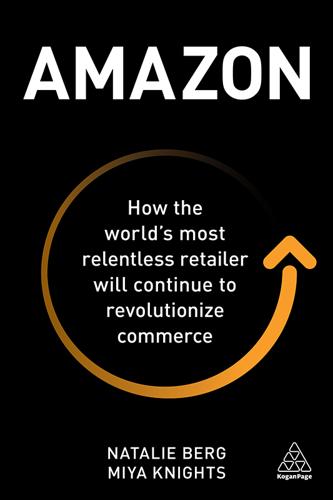
Amazon: How the World’s Most Relentless Retailer Will Continue to Revolutionize Commerce
by
Natalie Berg
and
Miya Knights
Published 28 Jan 2019
According to a study from the shopping centre group, nearly half of 25–34-year-olds are interested in renting fashion and around one-fifth would be willing to spend £200 or more per month on unlimited clothing rental subscriptions.28 Outside of fashion, electricals retailer Dixons Carphone has talked of a membership scheme where shoppers would pay for access to a washing machine, for example, including installation and repairs – but without actually owning it. In the future, it will be essential to create deeper relationships with customers as the focus shifts from product to service. This explains why a retailer like Ikea acquired TaskRabbit in 2018. The online marketplace connects 60,000 freelance ‘taskers’ with consumers looking to hire someone to do chores such as furniture assembly. Now you can buy a Stuva wardrobe without the anxiety of putting it together. Similarly, Walmart has joined forces with Handy for installation and assembly services for televisions and furniture.
…
(and) 242–45 basic principles for retailers’ co-existence with Amazon 244 regulation and legislation 243 Connected Home 46 Connell, B (CEO, Target) 226 Co-op 209 see also Italy and Deliveroo delivery service 102 Costco 46, 181, 217 Cummins, M (CEO, Pointy) 172 Darvall, M (director of marketing and communications,Whistl) 215–16 Debenhams 81, 193, 194 definition(s) of showrooming 174 webrooming 168 Dhaliwal, T (MD, Iceland) 116 Diewald, G (head of Ikea US food operations) 189 digital automation and customer experience 165–85 see also ROBO and ZMOT the digital customer experience 176–83 see also subject entry location as a proxy for relevance 170–73, 173 research online, buy offline 167–70 the store as a showroom 174–76 see also definition(s) the digital customer experience (and) 176–83 see also robots digital points of purchase 179–80 the human touch, importance of 180–81 intelligent space 177–79 from self-checkout to no checkout 182–83 Dixons Carphone (Currys PC World) 188 membership scheme for use of washing machines, etc 201 drones 238 see also JD.com Prime Air 151 Dunn, A (CEO, Bonobos, 2016) 75 East, M (former M&S executive) 116 eBay 36, 216–17 and Shutl 217 e-commerce, growth of 48 Edison, T: quoted on failure 11 end of pure-play e-commerce: Amazon’s transition to bricks and mortar retailing 62–86 Amazon makes it move 77, 80–82, 78–79, 80 clicks chasing bricks – the end of online shopping 71–77 O2O: incentives for getting physical 72–75 cost of customer acquisition 74–75 shipping costs 73–74 O2O: who and how 75–77 key drivers of convergence of physical and digital retail (and) 66–71 click, collect and return 69–70 pervasive computing: shopping without stores or screens 70–71 role of mobile: frictionless, personalized experience 67–69 role of mobile: knowledge is power 66–67 next-generation retail: quest for omnichannel 63–66 electronic shelf labels (ESLs) 177–79 The Everything Store 6, 29 see also Stone, B Facebook 45, 76 Marketplace 213 Messenger purchasing bot 179 Payments 213 Fear of Missing Out (FOMO) 55 FedEx 224–25, 229 figures Amazon operating margin by segment 19 Amazon opened first checkout-free store, Amazon Go (2018) 109 Amazon’s first-ever bricks and mortar retail concept, Amazon Books, 2015 80 the flywheel: the key to Amazon’s success 7 growing complexity of fulfilling e-commerce customer orders 211 growing importance of services: Amazon net sales by business segment 18 Market Capitalization: Select US Retailers (7 June 2018) 6 new fulfilment options driving heightened complexity in retail supply chains 210 online-only is no longer enough: Amazon acquired Whole Foods Market (2017) 108 playing the long games: Amazon sales vs profits 12 top reasons why US consumers begin their product searches on Amazon 173 France (and) 2, 113 see also Auchan and Carrefour Amazon and Fauchon and Monoprix 103 ‘click and drive’ 208 Monoprix 236 frugality 9, 122 at Amazon, Mercadona and Walmart 9 Furphy, T 94 Galloway, S (NYU professor) 14 Generation Z 54 Germany (and) 2, 35, 209, 232 Amazon and Feneberg 103 H&M ‘Take Care’ service 49 Metro 191 retailer HIT Sütterlin 180 Rossman drugstore chain 236 unions call for strikes over Amazon workers’ pay rates (2013) 229 Gilboa, D (co-founder Warby Parker) 75 Gimeno, D (Chairman, El Corte Ingles) 52 Glass, D (CEO, Walmart) 50 global shipping market, worth of 230 Goldman Sachs 13 and independent factors correlating to online grocery adoption & profitability 88 Google 1, 14, 19, 45, 66, 76, 115, 154, 179 Assistant 157, 160 Checkout 213 DeepMind 159 Express 157, 160, 217 Home 153, 157 Knowledge Panel 171, 172 Maps 172, 177 Nest heating thermostat controller 155 Play 213 Search 157 See What’s In Store (SWIS) 171–72 Shopping Actions 157 What Amazon Can’t Do (WACD) 171 and ‘zero moment of truth’ (ZMOT) 171, 172 Great Recession 48, 122 Gurr, D (Amazon UK Country Manager UK, (2018) 21, 29, 44, 64 Ham, P 94 Hamleys: Moscow store mini-theme park 196 Han, L (General Manager of International Supply Chain, JD Logistics) 235 Harkaway, N 222 Herbrich, R (Amazon, director of machine learning) 150 Herrington, D 94 Home Depot 2, 157, 172 online returns instore 70 Huang, C (founder and CEO of Boxed, 2018) 71 Ikea (and) 71 acquires TaskRabbit (2018) 202 mobile AR 175 Place app 175 India 31, 116 see also Prime Video and Walmart Amazon Stella Flex service tested in 232 Instacart 89, 112–13, 119, 157, 216, 219, 224, 236 Sprouts teamed with 103 Intel and RealSense technology for ESLs (2018) 178 intelligence software: trialled by The Hershey Company, Pepsi and Walmart 178 Internet of Things (IoT) 70, 96 Italy 16, 209 see also Carrefour Co-op’s ‘store of the future’ in 191 James, S (Boots CEO) 55 Japan (and) 2, 35 Prime Video 31 Tokyo 102 Uniqlo 175–76 JD.com (and) 182–83, 230 7fresh 112, 183 BingoBox 182 Europe–China freight train (2018) 235 Logistics 235 online retail: opening 1000 stores a day in China 63 use of drones 238 John Lewis (and) see also Nickolds, P co-working space 193 customers staying overnight 187 ‘discovery room’ 200 Jones, G (CEO, Borders) 47 Kaness, M (CEO, Modcloth) 76 Kenney, M 190 Khan, L 242, 243 Kiva Systems 94, 151, 223 see also robots Kohl’s 2, 70, 81, 193, 233 Kopalle, Professor P 151 Kroger 2, 19, 46, 114–15, 208 see also case studies HomeChef 116 ‘Scan, Bag, Go’ 214–15 smart shelf solution 178 Kwon, E (former executive Amazon fashion) 127 Ladd, B 13, 115, 219 see also case studies Landry, S (VP, Amazon Prime Now) 218 the last-mile infrastructure 222–41 see also Amazon Amazon as a carrier 231–32 fulfilment by Amazon 232–33 growing IT infrastructure 226–29 last-mile labour 223–26 race for the last mile 233–36 real estate demand 229–31 remote innovation 236–38 Leahy, Sir T 62 Lebow, V 54, 122 see also articles/papers legislation (US) and calls for legislation to be rewritten and regulation of tech giants 243 Tax Act (2017) 16 Lego 195 allows building in-store 196–97 AR kiosks in stores (2010) and X app 175 Leung, L (Prime Director) 29 Levy, H P 147 Lidl 33, 51, 122, 209 Limp, D (Amazon Digital Devices SVP) 153 Liu, R (JD.com founder/chief executive) 182 lockers/collection lockers 74, 90, 112, 209–10, 233 emmasbox (Germany) 209 Lore, M (co-founder of Quidsi; CEO Walmart domestic e-commerce operations) 76–77, 97, 224, 235, 236 loyalty schemes 32–33 Ma, J (founder, Alibaba) 63 McAllister, I (Director of Alexa International) 10, 19 McBride, B (ASOS Chairman, former Amazon UK boss) 9 Mackey, J (Whole Foods Market CEO and Co-Founder) 107, 110 McDonalds McDelivery 218 in Walmart stores 189 McMillon, D (CEO, Walmart, 2017) 87, 89, 107 Macy’s 52, 69, 71, 172, 177, 193 New York store as ‘World’s Largest Store’ 50 Mahaney, M (RBC Capital Managing Director/analyst) 14, 111 Mansell, K (Chairman, President and CEO of Kohl) 233 Marks & Spencer (M&S) 49, 81, 193, 196 delivery service partnership with Gophr 102 Marseglia, M (Director, Amazon Prime) 101 Mastandrea, M 94 Mathrani, S (CEO of GGP) 49 Mehta, A (CEO, Instacart) 113 MercadoLibre as Latin America’s answer to eBay 36 Metrick, M (president, Saks Fifth Avenue) 190 Microsoft 19, 115 Bing 173 checkout-less store concept 182 Millennials 122, 144, 157 Miller, B (Miller Value Partners) 13 Millerberg, S (managing partner, One Click Retail) 158 Misener, P (Amazon VP for Global Innovation) 10 Mochet, J P (CEO of convenience banners, Casino Group, 2018) 192 Morrisons 102, 209, 217, 236 Mothercare 195, 196 Motley Fool 15 see also Bowman, J Mountz, M 94 Mulligan, J (chief operating officer, Target) 225–26 Musk, E 194 near-field communications (NFC) technology 178–79 Newemann, A (CEO WeWork) 192 Next 188 and pizza and prosecco bars instore 190 Nickolds, P (MD, John Lewis, 2017) 64 Nike 103 selling on Amazon 127 Nordstrom, E (Co-President, Nordstrom, 2017) 45 Nordstrom 135, 193 Local (launched 2017) 199 Ocado 19, 112–15, 135 see also Clarke, P and Steiner, T and Alexa 157 deal with Casino Groupe (2017) 113 Smart Platform 113 Olsavsky, B (Amazon CFO, 2018) 124 One Click Retail 90, 123, 129, 155, 158 online to offline (O2O) 63 capabilities 216 incentives for getting physical 72–75 who and how 75–77 Ovide, S (Bloomberg) 47, 119, 154 Park, D (co-founder, Tuft & Needle) 81 PayPal 45, 137, 213–14 Peapod 87 see also Bienkowski, C and ‘Ask Peapod’ skill for Alexa 156–58 Penner, G (Walmart Chairman, 2017) 77 Perrine, A (Amazon General Manager, 2018) 29 polls see reports Price, Lord M (former Waitrose MD) 51 Prime (and) 11, 14, 20, 92, 112, 121, 137, 153, 174, 210, 215, 217, 218, 222, 227 see also Prime 2.0; Prime Air; Prime ecosystem and Prime Now AmazonFresh 34 AmazonFresh Pickup 37 Day 32, 136, 147 Fresh Add-on 237 members 2 Pantry 34, 100–101, 226, 227 Video 30–31 Wardrobe 128, 226 Prime 2.0 (and) 38–40 ‘Invent and Simplify’ Leadership Principle 143 looking to new demographics for growth 39 more bells and whistles 38 more fee hikes 40 Prime Wardrobe (2017) 38–39 Prime Air 151 development centres U~S, Austria, France, Israel 238 first autonomous drone delivery 238 Prime ecosystem: redefining loyalty for today’s modern shopper (and) 28–40 advantages for Amazon 33–35 going global 35–36, 35–36 integrating Prime at point of sale 38 Prime 2.0 38–40 see also subject entry Prime as loyalty programme?
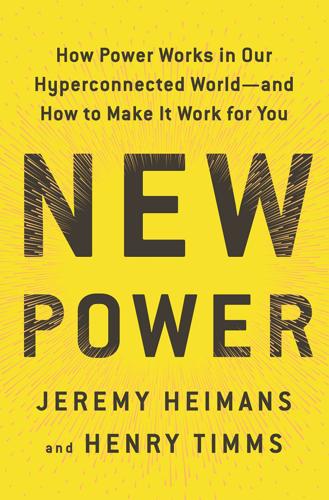
New Power: How Power Works in Our Hyperconnected World--And How to Make It Work for You
by
Jeremy Heimans
and
Henry Timms
Published 2 Apr 2018
Indeed, what is emerging—most visibly among people under thirty (now more than half the world’s population)—is a new expectation: an inalienable right to participate. The YouTube creator with her own robust set of followers approaches the world expecting to be a creator more than a consumer. A person who stitches together a living as a “producer” for TaskRabbit, Lyft, or other on-demand services may become less reliant on, and more skeptical of, traditional economic intermediaries. An employee who gets the thrill of unlimited creativity and immediate validation from her online community can find her mundane daily workplace projects, which her boss rarely comments on, especially unfulfilling.
…
If you’re a company with a large share of contingent workers (or your business model is dependent on them), the tropes of traditional HR can seem rather quaint. The standard reviews and performance development plans that worked in the old power world don’t make sense for a large, distributed, and contingent workforce. Consider a platform like TaskRabbit, for which the vast majority of workers are contingent. Such businesses rely on an initial layer of what we can think of as algorithmic management; the very design of their platforms allows them to enforce rules and create incentives for desired behavior. Customer rating systems stand in for performance reviews.

Stakeholder Capitalism: A Global Economy That Works for Progress, People and Planet
by
Klaus Schwab
Published 7 Jan 2021
One of them told us that as a Grab car driver, he earned on average four times the monthly salary of his factory days. This experience isn't unique to the Asian archipelago or merely anecdotal. Around the world, designers, drivers, handymen, and many other professionals have found new work opportunities and higher pay thanks to platform companies ranging from Upwork to TaskRabbit and Fiverr and from Didi to Grab or Lyft. In countries such as Serbia, Pakistan, or Ukraine, having the ability to enter a freelance contract with the aid of an online platform has proven a popular alternative to finding work in the traditional employment market. But in many other cases, the emergence of the gig economy has been less kind to workers.
…
See also specific country Subsidiarity principle, 181–183 Suez Canal, 103, 200 Sustainable Development Goals (UN), 189, 206, 207, 250 Swabia (Germany), 4, 8, 19, 251 Sweden COVID-19 pandemic response by, 220 stakeholder concept adopted in, 174 vote for right-wing populist parties (2000, 2017–2019), 84fig Swiss Federation, 181 Switzerland continued trust in public institutions in, 196 history of direct democracy in, 195 precious stones/metals imported to China through, 64 T Tabula rasa, 237 Taiwan, 59, 98 See also Asian Tigers Tanzania, 70 TaskRabbit (US), 237 Tata Consulting Services (TCS) [India], 68 Tata Steel (India), 141 Taxation French Yellow Vests (Gilets Jaunes) protests over, 86–87 high Danish rate of, 119 OECD's efforts to create fair global tax rules for Internet, 212 San Francisco's Proposition C proposing tax to help the homeless, 212–213 Stakeholder Capitalism Metrics prosperity pillar on, 214, 249 Teacher Corps, 135 Tech Mahindra [India], 68 Technological disruption changing business landscape, 126–129 Dansk Metal's industrial robots, 115, 117 labor market and challenge of automation, 115–126 Singapore job displacement due to, 125–126 steam engine as, 102, 116, 130–131 See also Digital economy Technological revolutions First Industrial Revolution (19th century), 56, 71, 108, 116, 119, 130–134, 135, 161 First Technological Revolution, 45fig–46 Second Industrial Revolution (1945–early 1970s), 8, 18, 45fig, 105–106, 116, 119, 134–136, 204 Third Industrial Revolution, 15, 45, 116, 137–142 Fourth Industrial Revolution, 18, 45, 68, 71, 116, 122, 125, 142–145, 161–162, 177, 186, 201, 208, 212, 213, 237, 239 Technologies artificial intelligence (AI), 143–144, 145, 161 automation, 115–126 China's “maker movement” of tech start-ups, 55 climate change and technological process, 161–162 connective, 177, 225, 227–228 cryptocurrencies, 161 Dansk Metal's industrial robots working with employees, 115 general-purpose technologies (GPTs), 143 Internet and digital connectivity, 225, 227–228, 232 Internet of Things, 18, 72, 161 Kuznets Wave on income inequality fluctuation and, 45fig–46 shaping positive vs. negative applications of, 144–145 Shenzhen (China) known for homegrown tech companies, 55, 57–61 tech unicorns of ASEAN nations, 66, 67fig workers who oppose automation, 115–116 The Technology Trap (Frey), 116, 135 Tech unicorns (ASEAN nations), 66, 67fig Tencent (US), 55, 60, 143 Tesla (US), 201 Tett, Gillian, 216 Thailand economic recession (1997) in, 97–98 predicted economic growth (2020–2021) in, 65–66 rubber exports to China, 64 Thaker, Jagadish, 223 Thatcher, Margaret, 122 Theodul Glacier, 51 Thiel, Peter, 208–209 Third Industrial Revolution, 15, 45, 116, 137–142 Thompson, Nicholas, 128 3D printing, 107, 108, 116 Thunberg, Greta, 52–53, 86, 147–150, 168, 250 ThyssenKrupp, 141 Tik Tok, 61 TIME Magazine, 172 Tindall, Stephen, 221 Tokopedia (Indonesia), 97 Total (France), 95 “Trade in the Digital Era” report (2019) [OECD], 107 Traveloka (Indonesia), 97 Treaty of Versailles (1919), 5–6 Trente Glorieuses, 110 Throwing Rocks at the Google Bus: How Growth Became the Enemy of Prosperity (Rushkoff), 210 Trust loss of trust in public institutions, 196 rebuilding of public trust in business sector, 210–212 Tsinghua University's School of Economics and Management, 225–226 Tuberculosis sanatorium treatments, 11 Twain, Mark, 133 21st century stakeholder capitalism.
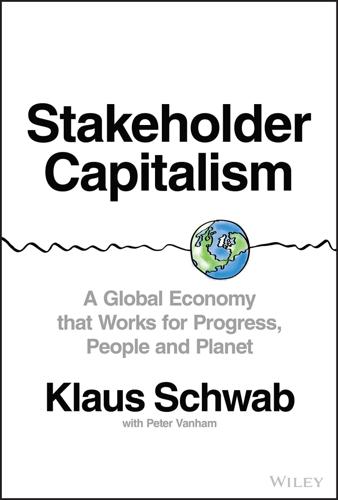
Stakeholder Capitalism: A Global Economy That Works for Progress, People and Planet
by
Klaus Schwab
and
Peter Vanham
Published 27 Jan 2021
One of them told us that as a Grab car driver, he earned on average four times the monthly salary of his factory days. This experience isn't unique to the Asian archipelago or merely anecdotal. Around the world, designers, drivers, handymen, and many other professionals have found new work opportunities and higher pay thanks to platform companies ranging from Upwork to TaskRabbit and Fiverr and from Didi to Grab or Lyft. In countries such as Serbia, Pakistan, or Ukraine, having the ability to enter a freelance contract with the aid of an online platform has proven a popular alternative to finding work in the traditional employment market. But in many other cases, the emergence of the gig economy has been less kind to workers.
…
See also specific country Subsidiarity principle, 181–183 Suez Canal, 103, 200 Sustainable Development Goals (UN), 189, 206, 207, 250 Swabia (Germany), 4, 8, 19, 251 Sweden COVID-19 pandemic response by, 220 stakeholder concept adopted in, 174 vote for right-wing populist parties (2000, 2017–2019), 84fig Swiss Federation, 181 Switzerland continued trust in public institutions in, 196 history of direct democracy in, 195 precious stones/metals imported to China through, 64 T Tabula rasa, 237 Taiwan, 59, 98 See also Asian Tigers Tanzania, 70 TaskRabbit (US), 237 Tata Consulting Services (TCS) [India], 68 Tata Steel (India), 141 Taxation French Yellow Vests (Gilets Jaunes) protests over, 86–87 high Danish rate of, 119 OECD's efforts to create fair global tax rules for Internet, 212 San Francisco's Proposition C proposing tax to help the homeless, 212–213 Stakeholder Capitalism Metrics prosperity pillar on, 214, 249 Teacher Corps, 135 Tech Mahindra [India], 68 Technological disruption changing business landscape, 126–129 Dansk Metal's industrial robots, 115, 117 labor market and challenge of automation, 115–126 Singapore job displacement due to, 125–126 steam engine as, 102, 116, 130–131 See also Digital economy Technological revolutions First Industrial Revolution (19th century), 56, 71, 108, 116, 119, 130–134, 135, 161 First Technological Revolution, 45fig–46 Second Industrial Revolution (1945–early 1970s), 8, 18, 45fig, 105–106, 116, 119, 134–136, 204 Third Industrial Revolution, 15, 45, 116, 137–142 Fourth Industrial Revolution, 18, 45, 68, 71, 116, 122, 125, 142–145, 161–162, 177, 186, 201, 208, 212, 213, 237, 239 Technologies artificial intelligence (AI), 143–144, 145, 161 automation, 115–126 China's “maker movement” of tech start-ups, 55 climate change and technological process, 161–162 connective, 177, 225, 227–228 cryptocurrencies, 161 Dansk Metal's industrial robots working with employees, 115 general-purpose technologies (GPTs), 143 Internet and digital connectivity, 225, 227–228, 232 Internet of Things, 18, 72, 161 Kuznets Wave on income inequality fluctuation and, 45fig–46 shaping positive vs. negative applications of, 144–145 Shenzhen (China) known for homegrown tech companies, 55, 57–61 tech unicorns of ASEAN nations, 66, 67fig workers who oppose automation, 115–116 The Technology Trap (Frey), 116, 135 Tech unicorns (ASEAN nations), 66, 67fig Tencent (US), 55, 60, 143 Tesla (US), 201 Tett, Gillian, 216 Thailand economic recession (1997) in, 97–98 predicted economic growth (2020–2021) in, 65–66 rubber exports to China, 64 Thaker, Jagadish, 223 Thatcher, Margaret, 122 Theodul Glacier, 51 Thiel, Peter, 208–209 Third Industrial Revolution, 15, 45, 116, 137–142 Thompson, Nicholas, 128 3D printing, 107, 108, 116 Thunberg, Greta, 52–53, 86, 147–150, 168, 250 ThyssenKrupp, 141 Tik Tok, 61 TIME Magazine, 172 Tindall, Stephen, 221 Tokopedia (Indonesia), 97 Total (France), 95 “Trade in the Digital Era” report (2019) [OECD], 107 Traveloka (Indonesia), 97 Treaty of Versailles (1919), 5–6 Trente Glorieuses, 110 Throwing Rocks at the Google Bus: How Growth Became the Enemy of Prosperity (Rushkoff), 210 Trust loss of trust in public institutions, 196 rebuilding of public trust in business sector, 210–212 Tsinghua University's School of Economics and Management, 225–226 Tuberculosis sanatorium treatments, 11 Twain, Mark, 133 21st century stakeholder capitalism.

Markets, State, and People: Economics for Public Policy
by
Diane Coyle
Published 14 Jan 2020
Many digital markets have indirect network effects. For instance, the more restaurants that list on a platform like OpenTable, the more useful it is to diners, and the more diners that use the platform, the more valuable it is to the restaurant to be listed. Other examples include Airbnb and other accommodation platforms, Craigslist, TaskRabbit, and many other familiar services and apps from everyday life. In all these cases, one person’s decision to consume affects the preferences and choices of other people. Assumption A2 (box 1.4) fails here too. Conclusion This chapter has discussed failures of the assumptions that there are no external costs or spillovers in production; and that people’s preferences and consumption choices are independent of each other.
…
See welfare economics solar energy, 86 Solow, Robert, 305 Sonny Bono Act (1998), 62 South Korea, 127, 198, 206, 326 Soviet Union, 20, 23, 281 Spain, 144 species protection, 321, 322 speed limits, 273 Spence Michael, 164 spotted owl, 322 SSNIP (small but significant non-transitory increase in price) test, 58 stabilization, as government policy, 6 standard of living, 46, 207, 208, 251 Standard Oil, 95 “state aid,” 55, 133 state capacity, 16–17, 20 stated preference (contingent valuation), 305, 318–25, 326 statistical significance, 301 steel industry, 100, 102, 103, 106, 110, 114, 116, 119–20 Stern Report, 314–15 Stigler, George, 262 strategic bias, 321 strikes, 23, 109 sugar taxes, 272 Sugden, Robert, 174 sunk costs, 105 Sunstein, Cass, 173 superstar effect, 52, 54, 227 surge pricing, 78, 79, 167 surveys, 180–81 Sweden, 30, 85, 102, 115, 217, 275, 284 Switzerland, 237, 239, 250 Sydney Opera House, 276–78 tacit knowledge, 157 target setting, 257, 281–83, 287, 289 tariffs, 263 TaskRabbit, 168 Tata (Indian conglomerate), 103, 119 taxes: on alcohol and tobacco, 19, 25, 137, 152, 228, 272; avoidance vs. evasion of, 271; behavioral motivation for, 198, 199; behavioral response to, 274; credits against, 236, 252, 287; inefficiencies created by, 252; on inheritances, 231, 232; marginal effective rate of, 234, 235, 236–37, 239; on mobile phones, 165; optimal, 229, 231; Pigouvian, 25, 26, 31, 32, 141, 165, 252; on plastic bags, 5; public goods financed by, 27, 202; redistributive, 2, 7–8, 206, 208, 213, 225, 228–29, 232; resentment of, 3, 232; user fees vs., 28, 278, 279–80; value-added, 228 tax farming, 61 taxicabs, 71, 75–80, 263 tax incentives, 101, 129–30, 131, 134 technological disruption, 71, 72, 75–82 Telecom Italia, 107 telecommunications, 56, 91, 105, 130; bundling in, 93; equipment for, 118–19; as natural monopoly, 104; privatization of, 45, 46, 114, 117, 121; regulatory capture and, 68; state-owned, 101, 109 temperance movement, 269, 271 The Ten Commandments (film), 62 terrorism, 209 Tetlock, Paul, 300 Thaler, Richard, 173 Thatcher, Margaret, 22, 23, 70, 100, 109–10, 118, 119, 256, 258 Theory of Moral Sentiments (Smith), 194 third best theorem, 14 Thomas Cook (travel agency), 110 Tinbergen, Jan, 21 Titmuss, Richard, 196 tobacco taxes, 25, 152, 228, 272 toll goods (club goods), 26, 28, 142 toll roads, 26, 29, 278 tort law, 33, 65 total surplus, 47, 48 Toulouse, France, 157 traffic management, 275, 278 tragedy of the commons, 137–42, 148, 161, 165 training, 48, 129, 134 transaction costs, 32, 34–36, 303 Treaty on the Functioning of the European Union, 56 trichloroethylene spill (1987), 320 Trump, Donald, 185 trust (social capital), 137, 138, 147, 155–59, 168–69, 211 “trust busting,” 95 Tullock, Gordon, 260–61 Turing, Alan, 107 Turkey, 116, 117 turnpike trusts, 29, 144 Tutte, Bill, 107 Tversky, Amos, 173 Uber, 78–80, 84, 93, 263 Ulvaeus, Björn, 3 unemployment, 156–57, 212, 223; crime rate linked to, 154–55; in France, 78; policies to reduce, 205, 238; during recessions, 209, 251; among youth, 65–66 unemployment insurance, 202–6, 208, 209, 233, 251 unions, 22, 35, 110, 118, 121, 220, 223 United Kingdom, 3; alcohol consumption in, 19; automatic savings plan in, 187; behavioral policy unit in, 173, 185, 192; blood donation in, 196; competition policy in, 94; contracting out in, 284; cost-benefit analysis in, 305, 313; energy in, 86, 87–88, 89; health care in, 101, 246–49, see also National Health Service (NHS); industrial policy in, 106–7, 127, 129–30; inequality in, 217, 221, 241; minimum wage in, 240; mutual societies in, 203; nationalization in, 22, 101–2; policy evaluation in, 299; poverty in, 215; privatization in, 87–88, 98, 100, 102–3, 114–22, 124–25, 258, 290; public services in, 244, 281, 282–83, 290; road system in, 29, 292–93; taxation in, 198, 228, 232, 236, 252, 272; Universal Credit in, 234; value of a statistical life in, 326; welfare state in, 99; Winter of Discontent (1978–79) in, 23, 109 United States: automatic savings plan in, 185, 187; behavioral policy unit in, 173, 185; blood donation in, 196; competition policy in, 94–95; computer industry in, 107–8; contracting out in, 284, 285; cost-benefit analysis in, 305, 313; farm subsidies in, 267, 268; fracking in, 86; health care in, 210, 249–51; individualism in, 250, 251; industrial policy in, 125, 126–27, 131; inequality in, 217, 219, 223–24, 240, 242; labor force trends in, 221, 222; lobbying in, 265; municipal corporations in, 144; obesity in, 198; policy appraisal in, 300; power blackouts in, 85; social security in, 203; taxation in, 228, 232, 235, 236, 237; value of a statistical life in, 326; vouchers in, 287 U.S.
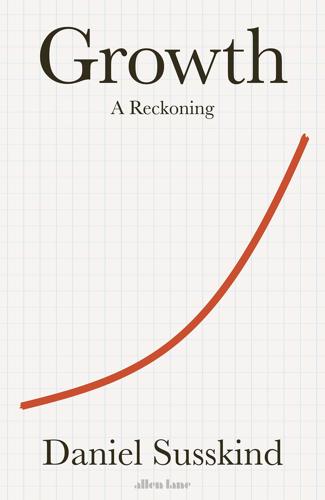
Growth: A Reckoning
by
Daniel Susskind
Published 16 Apr 2024
It is often said that new technologies now allow people to work more flexibly than ever before. Again, that might be true for some, but for many others modern working life is becoming more insecure and unstable – particularly for those searching for work in the gig economy, relying on fickle new tech platforms such as Uber and Taskrabbit. Then there are related concerns about how new technologies are being used and misused in the workplace itself to surreptitiously watch over workers. A 2018 survey found that ‘half of large companies use some type of monitoring techniques to keep tabs on their employees’ – reading emails and scanning social media, reviewing browsing history and recording CCTV footage, tracking movements through geolocation software and capturing worker attentiveness on webcams.
…
It tells us nothing about whether it matters that communal norms of reciprocity and goodwill – helping a friend put together a fiddly Ikea chair, buying groceries nearby to support a local shop, watering a neighbour’s garden while they are away – are replaced with market norms of self-interest on online gig platforms like Taskrabbit, Thumbtack and Gorillas. And it tells us nothing about the disruptive impact of powerful new technologies on work and politics, the ways in which they transform some of the most important aspects of our lives – what we do for a living and how we shape our collective future together – for better or worse.37 The point, again, is not a technical one, but a moral one: GDP fails to capture something about what we think is valuable and what we want to achieve.
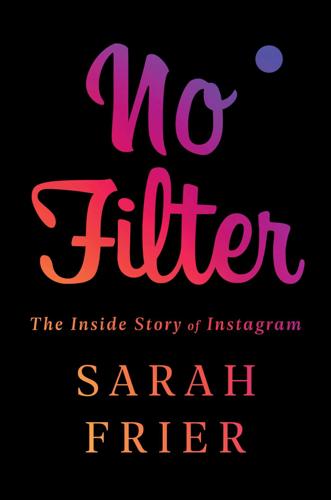
No Filter: The Inside Story of Instagram
by
Sarah Frier
Published 13 Apr 2020
Before throwing it all away, Krieger argued, perhaps they should try to improve it. So they did, building an iPhone app version. The cofounders graduated out of their meetings at local coffee shops and into a rickety coworking space called Dogpatch Labs, on a pier near San Francisco’s ballpark, where the other small startups included Threadsy, TaskRabbit, and Automattic, the maker of WordPress. It was a strange, drafty place, producing a cacophony of distracting sounds: screeching seagulls and barking sea lions, but mostly the sound of other young people being creative and sometimes unproductive, emboldened by Red Bull and alcohol. On the ceiling, an enormous ship wheel hovered in a display of nautical kitsch but also danger, as it could fall in an earthquake.
…
G., 34, 36 Silicon Valley, 3, 4, 6, 8, 9, 15, 38, 44, 52, 56, 74, 172, 231, 284 apps race in, 10 buzzwords in, 18 and FB’s acquisition of IG, 59, 61 mobile revolution in, 27 salaries in, 71 startup success rate in, 29 talent wars in, 88 Simo, Fidji, 176, 254–55 Simple Life, The (reality TV show), 136 simplicity, Systrom and Krieger’s philosophy based on, 18, 20, 21–22, 24, 119, 255 Skinny Confidential, 237 Smalls, Joan, 156 Snapchat, 122, 123, 124, 157, 171, 187, 198, 199–200, 217, 218, 223, 248, 277 celebrities’ use of, 192, 204 cool factor of, 116 ephemeral content on, 112–13, 114, 117, 216 founder of, see Spiegel, Evan growth rate of, 216 IPO of, 227 reverse chronological order of posts on, 117 teens’ use of, 183 as threat to IG, 123, 178, 181, 184, 192–93, 201, 223, 227 Zuckerberg’s attempts to buy, 114–15, 116, 117, 122, 125, 183, 191, 200–201 Snapchat Stories, 117, 122, 123, 191, 214 ephemeral content of, 185 IG’s copying of, see Instagram Stories Systrom and, 188, 190, 192, 202–3, 217 teens’ use of, 183 Snap Inc., 227 Snoop Dogg, 4, 71, 98, 138 early IG account of, 35–36 Socialcam, 109 social media as amplifier of issues, 278 as both reflection and modifier of user behavior, 233, 234–35 bullying on, 40, 41, 135, 161, 163, 218–19, 248 FB’s dominance of, 88, 121, 124, 151, 209 user passivity on, 234 see also news media social media companies, xvii, 109–10, 203, 232 see also specific companies Social Network, The (film), 15, 67, 107 social networks, 88 follower-based vs. friend-based, 20, 80 interest-based, 20, 21, 210 virality and, see virality Sony, 167 South by Southwest technology conference, 55 #sp, 236 Spacey, Kevin, 152 Spain, IG in, 226 spam, 80, 226, 260 Spectra photo filter, 23 Spiegel, Evan, 112–14, 115–16, 123, 179, 191, 194, 195, 199–200 Zuckerberg and, 116–17, 200, 201–2 see also Snapchat; Snapchat Stories Spotify, 45 Square, 15, 46, 65 Squires, Jim, 120 Stanford Mayfield Fellows Program, 5, 12, 46 Stanford University, 1, 2, 10, 11, 12, 20, 24, 47, 173 Starbucks, IG account of, 35 startups, xx, 14 see also specific startups State of the Union address (2012), 47 status updates, 1, 12, 15 Stein, Robby, 194, 201 storytelling, xviii @strawburry17, 171 Streep, Meryl, 152 Stretch, Colin, 225 Stuart Weitzman, xix Styles, Harry, 130, 133 suicide, suicidal content, 40, 41, 42, 270, 277–78 Sun, Fei Fei, 156 Sutro photo filter, 23 Swain, David, 154 Swank, Hilary, 192 Sweeney, Shayne, 32, 37, 53, 71, 75–76, 79 Swift, Taylor, 47, 131, 204, 217, 218–19, 231 Syracuse University, 232 Systrom, Diane, 3 Systrom, Doug, 3–4 Systrom, Kate, 3, 192 Systrom, Kevin, xxii, 31, 69–70, 94–95, 123–25, 146, 153, 159–60, 180, 193, 225, 245, 260, 261, 277 at Academy Awards, 191–92, 204 analytics and, 226–27 art history and Renaissance as interests of, 3, 106 celebrities’ relationships with, 46, 133–34 childhood of, 3–4 Clinton and, 207–8 competitiveness of, 107–8 Cox and, 257, 267–68, 272 cycling by, 185, 186, 205–6 deejaying by, 4, 10 disillusioned with FB’s grow-at-all-costs culture, xvii Dorsey and, 6–7, 15–16, 19, 60, 84 early mobile websites built by, 9–10; see also Burbn early prediction of IG success by, 29 in effort to preserve IG’s brand, 159–60, 176, 177–78, 184–85, 209, 217–20 in Florence, 3, 4–5, 19, 21 and FTC investigation of IG sale to FB, 75, 76 at Google, 8–9, 23, 37, 58, 62, 194 IG founded by, see Instagram IG posts by, 31 IG sold to Facebook by Krieger and, see Facebook, Instagram acquired by IGTV and, 257, 264, 265–66, 267 in increasing conflict with FB, 214, 249, 252–53, 262–63, 268–69 Krieger’s relationship with, 11–12, 13, 16–17, 22–23, 33, 107, 254 Kutcher’s friendship with, 46, 133 leadership philosophy of, 18 at Middlesex boarding school, 134 Monday leadership meetings of, 107 at Nextstop, 9–10, 11 at Odeo, 5–6, 7, 12 1 million followers of, 187 perjury allegations against, 86, 98–99 photography passion of, 2, 4–5 Pope Francis’s meeting with, 195–96 Porch and, 130–31, 132–33, 135, 147–48, 166, 195, 245 post-IG, 277 as pressured by Zuckerberg to build IG’s business model, 163–65, 167 problem solving by, 18, 32 as public face of IG, 33 re-sharing disallowed by, 140 in resignation from IG, xxii, 272–75 similar background of Zuckerberg and, 106–7 simplicity valued by, 18, 20, 21, 24, 27, 45, 54, 102, 119, 160, 180, 189, 191, 199, 205 Snapchat and, 188, 190, 192, 202–3, 217 at Stanford University, 7, 8, 24 Stories opposed by, 190, 191 study abroad of, 3–5 on Tim Ferriss Show, 87 #trashcangate and, 181–82 well-being initiative of, 249 Zuckerberg’s 2005 meeting with, 1–3 Zuckerberg’s relationship with, 7, 38, 95, 104–5, 107–8, 163–64, 216–17, 251, 252–53, 256, 262, 264, 266–68, 269–70 tagging friends, 7, 90 tagging photos, 95 TaskRabbit, 17 tastemaking, tastemakers, xviii, xxi, 144, 237 see also influencers Tatum, Channing, 149–50 Tatum, Everly, 149 #taylorswiftisasnake, 218 #tbt, 155 TechCrunch, 34, 35, 36 technology industry, 28 teens, 243 on FB, 117, 184 finsta accounts of, 182–83, 184 on IG, 118, 170 IG’s analytic tools used by, 275–76 IG Stories and, 203 as key to the future of IG, 154, 171, 184 and pressure to post the best, 114, 170, 172, 188–90, 248 Snapchat and, 115 technology use by, 114 unspoken social rules among, 182, 184 Zuckerberg’s resolve to better understand, 116 Teigen, Chrissy, 243 Telegram, 246 terrorism, terrorists, 249, 261 Tesla, 22 That ‘70s Show, 44 TheFacebook.com, 1, 7 growth of, 2 see also Facebook @thefatjewish, xx @theskinnyconfidential, 237 Thiel, Peter, 191, 193 #thinspiration, 41 This American Life (NPR show), 188 Threadsy, 17 Thrive Capital, 66, 70 Throwback Thursday, 155 TikTok, 277 Timberlake, Justin, 203, 204 Time, 38–39 Tim Ferris Show, 87 Tinder, 19 TMZ, 136 Toffey, Dan, 52, 53, 73, 141, 143 Totti Candy Factory, 242 Toy Story (film), 180 Transocean Ltd., 113 #trashcangate, 181–82, 204 travel, IG’s influence on, 169, 241, 242 Trigger, Kaitlyn, 79 trolls, internet, 41, 219, 251 Trump, Donald, 207, 208, 210, 211, 224, 258 FB leveraged by, 212–13 Trump, Ivanka, 70 Trump International Hotel, 70 Tumblr, 19, 103, 170 Tuna (dog), 141–42, 153 Tuna Melts My Heart (Dasher), 142 24 Hour Photo, 117 Twitter, xviii, xxi, 9, 17, 19, 31, 39, 130, 137, 151, 160, 170, 192, 225, 232, 239, 248 Academy Awards and, 151, 204 in attempt to buy IG, 25, 46, 48–49, 55–56, 86, 109 Benchmark Capital investment in, 36 chronological order of posts on, 19, 117 content policing and, 43 Dorsey at, 14, 25–26, 46–47 early investors in, 23 fake news on, 225 as follower-based network, 20 founders’ discord at, 14 free speech ethos at, 37, 156–57 growth rate of, 216 IG blocked from access to, 84, 99 IG photo sharing to, 37 IPO of, 98, 148, 149, 150–51 Niche acquired by, 165 Obama’s account on, 126 140–character limit of, 110, 128 Periscope acquired by, 64 retweet button of, 20, 44, 152, 157, 234 status updates at, 15 #tweetups and, 34 as unwilling to edit content, 220 user anonymity on, 41 verification on, 132 Vine acquired by, 64, 109, 157 Williams at, 14, 46 Zuckerberg’s attempted purchase of, 57 Twttr, 7 Tycho (Scott Hansen), 34 Tyga, 238 U2, 126 Uber, 36, 45, 222 UberCab, 23 Underwood, Teddy, 120–21 “unicorns,” 61 Van Damme, Tim, 51–54, 73 Vanity Fair, 158, 192 #vanlife, 229 venture capitalists, 2–3, 11, 15, 24, 36–37, 55, 56, 109, 116, 191 Vergara, Sofia, 236 Verge, 216 verification, 231–32, 279 as status symbol, 132–33 Verrilli, Jessica, 46 VidCon, 219 Viddy, 109 Vine, 64, 109–10, 111–12, 122, 124, 157, 165, 171, 265 violence, violent content, 40, 41–42, 97, 223, 249, 261 virality: of fake news, 225 on FB, 162, 209, 211, 215, 251, 260 re-sharing and, 20, 43–44, 140, 152, 210 risky behavior and, 240, 243–45 sharing and, 140, 152 social networking and, 44 on Twitter, 151, 239 Vogue, 118, 195, 231 IG-related cover of, 156, 157 VPN (virtual private network), 122 Wall Street, 74, 102, 150, 151, 164, 266, 267 Wall Street Journal, 102, 118, 122 Warner Bros.

Exponential: How Accelerating Technology Is Leaving Us Behind and What to Do About It
by
Azeem Azhar
Published 6 Sep 2021
And if the internet got the trend started, the smartphone helped it take off. The phone became omnipresent. In-built GPS meant that phones always knew where they were – and allowing crowdsourcing platforms to offer up local, highly convenient services. Soon we could order taxis, takeaway food and massages from the comfort of our couches. TaskRabbit, now owned by furniture giant Ikea, will today dispatch someone to help you assemble your new bookcase. Talkspace will help you find a therapist. Wag! will find a walker for your dog. In time, the term ‘crowdsourcing’ – which often referred to unpaid, non-commercial work – gave way to a new term: the ‘gig economy’.
…
Abu Dhabi, UAE, 250 Acemoglu, Daron, 139 Acorn Computers, 16, 21 Ada Lovelace Institute, 8 additive manufacturing, 43–4, 46, 48, 88, 166, 169, 175–9 Adidas, 176 advertising, 94, 112–13, 116, 117, 227–8 AdWords, 227 aeroponics, 171 Afghanistan, 38, 205 Africa, 177–8, 182–3 Aftenposten, 216 Age of Spiritual Machines, The (Kurzweil), 77 agglomeration, 181 Air Jordan sneakers, 102 Airbnb, 102, 188 aircraft, 49–50 Alexandria, Egypt, 180 AlexNet, 33 Algeciras, HMM 61 Alibaba, 48, 102, 108, 111, 122 Alipay, 111 Allen, Robert, 80 Alphabet, 65, 113–14, 131, 163 aluminium, 170 Amazon, 65, 67–8, 94, 104, 108, 112, 122, 135–6 Alexa, 25, 117 automation, 135–6, 137, 139, 154 collective bargaining and, 163 Covid-19 pandemic (2020–21), 135–6 drone sales, 206 Ecobee and, 117 Go stores, 136 Kiva Systems acquisition (2012), 136 management, 154 Mechanical Turk, 142–3, 144, 145 monopoly, 115, 117, 122 Prime, 136, 154 R&D, 67–8, 113 Ami Pro, 99 Amiga, 16 Anarkali, Lahore, 102 anchoring bias, 74 Android, 85, 94, 117, 120 Angola, 186 Ant Brain, 111 Ant Financial, 111–12 antitrust laws, 114, 119–20 Apache HTTP Server, 242 Appelbaum, Binyamin, 63 Apple, 47, 62, 65, 85, 94, 104, 108, 112, 122 App Store, 105, 112, 115 chip production, 113 Covid-19 pandemic (2019–21), 222–3 data collection, 228 iOS, 85 iPhone, 47, 62, 85, 94, 105 media subscription, 112 watches, 112 APT33 hacker group, 198 Aral, Sinan, 238 Aramco, 108, 198 Armenia, 206–7 Arthur, William Brian, 110, 123 artificial intelligence, 4, 8, 31–4, 54, 88, 113, 249 academic brain drain, 118 automation, 125–42 data and, 31–2, 142 data network effect, 106–7 drone technology and, 208, 214 education and, 88 employment and, 126–7 healthcare and, 88, 103 job interviews and, 153 regulation of, 187, 188 arXiv, 59 Asana, 151 Asian Development Bank, 193 Aslam, Yaseen, 148 Assembly Bill 5 (California, 2019), 148 asymmetric conflict, 206 AT&T, 76, 100 Atari, 16 attack surfaces, 192–3, 196, 209, 210 Aurora, 141 Australia, 102, 197 automation, 125–42 autonomous weapons, 208, 214 Azerbaijan, 173, 206–7 Ballmer, Steve, 85 Bangladesh, 175 banking, 122, 237 Barcelona, Catalonia, 188 Barlow, John Perry, 184 Barrons, Richard, 195, 211 Bartlett, Albert, 73 batteries, 40, 51, 53–4, 250, 251 Battle of the Overpass (1937), 162 Bayraktar TB2 drone, 206 Bee Gees, 72 Bekar, Clifford, 45 Bell Labs, 18 Bell Telephone Company, 100 Benioff, Marc, 108–9 Bentham, Jeremy, 152 Berlin Wall, fall of (1989), 4 Bermuda, 119 Berners-Lee, Timothy, 55, 100, 160, 239 Bessen, James, 46 Bezos, Jeffrey, 135–6 BGI, 41 Biden, Joseph, 225 Bing, 107 biological weapons, 207, 213 biology, 10, 39, 40–42, 44, 46 genome sequencing, 40–41, 90, 229, 234, 245–7, 250, 252 synthetic biology, 42, 46, 69, 174, 245, 250 biopolymers, 42 bits, 18 Black Death (1346–53), 12 BlackBerry, 120 Blair, Tony, 81 Bletchley Park, Buckinghamshire, 22 blitzscaling, 110 Blockbuster, 138 BMW, 177 Boeing, 51, 236 Bol.com, 103 Bollywood, 181 Boole, George, 18 Bork, Robert, 114–15, 117, 119 Bosworth, Andrew, 233 Boyer, Pascal, 75 Boyle, James, 234 BP, 92, 158 brain, 77 Braudel, Fernand, 75 Brave, 242 Brazil, 202 Bremmer, Ian, 187 Bretton Woods Conference (1944), 87 Brexit (2016–20), 6, 168 British Broadcasting Corporation (BBC), 87, 129, 191 Brookings Institution, 130 BT, 123 Bulgaria, 145 Bundy, Willard Legrand, 149 Busan, South Korea, 56 business, 82, 92–124 diminishing returns to scale, 93, 108 economic dynamism and, 117 economies of scale, 50, 92 growth, 110–13 increasing returns to scale, 108–10 intangible economy, 104–7, 118, 156, 175, 180 linear value chains, 101 market share, 93–6, 111 monopolies, 10, 71, 94, 95, 114–24 network effect, 96–101 platform model, 101–3, 219 re-localisation, 11, 166–79, 187, 252, 255 state-sized companies, 11, 67 superstar companies, 10, 94–6 supply chains, 61–2, 166–7, 169, 175, 187, 252, 255 taxation of, 96, 118–19 Butler, Nick, 179 ByteDance, 28 C40 initiative, 189 Cambridge University, 127, 188 cancer, 57–8, 127 Capitol building storming (2021), 225 car industry, 93 carbon emissions, 35, 90, 251 Carlaw, Kenneth, 45 Carnegie, Andrew, 112 Carnegie Mellon University, 131 Catholic Church, 83, 88 censorship, 216–17, 224–6, 236 Central Intelligence Agency (CIA), 194 Cerebras, 34 cervical smears, 57–8 chemical weapons, 207, 213 Chen, Brian, 228 chewing gum, 78 Chicago Pile-1 reactor, 64 Chile, 170 China automation in, 127, 137 brainwave reading in, 152 Covid-19 pandemic (2019–21), 245 drone technology in, 207 Great Firewall, 186, 201 Greater Bay Area, 182 horizontal expansion in, 111–12 manufacturing in, 176 misinformation campaigns, 203 raw materials, demand for, 178 Singles’ Day, 48 social credit systems, 230 superstar companies in, 95 US, relations with, 166 chips, 19–22, 28–9, 48–9, 52, 113, 251 Christchurch massacre (2019), 236 Christensen, Clayton, 24 CIPD, 153 cities, 11, 75, 169, 179–84, 188, 255 Clegg, Nick, 225–6, 235 climate change, 90, 169, 187, 189, 251, 252 cloud computing, 85, 112 Cloudflare, 200 cluster bombs, 213 CNN, 185, 190 coal, 40, 65, 172 Coase, Ronald, 92 Coca-Cola, 93 code is law, 220–22, 235 cold fusion, 113–14 Cold War (1947–91), 194, 212, 213 collective bargaining, 147, 149, 154, 156, 162–5 Colombia, 145 colonialism, 167 Columbus, Christopher, 4 combination, 53–7 Comical Ali, 201 commons, 234–5, 241–3, 256 companies, see business comparative advantage, 170 complex systems, 2 compounding, 22–3, 28 CompuServe, 100 computing, 4, 10, 15–36, 44, 46, 249 artificial intelligence, 4, 8, 31–4, 54, 88 cloud computing, 85, 112 internet, 47–8, 55, 65, 84 Law of Accelerating Returns, 30–31, 33, 35 machining, 43 Moore’s Law, see Moore’s Law quantum computing, 35 transistors, 18–22, 28–9, 48–9, 52 conflict, 87, 189, 190–215 attack surfaces, 192–3, 196, 209, 210 cyberattacks, 11, 114, 140, 181, 187, 190–200, 209–14, 256 de-escalation, 212–13 drone technology, 11, 192, 204–9, 214, 256 institutional change and, 87 misinformation, 11, 191, 192, 200–204, 209, 212, 217, 225 new wars, 194 non-proliferation, 213–14 re-localisation and, 189, 193, 194, 209 consent of the networked, 223 Costco, 67 Coursera, 58 Covid-19 pandemic (2019–21), 12–13, 59, 78–9, 131, 245–9 automation and, 127, 135, 136 cities and, 183 contact-tracing apps, 222–3 gig economy and, 146 lockdowns, 12, 152, 176, 183, 246 manufacturing and, 176 misinformation and, 202–4, 247–8 preprint servers and, 60 recession (2020–21), 178 remote working and, 146, 151, 153 supply chains and, 169, 246 vaccines, 12, 202, 211, 245–7 workplace cultures and, 151, 152 cranks, 54 credit ratings, 162, 229 critical thinking skills, 212 Croatia, 145 Crocker, David, 55 crowdsourcing, 143–4 Cuba, 203 Cuban missile crisis (1962), 99, 212 cultural lag, 85 cyberattacks, 11, 114, 140, 181, 187, 190–200, 209–14, 256 CyberPeace Institute, 214 Daniel, Simon, 173–4 Dar es Salaam, Tanzania, 183 Darktrace, 197 data, 8, 11, 71, 217–19, 226–31, 235, 237–42, 256 AI and, 8, 32, 33, 58, 106 compensation for, 239 commons, 242 cyberattacks and, 196 doppelgängers, 219, 226, 228, 239 interoperability and, 237–9 network effects, 106–7, 111 protection laws, 186, 226 rights, 240 Daugherty, Paul, 141 DDT (dichlorodiphenyltrichloroe thane), 253 death benefits, 151 Dediu, Horace, 24, 30 deep learning, 32–4, 54, 58, 127 deforestation, 251 dehumanisation, 71, 154, 158 deindustrialisation, 168 Deliveroo, 154, 163 Delphi, 100 dematerialised techniques, 166, 175 Denmark, 58, 160, 199–200, 257 Deutsche Bank, 130 Diamandis, Peter, 5 Dickens, Charles, 80 digital cameras, 83–4 Digital Geneva Convention, 211 Digital Markets Act (EU, 2020), 122 digital minilateralism, 188 Digital Nations group, 188 Digital Services Act (EU, 2020), 123 diminishing returns, 93, 108 disinformation, see misinformation DoorDash, 147, 148, 248 dot-com bubble (1995–2000), 8, 108, 150 Double Irish tax loophole, 119 DoubleClick, 117 drone technology, 11, 192, 204–9, 214, 256 Dubai, UAE, 43 Duke University, 234 dystopia, 208, 230, 253 Eagan, Nicole, 197 eBay, 98, 121 Ecobee, 120 economies of scale, 50, 92 Economist, The, 8, 65, 119, 183, 239 economists, 63 Edelman, 3 education artificial intelligence and, 88 media literacy, 211–12 Egypt, 145, 186 Elance, 144 electric cars, 51, 69, 75, 173–4, 177, 250 electricity, 26, 45, 46, 54, 157, 249–50 see also energy Electronic Frontier Foundation, 184 email, 6, 55 embodied institutions, 82 employment, 10, 71, 125–65 automation, 125–42 collective bargaining, 147, 149, 154, 156, 162–5 dehumanisation and, 71, 154, 158 flexicurity, 160–61, 257 gig economy, 10, 71, 142–9, 153, 162, 164, 239, 252, 255 income inequality, 155–8, 161, 168 lump of labour fallacy, 139 management, 149–54, 158–9 protections, 85–6, 147–9 reskilling, 159–60 universal basic income (UBI), 160, 189 Enclosure, 234–5, 241 energy, 11, 37–8, 39–40, 44, 46, 172–4, 250 cold fusion, 113–14 fossil fuels, 40, 159, 172, 250 gravitational potential, 53 solar power, 37–8, 53, 65, 77, 82, 90, 171, 172, 173, 249, 250, 251 storage, 40, 53, 114, 173–4, 250, 251 wind power, 39–40, 52 Energy Vault, 53–4, 173 Engels, Friedrich, 81 Engels’ pause, 80, 81 environmental movement, 73 Epic Games, 116 estate agents, 100 Estonia, 188, 190–91, 200, 211 Etzion Airbase, Sinai Peninsula, 195 European Commission, 116, 122, 123 European Space Agency, 56 European Union, 6, 82, 147, 186, 226 Excel, 99 exogeny, 2 exponential gap, 9, 10, 67–91, 70, 89, 253 cyber security and, 193 institutions and, 9, 10, 79–88, 90 mathematical understanding and, 71–5 predictions and, 75–9 price declines and, 68–9 superstar companies and, 10, 94–124 exponential growth bias, 73 Exponential View, 8–9 externalities, 97 extremism, 232–4 ExxonMobil, 65, 92 Facebook, 27, 28, 65, 94, 104, 108, 122, 216–17, 218, 219, 221–2, 223 advertising business, 94, 228 censorship on, 216–17, 224–6, 236 collective bargaining and, 164 data collection on, 228, 239–40 extremism and, 233–4 Instagram acquisition (2012), 117, 120 integrity teams, 234 interoperability, 237–8 Kenosha unrest shooting (2020), 224 misinformation on, 201, 225 network effect and, 98, 223 Oculus acquisition (2014), 117 pay at, 156–7 Phan photo controversy (2016), 216–17, 224, 225 platform model, 101 polarisation and, 233 relationship status on, 221–2 Rohingya ethnic cleansing (2018), 224, 225 US presidential election (2016), 217 WhatsApp acquisition (2014), 117 facial recognition, 152, 208 Factory Act (UK, 1833), 81 Fairchild Semiconductor, 19, 21 fake news, 201–4 family dinners, 86 farming, 170–72, 251 Farrar, James, 148 fax machines, 97 Federal Aviation Administration (US), 236 feedback loops, 3, 13 fertilizers, 35, 90 5G, 203 Financial Conduct Authority, 122 Financial Times, 183 Finland, 160, 211–12 Fitbit, 158 Fiverr, 144 flashing of headlights, 83 flexicurity, 160, 257 flints, 42 flywheels, 54 Ford, 54, 92, 162 Ford, Gerald, 114 Ford, Henry, 54, 162 Ford, Martin, 125 Fortnite, 116 fossil fuels, 40, 159, 172 France, 100, 138, 139, 147, 163 free-market economics, 63–4 freelance work, 10, 71, 142–9 Frey, Carl, 129, 134, 141 Friedman, Milton, 63–4, 241 Friedman, Thomas, 167 FriendFeed, 238 Friendster, 26 Fudan University, 245 fund management, 132 Galilei, Galileo, 83 gaming, 86 Gates, Bill, 17, 25, 84 gender, 6 General Agreement on Tariffs and Trade, 87 General Data Protection Regulation (GDPR), 226 General Electric, 52 General Motors, 92, 125, 130 general purpose technologies, 10, 45–8 generative adversarial networks (GANs), 58 Geneva Conventions, 193, 199, 209 Genghis Khan, 44 GEnie, 100 genome sequencing, 40–41, 90, 229, 234, 245–7, 250, 252 Germany, 75, 134, 147 Giddens, Anthony, 82 gig economy, 10, 71, 142–9, 153, 162, 164, 239, 252, 255 Gilbreth, Lillian, 150 Ginsparg, Paul, 59 GitHub, 58, 60 GlaxoSmithKline, 229–30 global financial crisis (2007–9), 168 Global Hawk drones, 206 global positioning systems (GPS), 197 globalisation, 11, 62, 64, 156, 166, 167–71, 177, 179, 187, 193 internet and, 185 conflict and, 189, 193, 194 Glocer, Thomas, 56 Go (game), 132 GOAT, 102 Gojek, 103 Golden Triangle, 170 Goldman Sachs, 151 Goodfellow, Ian, 58 Google, 5, 35, 36, 94, 98, 104, 108, 115, 122 advertising business, 94, 112–13, 116, 117, 227 Android, 85, 94, 117, 120 chip production, 113 Covid-19 pandemic (2019–21), 222–3 data network effect, 106–7 death benefits, 151 Double Irish tax loophole, 119 Maps, 113 quantum computing, 35 R&D, 114, 118 vertical integration, 112–13, 116 X, 114 YouTube acquisition (2006), 112, 117 Gopher, 59, 100 GPT-3, 33 Graeber, David, 133–4 Grand Bazaar, Istanbul, 102 Graphcore, 34, 35 graphics chips, 34 Grateful Dead, The, 184 gravitational potential energy, 53 gravity bombs, 195 Greater Bay Area, China, 182 Greenberg, Andy, 199 Gross, Bill, 53 Grove, Andrew, 17 GRU (Glavnoje Razvedyvatel’noje Upravlenije), 199 Guangzhou, Guangdong, 182 Guardian, 8, 125, 154, 226, 227 Guiyang, Guizhou, 166 H1N1 virus, 75 Habermas, Jürgen, 218 Hard Times (Dickens), 80 Hardin, Garrett, 241 Harop drones, 207–8 Harpy drones, 207–8 Harvard University, 150, 218, 220, 221, 253 healthcare artificial intelligence and, 57–8, 88, 103 data and, 230, 239, 250–51 wearable devices and, 158, 251 Helsinki, Finland, 160 Herlev Hospital, Denmark, 58 Hinton, Geoffrey, 32, 126–7 HIPA Act (US, 1996), 230 Hitachi, 152 Hobbes, Thomas, 210 Hoffman, Josh, 174 Hoffman, Reid, 110, 111 Holmes, Edward, 245 homophily, 231–4 Hong Kong, 182 horizontal expansion, 111–12, 218 Houston Islam protests (2016), 203 Houthis, 206 Howe, Jeff, 143 Hsinchu, Taiwan, 181 Hughes, Chris, 217 Hull, Charles, 43 Human + Machine (Daugherty), 141 human brain, 77 human genome, 40–41, 90, 229, 234, 250 human resources, 150 Hussein, Saddam, 195 Hyaline, 174 hydroponics, 171 hyperinflation, 75 IBM, 17, 21, 47, 98 IDC, 219 Ideal-X, 61 Ikea, 144 Illumina, 41 Ilves, Toomas Hendrik, 190 ImageNet, 32 immigration, 139, 168, 183–4 Impossible Foods, 69 Improv, 99 income inequality, 155–8, 161, 168 India, 103, 145, 181, 186, 224, 253, 254 Indonesia, 103 Industrial Revolution (1760–1840), 79–81, 157, 235 informational networks, 59–60 ING, 178 innovation, 14, 117 Innovator’s Dilemma, The (Christensen), 24 Instagram, 84, 117, 120, 121, 237 institutions, 9, 10, 79–88, 90–91 path dependence, 86–7 punctuated equilibrium, 87–8 intangible economy, 104–7, 118, 156, 175, 180 integrated circuits, 19 Intel, 16–17, 19, 163 intellectual property law, 82 Intermediate-Range Nuclear Forces Treaty (1987), 237 International Alliance of App-Based Transport Workers, 164 International Court of Justice, 224 International Criminal Court, 208 International Energy Agency, 77, 82 International Labour Organization, 131 International Monetary Fund (IMF), 87, 167, 187 international organisations, 82 International Organization for Standardization, 55, 61 International Rescue Committee, 184 International Telecommunication Union, 55 internet, 7, 47–8, 55, 65, 72, 75, 84–5, 88, 115, 184–6 code is law, 220–22, 235 data and, 11, 32, 71 informational networks, 59–60 localisation, 185–6 lockdowns and, 12 network effect, 100–101 online shopping, 48, 61, 62, 75, 94, 102, 135 platform model and, 102 public sphere and, 223 standardisation, 55 Wi-Fi, 151 interoperability, 55, 120–22, 237–9, 241, 243, 256–7 iPhone, 47, 62, 85, 94, 115, 175 Iran, 186, 196, 198, 203, 206 Iraq, 195–6, 201, 209 Ireland, 57–8, 119 Islamic State, 194, 233 Israel, 37, 188, 195–6, 198, 206, 207–8 Istanbul, Turkey, 102 Jacobs, Jane, 182 Japan, 37, 152, 171, 174 Jasanoff, Sheila, 253 JD.com, 137 Jena, Rajesh, 127 Jio, 103 job interviews, 153, 156 John Paul II, Pope, 83 Johnson, Boris, 79 Jumia, 103 just in time supply chains, 61–2 Kahneman, Daniel, 74 KakaoTalk, 27 Kaldor, Mary, 194 Kapor, Mitchell, 99 Karunaratne, Sid, 140–41, 151 Kenosha unrest shooting (2020), 224 Keynes, John Maynard, 126, 158 Khan, Lina, 119 Khartoum, Sudan, 183 Kim Jong-un, 198 King’s College London, 179 Kiva Systems, 136 Kobo360, 145 Kodak, 83–4, 88 Kranzberg, Melvin, 254 Krizhevsky, Alex, 32–3, 34 Kubursi, Atif, 178 Kurdistan Workers’ Party, 206 Kurzweil, Ray, 29–31, 33, 35, 77 Lagos, Nigeria, 182 Lahore, Pakistan, 102 landmines, 213 Law of Accelerating Returns, 30–31, 33, 35 Laws of Motion, 20 learning by doing, 48, 53 Leggatt, George, 148 Lemonade, 56 Lessig, Larry, 220–21 Leviathan (Hobbes), 210 Li Fei-Fei, 32 life expectancy, 25, 26 light bulbs, 44, 157 Lime, 27 Limits to Growth, The (Meadows et al.), 73 linear value chains, 101 LinkedIn, 26, 110, 121, 237, 238 Linkos Group, 197 Linux OS, 242 Lipsey, Richard, 45 lithium-ion batteries, 40, 51 lithium, 170 localism, 11, 166–90, 252, 255 log files, 227 logarithmic scales, 20 logic gates, 18 logistic curve, 25, 30, 51, 52, 69–70 London, England, 180, 181, 183 London Underground, 133–4 looms, 157 Lordstown Strike (1972), 125 Lotus Development Corporation, 99 Luddites, 125, 253 Lufa Farms, 171–2 Luminate, 240 lump of labour fallacy, 139 Lusaka, Zambia, 15 Lyft, 146, 148 machine learning, 31–4, 54, 58, 88, 127, 129, 143 MacKinnon, Rebecca, 223 Maersk, 197, 199, 211 malaria, 253 Malaysia Airlines Flight 17 shootdown (2014), 199 Malta, 114 Malthus, Thomas, 72–3 malware, 197 Man with the Golden Gun, The (1974 film), 37 manufacturing, 10, 39, 42–4, 46, 166–7, 175–9 additive, 43–4, 46, 48, 88, 166, 169, 175–9 automation and, 130 re-localisation, 175–9 subtractive, 42–3 market saturation, 25–8, 51, 52 market share, 93–6, 111 Marshall, Alfred, 97 Massachusetts Institute of Technology, 18, 147, 202, 238 Mastercard, 98 May, Theresa, 183 Mayors for a Guaranteed Income, 189 McCarthy, John, 31 McKinsey, 76, 94 McMaster University, 178 measles, 246 Mechanical Turk, 142–3, 144, 145 media literacy, 211–12 meningitis, 246 Mexico, 202 microorganisms, 42, 46, 69 Microsoft, 16–17, 65, 84–5, 88, 98–9, 100, 105, 108, 122, 221 Bing, 107 cloud computing, 85 data collection, 228 Excel, 99 internet and, 84–5, 100 network effect and, 99 Office software, 98–9, 110, 152 Windows, 85, 98–9 Workplace Productivity scores, 152 Mill, John Stuart, 193 miniaturisation, 34–5 minimum wage, 147, 161 misinformation, 11, 191, 192, 200–204, 209, 212, 217, 225, 247–8 mobile phones, 76, 121 see also smartphones; telecom companies Moderna, 245, 247 Moixa, 174 Mondelez, 197, 211 Mongol Empire (1206–1368), 44 monopolies, 10, 71, 94, 95, 114–24, 218, 255 Monopoly (board game), 82 Montreal, Quebec, 171 mood detection systems, 152 Moore, Gordon, 19, 48 Moore’s Law, 19–22, 26, 28–9, 31, 34, 63, 64, 74 artificial intelligence and, 32, 33–4 Kodak and, 83 price and, 41–2, 51, 68–9 as social fact, 29, 49 superstar companies and, 95 time, relationship with, 48–9 Moravec, Hans, 131 Moravec’s paradox, 131–2 Motorola, 76 Mount Mercy College, Cork, 57 Mozilla Firefox, 242 Mumbai, India, 181 mumps, 246 muskets, 54–5 MySpace, 26–7 Nadella, Satya, 85 Nagorno-Karabakh War (2020), 206–7 napalm, 216 NASA (National Aeronautics and Space Administration), 56 Natanz nuclear site, Iran, 196 National Health Service (NHS), 87 nationalism, 168, 186 NATO (North Atlantic Treaty Organization), 191, 213 Netflix, 104, 107, 109, 136, 137, 138, 139, 151, 248 Netherlands, 103 Netscape Communicator, 6 networks, 58–62 network effects, 96–101, 106, 110, 121, 223 neural networks, 32–4 neutral, technology as, 5, 220–21, 254 new wars, 194 New York City, New York, 180, 183 New York Times, 3, 125, 190, 228 New Zealand, 188, 236 Newton, Isaac, 20 Nigeria, 103, 145, 182, 254 Niinistö, Sauli, 212 Nike, 102 nitrogen fertilizers, 35 Nixon, Richard, 25, 114 Nobel Prize, 64, 74, 241 Nokia, 120 non-state actors, 194, 213 North Korea, 198 North Macedonia, 200–201 Norway, 173, 216 NotPetya malware, 197, 199–200, 211, 213 Novell, 98 Noyce, Robert, 19 NSO Group, 214 nuclear weapons, 193, 195–6, 212, 237 Nuremberg Trials (1945–6), 208 O’Reilly, Tim, 107 O’Sullivan, Laura, 57–8, 60 Obama, Barack, 205, 214, 225 Ocado, 137 Ocasio-Cortez, Alexandria, 239 Oculus, 117 oDesk, 144 Ofcom, 8 Ofoto, 84 Ogburn, William, 85 oil industry, 172, 250 Houthi drone attacks (2019), 206 OAPEC crisis (1973–4), 37, 258 Shamoon attack (2012), 198 Standard Oil breakup (1911), 93–4 Olduvai, Tanzania, 42 online shopping, 48, 61, 62, 75, 94, 102, 135 open-source software, 242 Openreach, 123 Operation Opera (1981), 195–6, 209 opium, 38 Orange, 121 Organisation for Economic Co-operation and Development (OECD), 119, 167 Osborne Computer Corporation, 16 Osborne, Michael, 129 Osirak nuclear reactor, Iraq, 195–6, 209 Ostrom, Elinor, 241 Oxford University, 129, 134, 203, 226 pace of change, 3 pagers, 87 Pakistan, 145, 205 palladium, 170 PalmPilot, 173 panopticon, 152 Paris, France, 181, 183 path dependence, 86 PayPal, 98, 110 PC clones, 17 PeerIndex, 8, 201, 237 Pegasus, 214 PeoplePerHour, 144 PepsiCo, 93 Perez, Carlota, 46–7 pernicious polarization, 232 perpetual motion, 95, 106, 107, 182 Petersen, Michael Bang, 75 Phan Thi Kim Phuc, 216–17, 224, 225 pharmaceutical industry, 6, 93, 250 phase transitions, 4 Philippines, 186, 203 Phillips Exeter Academy, 150 phishing scams, 211 Phoenix, Arizona, 134 photolithography, 19 Pigou, Arthur Cecil, 97 Piketty, Thomas, 160 Ping An Good Doctor, 103, 250 Pix Moving, 166, 169, 175 PKK (Partîya Karkerên Kurdistanê), 206 Planet Labs, 69 platforms, 101–3, 219 PlayStation, 86 plough, 157 Polanyi, Michael, 133 polarisation, 231–4 polio, 246 population, 72–3 Portify, 162 Postel, Jon, 55 Postings, Robert, 233 Predator drones, 205, 206 preprints, 59–60 price gouging, 93 price of technology, 22, 68–9 computing, 68–9, 191, 249 cyber-weapons, 191–2 drones, 192 genome sequencing, 41–2, 252 renewable energy, 39–40, 250 printing press, 45 public sphere, 218, 221, 223 Pulitzer Prize, 216 punctuated equilibrium, 87–8 al-Qaeda, 205, 210–11 Qatar, 198 quantum computing, 35 quantum physics, 29 quarantines, 12, 152, 176, 183, 246 R&D (research and development), 67–8, 113, 118 racial bias, 231 racism, 225, 231, 234 radicalisation pathways, 233 radiologists, 126 Raford, Noah, 43 Raz, Ze’ev, 195, 209 RB, 197 re-localisation, 11, 166–90, 253, 255 conflict and, 189, 193, 194, 209 Reagan, Ronald, 64, 163 religion, 6, 82, 83 resilience, 257 reskilling, 159–60 responsibility gap, 209 Restrepo, Pascual, 139 Reuters, 8, 56, 132 revolutions, 87 Ricardo, David, 169–70, 177 rights, 240–41 Rise of the Robots, The (Ford), 125 Rittenhouse, Kyle, 224 Roche, 67 Rockefeller, John, 93 Rohingyas, 224 Rome, ancient, 180 Rose, Carol, 243 Rotterdam, Netherlands, 56 Rule of Law, 82 running shoes, 102, 175–6 Russell, Stuart, 31, 118 Russian Federation, 122 disinformation campaigns, 203 Estonia cyberattacks (2007), 190–91, 200 Finland, relations with, 212 Nagorno-Karabakh War (2020), 206 nuclear weapons, 237 Ukraine cyberattacks (2017), 197, 199–200 US election interference (2016), 217 Yandex, 122 S-curve, 25, 30, 51, 52, 69–70 al-Sahhaf, Muhammad Saeed, 201 Salesforce, 108–9 Saliba, Samer, 184 salt, 114 Samsung, 93, 228 San Francisco, California, 181 Sandel, Michael, 218 Sanders, Bernard, 163 Sandworm, 197, 199–200, 211 Santander, 95 Sasson, Steve, 83 satellites, 56–7, 69 Saturday Night Fever (1977 soundtrack), 72 Saudi Arabia, 108, 178, 198, 203, 206 Schmidt, Eric, 5 Schwarz Gruppe, 67 Second Machine Age, The (Brynjolfsson and McAfee), 129 self-driving vehicles, 78, 134–5, 141 semiconductors, 18–22, 28–9, 48–9, 52, 113, 251 September 11 attacks (2001), 205, 210–11 Shamoon virus, 198 Shanghai, China, 56 Shannon, Claude, 18 Sharp, 16 Shenzhen, Guangdong, 182 shipping containers, 61–2, 63 shopping, 48, 61, 62, 75, 94, 102, 135 Siemens, 196 silicon chips, see chips Silicon Valley, 5, 7, 15, 24, 65, 110, 129, 223 Sinai Peninsula, 195 Sinclair ZX81, 15, 17, 21, 36 Singapore, 56 Singles’ Day, 48 Singularity University, 5 SixDegrees, 26 Skydio R1 drone, 208 smartphones, 22, 26, 46, 47–8, 65, 86, 88, 105, 111, 222 Smith, Adam, 169–70 sneakers, 102, 175–6 Snow, Charles Percy, 7 social credit systems, 230 social media, 26–8 censorship on, 216–17, 224–6, 236 collective bargaining and, 164 data collection on, 228 interoperability, 121, 237–8 market saturation, 25–8 misinformation on, 192, 201–4, 217, 247–8 network effect, 98, 223 polarisation and, 231–4 software as a service, 109 solar power, 37–8, 53, 65, 77, 82, 90, 171, 172, 173, 249, 250, 251 SolarWinds, 200 Solberg, Erna, 216 South Africa, 170 South Korea, 188, 198, 202 Southey, Robert, 80 sovereignty, 185, 199, 214 Soviet Union (1922–91), 185, 190, 194, 212 Spain, 170, 188 Spanish flu pandemic (1918–20), 75 Speedfactory, Ansbach, 176 Spire, 69 Spotify, 69 Sputnik 1 orbit (1957), 64, 83 stagflation, 63 Standard and Poor, 104 Standard Oil, 93–4 standardisation, 54–7, 61, 62 Stanford University, 32, 58 Star Wars franchise, 99 state-sized companies, 11, 67 see also superstar companies states, 82 stirrups, 44 Stockholm International Peace Research Institute, 208 Stockton, California, 160 strategic snowflakes, 211 stress tests, 237 Stuxnet, 196, 214 Sudan, 183 superstar companies, 10, 11, 67, 94–124, 218–26, 252, 255 blitzscaling, 110 collective bargaining and, 163 horizontal expansion, 111–12, 218 increasing returns to scale, 108–10 innovation and, 117–18 intangible economy, 104–7, 118, 156 interoperability and, 120–22, 237–9 monopolies, 114–24, 218 network effect, 96–101, 121 platform model, 101–3, 219 taxation of, 118–19 vertical expansion, 112–13 workplace cultures, 151 supply chains, 61–2, 166–7, 169, 175, 187, 252 surveillance, 152–3, 158 Surviving AI (Chace), 129 Sutskever, Ilya, 32 synthetic biology, 42, 46, 69, 174, 245, 250 Syria, 186 Taiwan, 181, 212 Talkspace, 144 Tallinn, Estonia, 190 Tang, Audrey, 212 Tanzania, 42, 183 TaskRabbit, 144 Tasmania, Australia, 197 taxation, 10, 63, 96, 118–19 gig economy and, 146 superstar companies and, 118–19 Taylor, Frederick Winslow, 150, 152, 153, 154 Tel Aviv, Israel, 181 telecom companies, 122–3 Tencent, 65, 104, 108, 122 territorial sovereignty, 185, 199, 214 Tesco, 67, 93 Tesla, 69, 78, 113 Thailand, 176, 203 Thatcher, Margaret, 64, 163 Thelen, Kathleen, 87 Thiel, Peter, 110–11 3D printing, see additive manufacturing TikTok, 28, 69, 159–60, 219 Tisné, Martin, 240 Tomahawk missiles, 207 Toyota, 95 trade networks, 61–2, 166–7, 169, 175 trade unions, see collective bargaining Trading Places (1983 film), 132 Tragedy of the Commons, The (Hardin), 241 transistors, 18–22, 28–9, 48–9, 52, 113, 251 transparency, 236 Treaty of Westphalia (1648), 199 TRS-80, 16 Trump, Donald, 79, 119, 166, 201, 225, 237 Tufekci, Zeynep, 233 Turing, Alan, 18, 22 Turkey, 102, 176, 186, 198, 202, 206, 231 Tversky, Amos, 74 23andMe, 229–30 Twilio, 151 Twitch, 225 Twitter, 65, 201, 202, 219, 223, 225, 237 two cultures, 7, 8 Uber, 69, 94, 102, 103, 106, 142, 144, 145 Assembly Bill 5 (California, 2019), 148 engineering jobs, 156 London ban (2019), 183, 188 London protest (2016), 153 pay at, 147, 156 satisfaction levels at, 146 Uber BV v Aslam (2021), 148 UiPath, 130 Ukraine, 197, 199 Unilever, 153 Union of Concerned Scientists, 56 unions, see collective bargaining United Arab Emirates, 43, 198, 250 United Autoworkers Union, 162 United Kingdom BBC, 87 Biobank, 242 Brexit (2016–20), 6, 168 collective bargaining in, 163 Covid-19 epidemic (2020–21), 79, 203 DDT in, 253 digital minilateralism, 188 drone technology in, 207 flashing of headlights in, 83 Golden Triangle, 170 Google and, 116 Industrial Revolution (1760–1840), 79–81 Luddite rebellion (1811–16), 125, 253 misinformation in, 203, 204 National Cyber Force, 200 NHS, 87 self-employment in, 148 telecom companies in, 123 Thatcher government (1979–90), 64, 163 United Nations, 87, 88, 188 United States antitrust law in, 114 automation in, 127 Battle of the Overpass (1937), 162 Capitol building storming (2021), 225 China, relations with, 166 Cold War (1947–91), 194, 212, 213 collective bargaining in, 163 Covid-19 epidemic (2020–21), 79, 202–4 Cyber Command, 200, 210 DDT in, 253 drone technology in, 205, 214 economists in, 63 HIPA Act (1996), 230 Kenosha unrest shooting (2020), 224 Lordstown Strike (1972), 125 manufacturing in, 130 misinformation in, 202–4 mobile phones in, 76 nuclear weapons, 237 Obama administration (2009–17), 205, 214 polarisation in, 232 presidential election (2016), 199, 201, 217 presidential election (2020), 202–3 Reagan administration (1981–9), 64, 163 self-employment in, 148 September 11 attacks (2001), 205, 210–11 shipping containers in, 61 shopping in, 48 solar energy research, 37 Standard Oil breakup (1911), 93–4 taxation in, 63, 119 Trump administration (2017–21), 79, 119, 166, 168, 201, 225, 237 Vietnam War (1955–75), 216 War on Terror (2001–), 205 universal basic income (UBI), 160, 189 universal service obligation, 122 University of Cambridge, 127, 188 University of Chicago, 63 University of Colorado, 73 University of Delaware, 55 University of Oxford, 129, 134, 203, 226 University of Southern California, 55 unwritten rules, 82 Uppsala Conflict Data Program, 194 UpWork, 145–6 USB (Universal Serial Bus), 51 Ut, Nick, 216 utility providers, 122–3 vaccines, 12, 202, 211, 245–7 Vail, Theodore, 100 value-free, technology as, 5, 220–21, 254 Veles, North Macedonia, 200–201 Véliz, Carissa, 226 Venezuela, 75 venture capitalists, 117 vertical expansion, 112–13, 116 vertical farms, 171–2, 251 video games, 86 Vietnam, 61, 175, 216 Virological, 245 Visa, 98 VisiCalc, 99 Vodafone, 121 Vogels, Werner, 68 Wag!
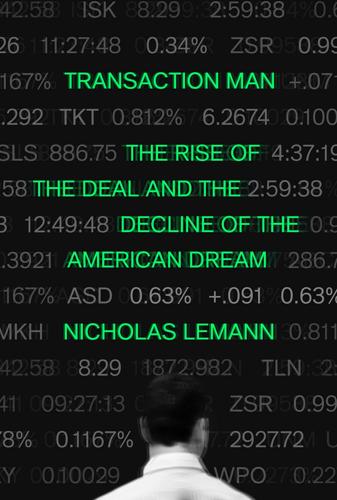
Transaction Man: The Rise of the Deal and the Decline of the American Dream
by
Nicholas Lemann
Published 9 Sep 2019
LinkedIn’s official idea of the economic future was that conventional long-term full-time employment would become less and less common, but that would be okay. People would start their own ventures, or move rapidly from job to job, or piece together “portfolio lives” stitched out of pieces of part-time employment they had found through such online networks as Uber and TaskRabbit. Hoffman’s Greylock partner Simon Rothman had coined a term for such people: “uncollared workers.” It was clear that the portion of the workforce whose lives were built this way was growing, but it was too early to tell whether such arrangements would continue to increase until they became the dominant form of work.
…
.; classes of in Silicon Valley; executives compensated in; new instruments outpacing; online sales of; on margin; see also stock market Story of a Lover, The (Hapgood) “Strength of Weak Ties, The” (Granovetter) Strickland, Ted strikes Strober, Sue Structure of Scientific Revolutions, The (Kuhn) Stuart, Harold subprime auto loans subprime mortgages, see mortgages Subud suburbs suffragists Summers, Lawrence Supreme Court; Brandeis on Sutton, Betty swaps, financial syndicate system; decline of Taft, William Howard Taft-Hartley bill Talman Federal Savings Tamayo Financial Services Tarbell, Ida TaskRabbit Teaching in the Home (Berle) Team Auto Tea Party technology, see computers; Internet; networks; Silicon Valley TED (conference) Temporary National Economic Committee Ten Step Sales Procedure (Spitzer) Tesla Thaler, Richard “Theory of the Firm” (Jensen and Meckling) Thiel, Peter; as provocateur Think and Grow Rich (Hill) Time-Life Tokyo Stock Exchange “too big to fail” doctrine totalitarianism Toyota trading: largest loss in; rise of; see also investment banking; Morgan Stanley Transaction Man; institutional model replaced by; loss of faith in; paradigm applied to social issues; pluralism and; see also financial economics; investment banking; Morgan Stanley Treasury Department; under Paulson; under Rubin passim; under Woodin Treaty of Detroit “Treaty of Detroit, The” (Bell) Troubled Asset Relief Program trucking Truman, David Truman, Harry Trump, Donald trustbusting; GM’s strategy against; of Morgan Stanley; obsolescence of; of tech firms Turner, Frederick Jackson Tversky, Amos 2008 financial crisis; automotive industry during; in Chicago Lawn; credit markets frozen during; government bailouts during; lead-up to, see deregulation; derivatives; mortgages Uber underwriting; by banks; decline of unions; criticism of; government support for; as interest groups; pensions from; Treaty of Detroit by United Auto Workers United Nations United States: core institutions of; corporations unforeseen by founders of; global influence of; national character in United States of America v.
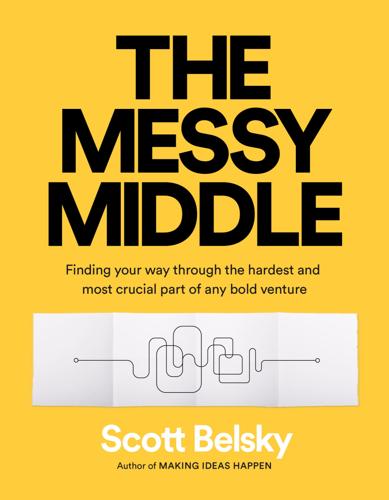
The Messy Middle: Finding Your Way Through the Hardest and Most Crucial Part of Any Bold Venture
by
Scott Belsky
Published 1 Oct 2018
Or so we think. Unbeknownst to most, anyone who’s used Tinder is assigned an internal rating: a score calculated by the company that ranks the most (and least) desirable people using the service. These “desirability ratings” are secret, Austin Carr reports in Fast Company. Unlike on Uber, Airbnb, or TaskRabbit, no user can know their “Elo Score,” as Tinder calls it, or how the algorithm determining this rating functions. Former Tinder CEO Sean Rad confirmed the rating system to Carr, who was granted exclusive access to his own Elo Score. While Rad wouldn’t reveal the algorithm’s details, he said it’s not solely determined by your profile picture: “It’s not just how many people swipe right on you,” Rad told Carr.
…
M., 201 Pentagram, 274–75 performance, and productivity, 214 Periscope, 10, 69–70, 112, 204, 233, 252, 264–65 Twitter’s acquisition of, 69, 264–65 permission, asking for forgiveness vs., 199–202 perseverance, persistence, 62, 79, 85 perspective, 40–42, 66, 74, 326 quitting and, 62–64 Photoshop, 10, 144, 159, 162, 185, 206–7, 238–39, 270, 347 Pine Street, 125 Pinterest, 10, 64, 86–87, 94, 112, 158–59, 165, 174, 204, 233, 248, 319 Pixar, 141 placebo, 59–61 planning, 93, 280–81 polarizing people, 114–15 PolitiFact, 303 positive feedback, and hard truths, 28–31 Post-it notes, 325 pragmatists, 295, 296 Prefer, 28, 298, 299 preparedness, 16 presenting ideas, vs. promoting, 164–65 press, 265–66, 336 Pretty Young Professionals (PYP), 72–73 Principles (Dalio), 306, 307 problem solving, 209 big vs. small problems, 180–82, 322 explicitness and, 173–74 process, 153–57 Proctor & Gamble, 143 product(s), 8, 29 brand fit and, 256, 257 complexity in, 209–10, 217 explicitness in, 174–75, 271 founder fit and, 256 life cycle of, 209–10, 217 market fit and, 256 minimum viable (MVP), 86, 186, 195, 252 paradox of success of, 216 power users of, 217 products used to create, 143–45 simplicity in, 209, 210–11, 216–18, 271 product, optimizing, 17, 209–75 anchoring to your customers, 247–75 being first, 264–66 disproportionate impact and, 267–68 empathy and humility before passion, 248–50 engaging the right customers at the right time, 251–54 and measuring each feature by its own measure, 269–70 mystery and engagement in, 271–73 narrative in, 255–57 and playing to the middle, 274–75 and role of leaders in communities, 258–61 sales and, 262–63 simplifying and iterating, 213–46 and believing in the product, 223–25 creativity and familiarity in, 226–27 and design as invisible, 230–31 doing, showing, and explaining, 238–39 “first mile” and, 232–34 identifying what you’re willing to be bad at, 214–15 inbred innovations and, 245–46 incrementalism and assumptions in, 242–44 killing your darlings, 219–22 for laziness, vanity, and selfishness, 235–37 making one subtraction for every addition, 216–18 novelty and utility in, 240–41 scrutiny and flaws in, 228–29 productivity, 179, 180–82, 187, 322, 324, 325 measures of, 78–79 performance and, 214 promoting ideas, vs. presenting, 164–65 promotions, 130 progress, 24–25, 31, 40, 47, 64, 75, 83, 85, 160, 179, 181, 349 conflict avoidance and, 185–86 process and, 154 progress bars, 181 prototypes and mock-ups, 161–63 Psychological Bulletin, 272 psychological safety, 122 Psychological Science, 272–73 psychology, 316, 317 Quartz, 37–38, 108, 301 questions, 69–71, 183–84, 321 Quiller-Couch, Arthur, 220 Quinn, Megan, 303–4 quitting, perspective and, 62–64 Quora, 138, 167 Rad, Sean, 259 Radcliffe, Jack, 197 Rams, Dieter, 230 reactionary workflow, 327, 328 Ready, The, 179 reality-distortion field, 41 Reboot, 327 Reddit, 261, 300, 302 rejection, 58 relatability, 57 relationships: commitments and, 283–84 and how others perceive you, 316–17 negotiation and, 286–87 REMIX, 165 resets, 63–64, 72–75 resistance, fighting, 35–36 resourcefulness, and resources, 100–102 reward system, short-circuiting, 24–27 Rhode Island School of Design, 186, 354 rhythm of making, 16 Ries, Eric, 194 risk, 122, 316, 337 ritual, 328 rock gardens, 67–68 routines, 323 ruckus, making, 337–38 Saatchi Online, 89 Sabbath Manifesto, 327–28 safety, psychological, 122 Sakurada, Isuzu, 361–62 salaries, 141–42 sales, salespeople, 262–63 Salesforce, 159, 204 Sandberg, Sheryl, 39 Santa Fe, USS, 167 satisficers, 229, 284–85 scalability, 242 Schouwenburg, Kegan, 50–51 Schwartz, Barry, 284–85 science vs. art of business, 310–13 Seinfeld, Jerry, 250 self, optimizing, 8, 17, 277–338 crafting business instincts, 293–313 auditing measures instead of blindly optimizing, 297–99 data vs. intuition in, 300–304 mining contradictory advice and developing intuition, 294–96 naivety and openness in, 308–9 science vs. art of business, 310–13 stress-testing opinions with truthfulness, 305–7 planning and making decisions, 279–92 focus and choice, 282–85 making a plan vs. sticking to it, 280–81 negotiation in, 286–87 sunk costs and, 291–92 timing and, 288–90 sharpening your edge, 315–28 building a network and increasing signal, 320–21 commitments and, 318–19 disconnecting, 326–28 and how you appear to others, 316–17 leaving margins for the unexpected, 324–25 values and time use, 322–23 staying permeable and relatable, 329–38 attention and, 335–36 credit-seeking and, 330–32 and making a ruckus, 337–38 removing yourself to allow for others’ ideas, 333–34 self-awareness, 54–56, 305–7 selfishness, laziness, and vanity, 235–37 setbacks, 41 70/20/10 model for leadership development, 125 Shapeways, 50 Shiva, 374 shortcuts, 85 signal and noise, 320–21 Silberman, Ben, 86–87, 94, 112, 165, 319 Silicon Valley, 86 Simon, Herbert, 229, 284 SimpleGeo, 267 Sinclair, Jake, 334 skills, and choosing commitments, 283–84 Skybox, 101 sky decks, 117 Slack, 139, 210, 241 Slashdot, 295 Smarter Faster Better (Duhigg), 180 Smith, Brad, 373 Snapchat, 70, 189, 210, 227, 249 Snowden, Eric, 48, 162 Social Capital, 107 social media, 70, 139, 195, 210, 235–36, 243 solar eclipse, 300–302 SOLS, 50–51 Song Exploder, 333 Sonnad, Nikhil, 301–2 Sonos, 275 Southwest Airlines, 214–15 Soyer, Emre, 32–33 SpaceX, 168 Spark, 303 speed, 194–98 Spiegel, Evan, 249 Spot, 256, 257 Square, 303–4 Squarespace, 312 Stafford, Tom, 291 stand-ins, 297–98 start, 1, 6–8, 13, 209, 331 Statue of Liberty, 200 Stein, Dave, 280 Steinberg, Jon, 44–45, 313 Stitch Fix, 79 story, see narrative and storytelling Stratechery, 135 strategy, patience and, 80–85 strengths, 29, 54, 95, 214 stretch assignments, 130 structure, rules for, 150–52 StumbleUpon, 112, 256 Stumbling on Happiness (Gilbert), 196 suffering, 35–36, 131 Summers, Larry, 108 sunk costs, 64, 71, 185, 291–92 Super Bowl, 273 superiority, sense of, 331–32 suspension of disbelief, 60–61 Suster, Mark, 204–5 Swarthmore College, 229 sweetgreen, 10, 151, 217, 221, 233, 245–46, 310 Systemized Intelligence Lab, 306 Systems Thinking, 283 Systrom, Kevin, 36 Taflinger, Richard, 38 talent, 119–25, 127, 187 Talk of the Nation, 196 TaskRabbit, 259 team, 39, 331, 332 energy and, 43–45 perspective and, 40–42 team, optimizing, 8, 17, 97–207, 211 building, hiring, and firing, 99–131 discussions and, 112–13 diversity in, 106–9 firing people to keep good people, 126–28 grafting and recruiting talent, 119–25 hiring people who have endured adversity, 110–11 immune system in, 116–18 initiative and experience in, 103–5 keeping people moving, 129–31 polarizing people and, 114–15 resourcefulness and resources in, 100–102 clearing the path to solutions, 177–207 big and small problems, 180–82 bureaucracy, 183–84 competitive energy, 187–91 conflict avoidance, 185–86 conviction vs. consensus, 203–5 creative block, 192–93 forgiveness vs. permission, 199–202 organization debt, 178–79 and resistance to change, 206–7 speed in, 194–98 culture, tools, and space, 133–48 attribution of credit, 146–48 free radicals and, 137–39 frugality and, 140–42 stories and, 134–36 tools, 143–45 structure and communication, 149–76 communication, 170–76 delegation, 166–69 merchandising, internal, 158–60 mock-ups for sharing vision, 161–63 presenting vs. promoting ideas, 164–65 process in, 153–57 rules in, 150–52 technology, 328, 371 TED, 62, 116, 305 teleportation, 70, 264 Temps, 201 10 Principles of Good Design (Rams), 230 Teran, Dan, 221 Tesla, 273 think blend, 33 Thomas, Frank, 222 Thompson, Ben, 135 Threadless, 267 time, use of, 210, 283, 299 leaving margins, 324–25 money and, 370–72 values and, 322–23 time-outs, 74 timing, 288–90, 332 decision making and, 289–90 investment and, 290 leader and, 288–89 Tinder, 259–60 Tiny, 294 Todd, Charlie, 113 Todoist, 229 tools, 143–45 Topick, 249 transparency, 259–60, 287 triggers, 55 Trump, Donald, 273, 302–3 truth(s), 71, 174, 193, 331, 338 creative block and, 192–93 hard, 28–31 stress-testing opinions with, 305–7 about time use, 323 Turn the Ship Around!

New Laws of Robotics: Defending Human Expertise in the Age of AI
by
Frank Pasquale
Published 14 May 2020
Based on the success of Khan Academy, enthusiasts breathlessly project that a college education can be had for a fraction of the current tuition costs; just record all the lectures, automate evaluation of students, and invite the world to attend, with grades recorded on a blockchain transcript. Get stuck on a lesson? Just keep interfacing with a keyboard, camera, and perhaps haptic sensors. Or perhaps instant message some reserve army of tutors via digital labor platforms like Mechanical Turk or TaskRabbit.79 Want to prove that you aren’t faking exams? Just let cameras record your every move and keystroke—perhaps your eye movements and facial expressions, too. Beyond the creepiness of such surveillance, there are some obvious incoherencies in this vision. It is far from clear how to replicate the experience of seminars, extracurricular activities, or internships online.
…
See racism; sexism Stevens, Wallace, 220 Steyerl, Hito, 219 Stiglitz, Joseph, 160 Strategic Defensive Initiative (SDI), 9 student debt, 87, 134–135, 279n58 subsidiarity, 176 substitutive AI / robotics, 6, 31, 52, 55, 123, 172, 200, 202, 206, 211, 221 Sudan, 149 surveillance, 6, 8, 58, 121–123, 135, 159, 166–167; in China, 61, 160, 167; and arms races, 31, 136, 167; in education, 62, 72, 73–77, 83–85; and encryption / decryption, 10; in Europe, 5; and facial recognition, 125, 129; in finance, 135–136; and the military (including drones), 151–154, 164–166, 168; mobile, 15; public health, 11; in the workplace, 131 The Syllabus, 100 Syria, 167 Taiwan, 55, 159, 160, 163–164 Taliban, 160 Tamagotchi, 80 TaskRabbit, 84 tax(es), 10, 27, 53, 193; carbon, 185; and deflation, 26, 188–189; for education, 25, 62, 188; inversions, 228; and military technology, 158; and modern monetary theory, 193–194; policy, revitalizing, 172, 179–183; and the uninsured, 43; and universal basic income, 184 Tay (Microsoft chatbot), 12, 219 Taylor, Charles, 224, 308nn83–84 Taylor, Frederick, 83; and Taylorism, 67, 83, 139 Tcherneva, Pavlina, 186 teaching.

Visual Thinking: The Hidden Gifts of People Who Think in Pictures, Patterns, and Abstractions
by
Temple Grandin, Ph.d.
Published 11 Oct 2022
I wasn’t surprised to learn that the man who created the company was dyslexic, privileging pictures over words. I’ve heard of some verbal thinkers who completely fall apart in the face of IKEA furniture instructions, becoming highly frustrated as they try to follow them. What is a perfect road map for me is a confusing mess for them. That must be why IKEA partnered with TaskRabbit, employing visual thinkers to help English majors assemble their bookshelves. Bookcases aside, there is no definitive test or scan for visual thinking (yet), but Linda Silverman’s “Visual-Spatial Identifier,” which she and her team in Denver developed over many years, does a very good job of distinguishing between what Silverman calls “auditory sequential” thinkers (language based) and “visual spatial” (picture based).
…
See also NASA SpaceX, 138–39, 194 spatial visualizers, 47, 61 collaborations of, 121–24, 126, 131, 135, 151 description of, 3, 90–91, 146 excellence at chess, 232 excellence at mathematics, 3, 31–32, 37, 45, 62, 74, 91, 95, 114, 133, 147, 149 future needs for, 152–53 identifying test for, 18–19 versus object visualizers, 90–91, 131 studies on, 30–34, 37–39 traits/skills of, 17, 36–39, 45–46, 105, 107, 143, 175 work with object visualizers, 137–38, 142–43, 146–48, 153 work with verbal thinkers, 151 special education, 4, 55, 107, 277 Species of Mind: The Philosophy and Biology of Cognitive Ethology (Allen and Bekoff), 245 speech and autistic children, 25, 43–44, 77, 79–80, 98, 101 and the brain, 22, 25 therapy for, 9, 77, 80, 100, 170 Sperry, Elmer, 122 Sperry, Roger, 27 Sperry Corporation, 123–24 Spielberg, Steven, 174–75 Spikins, Penny, 161 Stacho, Martin, 256 standardized tests dropped as college admission requirement, 73–74 and inequities, 72–73 for intelligence, 64 and mathematics, 59, 64, 74–75 to measure creativity, 184–85 qualities not found on, 76, 81 stripping school curricula, 51 and visual thinkers, 73–74, 81 See also specific tests Stanford University, 46, 77, 116, 125, 139, 142, 170 Stedman’s Medical Dictionary, 199 Stein, Gertrude, 176 STEM, 69, 95 Steve Jobs Theater (Apple headquarters), 4–5 Stone Age Origins of Autism, The (Spikins), 161 StreamYard, 149 Suh, Joori, 37 Sullenberger, Chesley, 217 Sušac, Ana, 61 Suskind, Owen, 44 Sussex Centre for Neuroscience (UK), 239 Sutton, Mike, 46 Swaminathan, Nikhil, 207 Sweden, 169, 176, 231 Swift cattle plant, 114, 149 Swiss apprenticeship model, 112–14, 117 Syntactic Structures (Chomsky), 1–2 T Tacoma Narrows Bridge (Washington state), 207–8 talking to oneself, 10, 13–14. See also self-talk TaskRabbit, 17 teams diverse thinkers on, 6–7, 128–30, 142–45, 200–201, 212 technical schools, 110–12, 117 skills, 5–6, 51, 86, 88, 105, 135 technology industry coders/programmers in, 35, 45, 111, 148–49, 178–83 collaborations in, 139–40, 148–49, 152–53, 163 geniuses in, 178–83, 190 hiring diverse thinkers, 104–6 innovations in, 124–26, 144–45, 148–49, 153, 161–64, 277 internships in, 114–16 people with Asperger’s in, 100–101 people with autism in, 105–6, 163–64 and techies versus suits, 131–33, 141 See also computers Testing Charade: Pretending to Make Schools Better, The (Koretz), 70–71 tests/testing, 4, 6, 66, 68, 70–77, 108, 110, 183.

The Fourth Industrial Revolution
by
Klaus Schwab
Published 11 Jan 2016
As Arun Sundararajan, professor at the Stern School of Business at New York University (NYU), put it in a New York Times column by journalist Farhad Manjoo: “We may end up with a future in which a fraction of the workforce will do a portfolio of things to generate an income – you could be an Uber driver, an Instacart shopper, an Airbnb host and a Taskrabbit”.27 The advantages for companies and particularly fast-growing start-ups in the digital economy are clear. As human cloud platforms classify workers as self-employed, they are – for the moment – free of the requirement to pay minimum wages, employer taxes and social benefits. As explained by Daniel Callaghan, chief executive of MBA & Company in the UK, in a Financial Times article: “You can now get whoever you want, whenever you want, exactly how you want it.

Work Won't Love You Back: How Devotion to Our Jobs Keeps Us Exploited, Exhausted, and Alone
by
Sarah Jaffe
Published 26 Jan 2021
Yet even these companies demand a certain performance of love. Author Miya Tokumitsu found “a maid-service company advertising on Craigslist… looking for ‘a passionate individual’ to clean houses.” 45 And then there are the apps. TaskRabbit and its competitors allow people to hire a one-off assistant at the click of a button. Care.com will find you a babysitter or care attendant. According to one TaskRabbit executive, 60 percent of its users are women, many of them mothers searching for just a little help around the edges. In his sunny view, this piecework approach to hired domestic labor is making women’s lives easier.

Bit by Bit: How P2P Is Freeing the World
by
Jeffrey Tucker
Published 7 Jan 2015
If you need a ride in a major city, you can pull up the smartphone app for Uber or Lyft and have a car arrive in minutes. It’s amazing to users because they get their first taste of what consumer service in taxis really feels like. It’s luxury at a reasonable price. If your sink is leaking, you can click TaskRabbit. If you need a place to stay, you can count on Airbnb. In Manhattan, you can depend on WunWun to deliver just about anything to your door, from toothpaste to a new desktop computer. If you have a skill and need a job, or need to hire someone, you can go to oDesk or Elance and post a job you can do or a job you need done.

Slow
by
Brooke McAlary
Published 22 Aug 2017
In her 2012 TED talk, Rachel Botsman spoke of the sharing economy as a way to minimise buying things that have a limited use. Talking of handheld drills, which, on average, are used for a total of 12–13 minutes throughout their entire life, she exclaimed, ‘You need the hole, not the drill!’ Turo, Lyft, TaskRabbit and Airbnb are symbolic of the emergence of mainstream sharing, but there is a much more personal way to share that also taps into one of our most important resources—community. Is there a way you and your family, friends or neighbours could share common resources? Things you don’t use very often, but would probably go out and buy if the need arose?
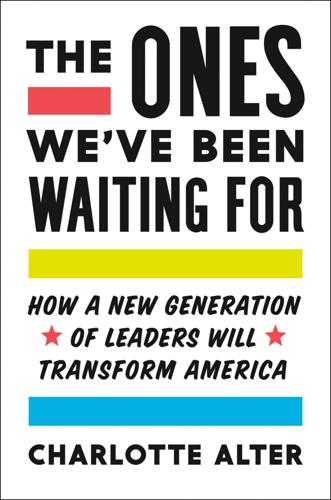
The Ones We've Been Waiting For: How a New Generation of Leaders Will Transform America
by
Charlotte Alter
Published 18 Feb 2020
When big purchases such as homes and cars were out of the question, many millennials figured they might as well spend their money on things like specialty cronuts and fancy coffees. They tended to prefer experiences over possessions. And a generation steeped in social networks became increasingly comfortable renting things instead of owning them: millennials rented rides (with Uber and Lyft), rented clothes (through Rent The Runway), and rented labor (through TaskRabbit). They also began to look to the gig economy for side hustles to supplement their meager incomes. By 2018, more than 40 percent of eighteen- to thirty-four-year-olds worked as freelancers. For almost half of the largest generation of workers, the traditional work structure that had defined twentieth-century professional life just wasn’t available anymore.
…
See education, of millennials school-to-prison pipeline, 37, 119 Schumer, Chuck, 196 Scott, Keith Lamont, 121, 125, 136 SEAL Force Alpha (Marcinko), 14 search engines, 55, 57–58 Sebelius, Kathleen, 109 Securities and Exchange Commission, 217 self-esteem science, and parenting, 34 The Selfie Vote: Where Millennials Are Leading America (and How Republicans Can Keep Up) (Anderson), 150–51 Sessions, Jeff, 195 Shames, Shauna L., 131 Shapiro, Ben, 249–50, 254 Sherrill, Mikie, 270 Sherry, Jonathan, 22, 81–82 Silent Generation, xviii Singer, Paul, 154–55 60 Minutes, 222 Skocpol, Theda, 205 Slotkin, Elissa, 270 Smith, Al, 217–18 Smith, Lis, 283–84 socialism/democratic socialism, 213–24 boomers view of, 213, 216 DSA candidates in 2018 elections, 238–39 history of, in the United States, 216–20 millennials view of, 214–16, 220–24 Roosevelt New Deal policies and, 217–19 social justice, 61 social media, 55, 60–61 Ocasio-Cortez’s use of, 183–87, 266–67, 273, 288–89 Occupy Wall Street and, 114, 117–18 racial justice movement and, 120–21 self-definition, building of online communities around, 60–61 Social Security, 31, 99–100, 217 Social Security Trust Fund, 31, 99–100 South Bend Tribune, 145–46 Spanberger, Abigail, 270 Sperling, Gene, 104 Squad, 270, 279–81 Standing Rock Indian Reservation Dakota Access Pipeline protests, 181–82 Ocasio-Cortez live streams trip to, and experiences at, 183–89 Starr, Ken, 51 Stefanik, Elise, xxi, 11–13, 153–57 acceptance to Harvard, 12–13 at Albany Academy for Girls, 11–12 bipartisanship of, 161 climate change and, 157–58 elected and serves in Congress representing twenty-first district New York, 154–56 at Harvard, 153 on lack of women Republican candidates, 244–45 9/11 terrorist attacks and, 11 personality of, 11–12 reelected to Congress, 2016, 176 reelected to Congress, 2018, 257–59 on Trump and Trump’s policies, 257–59 2012 presidential election and, 168–70 works for Romney 2012 campaign, 148–49 Steinem, Gloria, 29–30, 200 Steinhauser, Brendan, 251, 255 Sterling, Alton, 121 Stevens, Haley, xvii, xxi, 8–11, 230, 268 at American University, 8–9 on Auto Task Force, 101–5 campaign for and elected to House of Representatives, 233–37, 242–43 childhood of, 9–11 as Clinton 2016 campaign volunteer, 167–68 as Clinton 2008 campaign intern, 84–85, 89 digital revolution and, 54–55, 56 elected copresident of freshman Congress people, 269 first days in Congress, 269–70 first year in Congress, accomplishments during, 277 Great Recession and, 92–93, 100 Green New Deal not cosponsored by, 279 9/11 terrorist attacks and, 8–9 2012 presidential election and, 167–68, 175, 178 works for Biden’s 2008 campaign, 89, 90 Stevens, Maria, 9–10, 232, 233, 235–36, 237 stock market, 93 Strauss, Rose, 273–74 Strauss, William, xiv stress, 36 Strykers, 70–71 student loan debt, 44–52 average debt of Gen Xers versus millennials, 46 cost of college education, increase in, 50–51 for-profit colleges and, 52 Great Recession and, 96 hollowing out of rural and suburban areas and, 141 increase in college attendance and, 47–48 of Ocasio-Cortez, 44–45, 166, 167 of white millennials versus black millennials, 51–52 Summers, Larry, 106, 178 Sunrise Movement, 189–90, 191, 273–74 Superstorm Sandy, 129 Swisher, Maria, 165, 167, 183, 187, 199, 200–201 The S Word: A Short History of an American Tradition (Nichols), 219 Tailspin: The People and Forces Behind America’s Fifty-Year Fall—and Those Fighting to Reverse It (Brill), 29 Tanden, Neera, 84, 101 TaskRabbit, 99 Tax March, 204 Tea Party, 124, 131, 205 technological shift. See digital revolution telephone, 55 television, 55 Third Way, 30 Thompson, Kenneth, 238 Three Men and a Baby (film), 33 Thunberg, Greta, 190, 191, 294 Tillerson, Rex, 196 TIME, 29, 39 Tlaib, Rashida, 237–38, 265, 270, 280 Tobias, Andrew, 7 Tocqueville, Alexis, xiii–xiv Today (tv show), 4 Townsend, Gayraud, 132 Trent, Corbin, 209, 281 trigger warnings, 37 Trott, Dave, 233, 234 Troubled Asset Relief Program (TARP), 106 Trump, Donald, xiv, xvi, 58, 149–50, 158, 294 Access Hollywood tape and, 169 age at time of presidency, xiii, 194 appointments of, 194–95 attacks the Squad, 280–81 climate change views of, 195–96 elected president, 2012, 169 environmental policies of, 195–96 generational schism in Republican Party caused by, 249–50 lack of millennial support for, 249 Muslim travel ban executive order of, 202, 203 resistance to, 198–201 on socialism, 222 Tubbs, Michael, 131–32, 138–41 Advance Peace program and, 140 basic income pilot program and, 140 cradle-to-grave services for poor children initiative, 139–40 elected mayor of Stockton, 139 elected to Stockton City Council, 139 as intern in Obama White House, 138–39 as mayor of Stockton, 139–41 policing and, 140 South Stockton Promise Zone initiative and, 139–40 Stockton Scholars program and, 140 youth of, 138 Tucker, Clyde, 151 Tumblr, 114, 204 Turning Point USA, 253 Twenge, Jean, 34 Twitter, 57, 58, 60, 61, 204 2012 presidential election, reaction to.

Super Pumped: The Battle for Uber
by
Mike Isaac
Published 2 Sep 2019
The divide between tech’s most talented, and the class who waited tables and served them coffee only grew starker by the day. Fast-rising rents pushed wage earners out of San Francisco, while landlords flipped those former apartments to new, wealthier tenants. The “gig economy” unleashed by companies like Uber, Instacart, TaskRabbit, and DoorDash spurred an entirely new class of workers—the blue-collar techno-laborer. With the rise of Facebook, Google, Instagram, and Snapchat, venture capitalists looked everywhere to fund the next Mark Zuckerberg, Larry Page, or Evan Spiegel—the newest brilliant mind who sought, in the words of Steve Jobs, to “make a dent in the universe.”
…
Louis, Missouri, 117–18 Strategic Services Group (SSG), 202, 257–58, 259 Stripe, 92n, 196 StumbleUpon, 41, 42–43 StyleSeat, 49 Substance, 26 Sugar, Ronald, 332 Sullivan, Joe, 165, 167–75, 178, 187, 226n, 247, 258, 258–59, 311, 329, 335–37 Sun Tzu, 189 Sweeney, Matt, 59, 184 Swisher, Kara, 177 Sydney, Australia, 84–85 Syria, 205 Sze, David, 74 Tahoe, California, 8 Taiwan, 139 Target, 189–90 TaskRabbit, 9 Tavel, Sarah, 283, 294 Taxi Magic, 78 TechCrunch, 55, 58, 59, 63 Techmeme, 55 TED Conference, Long Beach Performing Arts Center, 98 Tellme Networks, 92, 92n, 93, 94 Tencent, 147–48 Terranea Resort, 176, 179 Tesla, 4, 199, 233 Texas, 115 Texas Pacific Group (TPG), 277–78, 313, 321–22, 323 TextNow, 146 Thailand, 195 Thain, John, 327 Thrun, Sebastian, 183 Time, 121 Todd, Michael, 28, 31 TPG Capital, 99–101, 157 Transport Workers Union, 204 Treasury Department, 34 Trebek, Alex, 275n Trism, 39 T.

The People vs Tech: How the Internet Is Killing Democracy (And How We Save It)
by
Jamie Bartlett
Published 4 Apr 2018
* For now at least – plenty of robotics companies are working to overcome Moravec’s Paradox, especially as computing power increases. * Uber and Deliveroo are part of an increasingly important sort of industry: the gig economy encompasses companies that monetise everything from borrowing cars (RelayRides), helping with daily tasks (TaskRabbit), lending bikes (Liquid) or money (Lending Club) and selling home Wi-Fi (Fon) or clothes (NeighborGoods). According to the Chartered Institute of Personnel and Development, approximately 1.3 million people are already working in the gig economy in the UK this number is predicted to grow substantially in the next few years
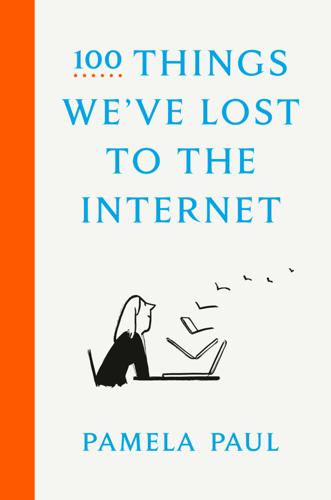
100 Things We've Lost to the Internet
by
Pamela Paul
Published 14 Oct 2021
Instead, you go online to image-search a detailed replica set or watch a how-to video on YouTube or endure a live chat with a technician on the manufacturer’s website. You can pop into a discussion among techies that solves problems the instruction manual never even foresaw, or just say to hell with it and hire a TaskRabbit to put together that Ikea daybed for you. [ 88 ] THE BLIND DATE A blind date was called that for a reason. You had no idea what you were getting into and not a clue what she looked like beyond what you’d been told about her hair and what color sweater she’d be wearing that night.

The Stack: On Software and Sovereignty
by
Benjamin H. Bratton
Published 19 Feb 2016
If we follow the thread of Alex Rivera's Sleep Dealer (2008), a film in which California's agriculture is served by drone pilot/robot fruit pickers working remotely from behind the sovereign wall separating the United States and Mexico, it is not unreasonable to imagine a further logistic dehumanization of Fresno's on-site population.21 Perhaps the costs of piloting agricultural labor will be held down by global wage arbitrage, pickers in Tijuana competing with pickers in Jakarta and Juneau to provide fast and cheap results. That is, formal national jurisdiction may have far less to do with the economics of Cloud feudalism than with whichever Cloud Polis, enclave platform, or urban camp happens to counts a given worker as one of its Users. The elevation of labor systems like Amazon's Mechanical Turk, TaskRabbit, and Uber to infrastructural scale suggests several paradoxical and even contradictory outcomes, both positive and negative. One of these is well summarized as: “I'm really looking forward to a future in which service employees are leased Google Glass so they can complete courses in for-profit trade schools while simultaneously earning health care vouchers instead of actual currency and Soylent instead of actual food.”22 We should add, however, that the lease terms on that Glass set are conditional on whether the User actually won the bid to pilot-pick avocados.
…
Peter Watts, Beyond the Rift (San Francisco: Tachyon Publications, 2013), 9. 78. James Bridle, “Do You Know This Person?” Render Search, http://render-search.com/. 79. Sarah Jaffe, “Silicon Valley's Gig Economy Is Not the Future of Work—It's Driving Down Wages,” Guardian, July 23, 2014, http://www.theguardian.com/commentisfree/2014/jul/23/gig-economy-silicon-valley-taskrabbit-workers. 80. When I was a youngster, my dislike for the Canadian rock band Rush was confirmed by the song “Red Barchetta,” about a guy who drives around in his muscle car in defiance of climate and pollution laws. Today, Johnny Dronehunter protects normatively masculine white guys from the emasculating influence of “drones” (and “technology” in general we assume) by zooming around inside his big metal box and shooting at things in the sky.
…
See also Amazon surfaces, interface design, 230–231 surveillance address, 215–216 apparatuses of, 121, 138, 215 culture of, 363 geolocative Apps enforcing, 243 jurisdiction over, 28, 121 metadata for, 287 NSA/Patriot Act, 35, 120, 287 satellite technology, 90–92 surveillance-sousveillance contravention, 454n75 surveillance state, 8, 106, 138, 192, 327 surveilled, spectacle of transparence for, 452n70 Survival Research Laboratories, 57 swarms, 281–282, 334 swerve, 77 synthetic algorithmic intelligence, 81 synthetic catallaxy, 330–331, 375 synthetic computation, 198, 352 synthetic intelligence, 362 systems theory, 54 tactile technology, 148, 177, 224, 226 tactility of the virtual, 129–130, 148 Tafuri, Manfredo, 304 Tangible Media Group, MIT, 226 tangible user interfaces (TUI), 168, 226 Tarde, Gabriel, 125, 266, 334, 340 Tarde-Durkheim debate, 266 TaskRabbit, 308 Tati, Jacques, 147 Taylor, Frederick Winslow, 254, 285, 297 TCP/IP network model, 61–63, 319 technical-institutional systems, 329–330 technolibertarianism, 312–314, 316–317, 329 technological innovation, 45, 62, 79, 92, 129, 163, 330 technologicization of intelligence, 278 technology accidents of new, 273, 356 borders of, 29 computational, limits of, 78–79 embodying human mastery, 344–345 future of, 303–304, 341 governance and, 7–8 qualities associated with the divine, 172 of social organization, 336 for the Stack-to-come, availability of, 303–305 tactile, 148, 224, 226 for violence, 17, 325 technopolitics, 115 technoradicalism, placebo, 303–304 Tektology, 328 telematic stigmergy, 428n58 telephone line service, 29 telescopic logics, global/local, 16, 101, 178, 197, 220, 229, 235, 266 Ten Books of Architecture (Vitruvius), 254 terraforming, 85–86, 115–116, 181, 187, 404n11 territory addresses defining, 193–195, 296 Cloud layer, 154 elements of, 335 exceptional, 114 geometry of, 25 Google's Grossraum delaminating, 295 intelligent, 198 lines of demarcation, 32 megastructural, 154–155, 176–183 networks producing, 29 as political technology/political technology as, 335 and sovereignty, 97, 114, 119–120, 312, 316 urban interfacial, 155–160 territory of territories, 246–247 terrorism counterterrorism discourse, 324, 355 Mumbai attacks (2008), 17, 242, 247–248, 322, 428n58, 431n70 September 11, 2001, terrorist attacks, 321, 363 War on Terror, 320–321 textuality as addressability, 199–200 theo-interfaciality, 239–243 theological imperative of augmented reality, 429n61 theological memory, 240, 297 theology, 125, 149.
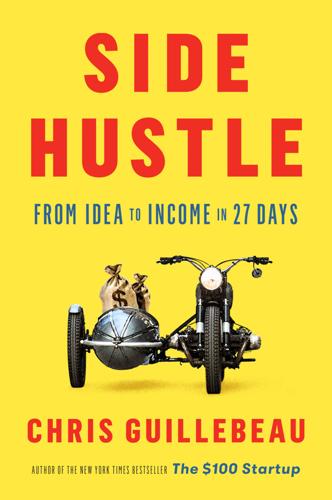
Side Hustle: From Idea to Income in 27 Days
by
Chris Guillebeau
Published 18 Sep 2017
IF YOU’RE JUST “BREAKING EVEN,” YOU’RE ACTUALLY LOSING MONEY A side hustle should be fun, but as you know by now, it also needs to be profitable. Consider the platform Fiverr.com, which we’ll look at further in a couple of upcoming stories. This online marketplace for services and others like it (TaskRabbit, for example) are great for experimenting in the way of the side hustle: you can create a profile and start completing tasks for people almost right away. What’s not to love? Well, the site is called Fiverr for a reason—the price for all the services offered needs to begin at just $5. It’s possible to use the platform as a launchpad for working up to something bigger, and it’s also totally fine to play around at a low price structure while getting used to hustling, but in the long run you’ll probably want to make a lot more than $5 at a time.

Wild Ride: Inside Uber's Quest for World Domination
by
Adam Lashinsky
Published 31 Mar 2017
It is a leader of the so-called gig economy, cleverly marrying its technology with other people’s assets (their cars) as well as their labor, paying them independent-contractor fees but not costlier employee benefits. Such “platform” companies became all the rage as Uber rose to prominence. Airbnb didn’t need to own homes to make a profit renting them. Thumbtack and TaskRabbit are just two companies that matched people looking for project-based work with customers—without having to make any hires themselves. By late 2016 Uber stood at a crossroads. It had raised $17 billion from private investors, reaching a valuation of $69 billion, an unheard-of level for a still-fledgling private company.

The Purpose Economy: How Your Desire for Impact, Personal Growth and Community Is Changing the World
by
Aaron Hurst
Published 31 Aug 2013
We can find services provided by people in our own neighborhood, read blogs by neighbors in our own community, and borrow money from like-minded people rather than big banks. The technology that created a scale so large as to drown us has now enabled a scale anchored in people’s need for purpose and meaning in their work and lives. It is right-sizing, to steal the term back from big business. From TaskRabbit to Elance, technology is changing the way we can earn a living, but also changing the way employers think about labor. More than 17 percent of the fourteen million self-employed workers in the United States consider themselves independent contractors or freelancers.1 Fractional Labor, as it sometimes called, is concentrated heavily in sales, IT, creative services, marketing, and operations.

Blockchain Chicken Farm: And Other Stories of Tech in China's Countryside
by
Xiaowei Wang
Published 12 Oct 2020
Refusing to take an order after it is assigned in the system results in an RMB 100 fine, and being too early for a delivery is a whopping RMB 500 fine. Although the base salary initially seems appealing, the long list of fines creates a precarious existence for the workers. It parallels gig work in the United States—DoorDash drivers and TaskRabbits. In both cases, the larger system, the platform, off-loaded any operating risk to the workers, allowing the platform to shirk responsibility to customers. Through fee structures of bonuses, fines, and competition to be courier of the month, work is gamified, just like in the United States. When I ask the two women how long the structure has been like this, one of them shrugs.

Inequality and the 1%
by
Danny Dorling
Published 6 Oct 2014
To win the bid, the task rabbit must be willing to bid below what they think others will put in as their lowest bid. The job might be to clean a garage, paint an apartment or buy groceries. The firm that matches up these temporary servants and their not-too-fussy masters, and carries out criminal record checks on them, is called Taskrabbit.com. Rabbits receive star ratings based on what previous masters thought of them.88 Task rabbits are frontrunners in a race to the bottom. If task rabbits are an extreme case, ‘temps’ are the new normal. Temps range from casual day labourers to university teaching assistants hired for ten months, or ten days.

Silicon City: San Francisco in the Long Shadow of the Valley
by
Cary McClelland
Published 8 Oct 2018
He dove down, scrambled in the dust trying to find every coin. The light turned green, and we drove off. He disappeared into a sea of vehicles in my rearview mirror. And I thought, We’ve turned everything into a game. San Francisco—and the Bay Area in general—has become something of an arcade for the young and plugged in. Uber, Lyft, TaskRabbit, Carbon, Rinse, Instacart, Alfred—a kingdom of cute one-word fiefdoms offering chauffer and butler services for the new tech titans. They are shuttled to their corporate campuses—like summer camp, a world of primary colors and playgrounds and cafés and endless amusement to keep them happy at work.

The Complete Guide to Property Investment: How to Survive & Thrive in the New World of Buy-To-Let
by
Rob Dix
Published 18 Jan 2016
If you don’t already have the right person on hand when disaster strikes, I recommend using a site like mybuilder.com or checkatrade.com. You place your job, contractors bid, and you can see their reviews from previous clients to assure yourself that they’re up to the task. Bits and bobs. For those random tasks that require an in-person visit, there’s normally a way to find someone else to do it. In London there’s taskrabbit.co.uk, nationwide there’s gumtree.com, or you could try posting a request on a local message board like streetlife.com. You could even decide to outsource periodic inspections in this way, by sending in someone armed with a simple checklist and ask them to snap photos on their phone of anything that looks important.
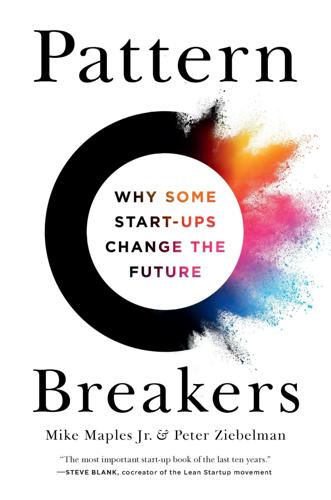
Pattern Breakers: Why Some Start-Ups Change the Future
by
Mike Maples
and
Peter Ziebelman
Published 8 Jul 2024
They made a basic implementation prototype to bridge the gap. Initially, the founders and their friends drove, seeking firsthand feedback. Their cars wore giant pink mustaches, making them distinct and welcoming. To simulate rider demand before launching the official ride service, they used gig-working platforms like TaskRabbit to pay riders to gather genuine responses, refining the app based on feedback. While testing their implementation prototype, Lyft’s founders and their team directly experienced many early riders eagerly telling them, “You have to build this app.” It wasn’t just the words; it was the fervor behind them.
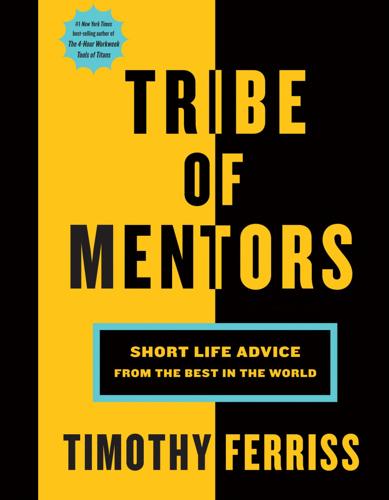
Tribe of Mentors: Short Life Advice From the Best in the World
by
Timothy Ferriss
Published 14 Jun 2017
The child of a rocket scientist at NASA, Ann is a Palo Alto native and has been steeped in technology startups since she was a teenager. Prior to co-founding Floodgate, she worked at Charles River Ventures and McKinsey and Company. Some of Ann’s investments include Lyft, Ayasdi, Xamarin, Refinery29, Chloe and Isabel, Maker Media, Wanelo, TaskRabbit, and Modcloth. How has a failure, or apparent failure, set you up for later success? Do you have a “favorite failure” of yours? As a 12-year-old, I stood on a stage next to my brother, who confidently pointed to me and announced, “This is Ann Miura. She will be playing a Chopin Nocturne in C sharp minor.”
…
K., 123 Rubin, Gretchen, 479–81 Rubin, Rick, 487–91 Rumi, vi, 18 Ruskin, John, 178 Russell, Bertrand, 205, 515 Ruth, Babe, 346–47 S Sacca, Chris, 440 Sacks, Rabbi Lord Jonathan, 157–62 Sadhguru Jaggi Vasudev, 343 Saigyō, 513 Saint-Exupéry, Antoine de, 235 Saint John, Bozoma, 37–38 Salcedo, Javier Pascual, 205 Salesforce, 445, 448–50 Salzberg, Sharon, 272–74 Samatha meditation, 271 San Francisco Writers Grotto, 396 SAP, 446 Sapling Foundation, 407 Saunders, George, 57 Saving money, 378 Sawyer, Robert J., 91 Schaffhausen, Brian, 108–9 Schmidt, Eric, 221 Scholly, 79 School, adopting a, 449–50 School of Visual Arts, New York City, 24 Schopenhauer, Arthur, 69 Schwarzenegger, Arnold, 14 Schweitzer, Albert, 206 Scudder, Vida Dutton, 112 Seattle Seahawks, 412 Seneca, 39, 112, 206, 253, 513 Shabalov, Alexander, 369 Shake Shack, 371 Shapiro, Dani, 28 Sharapova, Maria, 182–84 Shavit, Michal, 556 Shaw, George Bernard, 235 Shea, Ryan, 492–94 Shopping.com, 31 Shungite stone, 269 Siegel, Dan, 62 Silbermann, Ben, 495–500 Simmons, Louie, 309 Simmons, Marshall, 358, 359 Simon and Garfunkel, 161 Skype, 250 Slater, Kelly, 419–20 Sleep, 3–4, 232 as investing in yourself, 212–13 naps, 319 for stress relief, 529–30 Sleepio, 243 SleepPhones, 36 Slide, 92 Sling Shot, 309, 311 Slovic, Paul, 190 Smelling salts, 387 Socrates, 224 Sohn Conference Foundation, 56 Sonen Capital, 324 Sony, 281 Sorkin, Andrew Ross, 145–46 Soros Fund Management, 428 SoundTracking, 101 Sowell, Thomas, 205 “So what” exercise, 90 SpaceX, 42, 293 Special Olympics, 509 Spiceworks, 64 Spiralizer, 306 Spotify, 286, 288 Square, 250 Stanton, Brandon, 254–55, 565 Starrett, Kelly, 316, 317 StartUp Health, 243 Stay Covered Big Wave SUP leash, 196 Stephenson, Neal, 470–71 Stewart, Zeph, 224 Stiller, Ben, 135–39 Strauss, Neil, 96–99 Strayed, Cheryl, xviii SubPac M2 Wearable Physical Sound System, 57 Suffering, 16, 32, 33, 83, 122, 237, 344, 381, 558–60 Sun Tzu, 436 Super Training Gym, Sacramento, 309 Susan G. Komen for the Cure, 509 Swope, Herbert Bayard, 69 Szabo, Nick, 382–84 T Take-Two Interactive Software, Inc., 289 Taleb, Nassim, 60 Talk therapy, 550 Task and distractions list, 542–43 TaskRabbit, 200 Tata Harper Fierce lip balm, 233 Taubes, Gary, 480 Technology, 213 disruptive, 222–23, 346 Moore’s Law for, 294–95 TED Conference, 407–8 Tesla, 42, 293 Therapy, 26–27, 81, 550 Theroux, Paul, 210 Thich Nhat Hanh, 235, 450 Thiel, Peter, 153 Thoreau, Henry David, 39, 140, 205, 463 Þórisdóttir, Anníe Mist, 305–7, 421 Thrive Global, 211 Thrive Global phone bed, 213–15 Thucydides, 6–7 Thumbtack, 31 Tile Mate key finder, 97 Tippett, Krista, 308 Tivoli Systems, 64 Tolstoy, Leo, 335 Tony Hawk Foundation, 298 Tony Hawk Signature Series, 298 Topic.com, 141 Top Ramen, 391 Torres, Dara, 390–91 Total Immersion, 440, 442, 443 Tradedoubler, 286 Transcendental Meditation, 80, 241, 242, 322, 380, 381, 489 Trickstutorials.com, 385 Truman, Harry, 206 Tumblr, 215 23andMe, 243 Twitch.tv, 64 Twitter, 31, 64, 215, 250, 401 Tyler, Aisha, 431–35 U Uber, 31, 37, 211, 215, 250, 347–48, 459, 461 Ulmer, Kristen, 546–53 Under Armour, 447 Union Square Hospitality Group (USHG), 371 Union Square Ventures, 492 Urban, Tim, 40–49, 495 USCF Memory and Aging Center, 296–97 V Valkee, 243 Van de Snepscheut, Jan L.
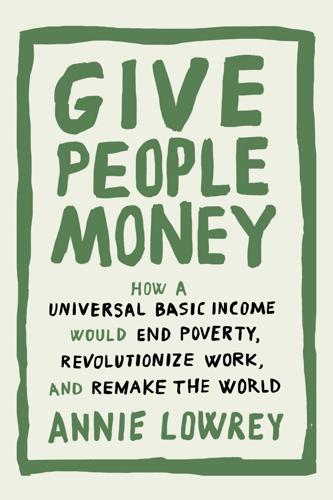
Give People Money
by
Annie Lowrey
Published 10 Jul 2018
Private-equity partners and venture capitalists have shunted billions and billions of dollars to start-ups seeking to disrupt brick-and-mortar businesses, vault over workplace protections, pay peanuts, employ close to no one, and offer no benefits or job security. Uber is just the biggest and most visible of these players. Others include the freelance-services marketplace Fiverr, Uber’s ridesharing rival Lyft, the grocery delivery company Instacart, and the do-anything handyman service TaskRabbit, now part of Ikea. Nobody quite knows the size of the diverse and chaotic and fast-changing pool of workers serving these businesses, but estimates drift as high as 45 million. For all these start-ups, the basic business model is the same. The company offers a Web- or mobile-based platform, light and endlessly scalable to new consumers.

The Glass Cage: Automation and Us
by
Nicholas Carr
Published 28 Sep 2014
* The internet, it’s often noted, has opened opportunities for people to make money through their own personal initiative, with little investment of capital. They can sell used goods through eBay or crafts through Etsy. They can rent out a spare room through Airbnb or turn their car into a ghost cab with Lyft. They can find odd jobs through TaskRabbit. But while it’s easy to pick up spare change through such modest enterprise, few people are going to be able to earn a middle-class income from the work. The real money goes to the software companies running the online clearinghouses that connect buyer and seller or lessor and lessee—clearinghouses that, being highly automated themselves, need few employees.
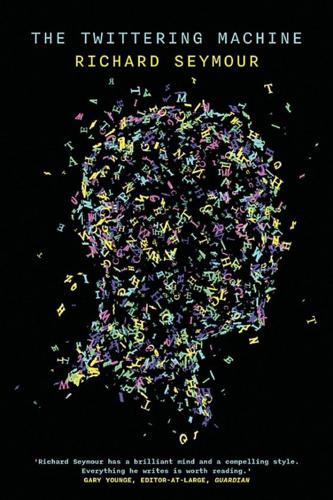
The Twittering Machine
by
Richard Seymour
Published 20 Aug 2019
And new technologies have only been as successful as they have been by positioning themselves as magical solutions. Not just to individual dilemmas, but to the bigger crises and dysfunctions of late capitalism. If mass media is a one-way information monopoly, turn to the feed, the blog, the podcast. If the news fails, turn to citizen journalism for ‘unfiltered’ news. If you’re underemployed, bid for jobs on TaskRabbit. If you’ve got little money but own a car, use it to make some spare money on the side. If you’re undervalued in life, bid for a share in microcelebrity. If politicians let you down, hold them to account on Twitter. If you suffer from a nameless hunger, keep scrolling. The business model of the platforms presupposes not just the average share of individual misery but a society reliably in crisis.
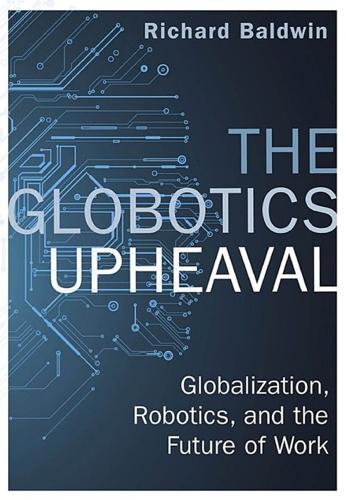
The Globotics Upheaval: Globalisation, Robotics and the Future of Work
by
Richard Baldwin
Published 10 Jan 2019
You click on a a button labelled “End Contract”. I am mostly definitely not the only one doing this. In 2017, Upwork had fourteen million users from over 100 nations. It processed more than one billion dollars in freelancer earnings. And Upwork has plenty of competition. There are dozens of start-up competitors like TaskRabbit, Fiverr, Craigslist, Guru, Mechanical Turk, PeoplePerHour, and Freelancer.com. This “space,” as they say in the online world, has attracted the attention of the professional network giant LinkedIn. It has 450 million business professionals registered and it is using that base to move into freelance matchmaking with its “ProFinder” services.

Radicalized
by
Cory Doctorow
Published 19 Mar 2019
The residents of Fort Doom were about done with the end of the world and ready to go back to massages, steaks, cocktail bars, squash games, hard work, big profits, arguing on social media, ill-advised sex with interesting strangers, all the comforts of modernity. When they’d left Phoenix, it had been a thriving city, filled with TaskRabbits and 7-Elevens, Ubers and exclusive bespoke suitmakers and couture fashion boutiques. Surely some remnant of all that remained. So he green-lit the mission, and they tuned into the DJs all around the clock, like it was a radio play about a much more interesting apocalypse than the one they were living through.

Dollars and Sense: How We Misthink Money and How to Spend Smarter
by
Dr. Dan Ariely
and
Jeff Kreisler
Published 7 Nov 2017
Think about all the terms hinting at the complexity of the process—the effort heuristics—the waiter used to describe the exact same items Cheryl had cheaply consumed at her desk, description-free. SHARING IS FAIRING What about the phrase “the sharing economy”? Companies like Uber, Airbnb, and TaskRabbit belong to “the sharing economy,” a phrase that frames these services in a positive way. Who doesn’t like to share and who doesn’t appreciate those who do? Who above the age of preschool doesn’t think of sharing as a wonderful human quality? No one, that’s who. The phrase “the sharing economy” conjures an image of the good side of humanity, and that causes most of us to value a service more.

Most Likely to Succeed: Preparing Our Kids for the Innovation Era
by
Tony Wagner
and
Ted Dintersmith
Published 17 Aug 2015
* * * For a good example of how the innovation economy is upending traditional models, check out Elance, a rapidly growing online service that enables entrepreneurial freelancers to earn income in hundreds of ways, including as editors, graphic designers, creative writers, software developers, and researchers. Need your logo designed? Go to Elance. Need careful research about an article? Go to Elance. Elance is hardly unique. Millions of people are generating income through the online microeconomies of sites like Care.com, Freelance.com, eBay, oDesk, TaskRabbit, Uber, Airbnb, Lyft, Teachers Pay Teachers, iTunes, Kickstarter, and on and on. These marketplaces represent the wave of the future, where anyone can: • reach lots of customers readily. • build an online reputation through customer feedback and examples of work. • succeed in a world where customers don’t care about education credentials or standardized test scores

No Ordinary Disruption: The Four Global Forces Breaking All the Trends
by
Richard Dobbs
and
James Manyika
Published 12 May 2015
Lyft, a rival to Uber, allows people to transform themselves into professional drivers at their own convenience using their own vehicles. Airbnb, the wildly popular service that matches travelers with people who have spare rooms for rent in their homes, has allowed tens of thousands of people to work part-time as very small-scale innkeepers and hoteliers—on top of an existing job, or instead of it. Startups like oDesk, TaskRabbit, and Elance have established online marketplaces for a range of services from software development to basic cleaning and running errands. Increasingly, work is not a place people go to at the same time and place every day; it is something they do under an expanding array of new arrangements. SHIFTING GOALPOSTS AND SKILL GAPS EVERYWHERE The story of skill gaps is no longer a new one, but over the next decade, it will become a familiar one.

Alpha Girls: The Women Upstarts Who Took on Silicon Valley's Male Culture and Made the Deals of a Lifetime
by
Julian Guthrie
Published 15 Nov 2019
The group was a who’s who of Silicon Valley women, from MJ to Ellen Levy at LinkedIn; venture capital partners Kate Mitchell, Maha Ibrahim, Emily Melton, Robin Richards Donohoe, Jesse Draper, Claudia Fan Munce, and Karen Boezi; serial entrepreneurs Sukhinder Singh Cassidy and Kim Polese; Laurie Yoler, the tech veteran who had helped start Tesla; Amy Banse of Comcast Ventures; Katie Rodan of Rodan + Fields; Katherine August de-Wilde of First Republic Bank; and Leah Busque, founder of TaskRabbit, among others. The women had MBAs, PhDs, and stellar track records. They were entrepreneurs, investors, and moms. At one of the first meetings, Sonja laughed when a male founder walked into the room, saw all the women, and said, “Whoa!” At another meeting, Sonja refrained from rolling her eyes when a male founder insisted on explaining technical details to his female co-founder.

The Theft of a Decade: How the Baby Boomers Stole the Millennials' Economic Future
by
Joseph C. Sternberg
Published 13 May 2019
What exactly is the “gig economy”? One thing it isn’t is new. Freelancers and part-timers have always been important parts of the economy. What also isn’t as special about the gig economy as many people think is the thing that always catches everyone’s attention about it—the technology. Smartphone apps like Uber or Lyft or TaskRabbit make it a lot easier for workers to offer themselves as temporary employees without going through an agency, and the lower cost thresholds associated with hiring individuals to do jobs via an app mean that “temporary” can become as short as a single car ride. But the technology is an important part of the story of the gig economy less because it has created revolutionary new gig work than because it proves the bigger point of this chapter: enormous quantities of investment capital have flowed into companies creating these apps because making an app that will take the middleman out of temporary hiring is currently a lot cheaper than investing in almost any business activity that would create a full-time job.
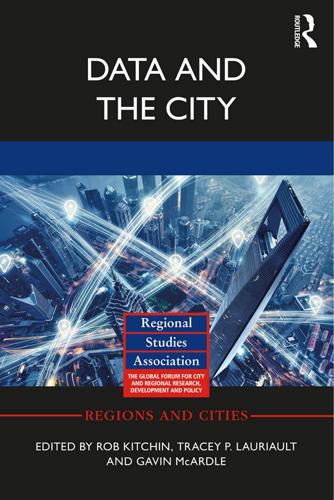
Data and the City
by
Rob Kitchin,Tracey P. Lauriault,Gavin McArdle
Published 2 Aug 2017
If Castells’s city can be understood as an offline interface that produces urban publics, our digital interfaces have taken over some of the functions of the city. Whether it is finding a date through Tinder, a ride through Uber, a power drill to borrow through Peerby, funders through Kickstarter, or a plumber through Taskrabbit, the network society has been turning into a platform society. To come back to Batty’s insight: computers are now not just tools that automate and optimize existing urban functions such as traffic flows, they have partially taken over essential characteristics of the cityness we find in cities: their functioning as a ‘market place’ and a ‘theatre’.
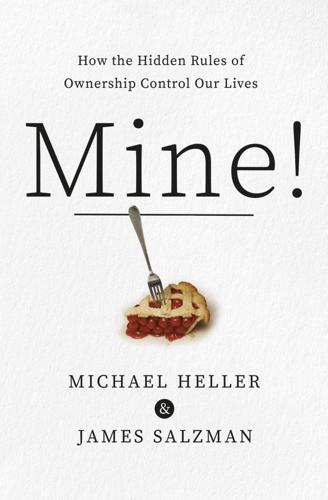
Mine!: How the Hidden Rules of Ownership Control Our Lives
by
Michael A. Heller
and
James Salzman
Published 2 Mar 2021
People actually don’t want to spend money, time, and hassle for a one-day rental when they can pick up a thirty-dollar drill at the local hardware store or get same-day delivery from Amazon. And more often than not, people don’t want either the drill or the hole. They want the curtains hung and the IKEA dresser assembled. TaskRabbit figured out it could provide that useful combination, sending you both the drill and the person who would finish the project. There’s no shortage of names for these new markets—“collaborative consumption,” the “gig economy,” the “peer economy.” There has been no end of breathless predictions for where it will lead: “A startling number of young people, it turns out, have begun to question one of the central tenets of American culture: ownership.”

Essential: How the Pandemic Transformed the Long Fight for Worker Justice
by
Jamie K. McCallum
Published 15 Nov 2022
In the wake of the recession’s economic fallout, Americans scrambled to find work, creating an opening for new start-ups to sell low-wage workers and the unemployed on the concept of a “gig” or “side hustle.”8 Once viewed as temporary, these types of jobs quickly became a permanent feature of the economy. Uber and TaskRabbit were both founded in 2008; they were joined in 2011 by Postmates, in 2012 by Instacart and Lyft, in 2013 by DoorDash, and by Shipt in 2015. The emergence of the gig economy worsened working conditions nationwide and rapidly expanded the ranks of low-wage, hyperexploited workers. Gig workers are functionally servants: they can act as your personal chauffeur, bring you dinner, do your grocery shopping, and assemble your furniture, all while the impersonal, app-based transaction lets you hire them without having to assume normal employer burdens, like safeguarding workers’ rights.

Augmented: Life in the Smart Lane
by
Brett King
Published 5 May 2016
“Work” is more likely to behave like a marketplace in the cloud than behind a desk at a traditional corporation. While a central skill set or career anchor will be entirely probable, most will be entrepreneurs, and many will have their side gigs. For instance, Uber, Lyft and Sidecar are platforms that give people a way to leverage their cars and time to make money. TaskRabbit is a market for odd jobs. Airbnb lets you rent out any extra rooms in your home. Etsy is a market for the handmade knick-knacks or 3D print designs that you make at home. DesignCrowd, 99designs and CrowdSPRING all offer freelance design resources that bid logos and other designs for your dollars.
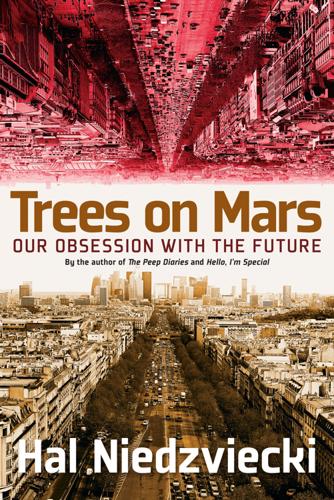
Trees on Mars: Our Obsession With the Future
by
Hal Niedzviecki
Published 15 Mar 2015
You are to be the neutral facilitator, the connector, the hub, but never an agent who could be blamed for a decision.”80 Think Airbnb or Amazon or Facebook or Google or Groupon or even Walmart. Think of the management software that Starbucks uses to decide who should work when in thousands of stores. Think of the ever-expanding category of hubs that connect people who want something done with people who are willing to do that job for them. These are task brokers like Fiverr and Taskrabbit, or driver-on-demand apps like Uber and Lyft—low-wage, task-based labor hubs that take a cut of every transaction but don’t take much, if any, responsibility for the estimated seventeen million or so Americans who work at least part time as “independent contributors.”81 These workers who race around walking dogs, hanging pictures, and giving rides to the airport don’t know what work at what wage they’ll have next day or next week.

Don't Be Evil: How Big Tech Betrayed Its Founding Principles--And All of US
by
Rana Foroohar
Published 5 Nov 2019
As Kalanick once put it to me, rather open-endedly, “If something is moving from one place to another in a city—that’s our jam.” But Uber is disrupting more than just transportation; it’s rewriting the contract between employees and labor. Over the past several years, it has cemented its role as the most prolific and pugnacious among companies shaping the “gig economy,” including Airbnb, TaskRabbit, and dozens more. They are all emblematic of accelerating shifts in the way we work: 24/7, directed by technology, and without many of the traditional protections and benefits enjoyed by the middle class. On the one hand, there is something magical about the way these companies allow people to monetize resources they already possess—a home, a car, their free time.

The Measure of Progress: Counting What Really Matters
by
Diane Coyle
Published 15 Apr 2025
For example, in the United States the number of companies with zero employees, which (Di s)i n t e r m e di a t i o n 117 the Census calls “nonemployers,” climbed from about 18.7 million in 2003 to 23 million in 2013 (National Academies of Sciences, Engineering, and Medicine 2017). Newer modes include freelance work, always common in some sectors such as the creative industries, now extended to p eople like crafters, coders, and even managers through digital matching platforms such as Upwork and Taskrabbit—these two specialising in, respectively, white-collar and blue-collar skills. Potentially more exploitative are modern forms of casualised labour markets, offering short-term or zero-hours contracts, probably paying minimum wage and offering poor job quality. In principle digital platforms offer a new way of addressing the fundamental problem of economic organisation, namely how to co- ordinate the supply and demand of many individuals in the absence of full information.

On the Clock: What Low-Wage Work Did to Me and How It Drives America Insane
by
Emily Guendelsberger
Published 15 Jul 2019
Ray Kroc’s famous If there’s time to lean, there’s time to clean has actually become law here. Not law like rule—law like physics or gravity. It’s so embedded in the place that nobody even has to say it anymore. I work in a busy franchise in downtown San Francisco, blocks from the headquarters of a ton of huge tech companies—Uber, Twitter, Dropbox, Reddit, Craigslist, Airbnb, TaskRabbit, Pinterest, Wikipedia, Square, Yelp, etc. I’ve only been here a week, and I’ve already served countless people voluntarily wearing hoodies and T-shirts bearing the logo of their employer.* As someone involuntarily wearing the logo of her employer, I find this bizarre. My uniform is mercifully tasteful, though.

Work Rules!: Insights From Inside Google That Will Transform How You Live and Lead
by
Laszlo Bock
Published 31 Mar 2015
In 2007 we created our Advanced Leadership Lab, a three-day program for senior leaders where we deliberately assembled a diverse group, spanning a range of geographies, professional functions, genders, social and ethnic backgrounds, and tenures. Stacy Brown-Philpot, at the time a director in our sales organization, who went on to be an entrepreneur-in-residence at Google Ventures before becoming chief operating officer of TaskRabbit, was in the first session. Years later, she and I compared notes on what a special experience it was to build that program from scratch. “I loved the people I met. I didn’t realize that we had so many amazing people doing so many different things,” she told me. “Who do you stay in touch with?”

Financial Freedom: A Proven Path to All the Money You Will Ever Need
by
Grant Sabatier
Published 5 Feb 2019
One of the benefits of side hustles is that they give you the opportunity to explore a bunch of different ideas without needing to commit to any one of them. If you love dogs but find that you hate dog walking, no sweat. Do as much as you want or switch to another hustle entirely. (Cat sitting, I can assure you, is a lot less work.) You can also go to websites like TaskRabbit, Postmates, or Craigslist to see if there are any odd jobs you can do. These require a little more effort, since you constantly have to look for new opportunities, but more money is more money. Remember, money is infinite. The more you side-hustle, the better at it you’ll become. For instance, over time, you’ll get a better sense of how much you can charge for a service.

Blockchain Revolution: How the Technology Behind Bitcoin Is Changing Money, Business, and the World
by
Don Tapscott
and
Alex Tapscott
Published 9 May 2016
An open world where everyone can contribute to our technology infrastructure, rather than a world of walled gardens where big companies offer proprietary apps. A world where billions of excluded people can now participate in the global economy and share in its largesse. Here’s a preview. Creating a True Peer-to-Peer Sharing Economy Pundits often refer to Airbnb, Uber, Lyft, TaskRabbit, and others as platforms for the “sharing economy.” It’s a nice notion—that peers create and share in value. But these businesses have little to do with sharing. In fact, they are successful precisely because they do not share—they aggregate. It is an aggregating economy. Uber is a $65 billion corporation that aggregates driving services.

Make Your Own Job: How the Entrepreneurial Work Ethic Exhausted America
by
Erik Baker
Published 13 Jan 2025
Then it was off to the races: Countless “Uber for X” startups obtained venture capital funding in the low-interest-rate 2010s. A platform for dog walking, laundry, house cleaning, moving—fifteen years after publishing The Rise of the Creative Class, Richard Florida could contract a lordly roster of servants from the screen of his smartphone. Open-ended platforms such as Fiverr and TaskRabbit allowed clients to hire people to perform a nearly limitless array of ad hoc tasks, from errands to graphic design work.14 With striking unanimity, the firms of what came to be called the “Gig Economy” settled on a label for their army of non-employee employees: they were entrepreneurs. “The Gig Economy,” Fiverr CEO Micah Kaufman wrote in Wired, was just another name for “the labor force of new entrepreneurs.”

Data and Goliath: The Hidden Battles to Collect Your Data and Control Your World
by
Bruce Schneier
Published 2 Mar 2015
It was the same with music promotion and distribution, airline tickets, and—in some cases—advertising. The old gatekeepers’ business models relied on inefficiencies of technology, and the Internet changed that dynamic. It’s even more true today. AirBnB allows individuals to compete with traditional hotel chains. TaskRabbit makes it easier to connect people who want to do odd jobs with people who need odd jobs done. Etsy, CafePress, and eBay all bypass traditional flea markets. Zillow and Redfin bypass real estate brokers, eTrade bypasses investment advisors, and YouTube bypasses television networks. Craigslist bypasses newspaper classifieds.

Connectography: Mapping the Future of Global Civilization
by
Parag Khanna
Published 18 Apr 2016
.*10 As many large companies either downsize or shift toward part-time models to assemble their teams on an as-needed basis, postindustrial society becomes a collection of digital temps not employed directly by their client but mediated through portals such as Wonolo, which acts as a task-brokering agency for Coca-Cola and other firms but provides employment for only hours at a time at short notice. The fastest-growth category of jobs in America is “perma-temps” who live off assignments garnered from sites such as TaskRabbit or Fiverr (where each gig earns $5). When we speak about countries moving up the value chain, we have to specify whether we are referring to their companies or their people. While America’s tech companies are the world’s most innovative, the most common job in thirty out of the fifty U.S. states is truck driver: non-tradable, but perhaps soon automatable.

More: The 10,000-Year Rise of the World Economy
by
Philip Coggan
Published 6 Feb 2020
In the past, it has been difficult for the two groups to find each other. The internet makes the process quick and cheap. However, the anonymity of the internet creates a potential problem: how can the client trust the supplier to perform the service to a requisite standard, and how can the supplier trust the client to pay? Platforms such as Uber and TaskRabbit can perform this service too, acting as trusted middlemen for payment. They can also help customers and suppliers to choose each other, via the system of ratings. A bad supplier, or a bad customer, will eventually be shunned by the network. Pandora’s Xbox New technologies have often had the ability to cause as much harm as good.
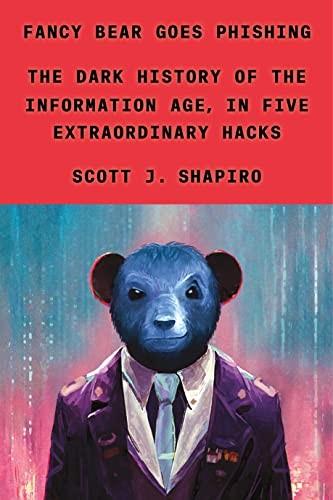
Fancy Bear Goes Phishing: The Dark History of the Information Age, in Five Extraordinary Hacks
by
Scott J. Shapiro
Even companies such as Amazon, Best Buy, and Target, which sell actual things like books, televisions, and socks, relentlessly surveil and amass data on their customers. That information is then used to personalize promotions for return business. It’s called behavioral targeting. In the age of surveillance capitalism, the hacking of firms that collect our personal information is a constant threat. Since 2017, Capital One, Macy’s, Adidas, Sears, Kmart, Delta, TaskRabbit, Best Buy, Saks Fifth Avenue, Lord & Taylor, Panera Bread, Whole Foods, GameStop, and Arby’s have suffered massive data breaches. In the most damaging breach of all, the personal information of 147 million applicants was stolen from the credit-rating firm Equifax, including credit card numbers, driver’s licenses, Social Security numbers, dates of birth, phone numbers, and email addresses.

Blood in the Machine: The Origins of the Rebellion Against Big Tech
by
Brian Merchant
Published 25 Sep 2023
In the first decades of the nineteenth century, entrepreneurs backed by magistrates and the Crown used a period of depressed trade and poor harvests—when workers were desperate and their leverage was at a low ebb—to push factory automation technologies. In the first decades of the twenty-first century, entrepreneurs backed by the state and venture capital used the period after the 2008 crash—which wiped out jobs and savings around the globe—to push automation and on-demand app technologies. Amazon, Uber, Lyft, DoorDash, InstaCart, TaskRabbit, and other companies drove algorithm-mediated work platforms into the mainstream, normalizing a mode of work that left workers without benefits or protections. Delivery drivers, cleaners, carpenters, masseuses, you name it—the twenty-first century has seen the rise of precarious, gig-based, platform-mediated jobs, begetting the decline of traditional ones.

A Generation of Sociopaths: How the Baby Boomers Betrayed America
by
Bruce Cannon Gibney
Published 7 Mar 2017
* For most purposes, people in prisons don’t count toward the unemployment rate, though they are basically unemployed, and were US incarceration rates at developed world norms, unemployment would be about half a point higher. * Another disclosure: I have invested in several gig companies, like TaskRabbit and Lyft, because a few years ago I began to suspect that gigs were the future of work. * One of which apparently went to the most recent Madame Trump, a skilled… model. A special class of H-1B visas exists for just these exceptional people. * Judge (sic) Kimba Wood’s nanny appears to have been properly hired under prior applicable laws; her sin was failing to respond forthrightly to the White House’s specific questions about nannies
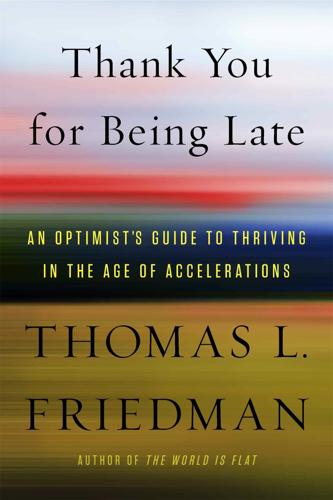
Thank You for Being Late: An Optimist's Guide to Thriving in the Age of Accelerations
by
Thomas L. Friedman
Published 22 Nov 2016
There are Udacity freelance graders who make several thousand dollars a month grading computing projects—like how to build a map from Google’s GPS—sent in from students around the world. “We had one project grader who made twenty-eight thousand dollars one month,” said Thrun. “The gig economy is moving up. It’s not just about TaskRabbit errands anymore.” And Udacity is not just providing intelligent assistance for companies such as AT&T. Its platform is creating intelligent assistance for “the start-up of you”—whoever and wherever you are. In the fall of 2015, I found myself in a small conference room at Udacity’s Palo Alto headquarters interviewing—via Skype—Ghada Sleiman, a thirty-year-old Lebanese woman, who was taking Udacity’s online course to advance her skills in Web-page design.

Palo Alto: A History of California, Capitalism, and the World
by
Malcolm Harris
Published 14 Feb 2023
Meal-kit services like HelloFresh, Plated, and Blue Apron functioned as private-cook time-shares, delivering boxes of prepared ingredients to members’ doors, while DoorDash and Grubhub and others middlemanned takeout deliveries. Travis Kalanick took the idea one step further with his post-Uber venture CloudKitchens, a catfish platform that replaces takeout restaurants with low-overhead cooking stations, promoted online as many different kinds of eateries at the same time. Servant apps like TaskRabbit and Postmates allowed users to summon contractors for miscellaneous jobs—IKEA bought the former in 2017, and the cannibal crab Uber nabbed the latter in 2020. Other than food and labor, Amazon could deliver the rest, and Bezos was working on those, too. Instead of other people’s pay, tech workers sunk their money into real estate.
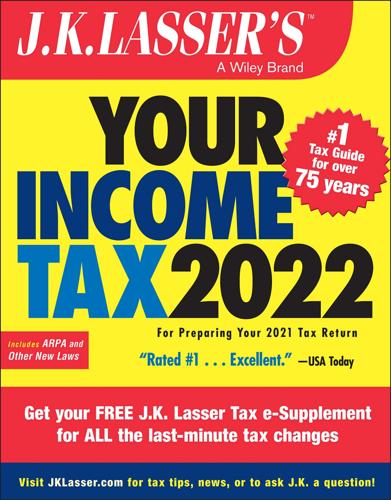
J.K. Lasser's Your Income Tax 2022: For Preparing Your 2021 Tax Return
by
J. K. Lasser Institute
Published 21 Dec 2021
However, under check-the-box rules, the LLC may elect on Form 8832 to report as an association taxable as a corporation. 40.2 Reporting Self-Employed Income You file a Schedule C along with Form 1040 or 1040-SR if you are a sole proprietor of a business or a professional in your own practice. If you do freelance work as an independent contractor, you are self-employed and use Schedule C. If you are an employee but have a sideline business (e.g., you work for TaskRabbit, Fiverr or Upwork), report the self-employment income and expenses from that business on Schedule C. File a separate Schedule C for each different business you run (e.g., one for being a freelance writer and another for running a boutique). Do not file Schedule C if your business is operated through a partnership or corporation.